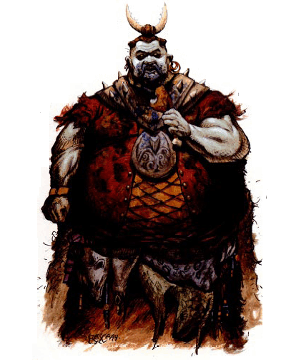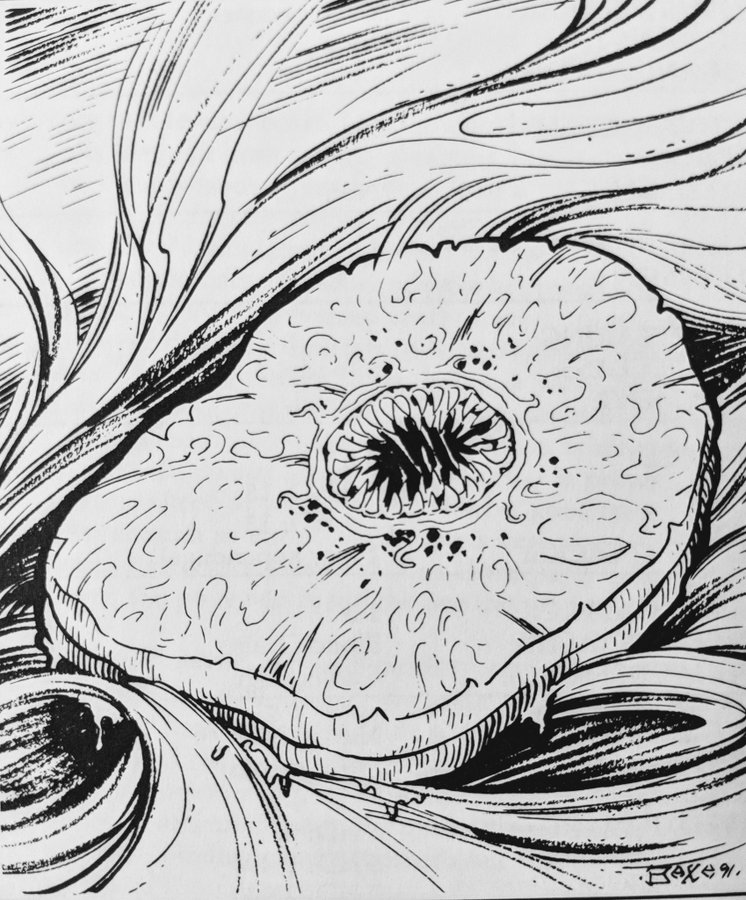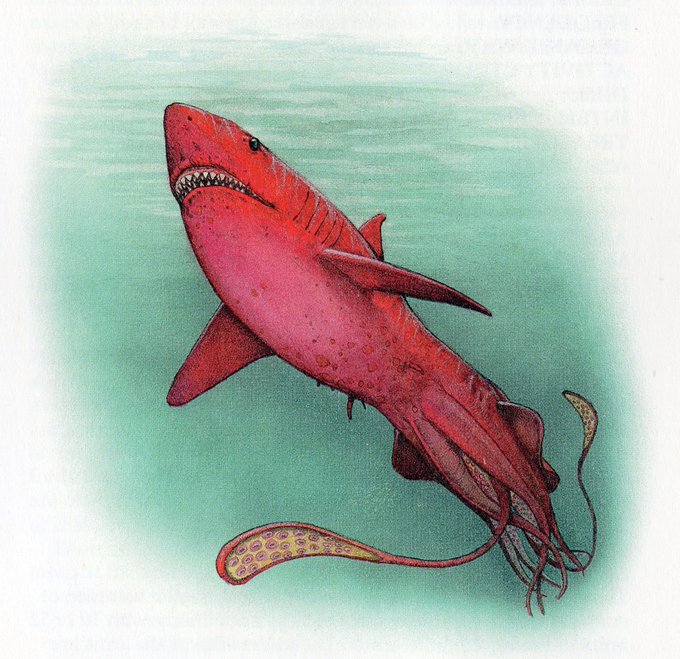By Shawn Bowman
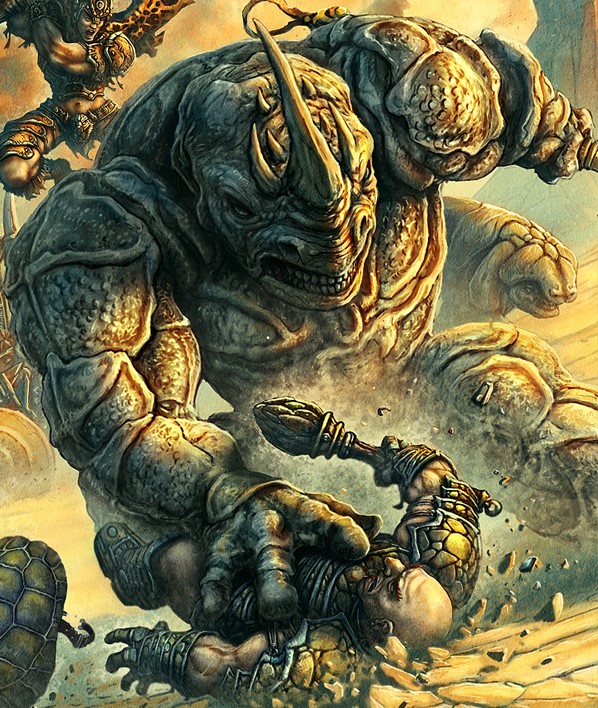



Credits 
Lead Designers: Shawn Bowman
Co-Designer: Steven Schroeder
Play Testers: Berry Mears, Dustin Mitchell, Jean Mitchell, Josh Pittman, Preston Pounds, and Steven Schroeder
Cover Art: Kerem Beyit
Interior Art: Taken from Dark Sun Monstrous Compendium I & II, Terrors of Athas by athas.org, Dark Sun Creature Catalog 4e, and other credited artists.
Version: 2.0
Contents

-
6The Bestiary
-
- 24Hyenas
- 25Inix
- 26Jankz
- 26Jhakar
- 27Kank
- 29Kes'trekel
- 30Kip
- 30Kirre
- 31Kivit
- 32Kluzd
- 33Korinth
- 34Lirr
- 35Lizard
- 36Mastyrial
- 37Mekillot
- 38Mole Boar
- 38Raakle
- 39Ramphor
- 39Rasclinn
- 40Rhynox
- 40Rocktopus
- 41Rubbish Slug
- 41Sandcrawler
- 42Sand Howler
- 43Sand Shark
- 44Scorpion
- 45Silt Eel
- 45Silt Serpent
- 46Silt Spider Swarm
- 46Sitak
- 47Slimahacc
- 48Sloth, Athasian
- 48Strine
-
-
57Monsters of Athas
-
A
-
B
-
C
-
O
-
P
-
R
-
-
S
-
-
T
-
V
-
W
-
Z
-
276Appendix:
Monster Lists
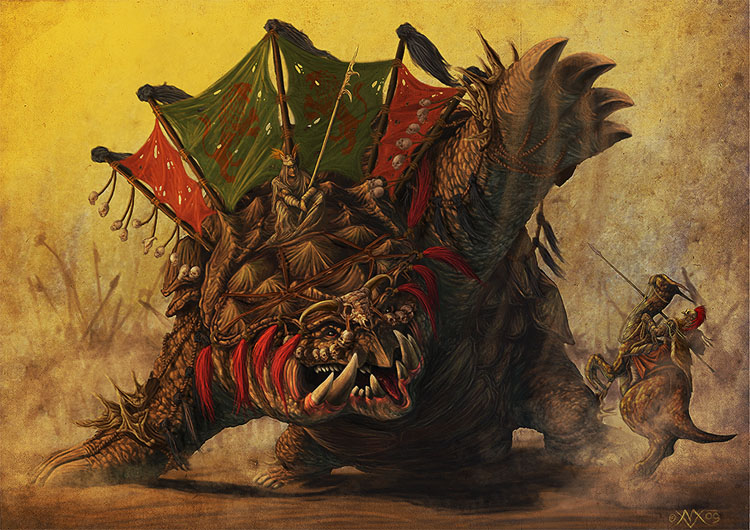

Chapter 1. The Bestiary

Within the next 275 pages are 200+ creatures, stat blocks, and lore that can be used in a Dark Sun Pathfinder 2E campaign. Among the creatures included in this book are several from 2ed and 3ed dark sun as well as original variants. Among my favorites are the Drakes, Dragon of Tyr, and Megapede.
The Dark Sun Bestiary was created as most of the monsters presented in the Pathfinder Bestiaries do not exist on Athas. Most of the monsters created in the original Dark Sun edition and athas.org's 3rd edition update can be found in the following pages. This includes the various animals that roam Athas.
Many of the monsters in the following pages use Psychic Powers. These were taken from the Dark Archive occult spells found in that book.
Beasts of Athas 
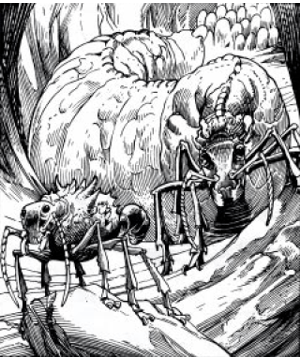
Antloid
A species of giant ant, this creature has six legs and a segmented exoskeleton. It has sharp mandibles and moves with a rapid, scuttling motion.
Antloids are giant colonial insects resembling ants that inhabit warrens in the Athasian desert.
They have evolved through adaptive specialization, which gives some certain powers. There are four types of antloids: dynamis, soldiers, workers, and the queens, each having their own tasks in antloid society.
Antloids frequently come into conflict with the other colonizing insects of the Athasian desert, namely wild kanks, giant ants and giant termites. These conflicts almost always end up as wars of attrition – whoever has the most soldiers wins (although the psionic powers of the dynamis breed gives the antloids a bit of an edge).
All antloid warrens share one characteristic: a water source, usually located at or near the bottom of the warren. Should this water source dry up, a mass antloid exodus will result and the entire warren will move elsewhere.
Giants are known for their passionate hatred of antloids and will almost never pass up a chance to throw boulders at an antloid warren.
All antloids have six legs, and segmented bodies. They also have an exoskeleton that protects from weapons and dehydration, and sharp mandibles used for cutting, carrying, or combat.
Antloid, Worker CREATURE 0
1d6+2 slashing plus Grab
Antloid, Soldier CREATURE 2
1d8+4 slashing plus Grab
1d6+4 piercing plus antloid venom
Worker
Each antloid worker spends its entire life doing one specific job: finding and carrying water and food back to the warrens, caring for the queen, repairing, and making additions to the warren, etc. Solely responsible for the warrens, worker antloids can consume sand and then regurgitate it as a strong, brick-like substance that forms the walls of the warren. Worker antloids have three easily defined, sapphire-blue body segments that reach about eight feet in total length.
Soldier
Soldiers grow to be 10 ft. in length and have a mottled blue-green-gray exoskeleton. They are sleeker and have a devastating poison attack.
Dynamis
Dynamis' bodies house large brains, which give them their psionic abilities. They are the leaders and managers of the warren, supervising the workers, making sure that the soldiers continue hunting and guaranteeing that the queen is comfortable and safe.
Dynamis are gray-black in color and slightly smaller than the workers, reaching only six feet in length.
Queen
Antloid warrens just have one queen, who serves only one purpose: to lay eggs. She lives in the deepest parts of the warren, laying 10-20 eggs a week. These eggs are cared for by workers, and the queen herself is tended by young, immature queens (treat as workers) and guarded by her most powerful soldiers. An antloid queen is a fat, bloated creature that ranges in color from warm apricot to deep red.
Antloid, Dynamis CREATURE 3
1d8+6 slashing plus Grab
Antloid, Queen CREATURE 4
2d8+5 slashing plus Grab
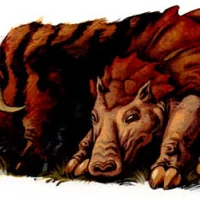
Aprig
A small, piglike creature with a hard shell and a flat, snuffling snout, this timid beast noses about the undergrowth for food along with its herd-mates.
A domesticated farm animal, the aprig is raised for its succulent meat, known for its nutty flavor, and its hard shell, which is used in the construction of household implements and armor. Aprig sows also produce milk, but it is of questionable quality.
Aprigs require little care, being voracious omnivores that will eat almost anything that is put before them. A herd of these creatures is led by a single boar and a number of sows and their litters. Adult males must be separated, or they will fight for mating dominance. Mating takes place twice each year, and an aprig litter can number as many as ten apriglets.
Aprigs vary in color from gray to reddish brown. Their faces are round and their snouts wide, suited to shoveling through piles of vegetation. Their vision is poor, but their hearing and scent are strong.
Aprig CREATURE -1
Aprig Boar CREATURE 2
Baazrag
In the broken crags and tiny caves of the barrens lives the timid baazrag. Two feet long or less, it is one of the smallest omnivores in the stony barren regions. The baazrag’ s face is protected by a bony covering that reaches down on either side of the head and across the nose, with holes for the creature’s nostrils and eyes. The mouth and lower jaw are not protected below the bony covering. The beast’s humped back is covered with a hard, natural armor that protects the animal, especially the fluid storage sack just beneath the shell. Its four legs are comparatively frail but are adequate for darting from shelter to shelter around its rocky home.
The tail of the Baazrag is about five inches long. Newborns are red-brown, green, yellow, or orange, but the color fades gradually to a sandy gray at old age.
Noble families of Tyr and Balic domesticate the baazrag to rid their households of unwanted pests and insects. The families also organize teams of the creatures to pull wagons. Each baazrag can pull as much as fifty pounds of cargo and transport.
Baazrag flesh can be eaten. Each adult has twenty-five pounds of meat. The fluid sac beneath the shell on its back contains 1d4 pints of water, but it is tainted with the same baazrag venom. Captured wild baazrags can be sold in various markets as pets or team animals.
Boneclaw
Once in a very great while, a baazrag litter consists of only one young, much larger than normal. This creature is a boneclaw. The boneclaw stands more than eight feet tall and weighs 700 pounds. The boneclaw’s head is protected by a bony covering. The upper body and back are covered with a hard shell that deflects all normal missiles smaller than a javelin. Its shell has sharp serrated edges everywhere except around the mouth and eyes. The boneclaw is a dull brown color, with sand-colored claws and red eyes that glow in the dark.
They live only to eat and to kill anything that gets in their way. Boneclaws may be slain and eaten. Each creature has 125 pounds of edible flesh, but it is tough and stringy.
Baazrag CREATURE -1
1d6 piercing plus baazrag venom
Baazrag BoneclawCREATURE 3
1d10+6 piercing plus baazrag venom
1d8+6 slashing
Baazrag Swarm
Individually, baazrags are unlikely to fight larger creatures. However, when a baazrag feels threatened, they call upon the others of the pack. The pack then forms a swarm to deal with the threats, attacking as one.
Baazrag SwarmCREATURE 1
Bears

Athasian Bear
The bear has a massive body armored in articulated carapace shot through with tufts of brown fur. Its furred, thick-boned skull has round ears, a square snout, and a black nose the size of a man’s head. From its gaping maw droops a scarlet tongue dripping with drool.
Those Athasians who have seen paintings of ancient bears assume the furry creatures to be dwarven pets; the bears of today‘s Athas are massive beasts caught and trained for arena fighting. Handlers subdue the beasts‘ potent psionic minds, which have developed psychic attacks over the millennia.
An Athasian bear resembles a shell-wearing version of the dire bear, though even larger and more ferocious. It has brown fur and a black snout and paws.
A typical Athasian bear measures eighteen feet long and weighs 14,000 pounds.
Athasian Bear CREATURE 12
3d10+10 piercing
3d6+10 slashing plus Knockdown
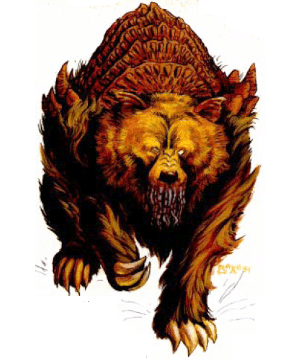
Klar
The klar looks much like a large kodiak bear with a head that seems a little too large for the body. Its back is covered with a chitinous plate It has a thick, stump of a tail that aids its balance when it stands erect. The klar is large, towering over most Athasian fauna when standing fully erect. Its thick, sandy-colored fur grows as much as six inches long.
Klar communicate with each other through loud growls, though they use their psionics when they wish to be silent or contact each other over great distances. They have never attempted to speak with humans or demihumans, assuming them to be too stupid to understand a klar. The few who have bothered to investigate the town of Salt View are beginning to change their views about the humans and their kind. Several psionicists have contacted klar and were able to communicate before being ripped to shreds.
The klar is not particularly territorial. It is confident enough to know it can find a home anywhere in the mountains by killing other cave-dwellers. In the first several years of a klars life, its intense psionic potential tends to overpower its young, untrained mind.
An adolescent klar occasionally annihilates its own brain. As a result, the klar grow particularly fierce when trespassers invade while the young are maturing. The klar fears that moving the den will upset the youth.
Most creatures prefer to avoid klar caves for obvious reasons. Those that are brave enough to face a klar, and powerful enough to slay it, can earn quite a sum by taking the skin to a tanner. Its chitinous shell is impossible to shape without magical aid and is of little use.
Klar CREATURE 6
Takis
Takis resemble bears, though unlike true Athasian bears, they stand only ten feet tall when reared on their hind legs. Brownish in color, takis ooze slime from their snouts while sniffing for food. Fierce and powerful, takis make dangerous opponents and often find themselves captured for sport in the gladiatorial arenas of the Tablelands.
Takis CREATURE 3

Screamer Beetle
This hard-shelled, larger-than-normal insect has a multicolored shell. However, once it sees you, it lets out an ear-piercing screech, letting you know where it got its name.
Screamer beetles are beautiful but deadly giant insects. Their multi-colored chitinous shells are greatly prized by art collectors and alchemists. Whole packs of them are usually found deep within caverns and rocky areas.
Screamer beetles earned their name from their ear-piercing blasts of sound that they generate from their abdomen when hunting, thus making them deadly combatants.
Beetle, Screamer CREATURE 0
Shaqat Beetle
Only six inches across, this beetle nevertheless grips you with surprising tenacity. It extends a slender proboscis from beneath its black and orange-striped shell and starts nosing about for soft flesh to pierce.
Shaqat beetles would be little more than annoying pests, were it not for their bite and the fact that the beetle can be frustratingly hard to remove once it has attached itself and begun to feed.
The beetle dwells in the grasslands and mudflats of Athas, lurking near game trails or watering holes. It seeks to attach itself to warm-blooded prey and feed as quickly as possible.
Shaqat beetles are also used as delivery systems for parasites or disease. The beetle is infected and allowed to bite the intended target, who then runs a risk of catching the infection or parasite.
Beetle, ShaqatCREATURE -1
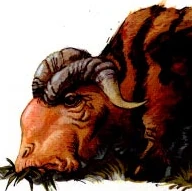
Carru
A strain of humped cattle with a bony skull and drab hide, these animals move in a wandering herd, long horned males protecting short-horned females and young.
With many products and resources being derived from it, the carru is a staple of Athasian life. The females produce a nourishing, creamy milk (as much as three gallons per day), and both sexes are slaughtered for their meat. A male can yield as much as 250 lbs. of meat. This is less for females (only 200 lbs.), but they are seldom killed for their meat, as they are potentially much more valuable as milk producers.
Carru make excellent beasts of burden, dragging plows and turning water and grain mills. Carru hide is soft and supple and holds a dye well, so it is used in the making of clothing, furniture, tents, and the like. The thicker hide of the skull is a component in many leather and hide armors and is also highly suited as a shield covering.
The carru‘ s hump, though used for water storage, does not inflate, or deflate like a camel‘s. The average hump holds 1d6+2 pints of water at any given time and can be used to make a waterskin of similar capacity. The leather will rot in contact with alcohol, however, so carru hide is unsuitable for the fashioning of wineskins.
The adult carru is ten feet long and weighs as much as four hundred pounds. Their soft hide is colored in varying shades of dun gray or brown.
Carru, Bull CREATURE 2
Carru, Cow CREATURE 0
Conashellae
Shuffling through the shallow silt is a tiny crustacean with a hard shell covering its top and a soft underbelly. Two rows of pseudopods jut out from the creature’s front, one set dexterous and probing the dust like sensory organs, the other hard as bone, pointed, and strong, used for burrowing.
Conashellae, also called shell-diggers, are hardy shellfish that exist mostly in the silt or sandy wastes. They do not deplete the sand and silt of minerals, as their digestive process breaks minerals into base components and expelling the rest that is leftover, creating a liquid byproduct that doubles the mineral content in its wake.
Conashellaes are a viable food source; their flesh can be boiled and eaten, while the juices of the creature can be used as a water substitute. The juice from one conashellae represents one-third of the normal water requirements for a Medium character; one-eighth the normal water requirements for Large characters. The flesh and juices of the conashellae is very potent and removes any exhaustion that may have been onset through starvation or thirst. Exhaustion returns if the character does not meet the food and water requirements of their size.
The carapace of the conashellae is prized by some tribes of feral halflings. They use the shells as decorations, household items, and tools. Some have also utilized the shells as weapons, armor, and shields. When thrown as a weapon they do damage equal to a small chatkcha, and if wielded as a melee weapon the shell deals damage as a small dagger. A conashellae ranges from three inches to just over two feet across in size.
Conashellae CREATURE 0
Critic
This tiny lizard has a spiny back, a multicolored hide, and a small, toothy mouth.
Usually reluctant houseguests, critics are innately psionic and tune themselves to their feeders. Critics change color each year after molting. Critics use body language when communicating with other critics. Magical or psionic contact is possible, but the critic always reacts/answers in a paranoid or anxious way.
Critics are considered a good luck charm for most households. They would prefer to be fed rather than hunt on their own. They are usually caught young and brought to a household. They adjust to their new surroundings at their own pace. Within a week the creature will let its owner know it has adapted to its new environment; it will either stay or run away. The lizard stays in a constant state of alarm if caged or chained.
Critic CREATURE -1
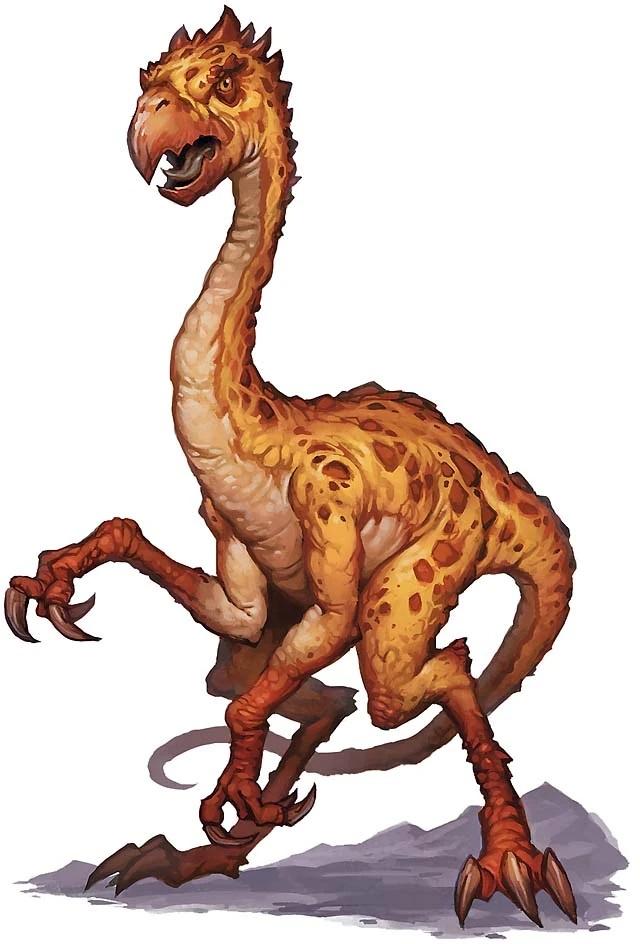
Crodlu
This creature is a large, flightless combination of bird and reptile resembling an ostrich. It has wicked claws at the end of its long fore and hind limbs, and its scaly hide is a yellowish red, with similar colors along its side and underbelly.
Crodlu are a species of flightless, scaled avian that roams the wilderness in herds. They have powerful hind legs, which were built for jumping great lengths. Crodlu have poor eyesight but make up for it with an excellent sense of smell. Crodlu have great endurance, almost better than a muls, and can run at high speeds for lengthy periods of time.
Female crodlu only lay one egg each year. When the chick hatches it is able to run and fight within minutes, having a great appetite. When it comes to feeding, crodlu will eat anything, preferring to hunt live game over eating just vegetables.
Crodlu herds can get as big as thirty strong. The herd leader is usually the largest and will have more of a reddish scaly hide.
Crodlu make great mounts but are hard to control and train unless they are caught as chicks and are trained as mounts as they are being raised.
Crodlu CREATURE 2
1d8+4 piercing plus tearing clutch
1d6+4 piercing plus Knockdown
Heavy Crodlu CREATURE 4
2d8+5 piercing plus tearing clutch
2d6+5 piercing plus Knockdown

Drik
A drik is a powerful and massive herd lizard. Its sheer bulk gives it a formidable might, making young driks targets for beast masters from both Urik and Raam to serve in their armies. The capture of the young driks has all but depleted the wild drik.
A drik is a powerful animal, built low to the ground and covered by a thick horn-encrusted shell. At birth, the drik has no shell. But while growing, the young drik secretes a resin and bits of bone that form the beast's carapace. The shell hardens as the creature matures to an adult and protects the drik from behind the head all the way to the tail. This shell is a dark gray, speckled white with bone chips. The scaly hide of the drik is a deep brown, though some appear light brown or even yellow. The drik’ s heavy body is supported by four thick, stub like legs, each sporting four huge claws. The drik’s head is enormous and has two black eyes. It has a large mouth capable of swallowing a human whole. Several jagged tusks protrude menacingly from below the creature's mouth. The drik communicates with other driks through grunts and bellows. More intelligent creatures must use psionics or magic to communicate with a drik.
Wild driks live in small family units dominated by a single female. Other adult females are not welcome within a family. They eat the grasses and shrubs of the badlands or the slower animals they can catch. Feral driks often lie still and wait for unwary creatures to wander within attack range. They drink from the Black Waters, making it fairly easy for trappers to locate them. Driks are the only animals known that can ingest Hamanu's terrible poisons from the Black Waters and survive.
In captivity, driks are ideal animals for siege combat. Their natural ram attack is quite valuable, as is their enormous size and natural protection. Some driks are used to pull massive siege towers or wagons, but often they are used as individual, mobile weapons platforms.
Drik CREATURE 10
2d12+13 piercing plus Grab
2d8+13 bludgeoning
Dune Crab
A five-foot-diameter crab scuttles from the silt, its ridge covered shell blending in perfectly with the surrounding sand and dust. The crab’s four eyestalks angle about, looking for prey to mash with its barbed pincers.
Dunecrabs inhabit the shoals of the Sea of Silt and hunt animals and people. Giants and some Balicans hunt the tasty crabs for food.
A dunecrab stands four feet tall and measures five feet across.
Dune Crab CREATURE 2
Dust Glider
A flat, disk-shaped creature glides on the faint breeze, its edges rolling on the wind like flexible wings. A long, barbed tail drifts back from the flying disk, which has a wide maw of tiny teeth on its underside and a ring of a dozen eyes around its top.
Dust gliders float through the skies of the silt islands, feeding on dustgulls and other unsuspecting animals.
A dust glider measures four feet in diameter.
Dust Glider CREATURE 1
Dustgull
This hideous, golden-feathered bird has a scaly, red head, a hooked, rapier-like beak filled with sharp teeth, and talons dripping with filth.
Dustgulls inhabit the shores of the Sea of Silt. A typical dustgull is two feet long and has a 6-foot wingspan.
Dustgull CREATURE -1
1d6 piercing
1d4 slashing plus carrion fever
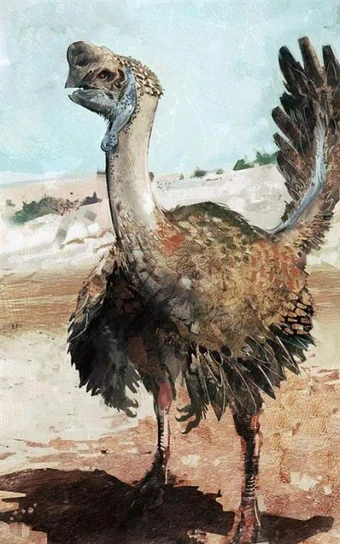
Erdland
Erdlands are a large variant of erdlus. They are used as mounts or to pull caravans.
Erdlands are flightless, featherless birds that are covered with scales. They weigh around 2 tons and can stand up to 15 feet tall. Erdlands are used more for their endurance than speed, since they are not capable of fast speeds.
Erdlands do not provide much in usable material. They do provide the savage halflings that inhabit the jungles of Athas with a major meat source. Erdlands can provide up to seven hundred pounds of meat.
Erdland CREATURE 2
Erdlu
A tall, flightless bird with heavy scales or rough feathers, this creature is as tall as an elf. It has a long neck, large beak and stands on two tough, sinewy legs.
Erdlu are large, flightless birds often used as livestock. They can weigh up to two hundred pounds and stand almost seven feet tall. Erdlu are covered in thick, flexible, scale-like feathers, ranging in color from dust-gray to soft reddish-brown. An erdlu’ s legs are long and strong, propelling it rapidly over the desert sands; the head, at the end of a long neck, is rounded, with a wicked, wedge shaped beak.
The omnivorous erdlu is a common herd animal with many uses. Aside from its value as a meat animal, the erdlu’ s beak, wing scales, and claws all find their way into various weapon heads and tools, and the egg of an erdlu is an excellent source of food and water. Cooked, a single large egg can provide about three days' worth of food for a human. Raw, the egg's liquid contents can be substituted for about one gallon of water.
Erdlu CREATURE 1
Bombardier Beetle
The bombardier beetle is usually found above ground in wooded areas. It primarily feeds on offal and carrion, gathering huge heaps of the stuff in which to lay its eggs.
Giant Beetle (Bombardier) CREATURE 0
Boring Beetle
Boring beetles are a species of burrowing beetle that feeds upon rotting wood, mulch, and other organic matter. Usually found within immense rotted trees or underground tunnel networks, they instinctively husband slimes, molds and other fungal plants as foodstuffs and guards. Boring beetles have a hive mind that allows them to cooperate on levels unparalleled amongst other species of beetle.
Giant Beetle (Boring) CREATURE 2
Rhinoceros Beetle
The rhinoceros beetle is a 12-foot long beetle that inhabits jungles and rainforests. It feeds on fruits and vegetables but will crush and kill anything that gets in the way of its feeding – or anything that it feels is likely to get in its way. Belligerent and powerful, rhinoceros beetles are hunted for their brilliantly colored carapaces, which are used as decorations and ornaments of the highest value.
Giant Beetle (Rhinoceros) CREATURE 4
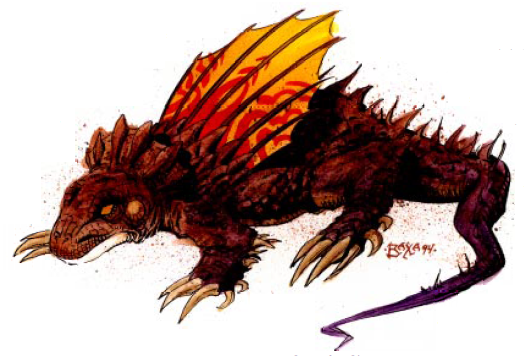
Gorak
A herd of small, 3-foot long reptilian beasts travel through the sandy wastes. The reddish creatures have a colorful dorsal fin and short legs that end in large claws. A loud hissing noise can be heard from the beasts.
Goraks are herd animals, used by many in the Tablelands as sources of food. Many herds roam free, while some have been domesticated. Quick and agile, goraks group together to attack prey. They are known for their good eyesight as well as their keen sense of smell. Domesticated herds have been known to number as many as fifty beasts, but wild herds rarely boast more than twenty individuals because of the scarcity of food throughout most of Athas. The herd will be led by the largest male (known as the alpha), a position that comes under challenge frequently. If food becomes scarce for some reason, the alpha male culls the herd of other males. Herds do not accept goraks from outside the herd and attack and kill outsiders on first contact.
Typically, goraks are three feet in length and weigh 150 lbs. Their skin ranges in color from red-brown to sandy beige and they have a colorful fanlike dorsal fin that they extend to cool their bodies in the hot Athasian sun. A second, less colorful fin surrounds their heads.
Goraks will group together to attack a single target, using their hypnotic trance to dazzle their prey while their sharp claws rip the target to shreds. When excited or threatened, goraks emit a loud hissing noise as a warning and extend their fins in an attempt to appear larger and more threatening. When extended, the patterns on the dorsal fin can induce a trance in the gorak‘s target.
Gorak CREATURE 0
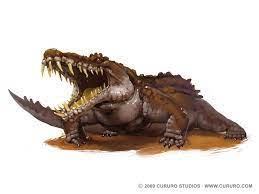
Hatori
Sometimes called the “crocodiles of the sands”, they are giant reptiles dwelling within sandy desert wastes. The hatori’ s hard, knobby hide ranges in color from gray-white to red-brown and is indistinguishable from stone. Hatori use this semblance to great advantage, allowing the wind to partially bury them beneath the sands so that a casual observer may believe he is looking at rock outcroppings instead of behemoths of the sands.
Hatori are shaped like overgrown lizards, save that their legs have evolved into flat, flipper-like appendages that they use in conjunction with their massive tails to “swim” through the sands with astonishing speed and mobility. When forced to travel upon something more solid, such as a rocky plain, hatori move by awkwardly flopping and dragging themselves forward. Hatori eyes are normally concealed deep within dark recesses that look like small hollows.
Lesser Hatori CREATURE 2
Greater HatoriCREATURE 9
2d10+13 piercing plus Grab
1d10+11 bludgeoning
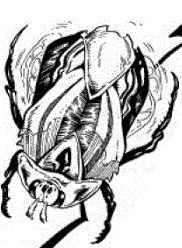
Hurrum
A tiny beetle with a beautifully colored shell, this insect produces a mellifluous humming noise as it beats its translucent wings.
These brightly colored beetles are prized for their pleasant humming sounds. Although flightless, hurrums can change their shell color along with the harmony they produce from their wing beats. Halflings find hurrums extremely pleasing, though when hungry they also find them delicious.
Hurrum CREATURE -1
Hyena
Hyenas are pack-hunting scavengers known for their unnerving, laughter-like cries, and they are not above supplementing their carrion diets with fresh prey.
Hyena
Hyenas are cunning, powerfully built carnivores that bear a heavy resemblance to dogs and other canines, though they are not themselves canines. Though all hyenas are often maligned as cowardly carrion eaters, their tactics depend on their specific breed: spotted hyenas are active pack hunters that kill most of their prey themselves, while striped and brown hyenas are more likely to be scavengers. Their jaws are exceptionally powerful, allowing hyenas to seize a victim and pull it to the rest of the pack.
Spotted Hyena CREATURE 1
Hyenadon
Hyenadons are the ferocious primeval cousins of the smaller hyena. Looming, shaggy-furred creatures the size of a horse, hyenadons are truly formidable predators to be reckoned with, due both to their size and to their bone-crushing jaws.
HyenadonCREATURE 3

Inix
An inix is a large lizard that weighs about two tons and grows to lengths of 16 feet. The inix’s back is protected by a thick shell, while flexible scales cover its underside. Inixs make spirited mounts. They move at a steady pace for as much as a full day and night without needing rest and can carry as much as a ton of passengers and cargo.
Inix riders often travel in howdahs, small boxlike carriages strapped to the lizard’s back. The major drawback to the inix is that it needs large amounts of vegetation and must forage every few hours to maintain its strength. If an inix doesn’t get enough to eat, it becomes nearly impossible to control. For this reason, these lizards aren’t used on trips where forage land is scarce.
InixCREATURE 6
2d8+9 piercing plus Grab
2d10+9 bludgeoning plus Knockdown
2d6+9 bludgeoning
Jankx
You spy a small, furry, mammalian animal regarding you from the safety of its burrow. Long, curved spurs can just be seen on the creature’s limbs.
These furry mammals live in burrows in the desert. The common people of Athas think these prized creatures are too dangerous to bother with, but those that are killed make good furs and are a reliable source of food. Jankx communicate via ultrasonic squeaks and barks which are inaudible to most humanoid ears.
JankxCREATURE 0
1d4+2 piercing plus jankx venom
Jhakar
Small, squat, and ferocious, a jhakar has keen senses and a vicious streak. These traits make jhakars exceptional guards and hunting beasts, though no training can ever make them safe to handle. They respect strength and pain, but also nurse grudges. If a master ever lets down his or her guard, a jhakar is quick to strike.
Wild jhakars are social creatures that gather into small packs around a dominant pack leader. "Tamed" jhakars can be found serving arena masters, templars, and soldiers, leading the charge into battle. Owning and controlling a jhakar is considered a sign of strength.
jhakarCREATURE 0
Kank
Kanks are large docile insects often used as mounts by the people of the Tablelands. A black exoskeleton of chitin covers their segmented bodies. The three body sections are the head, thorax, and abdomen. They weigh as much as 400 pounds, grow to heights of 4 feet at the back, and as long as 8 feet from head to abdomen. Around their mouths they have multijointed pincers that they can use to carry objects, feed themselves, or fight. Six lanky legs descend from their thoraxes. Each end in a single flexible claw that allows them to grip the surfaces they walk upon.
Kanks are often used as caravan mounts. They can travel a full day at their top speed, carrying a 200-pound passenger and 200 pounds of cargo. Kanks make decent herd animals, but usually only elves employ them as such. As kanks can digest almost any sort of organic matter, they can thrive in most terrain types. In addition, these creatures require little special attention. A kank hive instinctively organizes itself into food producers, soldiers, and brood queens.
Food producing kanks secrete melon-sized globules of green honey. These are stored in their abdomens and used to feed the hive’s young. (When other sources of food are scarce, this honey is also used to feed the rest of the hive.) Humans and demihumans can live exclusively on this nectar for up to three weeks before their bodies begin demanding other sources of nutrition, such as meats and vegetables. The sweet taste of the nectar is the only thing that attracts herders to these creatures, and domesticated kanks produce more globules than those living in the wild.
When the brood queen prepares to lay eggs, the hive digs into an area of extensive vegetation. Each queen can lay 20 to 50 eggs. While the hive waits for the eggs to hatch (it won’t move from the spot until they do), the soldier kanks ferociously defend the area from all predators. Herders must wait as well or abandon the hive.
While the globules of honey produced by kanks are sweet and good tasting, only the most desperate carrion eater will consume kank flesh. When a kank dies, its body produces chemicals that drench the meat with a foul-smelling odor that can make even the hungriest giant sick.
Kank, SoldierCREATURE 2
Kank, WorkerCREATURE 1

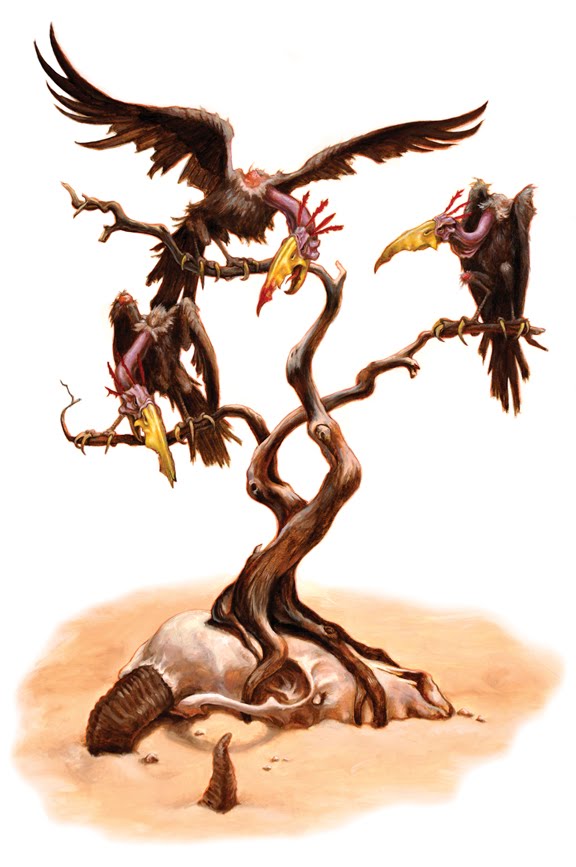
Kes'trekel
A scrawny black bird squawks as it circles around overheard, looking for a meal. A blood-red patch on its head is its only distinguishable feature.
The kes‘trekel is a carrion eater, constantly on the search for dead prey. Cowardly birds, they usually shy away from large targets, but have been known to assemble in packs to attack larger prey.
Kes‘trekels are extremely territorial and use their psionics to scare trespassers away from their nesting areas. They pair only long enough to mate. They are often captured and used as guards, as their nervous territorial squawking reveals the presence of all but the stealthiest intruders. Their eggs are considered a delicacy in Nibenay (if procured within two weeks of laying), and their eyes are sometimes eaten by the barbaric tribes of the Ringing Mountain in the belief that they grant enhanced vision.
The foot-long bird has a three-foot wingspan with black plumage; the only spot of color is a crimson patch on its head. Feral kes'trekel have a life span of approximately 15 years, while domestic kes'trekel sometimes live as long as 25 years.
Kes'trekelCREATURE -1
Kes'trekel Blood FlockCREATURE 3
Kip
The kip is a shy, six-legged, armored creature that digs and eats the roots of plants and trees. Their supple, armor-like covering makes excellent durable leather goods.
The leathered kip grows from 2′-4′ in length. Kips are covered with a horny armor that is segmented into nine separate plates. They have elongated, pointed snouts and small, beady eyes located on each side of their snouts. The eyes are protected by a glass-like covering that protects them while digging. The sharp, strong foreclaws enable the creature to dig. Their short, stubby, hind legs only allow them to amble around slowly. Kips communicate via a series of low grunts.
Kip herds provide a staple of meat and leather goods in most dwarven communities. Roasted, an adult kip will feed two very hungry dwarves; made into a stew, the meat and broth will easily feed six. Kips and dwarves seem to be complementary in pace and temperament. Dwarven communities keep the kip herd in a slow, constant motion since kip tend to destroy roots of growing plants.
KipCREATURE -1
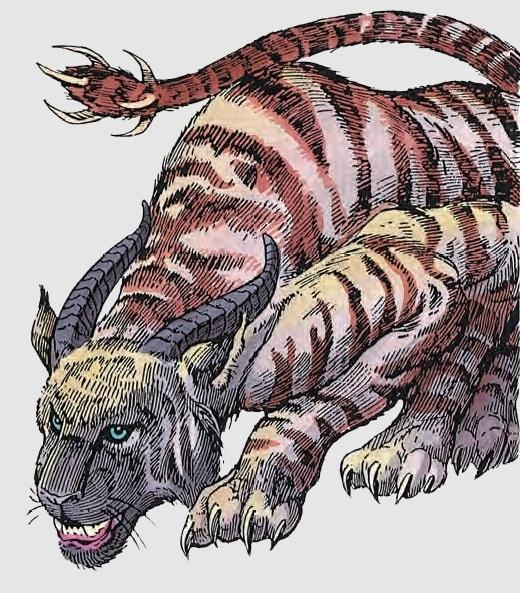
Kirre
The kirre is one of the more vicious animals of the forests and jungles of Athas. Resembling a tiger, the kirre is a beast not to be trifled with. At first glance, the kirre looks like a great cat, but upon closer examination, the differences quickly become clear. The kirre is eight feet in length and has eight legs, each ending in paws which sport very sharp claws. The kirre also has large horns on either sides of its head and a sharp barbed tail spike often used as a weapon.
KirreCREATURE 5

Kivit
Crouched on the ground before you is a tiny feline with soft fur and large eyes.
Kivits are tiny, wild cats that dwell in areas of heavy undergrowth. They secrete a poisonous musk through their fur that can be fatal in large enough doses. A kivit‘ s paws are even more dexterous than an ordinary housecat‘s.
KivitCREATURE -1
1d4 slashing plus kivit venom
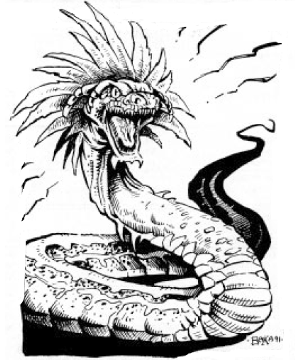
Kluzd
Kluzd are snake-like reptiles that inhabit mudflats and other muddy areas. They are about ten feet long and two to three feet in diameter. They can swallow a grown man whole, although this results in a strange, almost comical, bulge in the center of their bodies.
Male kluzd have a distinctive turquoise and white coloration about their head and neck area. Females do not share these bright colors; their bodies are sandy brown flecked with black along their entire length. All kluzd have a series of elongated, feather-like scales around the back of their heads. These flare out to form a large fan when the creature is angered, a primitive mechanism to make it appear larger to its animal opponents.
Kluzd have mere animal intelligence. They can communicate with each other only in a most rudimentary fashion or through magical or psionic means.
Most often, the kluzd is well-protected by its muddy environment; few native predators can submerge themselves in the thick muck to hunt them. Kluzd will only leave the safety of their mud pools when these areas dry out completely. The creatures are far more vulnerable when forced onto the surface of the mud flat. A kluzd will travel in a straight line away from its evaporated burrow in search of a new one — those that don’t locate a new mud hole within four days will dry out and perish.
Kluzd mate when their mudflats dry across the surface to become a broken, hard crust. The female lays a clutch of eggs (1d8 in number) that will hatch and grow to full size in six weeks. Until the young leave the mud pond, their parents will protect them. The young do not hunt. Rather the parents attack creatures that cross the dried surface of the mud flat, dragging them under to feed their children.
KluzdCREATURE 1
Korinth
A large, gray-colored lizard carries on its back a small structure, from which you can see several humanoids.
The slow-moving beast obeys all commands as it travels along the dunes. Its long muscular tail leaves sinewy trails upon the sand.
Korinths are large, gray-colored lizards, with huge 25-foot-high spikes jutting out from their backs. These hulking quadrupeds have a long neck and relatively small head. They serve as patrol mounts by the Draji, who use them to patrol the sandy wastes around Draj.
These huge beasts are extremely hard to find, and it is unknown where the Draji capture them. They have a feeble mind and are easily controlled by psion handlers.
KorinthCREATURE 12
3d12+13 piercing plus Grab
3d10+13 bludgeoning
Lirr
The lirr is a large, warm-blooded reptile that vaguely resembles a lion in body form and hunting tactics. It possesses wispy plumage that it uses for silent communication. The lirr has a long, sleek, body and its scales are small and fine, almost like those of a snake. Around its neck and at the end of its tail sit rings of a web like membrane.
Filled with small nodules that glow brilliant red, yellow, and orange, these frills normally lie flat against the creature's scales. When prey is sighted, however, the membrane fills with air, lighting up to alert other lirr that quarry is nearby. The lirr’ s four muscular legs grant a powerful spring, giving it the ability to outrun most prey.
LirrCREATURE 3
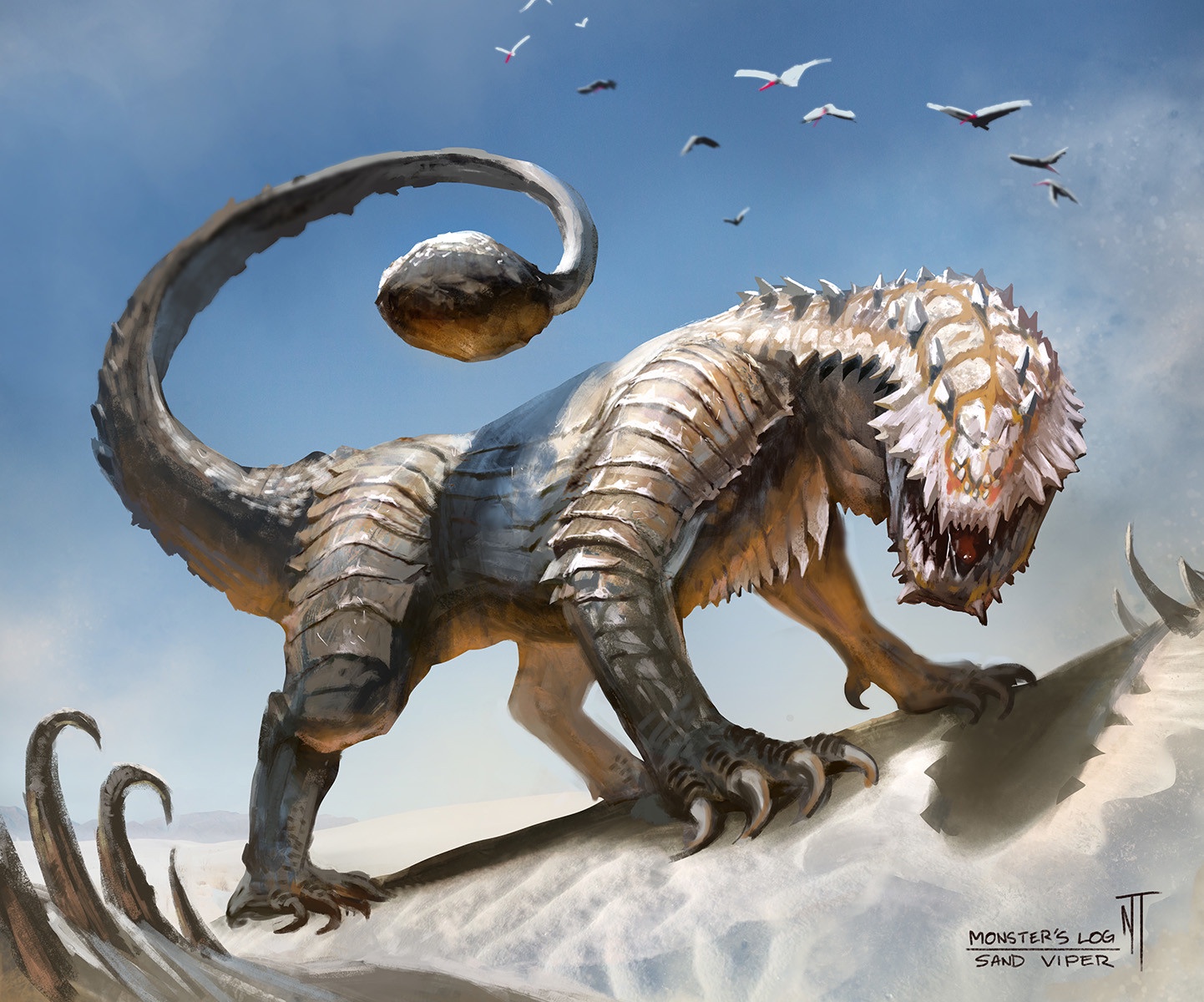
Jastrak Lizard
The jastrak is a subterranean lizard that rarely, if ever, ventures to the surface. Jastraks are curious and belligerent creatures, confident in their formidable array of natural weapons, and unexpected encounters with wandering jastraks usually end badly. Jastraks are completely blind and possess no visual organs whatsoever. Their senses of hearing and scent, however, are exceptionally well developed.
Jastraks live beneath the earth, burrowing through it with their claws. Their unpleasant dispositions mean that other inhabitants of the Athasian underdark have learned to give them a wide berth. An adult jastrak is nine feet long and weighs 800 pounds.
Jastrak LizardCREATURE 4
2d10+7 piercing plus Grab
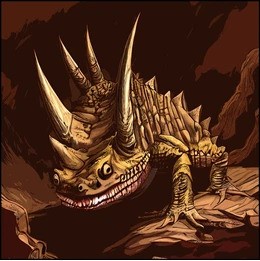
Minotaur Lizard
These four legged, 30-foot-long reptiles have horns on top of its head and looks much more aggressive than some of its other cousins.
Inhabiting the foothills of the Ringing Mountains and other forested uplands, the minotaur lizard gains its name from the twin, bull-like horns sported by the males of the species. These are not weapons, however, but function in mating displays.
Minotaur LizardCREATURE 5
2d8+7 piercing plus Grab
2d6+7 bludgeoning
Black Mastyrial
A darkly mottled scorpion as long as a halfling is tall and with a carapace easily mistaken for jagged rock, this creature moves with rapid scuttling motions, swarming with its fellows to strike from all sides. Despite an apparent lack of any visual organs, its attacks strike with uncanny accuracy.
Black mastyrials have dark, rock-like exoskeletons and claws with interlocking pincers, and have no visual organs. The average black mastyrial is 3 feet long and weighs as much as 10 pounds.
Black MastyrialCREATURE 6
2d8+9 piercing
2d6+9 slashing plus Grab
2d8+9 piercing plus black mastyrial venom
Desert Mastyrial
The desert mastyrial is an oversized breed of scorpion known for its toughness and keen senses. Unlike its black, mountain-dwelling cousin, the desert mastyrial has no psionic powers and no real sentience to speak of beyond the level possessed by other vermin.
The desert mastyrial spends most of its time hibernating beneath the sands. It uses echolocation to navigate underground as well as to detect prey that may pass overhead. Desert mastyrials are generally solitary creatures that occasionally gather in groups of up to three. After mating, the smaller male is slain and devoured by the female, who then cares for as many as 20 eggs in a single batch.
A desert mastyrial grows to be up to six feet long. Its chitinous carapace is a favorite ingredient in armor and bears a gentle, swirling pattern that affords burrowing mastyrials camouflage should they become exposed.
Desert MastyrialCREATURE 7
2d10+9 piercing
2d8+9 slashing plus Grab
2d8+9 piercing plus desert mastyrial venom

Mekillot
Mekillots are mighty lizards weighing up to six tons. They have huge, mound-shaped bodies growing to lengths of 30 feet. A thick shell covers the back and head of a mekillot, Mekillots have savage dispositions, but their size and great strength make them excellent caravan beasts. A hitched pair of mekillots can pull a wagon weighing up to 20 tons at a slow, plodding pace.
Caravan leaders must be prepared for their unpredictable natures, however. As they can never be truly tamed, the stubborn creatures have been known to turn off the road and go wandering for no apparent reason-still drawing their loaded wagons. Mekillots are also noted for eating their handlers and other members of a caravan team.
MekillotCREATURE 10
2d12+12 piercing plus Grab
2d10+12 bludgeoning
Mole Boar
The mole boar is a cross between a weasel and a boar, although is more the size of the former. These small creatures are indigenous to the fields around the Pristine Tower, and likely began as mutated invaders centuries ago. All mole boars are immune to the mutating effects of the Pristine Tower. These creatures are short and squat, much like a badger, with large, boar-like fangs and long claws used for both digging and attacking prey.
Mole boars live in communities of up to 100 throughout the blossom fields of the Pristine Tower. There are an equal number of female and male mole boars in each community, and there is no one dominant creature that controls a specific area. Each community claims a roughly 100 square yard territory, attacking any creatures not of its species that it detects. They all live together, hunting the blossom fields for floaters (their primary source of food) and reproducing at an alarming rate. If removed from their environment, mole boars become docile and refuse to eat, eventually starving to death. The floaters of the area must land in order to breed and are fed upon when they do so. In turn, however, the mole boars are one of the mating floaters‘s sources of food. Mole boars multiply at a rate of four times a year, and females are most often constantly pregnant with young. They can live up to 10 years, though few do.
Mole BoarCREATURE 1
Raakle
You see a bird with brilliant orange and red plumage and a body the size of a half-giant. The creature has powerful, three-clawed feet and a tubular beak no wider than a human finger.
Raakles are predatorial birds that roam the forests, mountains and rocky wastes of the Tablelands in search of prey. They resemble parrots but for their narrow heads, which end in a tiny beak that the creature uses to spray acid over its quarry. A raakle stands almost 12 feet tall and weighs 900 pounds.
RaakleCREATURE 3
 Credit: Silver Rathalos
Credit: Silver Rathalos
Ramphor
The ramphor is a raptor that hunts large insects and small lizards in the Athasian wilderness. It relies on its powerful dives to catch its prey by surprise, spearing it with a sharp beak then carrying it aloft to be eaten.
A ramphor is about 18 inches long with a three to four-foot wingspan. It weighs about 2 pounds.
RamphorCREATURE -1
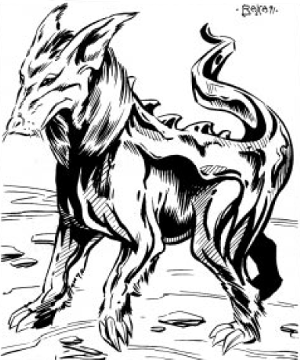
Rasclinn
The rasclinn is a small dog-like creature that feeds on almost any vegetation that grows in the Athasian badlands. They extract trace metals from the plants, which gives them an almost metallic hide. They are avidly hunted for their hides, but they are tough to kill.
The rasclinn is a small animal, growing only 3 feet at the shoulder and weighing up to 50 pounds. Its metallic hide gives it a silvery color, although the pups are usually brown, white, or a combination of the two.
Rasclinn have no language of their own, but they do communicate by barks and yelps. These warn the young to flee or indicate if a rasclinn has found food or water.
RasclinnCREATURE -1
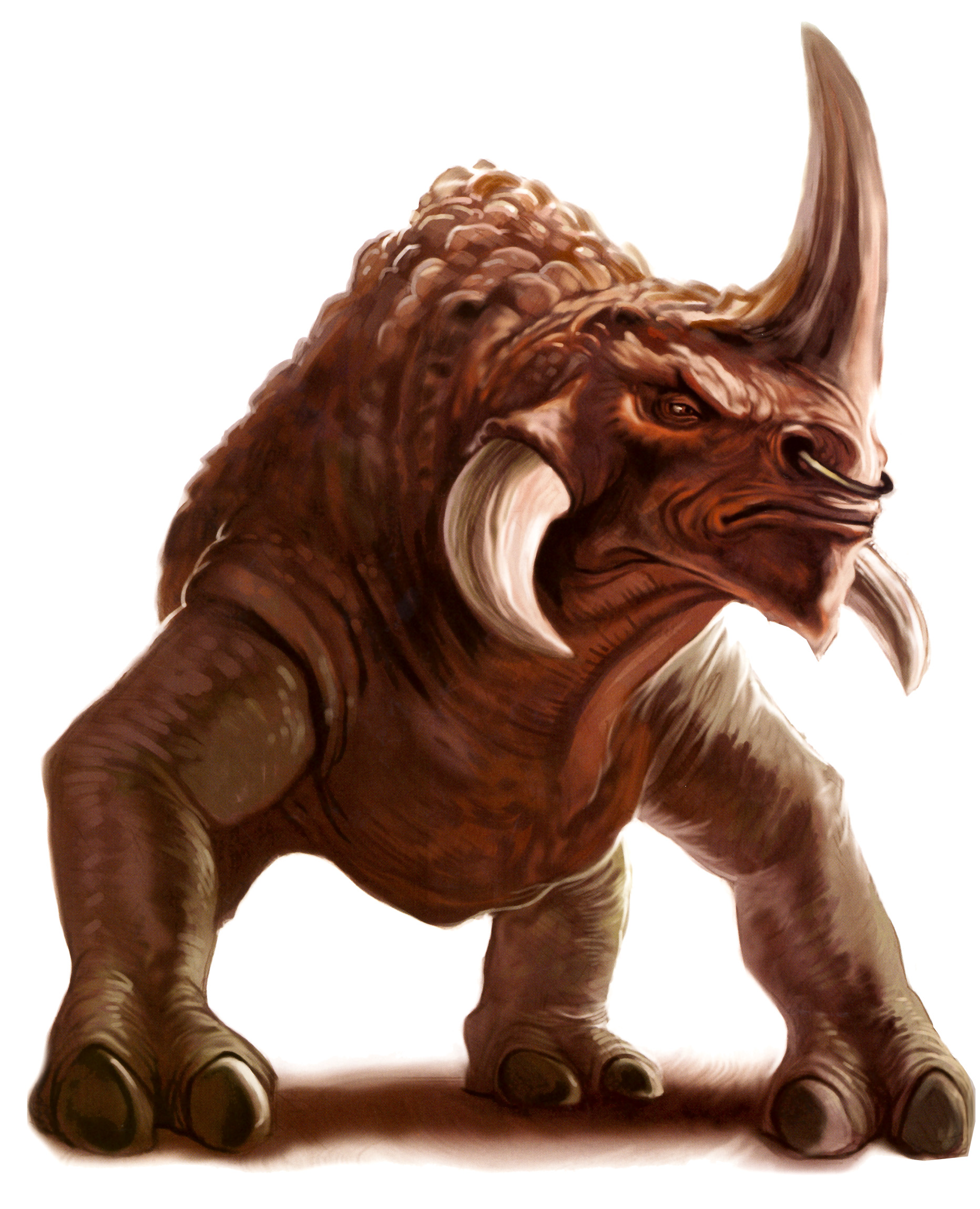
Rhynox
Rhynox large, muscular quadrupeds native to the Athasian scrub plains. Though naturally herbivores, a starved rhynox can become a ravenous meat-eater and change its skin color to a deep red, while normally they are brown, gray, or sometimes yellow. Those bred in the Tyrian arena are purposely fed meat in order to increase their overall aggression.
They sport three large horns that are used for head-locking in combat with another rhynox as a show of dominance and for fending off the few predators large and foolish enough to threaten them.
RhynoxCREATURE 4
Rocktopus
The rocktopus evolved from the common octopus as the seas of Athas retreated and disappeared. This massive cephalopod haunts a wide range of terrains, blending in with background thanks to its chameleon-like camouflage.
RocktopusCREATURE 1
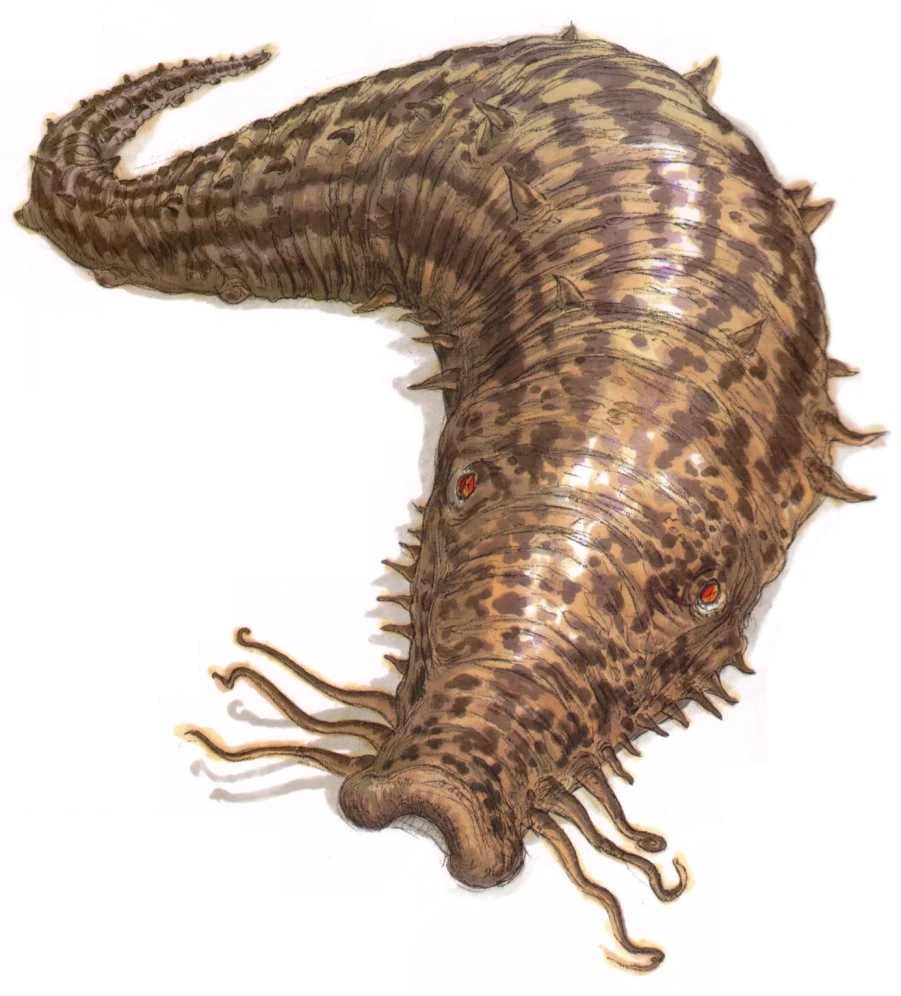
Rubbish Slug
Rubbish slugs inhabit the garbage that inevitably collects in the poorer quarters of Athas‘ city-states. The four-foot long vermin are common in silt-side cities like Balic.
Rubbish SlugCREATURE 1
splash damage
Sandcrawler
This soft, furry black caterpillar is pleasant to the touch. Over a foot long and six inches in height, it also has 20 short, stubby legs, and large bulbous eyes, making it very friendly and beautiful.
Sandcrawlers are lured by the heat and light of campfires. The sandcrawler approaches anyone sitting near the campfire quickly and cautiously, chittering softly and shyly and coming close to the flames. The creature will then nibble shyly on any offered crumbs, and is quick to allow itself to be petted, for the aim of the sandcrawler is to snuggle up close next to someone, appearing to fall asleep, then leave a few moments after everyone else is asleep, having implanted its larva in its dormant victim. Sandcrawler flesh is inedible. Its fine fur, however, is prized by the feral halflings, who find its insulating properties extremely useful. Feral halflings also know of a technique that will extract an analgesic toxin from the creature and use it on their darts to induce sleep.
SandcrawlerCREATURE -1
1d4 piercing plus numbing saliva
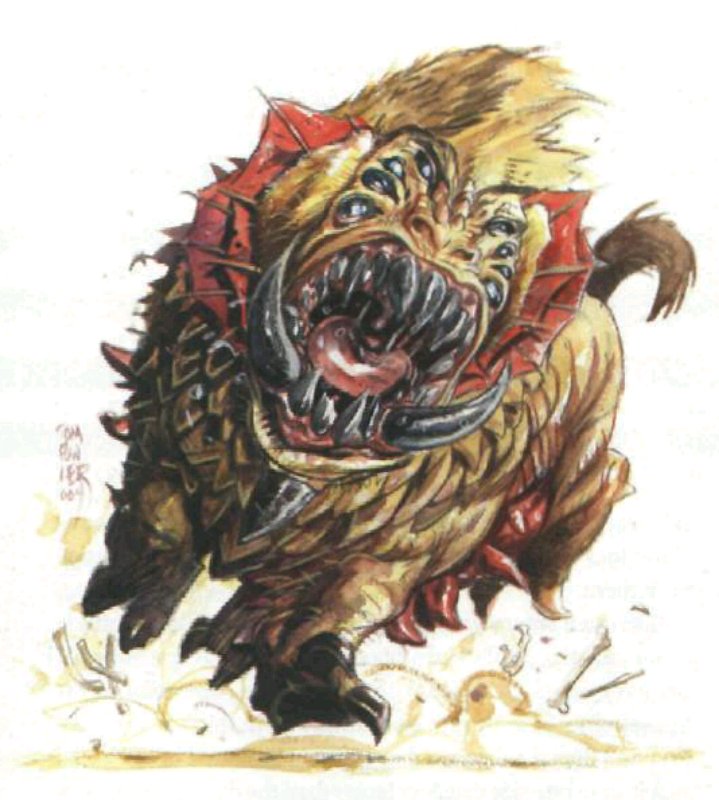 Credit: Tom Fowler
Credit: Tom Fowler
Sand Howler
This heavy-set, doglike quadruped has a broad head sporting a nest of eight eyes and a pair of curving tusks. Its semi-reptilian body is muscled, and bears armored plates along the spine.
Sand howlers are canine-like creatures that roam the deserts in packs, unleashing bloodcurdling screams when pursuing prey. Mercenaries are known to capture and train young howlers to capture runaway slaves. A sand howler‘s appearance is unnerving; though doglike, it has eight eyes that can paralyze prey with a glance. A howler‘s oversized head also sports large yellow tusks. Its scaly body ranges from dark to light brown, though rare white specimens have been noted.
Sand howlers live as a pack in subterranean dens and are ruled over by a dominant male. They dwell in desolate areas, as they do not like to compete with other creatures for resources.
Sand howler pups can be trained as guards or tracking beasts. Their hunting skills are remarkable, and their keen sense of smell makes them among the best desert trackers available. Many mercenaries in Athas capture them and train them to chase down runaway slaves. In the Tableland they have been hunted to near extinction in the last few years by those who fear them and those who would domesticate them.
The pelts of white sand howlers often bring about 150 cp because of their rarity, beauty, and protection they provide from heat.
Sand HowlerCREATURE 3
 Credit: BenWooten
Credit: BenWooten
Sand Shark
Sand sharks are bizarre mutants bred by some forgotten defiler in a fit of madness. They are sharks...that swim in sand. That is all that really needs to be said.
This blind hunter senses its prey through vibrations, sound, and smell. With an endless appetite, it hunts tirelessly for anything, regardless of size. Fiercely protective of its kill, they will fight to the death no matter the odds.
Sand sharks travel mostly alone, with the exception of mothers and calves. Located in dry, arid environments, they have been known to venture into grasslands if they are starved for prey.
Sand SharkCREATURE 4
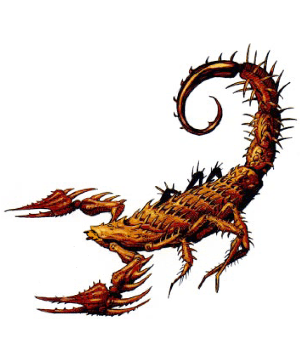
Barbed Scorpion
An incredibly large scorpion the color of gray sand, this creature sports wicked barbs that jut from its exoskeleton at all manner of angles, cloaking the beast in a protective swathe of spines.
Barbed scorpions are enormous predators that hunt alone or in packs throughout the deserts of the Tablelands. They are covered with protruding spikes that can inflict terrible injuries on those that come too close or are snared in the scorpion‘s deadly claws. The den of a barbed scorpion may sometimes contain remnants of undigested meals or their equipment, and canny travelers know that daring the shortsword-sized stinger of a barbed scorpion can sometimes yield profitable results.
An adult barbed scorpion grows to be a dozen feet long, with a dusty gray or tan carapace. They make a clacking racket as they move, their spines hammering one against the other.
Barbed Scorpion CREATURE 5
2d6+6 slashing plus Grab
2d4+6 piercing plus barbed scorpion venom
2d4+6 piercing
Gold Scorpion
A golden scorpion the length of a man’s arm scuttles out of the shadows, the sun glimmering off its carapace.
The gold scorpion is a breed of scorpion found throughout Athas, named for its shining exoskeleton. It prefers to secret itself in a hidden nook and then rush forward to strike with its stinger. The gold scorpion has a well-deserved reputation for fatalities, but this is as much derived from its lairing habits as it is from the strength of its venom.
Gold Scorpion CREATURE 1
1d8+2 slashing plus Grab
1d6+2 piercing plus gold scorpion venom
Silt Eel
This long, black eel has oily scales and a ridge of spiked fins along its spine. Its serpentine body weaves through the silt, its wedge-shaped head scouting for prey.
Silt eels live in the Sea of Silt or in inland silt basins. They hunt small creatures dwelling in the silt and rarely attack humans. A silt eel measures 4-5 feet long from the end of its spiny tail to the tip of its bullet-shaped head.
Silt EelCREATURE 1
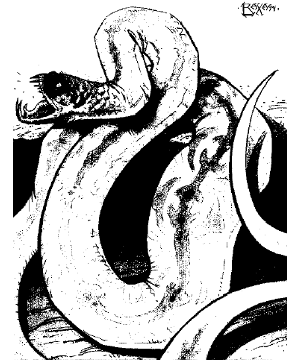
Silt Serpent
Silt serpents are precisely that – serpents that have adapted to live in the shallows of the Sea of Silt. As with many of Athas‘ denizens, they have evolved basic psionic abilities to help them to cope with life under the dark sun. Small and timid, they nevertheless possess a venomous bite that can bring down all but the hardiest of opponents.
Silt serpents are carnivores that dwell alone or in family nests in reefs and rocky ruins in the shallow silt. They are hunted for their flesh, which is succulent and tasty. Giants of the silt archipelagoes were among the first to prepare the creatures as food, but it is the Sky Singer elf tribe that has become most famous for their dish known as alrasb, prepared over an open flame from the sizzling meat of the serpents.
An adult silt serpent can grow to be four feet in length. Their young, laid in clutches of 2-12 eggs, are thin and slender, but with a more potent venom than their parents.
Silt SerpentCREATURE 0
1d8 piercing plus silt serpent venom

Silt Spider Swam
A swarming nest of tiny pale spiders barely distinguishable from the shifting silt that is their home, these creatures rush towards you in a single heaving mass.
Silt spiders are tiny creatures that dwell in Athas‘ silt seas and basins. Easily able to camouflage themselves within and swim though the silt, they are a hazard wherever they are encountered. Although their bite and accompanying poison is not overly dangerous, their sheer numbers often mean that a target will be devoured by the swarm before he has a chance to regain consciousness.
Individual silt spiders rarely reach six inches in size but can swarm in scores or hundreds.
Silt Spider SwarmCREATURE 1
Sitak
The sitak is a psionic relative of the parrot and cockatoo. It is native to the forests of Athas but is also kept as a pet by those lucky or wealthy enough to own one. The sitak possesses a parrot‘s gift for mimicry but imitates sounds telepathically rather than audibly. Sitaks raised and trained in captivity can learn up to 20 simple words (food is always the first), although they require constant company or insanity overcomes them.
Trained sitaks are used to relay telepathic messages between individuals, and their feathers are prized by Nibenese hunters, who have hunted the bird to near-extinction in the environs of their home city. By comparison, the hunters of Gulg consider it an ill omen to slay a sitak, while the halflings of the Forest Ridge believe that the birds themselves bring bad luck. No species preys upon the sitak, as its flesh is home to parasites that carry a virulent disease known as Sitak Fever.
An adult sitak is one foot long and usually has bright green or red plumage with yellow feathers at the throat, although light blue, gray, white, or black varieties are not uncommon.
SitakCREATURE -1
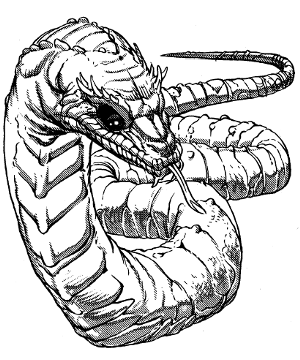
Slimahacc
Rearing up before you, shedding rivers of sand from its green-scaled hide, is an extremely long serpentine creature with a bony maw and long, hollow, horn-like protrusions sweeping back and outward from the top of its scalp.
Slimahaccs are a sinuous species of reptile with uncertain heritage. They are also sometimes known as sand drakes, but it is unknown if they are truly related to drakes or are instead some sort of native reptilian or worm offshoot. They roam the deserts, using stealth and speed to overrun and devour their prey.
Pterrans sometimes domesticate slimahaccs as riding animals or beasts of burden. While the riding position directly behind their head and an additional 10 feet of the back are relatively safe, cargo and passengers further down their back are occasionally mistaken for parasites and casually removed by the slimahacc.
In the wild, slimahaccs normally lead solitary lives hunting and sleeping. In sandy or gravelly areas, they burrow under the loose matter to a depth of about 2 feet to avoid both the heat of the day and any predators. While burrowing, slimahaccs possess tremorsense with a range of 30 ft. Above ground, the slimahacc’ s hearing is extremely acute. The horn-like scalp protrusions are actually powerful aural amplifiers whose wide degree of separation allows the slimahacc to triangulate the source of any sound that it can hear. It is not unusual for pterran riders to psionically link their hearing to the slimahacc they are riding in order to augment their hunting and defensive abilities.
Although rarely available for sale, a trained slimahacc will sell for as much as 40 gold pieces, ten times the price of a war crodlu. Slimahacc eggs are relatively rare and fetch a market price of 2 gp as a culinary delicacy. The horns of a slimahacc are actually composed of strong, hollow bone, and sections are sometimes used in constructing datchi clubs and inix yokes. Slimahacc meat is edible, though tough and muddy tasting. An adult slimahacc can grow to be over 30 feet in length.
SlimahaccCREATURE 8
2d10+7 piercing plus Grab
2d8+7 bludgeoning plus Grab
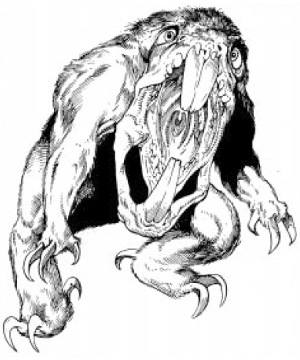
Athasian Sloth
The Athasian sloth is fast, cunning, and very bloodthirsty. A family of sloths can eat a whole halfling village in one night and is usually not afraid to try.
The Athasian sloth is a large creature with brown fur. It usually has light tan and brown, or light gray and green spots making it easy for the sloth to blend in with the foliage of the Forest Ridge.
Athasian sloths have strong family bonds and communicate through pheromone and body posture, as they do not possess the ability to vocalize sounds. They are known for their hardy nature and resistance to most poisons, as well as for their thick pelts, for which they are hunted in turn by the halflings.
An adult Athasian sloth stands eight feet tall and weighs as much as 750 pounds. Its pelt is brown, with gray, green and tan markings to assist in camouflage.
Sloth, AthasianCREATURE 5
2d8+7 piercing
2d6+7 slashing plus Knockdown
Strine
Strines are porcupine-like creatures that inhabit sandy wastes and rocky badlands. They often hunt alone, feeding on small insects and animals, although they are also known to feed on vegetation. Strines depend on their thick layers of spines for protection against their prey or enemies.
StrineCREATURE 3
2d8+5 piercing
1d10+5 piercing plus embed quill
A strine can hurl no more than 12 quills in 24 hours.
Sygra
Sygra are cloven-hooved quadrupeds with short, hairy coats that can be any mixture of black, brown, and white. Their heads sport two horns. Males have larger horns than female.
SygraCREATURE 0
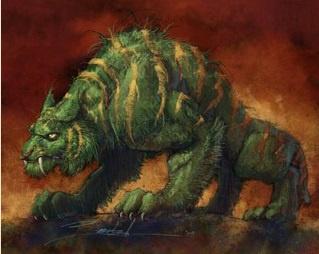
Tigone
Tigones are large, feline creatures which are dark green in color and have black or yellowish-brown vertical striping. Growing to a length of 7’, they can weigh over 250 pounds. Native of the Hinterlands, tigones have been known to roam the Ringing Mountains. They are fearful predators and will attack almost any creature violating their territory. Because of their coloration, a tigone is almost impossible to see when holding perfectly still in the underbrush. They also move very quietly through any terrain. They dislike warm environments and soon die if forced into the desert.
Highly sought for gladiatorial games, most tigones do not survive the trip across the desert. They bring a handsome price if successfully transported to a sorcerer-king’s city. Halflings prize tigones as hunting partners because of their psionic tracking and hunting skills
TigoneCREATURE 4

Warthog
These broad-faced boars are considered unusually ugly, with enormous tusks and large “warts” (in truth, these fleshy facial protrusions are protective ridges). Despite that, those who have worked with them find warthogs easier to deal with than wild boars, as warthogs are more prone to flight than aggression.
WarthogCREATURE 2
Giant WarthogCREATURE 4

Watroach
This walking hive is supported by six short legs extending from its central limb cluster, and has a very wide, low hanging head ringed with sharp teeth and flanked by deadly pincers.
This large insect, which has a black or deep purple exoskeleton, is broken up into three sections: head, hive chamber, and thorax. It also has a very sticky, hollow tongue, which it uses to attack and consume its prey, which is mostly insects ranging in size from Small to Large. It is able to use its tongue to grab insects that hide under rocks or in crevices, while it can also suck smaller insects through the hollow part of its tongue and straight into its gullet.
The thorax is a storehouse of digested foods and liquids for the adult watroach and is connected to the central hive chamber where millions of infant, drone watroaches, each less than one inch long serve the gestating protoadult at the center of the hive.
Watroaches have no language of their own and don‘t notice other passing adults. The only way to communicate to a watroach is via psionics or magic.
The adult watroach lives only to feed, so that the hive chamber is fruitful when it dies. The drones bathe, feed, and otherwise maintain the proto-adult until the adult gets too old to move. Once this happens the proto-adult grows rapidly to full size, which takes about three days. When doing this it ingests the remaining nutrients of its parent‘s thorax and most of the hive material, literally eating its way out of the hive chamber. The proto-adult is nearly full-grown after this, having its own hive chamber filled with drones and a new proto-adult inside. The remaining original drones go on to serve the new adult, but most perish with the birth of the new adult.
Watroaches are solitary creatures in one sense and entire communities in yet another. Adults don‘t travel or hunt together. In truth, however, each adult carries millions of drones and a proto-adult within itself, making it a complete walking, self-sustaining, community.
For King’s Ages Sorcerer-Kings have used animated giant beetles to wage war against one another, especially in areas so parched that mekillots, driks, and other mighty war beasts would die of exposition.
Watroach (War Beetle)CREATURE 8
2d10+10 piercing plus Grab
2d8+10 bludgeoning
Weezer
Weezers are enormous flying insects that make underground hives in the desert tablelands. Though of animal intelligence, they are highly social creatures, structured into several distinct classes by both social function and physical characteristics.
Worker, and soldier weezers all have wings, multifaceted eyes, and six thin limbs extending from their abdomen. Soldiers are slightly larger and are colored a shade of yellow brighter than their fellows. The brood queen is much larger. The brood queen has a huge abdomen for laying the hive’s eggs.
Weezers build colonies beneath the sands where they protect the brood queen and allow her to lay eggs. From the surface, their hives appear to be a series of domes that vary from three to eight feet tall, but that are all about five feet in diameter. The domes are constructed by the workers, made from sand glued together with a bonding resin they secrete. Only one dome actually has an entrance from the surface that leads into the rest of the tunnels.
Workers fly in the vicinity of the colony in search of water. They either store water directly in wax balls, or they use water to create honey that they store the same way. They hang both types of wax balls in the colony chambers to feed the rest of the adults and to nurture the young. Each sphere contains one gallon of either honey or water. The contents are apparent by the shade of the sphere (water is light, honey is dark).
Brood QueenCREATURE 3
1d12+4 piercing plus Brood Queen venom
SoldierCREATURE 2
WorkerCREATURE 0
Wrab
You see a winged serpent, two feet long, with scales of jet black.
Wrabs are airborne blood-drinkers, winged serpents that flap silently through the gloom of Athas‘ woodlands and crypts. The beasts are quiet enough to sneak up on anyone and clever enough to find their way inside tents and through cracks in shuttered windows.
Measuring up to two feet long, wrabs fold their reptilian wings around themselves for camouflage and protection while perched.
The Tyrian Council uses wrabs for their innate ability to detect surface emotions. A trained wrab senses which council member has the greatest attention of the audience, flying to that speaker‘s hand and placing its head in a nook formed by the speaker‘s thumb and index finger.
WrabCREATURE 0
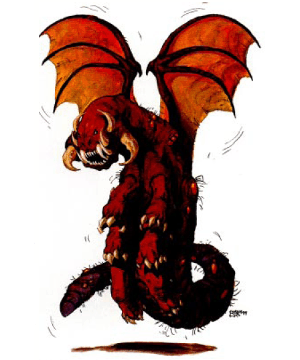
Xerichou
The xerichou is a winged predator that is found in most parts of Athas. Long and slender, with six clawed limbs and a pair of broad wings, xerichous travel in flocks, swarming their prey. Xerichous are psionic and intelligent enough to make effective use of their abilities in combat.
Xerichous begin life as relatively inoffensive larvae. These tiny, armored worms eventually climb and cling to cliffs or other elevated rock faces in order to pupate. Often mistaken for part of the rock itself, the pupa eventually hatches into the adult xerichou, which is then driven to seek out its ancestral nesting ground in order for the breeding cycle to begin again.
An adult xerichou is a foot long, with a three-foot wingspan. It is deep brown to deep red in color and has a tough, leathery hide with tufts of wiry hair sprouting at the joints. The larvae are only four inches long, with a dozen tiny legs.
XerichouCREATURE 1
Zhackal
You spot a pack of small canines with brown and gray hides. Despite their dog-like features, the creatures are completely silent.
Zhackals are small pack animals that delight in feeding off the emotions of those about to die. The pack gathers around the dying victim and feed off its emotions, using psionics to accomplish this.
Zhackals are most frequently encountered in the wilderness, but some packs have been known to sneak into large cities in order to prowl through the slums and warrens in search of vulnerable prey. As the zhackal is a cowardly beast, these packs will generally flee if confronted by serious resistance.
Even stranger, certain jaded nobles even keep single zhackals as pets, feeding them from the emotions of dying slaves and gladiators. A zhackal fed this way becomes slavishly loyal to its new pack leader. A zhackal is expensive to keep in this fashion as slaves and gladiators that might otherwise live, die off much sooner with a zhackal feeding upon their very feelings.
Zhackals are sometimes hunted for their fur, which has a consistency like cotton when correctly spun. A large number of unmarked pelts are required for clothing of any significant size and zhackal skin garments are extremely expensive as a result. Zhackals look like small dogs and are usually brown or gray in color. Zhackals make no sounds, although they communicate with other zhackals via mindlink.
ZhackalCREATURE 1
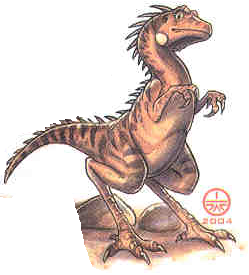
Z'tal
Z'tal are small, upright lizards that hop in shepherded leaps across Athas. They are very stupid and are known to stampede when panicked.
Z'tal jump wherever they go on powerful hind legs that end in sharp talons. Their small head is rounded in the back with a sharp, hard point on the end. Their long, thick tail is used for balance when they hop. The vestigial forearms and claws are seldom used. Varying in shades of tans and browns, z'tal are covered by sharp, feather-like scales.
Z'tal constantly make a series of chirps, squeaks, and squawks. These noises are intended predominantly to keep the herd within a sing area. When threatened, z'tal scream and run.
Z'tal are well suited for life in the desert. They require little water and can sustain themselves through foraging. Z'tal travel in groups called leaps and are acknowledged as perhaps the most stupid and timid of creatures on Athas. They sometimes accidentally die by running off cliffs or into the Sea of Silt if chased.
About once a month the female digs a small hole and lays a clutch of 1-3 eggs. The eggs are immediately forgotten and left to fend for themselves. The eggs are not edible by any known creature because z'tal scales develop almost immediately after conception.
The rear talons of z'tal are used to dig out small insects and seedlings, which the z'tal crushes with its beak. Docile creatures except when frightened, one screaming z'tal will soon stampede the entire leap of lizards.
Z'tal meat make an excellent base for soup; a single z'tal cooked this way will easily fee a dozen hungry, man-sized creatures. The sharp, flexible feather-scales are frequently used as small knives and razors. The scales dull after a week of regular use and cannot be resharpened.
Z'tal CREATURE -1
Monsters of Athas 

Aarakocra
Aarakocra zealously defend their homeland. They are mistrustful of strangers that venture onto their lands. Some evil tribes may attack caravans without provocation. Aarakocra have great confidence and pride in their ability to fly but have little empathy for land-bound races.
Aarakocra tend towards Neutrality with regard to law or chaos. With respect to good and evil, aarakocra tribes usually follow the alignment of their leader. A tribe whose leader is Neutral good will contain Lawful good, Neutral good, Chaotic good and Neutral members, with most members being Neutral good. Aarakocra, even good ones, rarely help strangers.
Most aarakocra communities are small nomadic tribes. Some prey on caravans, while others build isolated aeries high in the mountains. The least xenophobic aarakocra generally come from Winter Nest, in the White Mountains. Most human communities tolerate aarakocra characters but do not welcome them. Merchants will do business with aarakocra if they remain on foot.
Most land-bound creatures are suspicious of strange creatures that fly over their herds or lands unannounced, and templars, even in Kurn, have standing orders to attack creatures that fly over the city walls without permission.
Aarakocra shamans are usually air clerics, sometimes sun clerics, and occasionally druids. Most rituals of aarakocra society involve the summoning of an air elemental or Hraak'thunn. Summoned air elementals are often used in an important ritual, the Hunt. The aarakocra coming of age ceremony involves hunting the great beasts found in the silt sea.
Most aarakocra tribes shun wizardly magic, but a few evil tribes have defilers, and one prominent good-aligned tribe, Winter's Nest, has several preservers.
Athasian aarakocra speak their own language. They have no written language of their own, though some of the more sophisticated tribes have borrowed alphabets from their landbound neighbors. Regardless of the language spoken, aarakocra do not possess lips, and therefore cannot even approximate the 'm', 'b' or 'p' sounds. They have difficulty also with their 'f's and 'v’s and tend to pronounce these as 'th' sounds.
Aarakocra CREATURE 2
1d6+2 piercing
Aarakocra Shaman
Aarakocra druids are the shamans of their tribe and lead them in all religious ceremonies.
Aarakocra ShamanCREATURE 3
1d6+2 piercing
Aarakocra Sky Warden
The most powerful of the elusive aarakocra, these mighty sky wardens are often found leading lesser birdmen to war. They speak Common as well as their natural tongue of Aarakocra, to allow them to better communicate with their allies (or order their enemies to surrender).
Aarakocra Sky WardenCREATURE 4
2d6+3 piercing
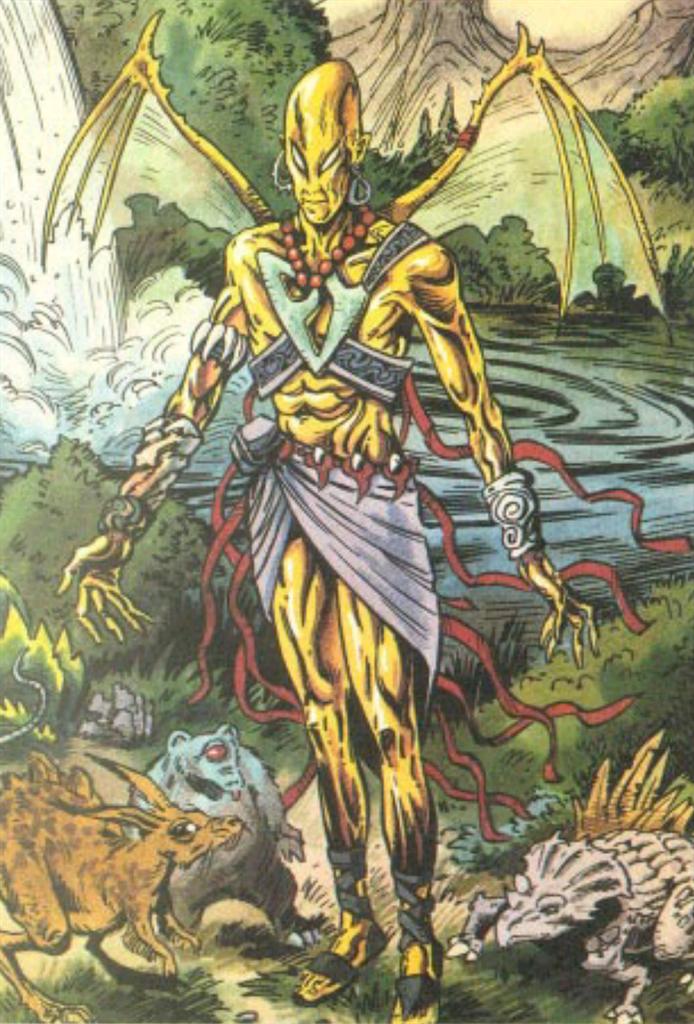
Avangion
Having mastered both psionics and arcane magic, some of Athas' most powerful preservers seek out the mysteries of a metamorphosis, to change themselves into strange beings of gossamer wings and light. As avangions, they can combine their mastery of the Way and arcane arts into psionic enchantments that some say counters dragon magic. Others say that the avangions bring a healing power, and that they come not to fight, but to return life to dying lands. Most sages have never heard of avangions and would probably call them myth.
Rajaat once claimed that he chose humans for his champions because humans were the most "malleable" of races. It is unknown whether non-humans could survive the avangion metamorphosis, or what form the survivors would take. All known avangions have been human. Only one known avangion survives today, a former dragon that has embraced the way of the preserver. New avangions would have to conceal themselves from their mortal enemies, the sorcerer-kings, who watch continually for wizards who gain enough power to be a threat. Epic psions in The Order consider new avangions and new dragons to be psionic "abominations," and would slay them to "restore the balance." Unlike the sorcerer-kings and The Order, new dragons do not systematically hunt for avangions, but they nevertheless pose a deadly threat.
Like dragons, avangions desire to complete the next step of their metamorphosis, which requires rare and expensive supplies. Unlike dragons, avangions also possess power to restore life to dying lands on an epic scale, through psionic enchantments that also require rare and expensive supplies. Avangions often seek out trustworthy adventurers to obtain rare supplies, to assist and protect metamorphoses and other precarious psionic enchantments, and to locate and watch over defilers that can be destroyed - or redeemed.
Avangion CREATURE 22
8d4+10 bludgeoning
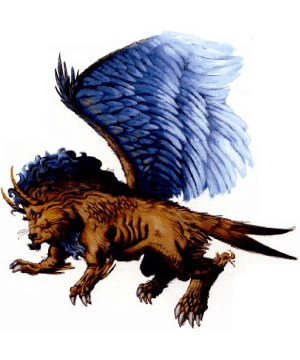
Aviarag
The aviarag resembles an adult male lion, but it has large wings (15 feet across), as well as horns like a goat’s protruding from its head. The aviarag’ s tail is birdlike and split like the tail of a swallow. This gives the aviarag its high maneuverability despite its size.
On the ground, the aviarag moves equally well on all fours or on its hind legs only. The aviarag’ s eyes are black and yellow, and it can see as far as 30 miles in clear conditions. The hide is a tawny brown color, and the wing feathers are deep blue with white tips. The tail feathers are also deep blue, but with no white tip.
The aviarag is a solitary creature, preferring its own company to that of any others. It has a large, roughly circular territory, 15 miles in diameter.
The lair of an aviarag is invariably at the top of the highest peak in its territory. The aviarag prefers small rodents and mammals for food but attacks larger creatures if it is hungry. A well-fed aviarag can go for three weeks without food if necessary. It eats only freshly killed meat.
The aviarag uses its psionic powers to determine the intentions of any intelligent creatures it meets. If the aviarag detects any thoughts of combat, it attacks. If it reads peaceful intentions. there is a 50% chance the aviarag will help in the form of guidance to water or shelter, in exchange for food, or some shiny bauble for its lair. While it doesn’t covet treasure as such, the aviarag does like shiny things.
Once every two years the female aviarag goes in search of a mate. Aviarags do not mate for life. After a brief mating season, the female returns to her lair. From 1-4 (1d4) young are born three months after mating. They remain with their mother for the first year, then leave to set up a territory of their own.
Aviarag CREATURE 4
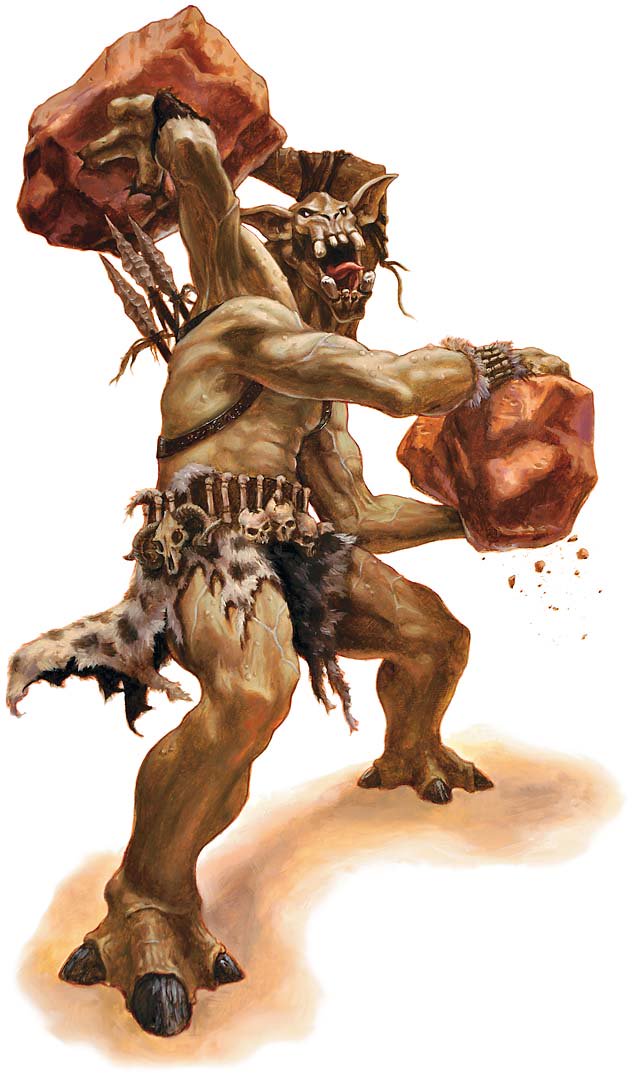 Credit: Scott Murphy
Credit: Scott Murphy
B'rohg
These multi-armed, humanoid kin to giants are often hunted for combat in the gladiatorial arenas of Athas due to their strength, size, and special combat abilities.
B’rohg are tall, slim, humanoid giants with four arms and two legs. They have burnt orange skin, the result of having spent their lives on the hot deserts of Athas. They stand 15’ in height when fully mature, with sharp, angled features, a flat nose, and pointed ears located towards the backside of their skull. Some b’rohg are bald on top but do have hair (which they will grow to waist-length) growing from the back of their heads. B’rohg have no facial hair. A b’rohg’ s garb is simple and well-suited to his primitive lifestyle. Males and females alike wear loose fitting skins or breeches made from reptilian leather.
B’rohg communicate with one another through a series of primitive grunts and hand signals. Because of their low intelligence, it is impossible to teach a b’rohg contemporary speech. It is possible to learn the grunt and sign language of the b’rohg through much study; however, such communication tends to be limited to simple concepts.
Psionic or magical communication is also somewhat limited due to their low intelligence — contact is still limited to simple ideas.
Naturally ambidextrous and strong, b’rohg are highly prized for arena combat. B’rohg are formidable opponents due to their ability to make four separate attacks per round. B’rohg prefer to fight with primitive stone weapons, such as spears and clubs, but will use any available weapon. A favored form of attack is wielding clubs in the lower two arms and long spears in the upper arms. While younger b’rohg favor an all-out, 4-weapon attack, some older b’rohg prefer to pad their lower two arms and use them as shields, thus “equalizing” the match.
Because of their lack of intellectual development, b’rohg have never mastered the use of missile weapons other than those which can be thrown (rocks, etc.). Because of the motion of throwing, a b’rohg can only throw a maximum of two objects per round, and they do so by throwing from the same side simultaneously.
There will be a dominant male leader present in any group of six or more b’rohg. The leader also brings his battle savvy into play, directing the combat actions of his warriors. When a leader is present, the b’rohg are more likely to set ambushes for approaching enemies rather than conduct a simple frontal assault. Also, b’rohg under the command of a leader will turn and run after losing two of their original number. Otherwise b'rohg tend to fight to the end.
B’rohg are a throw-back to simpler times. They are nomadic hunters and gatherers who continue to live within a primitive, “stone age” culture primarily because of their low intelligence. A b’rohg child taken and raised in a human community is unable to comprehend anything but primitive concepts; his lack of intelligence makes him unable to excel. B’rohg live in small bands comprised of 1-4 family units called cliques. Family units consist of one male, one or two females, and generally no more than four total offspring. Males are dominant within the family structure, but tasks within a band are accomplished by the most capable member regardless of gender. The strongest in the band are primarily hunters, while the older, weaker members and the children are gatherers and water bearers. B’rohg have yet to master fire, but are not afraid of it; in fact, they are often attracted to it if they see the distant glow. B’rohg are scavengers, and their clothing often testifies to this fact. When clothed, they combine animal skins with “found” or discarded scraps of clothing and armor.
B’rohg typically live to be 80 years of age but seldom do because of the harshness of their environment and a high mortality rate among their young. B’rohg do not understand the concept of death and tend to leave things that do not exhibit signs of life alone. An exception to this is seen in combat, where they may repeatedly strike a dead opponent just to make sure it does not arise later. B’rohg will eat the flesh of other races but are not cannibalistic; they do not consume their own kind.
Neither suspicious nor superstitious, b’rohg are reactionary when magic is used in their presence. Depending on previous experiences with spellcasters, the creatures may be awed or angered. When encountering magic for the first time, their reaction tends to be one of curiosity (until the spellcaster’s intent — malevolent or benevolent — has been established).
Their nomadic lifestyle calls for periods of movement followed by periods of rest. While on the move, the adults carry the few belongings they have and their children in simple sleds made from skins or leathers stretched across a triangle of wooden poles. Each adult drags a single sled across the ground to the next temporary settlement. Once in an area fresh for further hunting and gathering, the group settles down, forming small hovels out of their sleds and additional skins. Where possible, the hovels use existing rocks and crevices to serve as walls or additional rooms, respectively. When under the direction of a dominant male leader, the group selects an easily defended position over any others.
B’rohg that are taken to the gladiatorial games of the city states are never allowed to win their freedom. Despite their humanoid form, b’rohg are considered animals by their trainers and owners, suitable for nothing more than entertainment through savage combat.
However, low intelligence does not equate to low cunning, and many b’rohg have escaped their bonds to live free again in the Athasian wilderness. However, once trained for so-called civilized combat, the b’rohg is no longer suited to his original lifestyle.
While in the arena, renegades learn a great deal about more sophisticated combat techniques. They learn the benefits and use of armor, something rarely practiced in the wild. Renegade b’rohg fashion their own armor when they reach the wilderness, using animal bone, chitin, and wood as available.
Renegade b’rohg tend to live solitary lives. In encounters with other, more primitive b’rohg, the renegade keeps his distance, ashamed of his original capture, but also ashamed by the simplistic lives of his kin. The only places where renegades find universal acceptance is among the slave tribes. Once again among the familiar trappings of gladiatorial companionship, but without the abuse of servitude, renegades make excellent warriors and laborers.
B'rohg CREATURE 6
2d10+7 bludgeoning
2d8+7 bludgeoning
2d6+7 bludgeoning
Renegade B'rohg CREATURE 9
2d12+12 slashing
2d8+12 bludgeoning
2d10+9 bludgeoning
 Credit: Jan Sidoryk
Credit: Jan Sidoryk
Beetle, Agony
This harmless looking, black scarab beetle psionically lives off the suffering of its victims, hence its name. The agony beetle has a hard, black-veined, chitinous shell that is marked by dark, transverse lines. The shell protects a pair of wings. Six hooked legs are used by the beetle to attach itself to the skin of humanoid or beast. An elongated snout contains a retractable tendril. The agony beetle uses a pair of stubby antennae to sense vibrations as it does not have eyes.
When the agony beetle locates the victim’s spinal column, a bile-coated tendril emerges from the beetle’s snout (agony beetles do not attack invertebrates). The bile anesthetizes the skin, so the victim does not feel the tendril enter. Once inside the skin, the tendril is inserted into the spine. The victim is suddenly racked with excruciating pain, and the beetle begins to psionically absorb and store the energy released by the victim. The beetle will remain attached even after fully sated, basking in the flow of energy until the victim dies.
Agony beetles tend to live near water sources where they hope to encounter prey. A pain-devouring creature, the agony beetle never ingests solid food for sustenance, only an occasional sip of water. They will not hesitate to attack members of their own species but are often no match for other insects more evolved for combat.
Old stories claim that agony beetles originally escaped from a sorcerer-king’s torture chamber. It is more likely that they were (and are) drawn there for obvious reasons. They are not edible and serve only the darkest needs. Halflings sometimes use the beetles in slings and throw them into trespassers’ clothing; it shortens the hunt without harming the meal.
Agony Beetle CREATURE 1
 Credit: Brom
Credit: Brom
Belgoi
At first sight, a belgoi of Athas appears to be human. An observant traveler then notices the longs claws that extend from its fingers, its puckered, toothless mouth, and its webbed, three toed feet.
A belgoi is a member of a race of ignorant demihumans who dwell in the most forlorn wastes. With its taste for the flesh of intelligent races and a gleeful exuberance to inflict pain, no wonder that the sorcerer-kings and other rulers of the Tablelands don’t tolerate a belgoi tribe’s presence within five-day’s travel of their domains.
The belgoi speak a crude language that bears only the most rudimentary resemblance to the common language of the Tablelands. Some belgoi leaders have also learned the common tongue, though few civilized people willingly get close enough to engage in conversation.
Belgoi live in huge tribes and operate as raiders. These tribes make their homes in the most forlorn parts of the desert, but they travel across the Tablelands in their unending search for food. Belgoi tribes harass trade routes, villages, and any groups of poorly defended people they can find.
Small scouting parties of four to ten individuals hunt for prey. When they encounter travelers or a small camp, they attack to secure their own meals. Then they call the rest of the tribe to share the leftovers. Though they prefer the flesh of the intelligent races, belgoi will eat animals, plants, and even monsters if they get hungry enough.
Belgoi CREATURE 3
1d6+4 piercingg
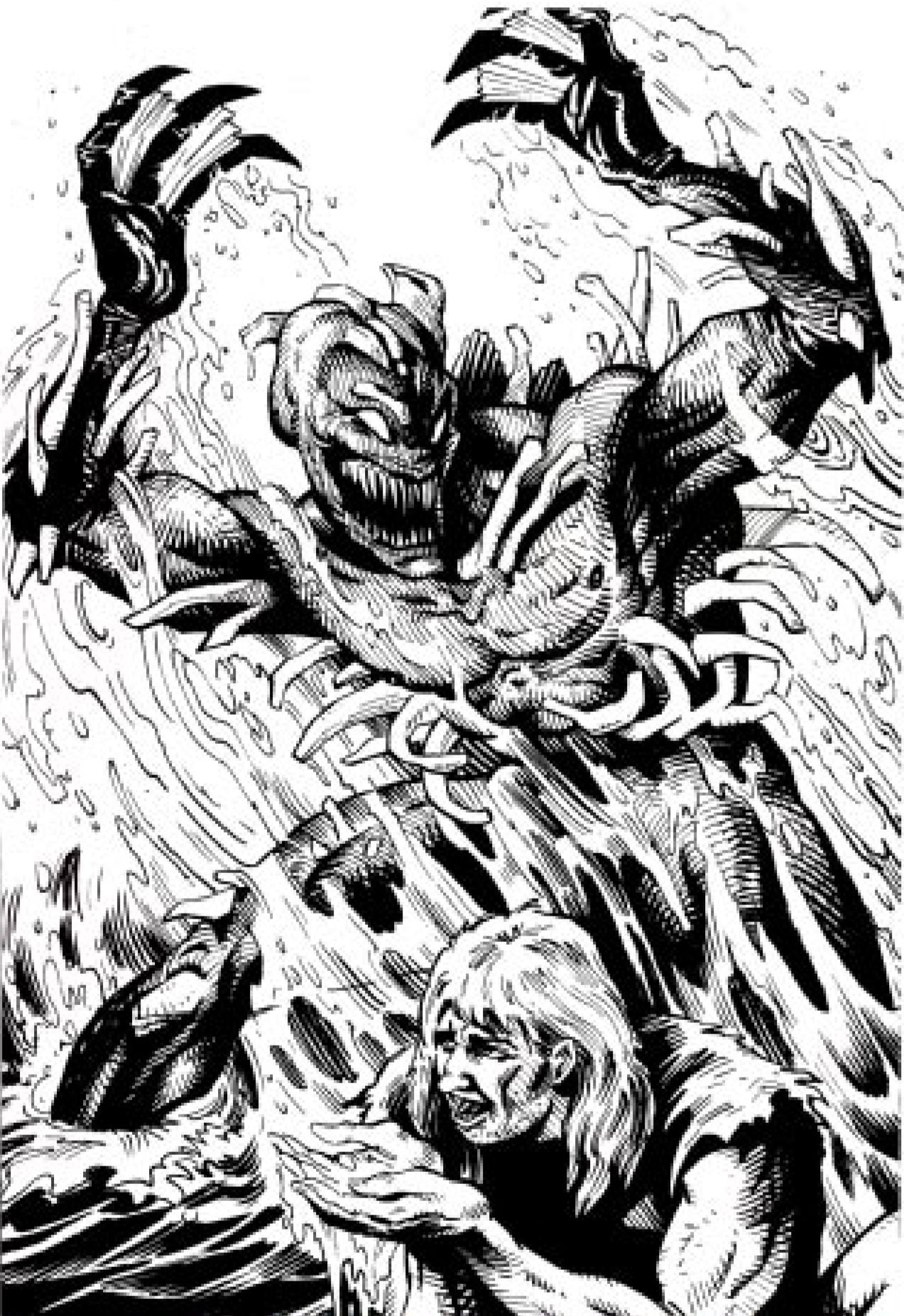
Bog Wader
Bog waders live in the bottom of muddy wallows waiting to prey on unsuspecting creatures who come to drink.
The small, misshapen creature could be mistaken for a dwarf at a distance. Closer inspection reveals the thousands of wrinkles of overlapping gray skin and thin, yellow and black bones that poke through the soft skin on all sides. A pair of dorsal ridges run down the back. Bog waders have small, flat heads. They have no nose; instead, they possess a closeable breathing hole. Bog waders have flaps (instead of ears) on each side of their head. These flaps cover the ear canal when they submerge. Gill ridges run vertically down their backs between their spine and dorsal ridges. The gill ridges are covered by patches of hair or cilia, which filters out the particulate matter in the mud allowing them to breathe in the water. They have bent legs designed for leaping and webbed feet and hands that end in sharp, three-fingered claws. A row of small teeth, designed for tearing, line their mouths.
Bog waders have no language of their own and speak no other common tongue. They communicate with each other through a series of guttural tones, but these convey only the simplest concepts concerning feeding and mating. Psionics or magic can be used to further communication, but the bog wader’s low intelligence makes a meaningful exchange of ideas unlikely. The bog wader’s world is its bog and its prey; it pays attention to little else.
Each bog wader lives in agony within its own watery pit. The bones that protrude from its skin cause them constant pain, which is one of the reasons the creature is so fierce. The skin of the creature needs almost constant moisture and will dry and crack quickly when exposed to direct sunlight. When moving about the flats, the creature constantly coats itself with fresh mud in order to keep its skin moist.
Bog Wader CREATURE 2
 Credit: Kierembeyit
Credit: Kierembeyit
Braxat
It is difficult to tell whether the braxat are of mammalian or reptilian stock. Their backs are covered with thick, articulated shells, their heads have a squarish lizard-like shape giving them a reptilian appearance, and the crowns of their heads are defended by three to five horny protrusions. At the same time, they walk upright on two feet, can speak with a human-like voice, have a fully opposable thumb, and are warm-blooded.
Braxat are hunters by nature, and their fighting tactics reflect this. They will often use psionic attacks to disable their opponents and reduce the risk to themselves.
After attacking psionically, the braxat wades into hand-to-hand combat, usually carrying a massive, spiked club. They use their acid breath only as a last resort, for it tends to render the prey unsuitable for consumption.
Braxats are found throughout Athas, wandering the forlorn wastes in search of prey. They are usually solitary creatures but may rarely be found in mated pairs (in this case, the young are usually safely hidden away in a remote cavern).
Braxat are true terrors of the desert, usually attacking at night in search of fresh meat. Although they will eat caravan mounts on occasion (except for kanks), they prefer intelligent races.
Braxat shells make excellent shields and armor plates. Because of this, they are sometimes hunted by other creatures living near them. Because of the power of the braxat, however, would-be hunters often find the tables turned upon them and end up the targets of a deadly ambush.
Braxat CREATURE 12
3d10+13 bludgeoning
2d10+13 piercing
3d4+13 bludgeoning
4d6+7 bludgeoning

Burnflower
This hearty plant has highly shiny leaves that reflect sunlight into deadly beams of energy.
Burnflowers appear as a patch of grey-green vines with closed bulb-shaped flowers. If the flowers are opened, they are found to be coated with a clear, sticky sap. The sap has a nasty, bitter flavor and is neither edible nor poisonous.
Burnflowers grow in large numbers. These are divided into some number of 10 foot by 10-foot patches. All attacks, damage, and defenses are for each 10 foot by 10-foot patch. Each individual flower within a patch occupies roughly one square foot, so there are 100 burnflowers in a patch.
Each burnflower opens every morning and tracks the sun all day. The highly reflective coating on the inside of each flower petal catches and reflects the rays of the sun, forming a deadly heat ray. Any creature larger than two feet that comes within 60 feet of a burnflower patch is attacked by the heat rays of all its flowers.
Burnflower HAZARD 3
3d6 fire
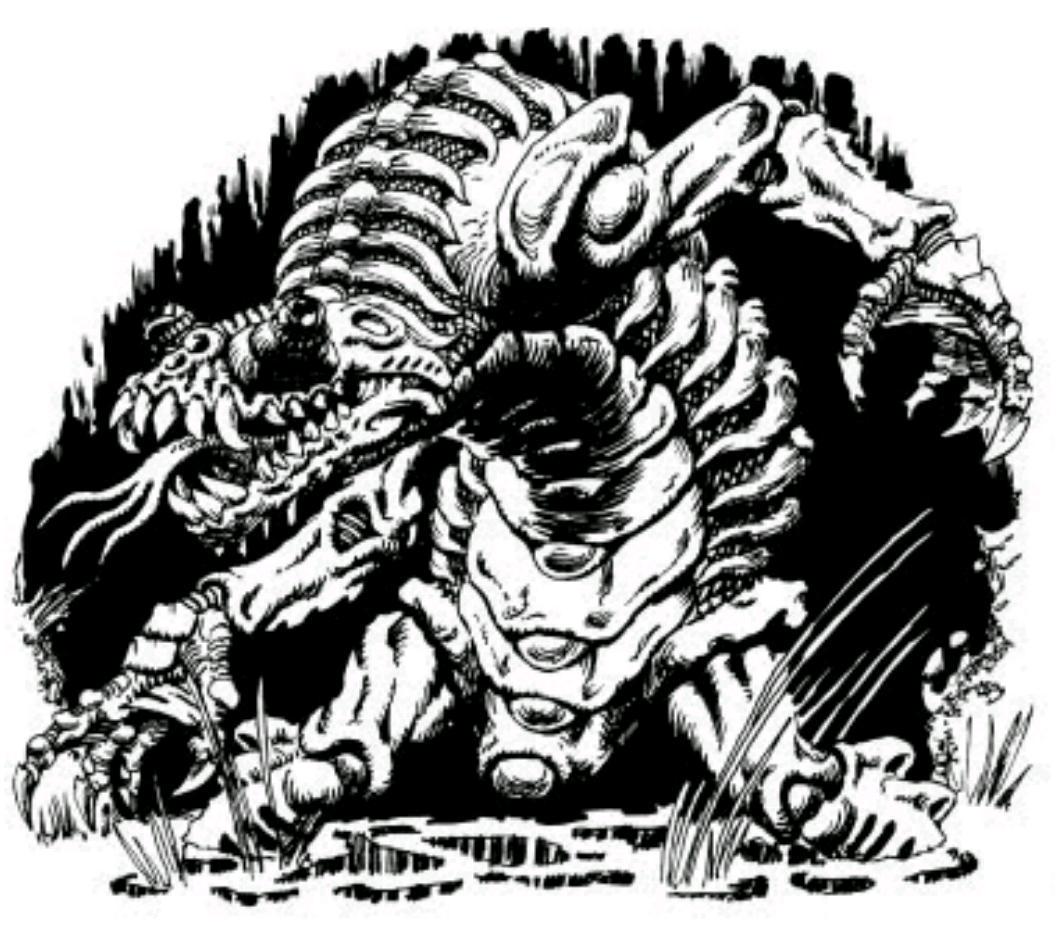
Bvanen
Bvanen are a race of intelligent, benevolent amphibians that dwell in the hot swamplands of Athas. Their appearance is somewhat frightening: raised, independently rotating eye turrets, prominent backbone-ridged carapace, chitinous belly plates, impressively clawed forepaws, and a toothy mouth from which flicks a tri-forked tongue. Their hesitant, distrustful nature often forces them into conflicts they would otherwise choose to avoid. They have their own language.
These amphibians use only their claws and bite, never weapons. They are not strong fighters. They do have a special attack power, however, which they use to partially immobilize their foes. Every bvanen secretes a sticky, quick hardening ooze through pores on its skin. This hardened ooze provides not only a protective shell around the bvanen, but a weapon that can be used to stick to foes on a successful claw attack.
Bvanen live in partially submerged caves in hot swamplands and in temporary camps. They use their hardened secretions to build nests out of wood and plants.
Bvanen CREATURE 3
1d8+6 piercing
1d6+6 slashing plus mucus
Cactus
The cacti of Athas can be extremely dangerous plants. While they provide nourishment to the dehydrated wanderer, they survive in the wastes by being as deadly as the beasts that roam the sands.
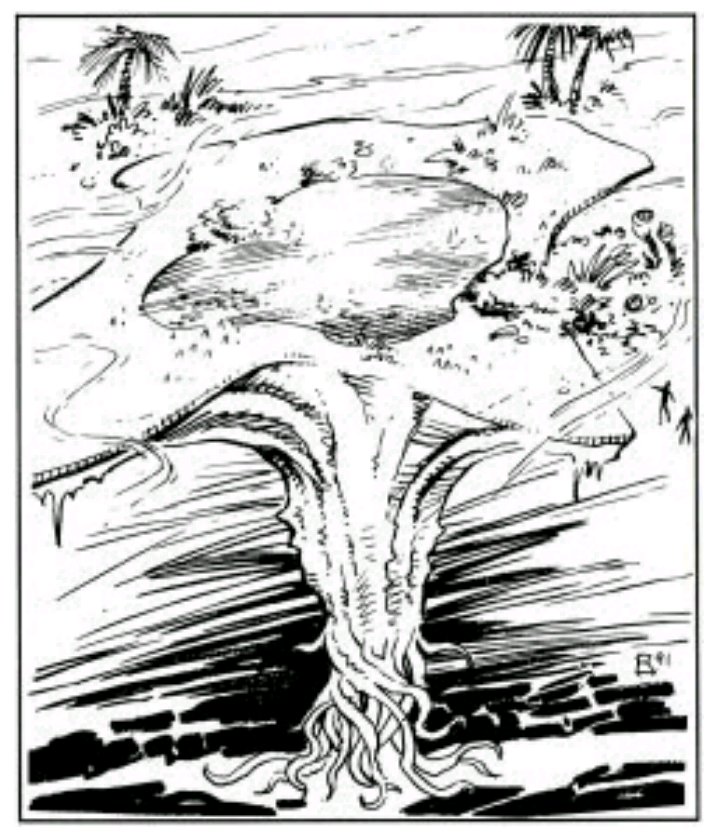
Dune Trapper
A sparkling oasis in the middle of the desert, the dune trapper appears to be the salvation of many lost travelers. Unfortunately for most, apparent salvation often turns into death.
The dune trapper is often mistaken for a solitary oasis in the desert. The trapper has the appearance of almost an acre of vegetation surrounding a small pool of water.
Dune Trapper HAZARD 9

Elven Rope
This plant is a twisted patch of reddish vines covered with hollow needles.
An elven rope is a predatory cactus found in Athas‘s wastes. The plant‘s tendrils are covered with hollow needles that suck blood from its prey. The main body of the plant lies a foot underground, so that only the spiny tendrils are visible above the surface of the sand.
Elven RopeHAZARD 3
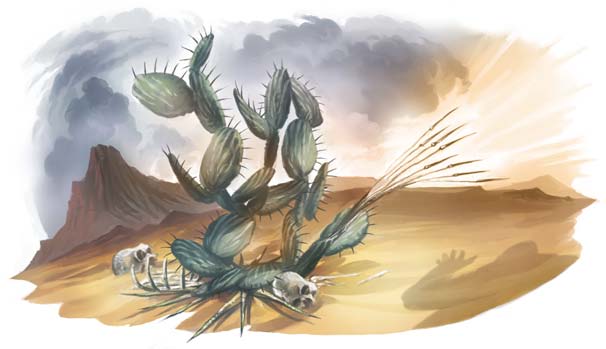 Credit: Brian Hagan
Credit: Brian Hagan
Hunting Cactus
A pale green cactus sporting spiny pods, this creature turns and angles its body to follow the movements of all who approach it. When in motion, it moves with a slow, deliberate shuffle.
The hunting cactus is a highly intelligent species of blood-drinking plant. Boasting a spread of useful psionic powers, the hunting cactus fires paralyzing spines at its prey and then drains the blood from its inert victims. Hunting cacti make their homes where they stand but are known to prefer the company of other cacti (although whether this is for camouflage or mere social purposes is unknown).
The hunting cactus prefers a carnivorous diet but will consume the saps of other plants for nourishment if no other options are available. Hunting cacti reportedly consider this a form of cannibalism, however, and are loath to feed on other plants.
Weighing ten pounds and standing three feet high, hunting cacti begin life at a mere six inches in height. They grow at a rate of three inches per month, but their maximum age is unknown as none has ever successfully been raised in captivity.
Hunting CactusCREATURE 1
1d6+2 piercing plus hunting cactus poison
Drain Blood
1d6+2 piercing plus hunting cactus poison
Rock Cactus
A small cluster of spherical rocklike plants that are found wherever water is rare, these cacti are a sandy brown in color and no more than a foot across.
The most common form of rock cactus is a plant that survives by attaching itself to other living creatures and draining the moisture from them through its spines. It lives in clusters near game or caravan trails and attacks when prey draws near. The rock cactus exudes pheromones that, while undetectable to most humans and humanoids, are compellingly attractive to many rodents and mammals.
The rock cactus is edible if peeled, having a taste and texture like apples, and a single plant will yield up to a pound of flesh and 4 pints of fluid. The plants can be safely harvested by tricking them into attacking a dummy target and then snapping their spines before they have a chance to retract them.
Rock CactusHAZARD -1
Bloodsucking Rock Cactus
Approximately one rock cactus in every 500 is a bloodsucking mutation that feeds not on moisture but on the very lifeblood of its prey. Indistinguishable from the standard rock cactus, they are somewhat tougher and more precise in their attacks, seeming to home in upon blood vessels and major organs.
Bloodsucking Rock CactusHAZARD 0
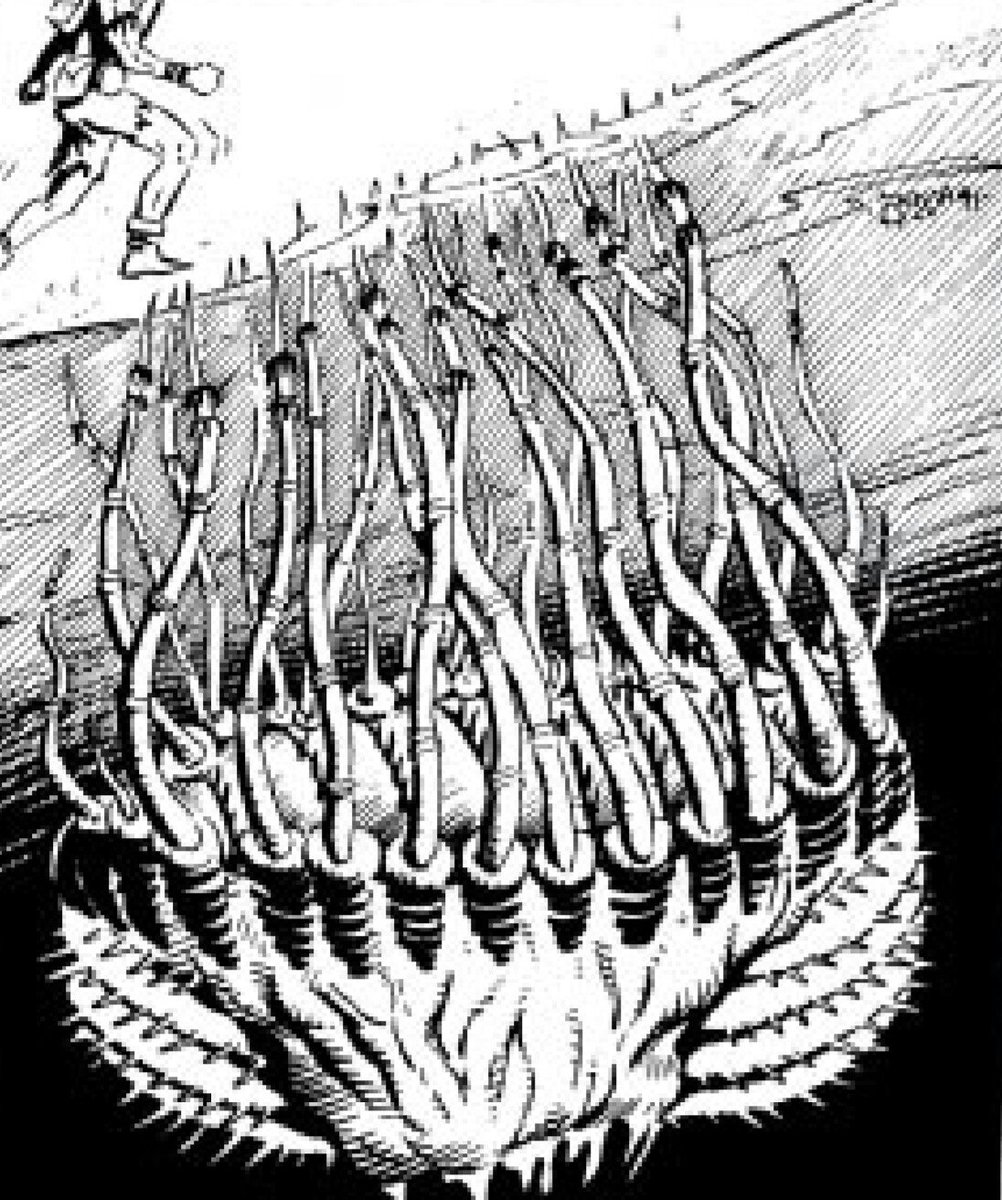
Sand Cactus
Sand cacti are a form of plant that feeds on the lifeblood of those that dwell near it. Sand cacti are well protected, for everything about the plant, except the needles, is hidden below the sand. The body can be from 5-8 feet across, 4 feet thick, and weigh up to 600 pounds. It has many barbed needles with long, thin strands connecting them to its bulbous body. The body and strands are a sickly white, while the needles are a sandy color, helping it stay camouflaged.
Sand cactus needles lie in wait for victims slightly above the surface of the sand. A traveler who doesn't notice the needles usually steps on one, potentially becoming pulled down onto more needles.
Sand CactusHAZARD 1
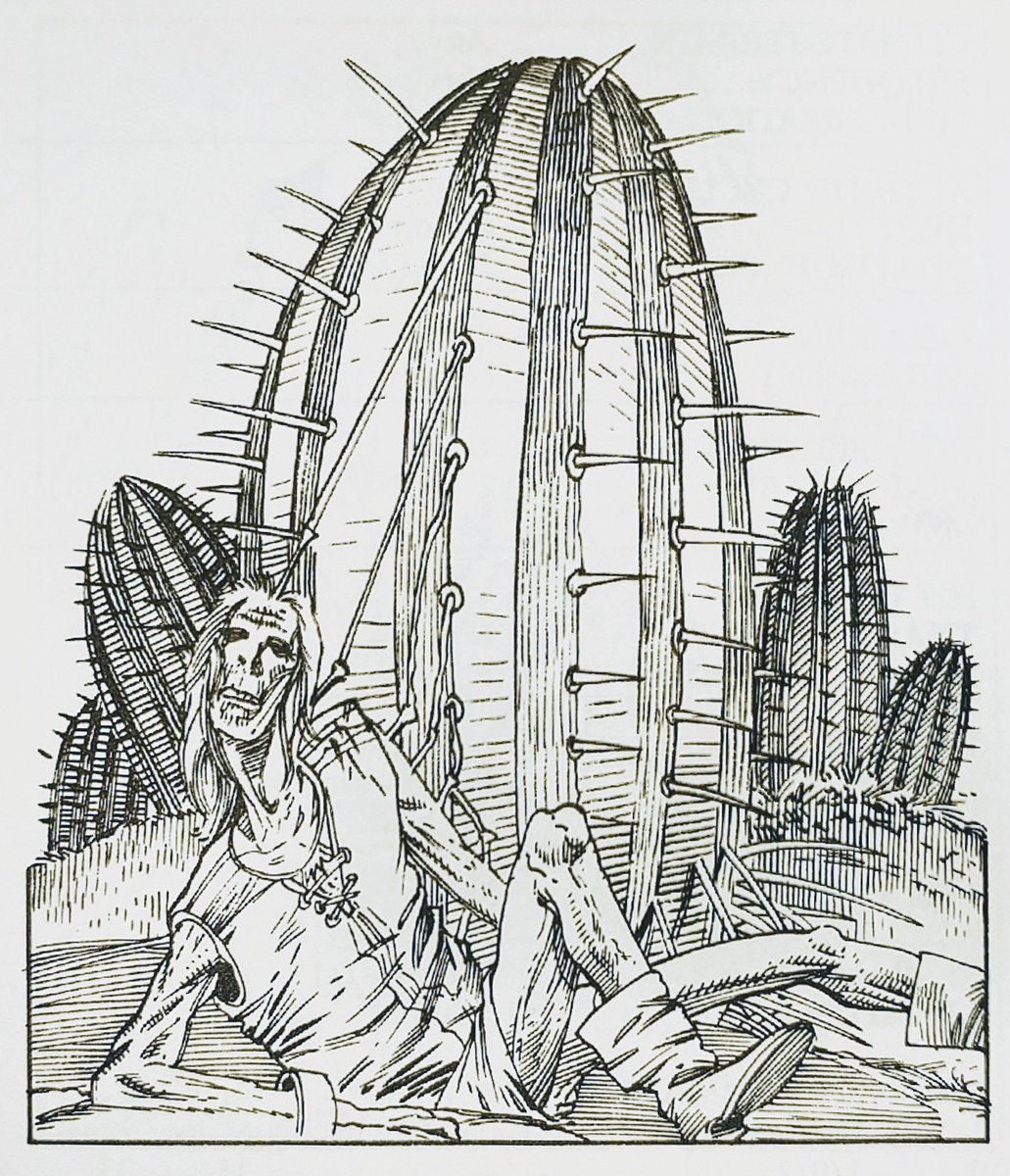
Spider Cactus
Spider cacti look like normal, harmless cacti. Projectile needles connected to tethers attack victims who get nearby. The victim is then dragged into the cactus, were the feeding needles make a slow feast of the hapless victim. Spider cacti are barrel shaped and are about 2 to 3 feet across, and usually reach from 6 to 7 feet tall. They are usually bright green in color, with some streaks of white along the barrel. They have purple and green needles.
Spider cacti have few natural enemies. It is perhaps the only creature that can even feed on kanks.
If the needles are rendered ineffective (fire is the most likely way of doing this), the cactus can be tapped for its liquid. It produces a honey-like liquid, like the product of erdlu eggs. Up to a gallon of this liquid can be tapped from a spider cactus. This liquid provides both food and water. A gallon of this liquid can be used to replace one gallon of water, or it can be used to provide nourishment for up to four man-sized beings for one day.
Spider Cactus HAZARD 2
(1 Action) The Spider Cactus fires a needle if any are remaining, or performs a feeding spine Strike against a creature in reach.
(2 Action) Pull the needles. The spider cactus pulls every creature grabbed by it's needles towards itself.
1d10+4 piercing plus spider cactus poison
1d8+3 piercing plus tethered grab
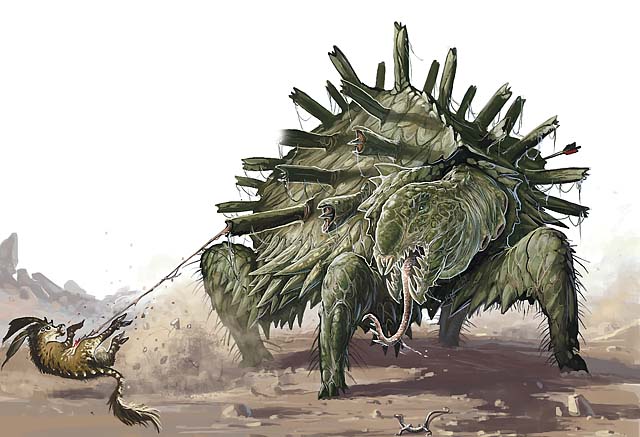 Credit: BenWooten
Credit: BenWooten
Cha'Thrang
Cha'thrangs are large, shelled predators, like giant tortoises, which hunt flying creatures. Due to the numerous reed shaped protrusions on their shell and their dun coloration, cha'thrangs are often mistaken for patches of dead plant growth. The protrusions on the cha’thrang’ s back are hollow appendages that allow the creature to shoot long barbed tethered darts at any creature within range. The creature‘s shell is created by an alkaline lime secreted from its back that further holds the shell in place. This same lime also creates a thin, sinewy fiber that tethers the creature’s darts and coats them in an alkaloid toxin.
Cha'thrangs travel in groups of three called trines, usually composed of two females and one male, but will adopt other cha'thrang that they meet, later breaking off into further trines. The creatures have problems mating because of their shell structures and often die in the process. Females lay annual clutches of 1-6 eggs, most of which are devoured by predators. Adult cha‘thrang themselves can live for hundreds of years but often succumb to predators before this time.
Cha‘thrang meat can be eaten if special preparations are taken to remove the lime under the shell. Its tethers can also be braided together to form rope.
Cha’thrangCREATURE 3
1d10+6 piercing
1d8+6 slashing
1d8+6 piercing plus alkaloid toxin and tethered grab
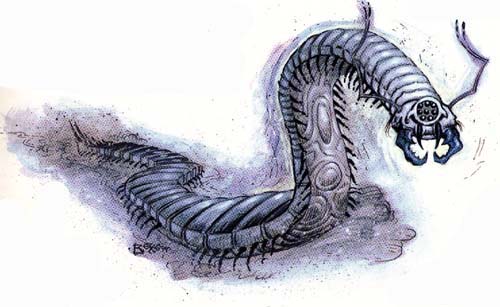
Cilops
Cilops are relentless hunters who are prized by the templars of all the city-states for their unique tracking abilities. The creatures look like enormous centipedes that reach lengths exceeding 15’, weighing 500 to 700 pounds. Their segmented bodies are long and flat and form a hard exoskeleton. Their hooked legs allow them to crawl onto virtually any surface and to scale walls with ease. Their oval heads have a large single compound eye and three pairs of pincerlike jaws. Two prehensile antennae grow from either side of the jaws and reach lengths of 3’ to 5’. Cilops have a protective coloration that reflects their native terrain. The cilops of the salt flats often display a chalky blue white to steel gray color while the cilops of the rocky badlands vary from rust orange to dark brown.
Cilops require no sleep and will relentlessly track prey for weeks. Cilops have not been successfully bred in captivity and must be captured. Templars from the city-states usually try to find cilops in the salt flats, where it is easier to spot them. Cilops have even been used to track others of their kind.
Native to the salt flats of Athas, the cilops have developed their extraordinary tracking abilities in order to find food in the barren wastes. Their poor depth of vision makes them rely upon their innate detection ability to warn them of predators. Cilops will feed on just about any moving creature – they prefer live prey. A cilops requires one dwarf-sized meal per week.
CilopsCREATURE 3
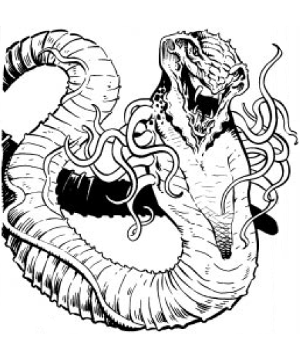
Cistern Fiend
Believed to have been bred by some forgotten king or conjured from the twisted mind of a long-dead sage, cistern fiends were originally intended to guard and purify sources of water. Since then, they have spread and are now a hazard that can be found throughout the Tablelands.
The cistern fiend, also known as the water worm, feeds in two different ways. It either kills and eats the occasional prey that enters the water source where it dwells, or it feeds on a more daily basis by filtering nutrients from the water supply through its mouth pores and gaining sustenance from the minor biological and mineral impurities in the water. For this reason alone, cistern fiends are beneficial to any community's water supply. Creatures slain by the cistern fiend have their body fluids filtered by the fiend, with the resulting pure water being expelled into the existing water supply.
Cistern fiends are hermaphroditic and reproduce asexually once every decade, with the offspring growing inside the membranous tissue that comprises the fiend's body and emerging through an eruption in the outer skin layer. Docile during delivery, the adult must be separated from its child after birth as no two cistern fiends can share the same water supply without the larger attacking the smaller. A cistern fiend must remain immersed in water, or it dies after 10d4 minutes. The creature's size depends on its age and the amount of water available, but most cistern fiends average 40 to 50 feet in length.
Cistern FiendCREATURE 13
3d12+14 piercing plus Grab
3d8+14 bludgeoning plus Grab and cistern fiend venom
A victim's drained condition decreases by 1 per week. A blood transfusion, which requires a DC 20 Medicine check and sufficient blood or a blood donor, reduces the drain by 1 after 10 minutes.
 Credit: BenWooten
Credit: BenWooten
Cloud Ray
Through the skies and clouds of Athas slowly fly these deadly giants. Cloud rays can sometimes be seen crossing the evening sky.
Cloud rays have a broad, flattened body and flap their huge pectoral fins to aid their psionic flight powers. They are speckled brown on top and drab olive and white underneath.
Sets of ridges protect the creatures’ eyes. They have four jet-black eyes, two mounted on each side of the snout and the other two on each side of the cranial bulge. Down the back from the bulge runs a spine that becomes a long, thin, whip-like tail that ends in an appendage known as a zip. The zip is comprised of razor-sharp, barbed ridges that grow at the tip of the spine. The interior mouth or maw (20 + feet across) is lined with row upon row of razor-sharp cartilage ridges.
The zip is also used in a complex signaling system that is only understood by other cloud rays.
Cloud rays wander aimlessly through the Athasian skies always searching for their next meal. On rare occasions, they land on the ground and may be mistaken for an outcropping rock. Those hapless enough to be standing on a ray when it decides to become airborne may become its next meal. A cloud ray’s preferred diet consists of devouring other flying creatures.
They have a special fondness for rocs, pterrax, and flying humanoids. The ray has no true stomach, preferring to swallow prey whole and grind the victim to liquid on its interior jaw ridges to help aid with digestion. After a good meal, cloud rays will sometimes psionically dream travel while their meal digests. Cloud rays have territorial respect for others of their species and, with very few exceptions, do not intrude into another ray’s air space.
They are solitary beings except when they seek a mate. Females have a gestation period which lasts over 3 years. They bear live young while airborne. The male catches and supports the young ray on his back for the first year of its life while the female forages. After the young cloud ray learns to fly and becomes self-sufficient, the three go their separate ways.
Although innately psionic, cloud rays become infuriated when a psionicist contacts them. It drives them into a tremendous rage, and they will do anything they can (except land) to capture and devour the offending psionicist. The Dragon is the only creature in the world that cloud rays truly fear.
A single cloud ray could easily provide an entire settlement with enough meat and raw materials for 2-3 months. The chances of this occurring are slim at best. These creatures are fierce and feared for good reasons. Entire villages have been reported decimated by a single cloud ray on the hunt. The effect of the creature hovering close over buildings and flapping its massive wings has the same effect as the deadliest sandstorm. The zip alone can easily destroy most buildings in a few swipes.
Cloud RayCREATURE 18
4d12+18 piercing and Improved Grab
4d8+18 bludgeoning
4d12+18 slashing plus stunning tail
4d8+18 bludgeoning plus Improved Push 10 feet
 Credit: Arnie Swekel & Matt Dixon
Credit: Arnie Swekel & Matt Dixon
Dagorran
Prowling the deserts in packs, much like wolves of other worlds, are the dagorrans — large, frog-like monsters with a gold-colored hide. They inhabit the sandy wastes around Draj, and because of their innate ability to pick up and track the psionic signature of most intelligent and psionic creatures, are often trained by Draji troops to capture runaway slaves.
In a dagorran pack, the leader is generally the strongest member of the group. When another dagorran wishes to vie for control over the pack, a battle to the death with the leader soon follows. Obviously, the winner becomes the leader, while the rest of the pack eats the loser. Dagorrans have kept the population of rodents and other small animals down to a tolerable level in the Athasian desert. However, their numbers are reducing quite quickly, as thri-kreen consider dagorrans a delicacy.
dagorranCREATURE 1

Dhaot
A dhaot is an incorporeal undead sometimes created when a creature dies far from its homeland. The compulsion to return home is so strong that it keeps the spirit alive. Dhaots often wander the wastelands lost, since they have limited senses.
Dhaots appear as they did in life but have an expression of weariness and sadness on their faces. Their faces appear dusty and sweaty. They are incorporeal but can manifest themselves and leave footprints in the sand when they wish. They can turn invisible at will. Dhaots attempt to return home and often stop travelers to ask for directions.
Travelers that fail to help a dhaot can be subjected to their Guilt Gaze as the dhaot will attempt to extort their cooperation.
DhaotCREATURE 1
1d4+1 void

Dragon of Tyr
Fortunately, there is only one dragon in the Tyr Region, and perhaps in the entire world of Athas. It is tall and thin, with a gnarled bone structure and swollen, bulbous joints. Its appearance is reptilian in many ways: it has a long, snake-like neck, whip-like tail, and scaly hide. Yet it walks on two legs, its hands have long, well-developed fingers and thumbs, its bone structure seems faintly humanoid, and its head is long and narrow, with a distinctly mammalian appearance.
The dragon wanders over all parts of Athas, usually alone. Occasionally, it visits a sorcerer-king, leaving disaster and chaos in its wake.
Dragon of TyrCREATURE 25
5d12+20 piercing
5d10+20 slashing
4d12+20 bludgeoning
4d10+20 bludgeoning
Drakes
Drakes are gargantuan, reptilian beasts that trace their heritage back to the elemental planes. Now dwelling on Athas, they have come to view their adoptive home as their personal hunting grounds. Cunning and ferocious and sporting powerful psionic abilities, the drakes are considered by many on Athas to be second only to the Dragon in power. The first drakes were not natives of Athas and used tremendous psionic powers to travel from their home elemental planes to Athas, where they found a world much to their liking. Many generations of drakes have been born on Athas since that time.
Striking at their foes with claws, a savage bite and a sweeping tail attack, drakes share many combat techniques with draconic creatures of other worlds. Drakes are large enough to swallow some opponents whole and will use this attack option in preference to all others if the target is of a suitable size. All drakes enhance their physical prowess with psionic powers, and those of the four ―classic elements (air, earth, fire and water) are also capable of launching elemental attacks against their targets.
Despite their power, drakes are nevertheless accorded an almost legendary status by most Athasians. Few people believe they really exist. Even fewer have ever seen one, and very few of those have lived to tell about the experience. This is not least because drakes prey largely on humans and humanoids (although they will eat inix and mekillots when available and erdlu if necessary). Drakes prefer the taste of carnivore flesh over any other type of meat.
A drake‘s hide can fetch an enormous price on the trading market but can also result in a death penalty as the hides, teeth, claws, and blood are of such value that some sorcerer-kings forbid their sale. They have instructed their templars to confiscate any such items that appear in the market in the name of their sorcerer-king. Elves, of course, defy these edicts at every turn, and make a fair profit selling drake materials while just one step ahead of their templar pursuers.
Drake hide makes outstanding armor, the teeth and claws make excellent weapons, and the blood of the beast is also valuable as it is used in certain alchemical solutions. Beyond these incredibly useful items, folklore holds that just about any portion of a drake's carcass holds a great deal of magical luck, a belief that is often relied upon by disreputable elven hawkers who push a variety of lucky tokens, allegedly fashioned from drake parts.
Drakes mate when the urge strikes them and swiftly separate after pairing. No more than two eggs are laid, hatching after six months, and the resulting drakelings are almost always hungry and need constant care. Young drakes grow from two to twenty feet in the first year, then five feet each year thereafter until they reach full size for their species.
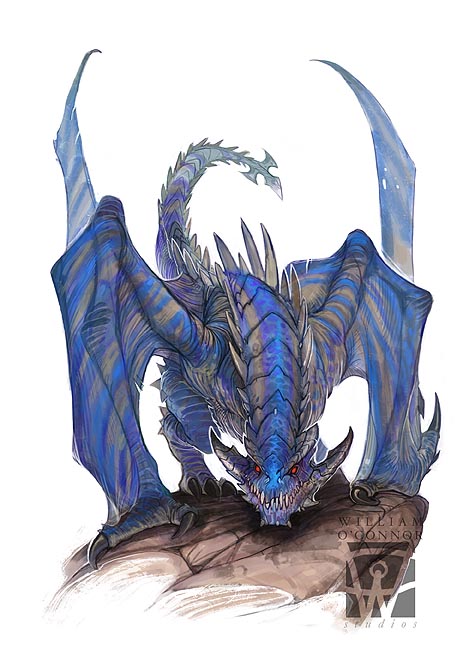 Credit: William O'Connor
Credit: William O'Connor
Air Drake
Air drakes are the most flighty and unpredictable of the species, making them dangerous adversaries. They spend most of their time soaring the Athasian skies.
Air drakes are the longest and leanest of the four drake types. They have folds of loose skin that stretch between their front and back legs. This skin unfolds when they extend their legs creating a wing membrane. They have a long, lean frame and are light of bone, contributing to their speed and agility.
Air drakes prefer their food thoroughly softened before eating it. To accomplish this, a drake will swoop, grab its prey, soar into the sky, and then drop it. Air drakes often choose crags or rocky outcroppings for “tenderizing their meat”. If the prey can fly, it will take the victim aloft and dive straight for the ground, releasing its prey and pulling up at the last minute.
An Air Drake's Lair
Air drakes do not keep a single residence. They prefer a dozen or so safe areas. Because they move around so much, air drakes gather and horde few possessions and treasure. Often if they find an object that pleases them, they will store it at a lofty, inaccessible location. They will leave it and return to visit only when the mood strikes them. Little infuriates an air drake more than having one of these precious items stolen.
Air DrakeCREATURE 19
4d12+15 piercing
4d8+15 slashing plus Improved Grab
4d10+15 bludgeoning plus Improved Knockdown
4d10+15 bludgeoning
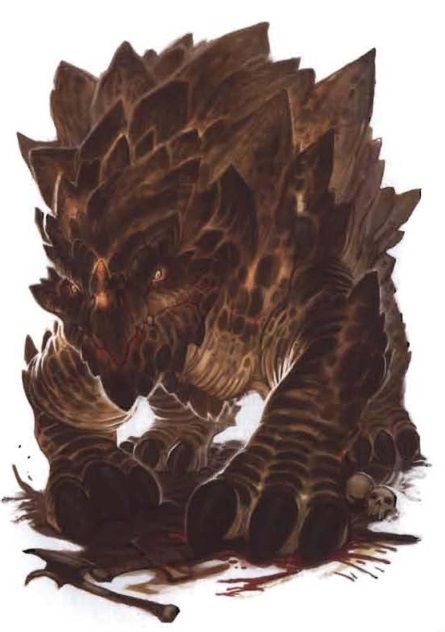 Credit: William O'Connor
Credit: William O'Connor
Earth Drake
Often mistaken for an outcropping of rock, earth drakes are by far the physically strongest of the species. The gray, black, and brown reptilian creature is covered with thousands of small, spiny scales. The massive forelegs are designed for digging through solid stone. The hindlegs are equally as powerful and may be used for digging, but most often serve as anchors. Earth drakes’ tails are short but incredibly thick, which forces the monsters to swagger when they walk.
Earth drakes’ heads are wedge-shaped. The scales on the top of the head overlap to protect the earholes. The creature’s eyes are inset and covered by two eyelids - a soft, inner eyelid that is airtight, and an outer, protective, scaly eyelid that is highly puncture resistant.
Earth drakes resent the encroachments of humanity, and they especially dislike any type of permanent buildings. An earth drake thinks nothing of travelling many miles in order to destroy man-made settlements.
Earth drakes enjoy a battle before a meal. The more fight a creature puts up, the better the drake will enjoy eating it. Earth drakes are known to dig themselves in along trading routes for opportunities to do battle and dine on mekillots.
An Earth Drake's Lair
Whether they dig into the bedrock beneath the sands of the Athasian desert or into a hillside, earth drakes always cover the front of their habitat with loose dirt. This creates a collapsible front entrance which the earth drake uses to defend its lair.
Earth DrakeCREATURE 17
3d12+20 piercing plus Improved Grab
3d8+20 slashing
3d10+20 bludgeoning
 Credit: William O'Connor
Credit: William O'Connor
Fire Drake
Fire drakes are the most evil and malicious of the drakes. They enjoy inflicting pain for the pleasure of watching their victims writhe in agony. A fire drake’s greatest delight comes from torturing a potential meal.
Fire drakes are large, spiny, reptilian creatures with pebble like skin. Each pebble is a scale. They are red-and-black mottled, similar in color to the dying embers of a fire, and their skin is very glossy. fire drakes have four legs. The front two are smaller with very sharp claws, while the back legs are longer and thicker.
A Fire Drake's Lair
Fire drakes prefer to live near natural volcanic action or in areas where they can bask all day in the hot Athasian sun. At night, they retreat to an area of safety or bury themselves under the hot sand. They do this to insulate themselves from the cool evening air.
Fire DrakeCREATURE 15
2d12+15 piercing plus 4d6 fire and Grab
3d8+15 slashing
3d10+15 slashing
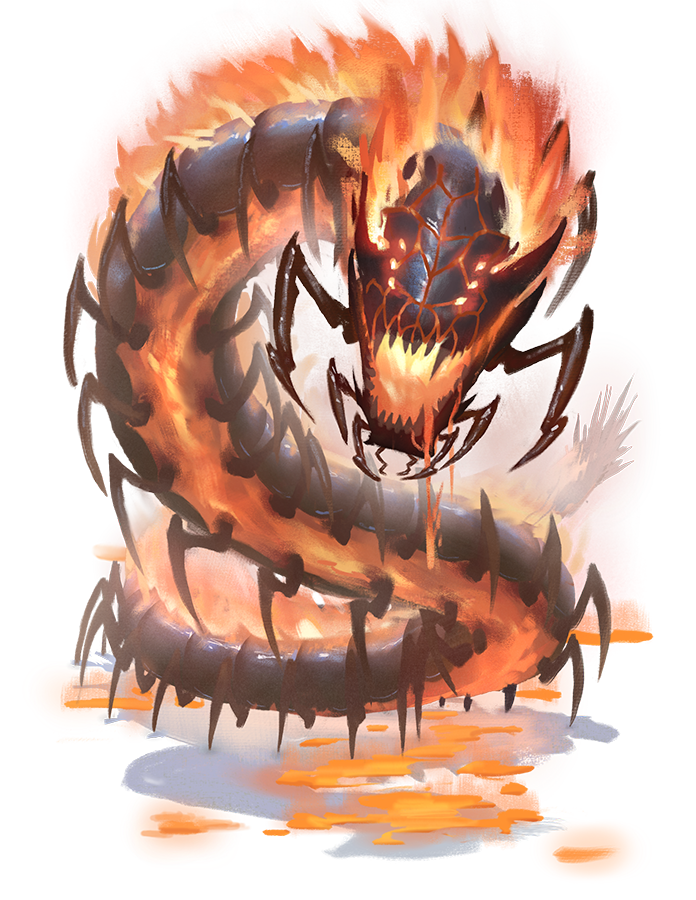
Magma Drake
Magma drakes are enormous creatures that look like worms with multiple legs across their body. The drake can swallow creatures as large as 12 feet long. Their bodies are covered with thick scales in varying shades of red. The magma drake has multiple eyes set toward the top of its head with pincers to each side of its mouth. The nose and eyes have protective flaps of very tough skin that close when the drake is swimming through molten lava.
The magma drake attacks from below the surface, often leaping out of a pool of molten lava to surprise its prey. A magma drake fights from within molten lava if it can.
A Magma Drake's Lair
Magma drakes prefer to live in caverns in or near active volcanoes. They are at home in the lava and can survive submerged for as long as three hours.
Magma DrakeCREATURE 17
4d10+8 piercing plus 2d10 persistent fire and Improved Grab
4d8+8 bludgeoning plus 2d8 persistent fire
2d10+8 bludgeoning plus 2d8 persistent fire

Rain Drake
The rain drake has a sleek body, perfectly suited for the water. It usually makes its home near waterfalls, but any body of water makes a suitable home. Rain drakes loath water drakes and will attack them at any opportunity. They are smarter and faster than water drakes and can survive out of the water for a few hours at night, or for longer periods whenever there is rain.
Rain drakes, almost as rare as their hated foes the water drakes, dwell in those few places that rain still falls on Athas – forests such as those that clad the Ringing Mountains, and the Crescent Forest of the Ivory Triangle.
Rain drakes fight in water, if possible, but can "swim" even in light rain. Although rain drakes cannot fly, they can use even a small amount of water to ―swim through the air. They have no natural enemies except for water drakes.
Rain drakes can survive out of water for a few hours in the night or if any cloud cover is producing rain. They dehydrate if their hide is not wet. Rain drakes can smell water as far as 10 miles away.
A Rain Drake's Lair
Rain drakes make their lairs in pools beneath waterfalls if they can, but any body of water is a possible lair. The lair usually is a water-filled grotto, but it may have a dry patch with an air pocket.
Rain DrakeCREATURE 17
2d10+16 piercing plus 2d12 electricity, 2d6 sonic, and
thundering bite
3d10+16 slashing
4d8+16 slashing

Silt Drake
This creature resembles a long, sand-colored snake. It has a huge mouth, dark eyes, and two horns on its head. It has no claws or feet but swims silently through the silt.
Silt drakes are migratory creatures, never staying long in a single place. They have no permanent lair or territory and instead wander through the silt in search of food.
Silt drakes are perhaps the most common of all drakes as their parent element is found in abundance throughout Athas. However, this has also meant that they come under attack from other predators far more often than do the other drakes. Nevertheless, only the largest silt horrors and paraelemental beasts can threaten a silt drake, and their supremacy of the silt remains unchallenged.
A silt drake has the appearance of an immense horned serpent that writhes through the silt, rearing itself above the surface to attack. Its coloration means that it is often indistinguishable from its surrounding element –frequently much to the surprised dismay of its prey.
Once a year, a male drake issues a call through the dust to any females nearby. If a female answers the call, the male and female mate briefly and then separate. The female lays her clutch of 3-6 eggs in the deepest parts of the Sea of Silt and then abandons them to their fate.
Silt DrakeCREATURE 17
3d10+17 piercing plus improved grab
4d8+17 bludgeoning plus improved grab

Sun Drake
A huge creature flies overhead, its wings creating a large circle that blocks out the sun. Its wings shimmer in the light, with orange, red and yellow hues. The creature has a long thin body, four sharp claws, and a long thin tail.
The sun drake is a fearsome creature, intelligent, vicious, and extremely dangerous. It prefers to make its lair at the top of the highest peak wherever it lives, spending its days soaring the wastelands on thermals. Sun drakes have a 40-foot wingspan, and its wings give it an almost circular appearance when gliding through the air.
Sun drakes, like those of silt, are relatively common on Athas, basking the life-giving rays of the dark sun itself. They hunt from the upper airs, descending only to attack and devour prey before returning to the sun-burned heavens that are their home.
A Sun Drake's Lair
Sun drakes prefer to live among the highest peaks in whatever area they inhabit. They use their lairs only at night, spending their days soaring on thermals.
Sun DrakeCREATURE 18
4d12+15 piercing plus 2d6 fire and Improved Grab
4d10+15 slashing
4d10+15 slashing
 Credit: William O'Connor
Credit: William O'Connor
Water Drake
The water drake is the most elusive of all drakes. This is due mostly to the hatred they hold for what humanity has done to Athas.
Water drakes are pale, grey blue in color, with a blow hole centered in the back of their heads. Water drakes are the slimmest of the drake family. Their four webbed feet end in sharp, triangular claws. Water drakes’ tails are thinner and flatter than other drakes, and they provide excellent propulsion when in water.
Water drakes are reclusive and prefer as little contact with humanity as possible. They will avoid intruders but will kill without hesitation those humanoids who trespass upon their lair. Because of the horrors rent upon the planet by humanoids, water drakes have absolutely no regard for such life. Their four webbed feet help them move massive quantities of sand. All four feet have sharp, triangular claws designed for digging into and holding onto prey, or for raking.
A Water Drake's Lair
They make their home near a deep-water source, if possible; many guard passages to aquafers trapped deep below the ground
Water DrakeCREATURE 15
3d12+14 piercing plus hyponatremia
3d10+14 slashing plus Grab
3d10+14 bludgeoning plus Grab
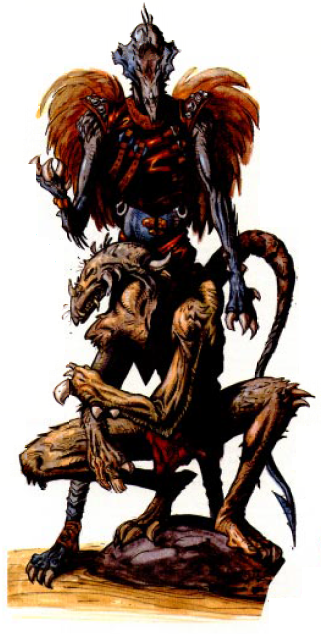
Dray
Created many centuries ago by the sorcerer-king of Giustenal to serve as a race of mage-warriors, are a strong, resilient race of dragon like humanoids. Most dray were cast out of their home by their creator long ago, and a handful of drays survived when their home state was destroyed. From those ancient refugees arose a race of mercenaries, sorcerers, and slave traders known for their calculating (and sometimes duplicitous) ways.
The dray are not a numerous people. They live in tight-knit clans that often share a secret citadel or tower in the wastes. Clan members roam far from their mysterious retreats, looking after the group’s interests. Some drays take part in the slave trade, hiring raiders or mercenaries of other races to serve as their slave catchers.
Dray who object to trafficking in slaves often earn a living as deal brokers, moneylenders, or speculators. They are also renowned as sorcerers for hire. Dray strike deals with the sorcerer-kings of various city-states, paying richly for licenses or dispensations to practice arcane magic in those locations. Nobles, wealthy merchants, and templars have need of a sorcerer clan’s services and pay very well for them.
Dray live by a brutally pragmatic philosophy rooted in their exile from their home state. They tend to be avaricious, sly, and amoral, although they carefully observe the exact wording of any deal or bargain, they strike, since it’s good business to have a reputation for living up to agreements. The dray learned long ago that they can rely only upon one another, and they are fiercely loyal to their clan brothers and sisters. A clan gathers from far and wide to avenge an insult or an injury to one of its own, and the group won’t rest until the vendetta is settled.
DrayCREATURE 1
Dray Soldier
All drays are expected to fight for their sorcerer-king when the time comes. They are provided armor and weapons and lead by the templars.
Dray SoldierCREATURE 2
1d6+6 bludgeoning
Dray Templar
Dray templars protect the citizens and see to their spiritual needs, so they are free to work and raise families. Templars are provided well-crafted armor and metal weapons.
Dray TemplarCREATURE 2
 Credit: antilous
Credit: antilous
Dregoth
The Dread King Dregoth was killed almost 2,000 years ago by the combined powers of seven sorcerer-kings. Shortly thereafter, Dregoth rose as the undead dragon king. While Dregoth is a unique being, his new state is similar to that of a kaisharga, a lichlike creature native to Athas. He has existed in this state since the day of his return, neither dead nor alive, neither fully human nor fully dragon.
In life, Dregoth was on the verge of achieving the final stage of metamorphosis. He had been a champion of Rajaat the Warbringer, a general in the devastating Cleansing Wars that laid waste to the world. When it became clear the Warbringer was going to betray his Champions, Dregoth helped imprison Rajaat. Once Rajaat was safely locked away, Dregoth helped the other champions (now sorcerer-kings) turn Borys into the Dragon of Tyr to guard over the Warbringer’ s prison.
The sorcerer-kings decided to destroy the Dread King of Giustenal, who was next in line of the remaining Champions to become a full Dragon. They feared that the insanity that had affected Borys shortly after his transformation would soon affect Dregoth. They ambushed Dregoth in his own palace, battering him with the Way, pounding him with spells, and even striking him with weapons and fists. Dregoth fought bitterly, but the seven struck without warning. He died, and his city died with him.
Dregoth now rules a city far removed from the light of the crimson sun: the city of New Giustenal. He looks much as he did in life, one step removed from a full dragon. He is 30 feet tall and weighs 20,000 pounds. He has a dragon’s form, with wings, scales, a tail, claws, and a devastating fiery sand breath. Dregoth’ s physical shape was severely damaged by the attack of the sorcerer-kings. So, his wings are torn, his body still wears the wounds inflicted upon it, and gaping holes show exposed bone in many places. The armored skin that remains is stretched thinly over the skeleton beneath. His eyes, like the eyes of all kaisharga, burn with green fire.
Dregoth rules the city of New Giustenal, which is located far below the ruins of the ancient city of Giustenal. He created two types of dray, one of which serves him and worships him as a god. When Dregoth isn’t locked inside his Dread Palace, he wanders the planes seeking ways to become a true god. This is his quest, though he doesn’t realize that godhood is impossible to achieve on Athas.
Dregoth never appears to his citizens in his true form. Instead, he wears one of two false forms in front of the masses. The first of these forms is that of a tall, regal dray. This is what most of the people of New Giustenal believe their god king to be. The second form, used on rare occasions, is that of a living dragon. This form is modeled after Dregoth’ s true form before it was corrupted by undeath. A combination of magic and psionics, much of it imbued in the amulets and rings Dregoth wears, maintains the illusory forms, though the Dread King can drop or shift between them at will.
DregothCREATURE 24
6d12+11 piercing plus 2d10 void
6d10+11 slashing plus 2d10 void
6d10+11 bludgeoning plus 2d10 void
5d10+11 bludgeoning plus 2d10 void
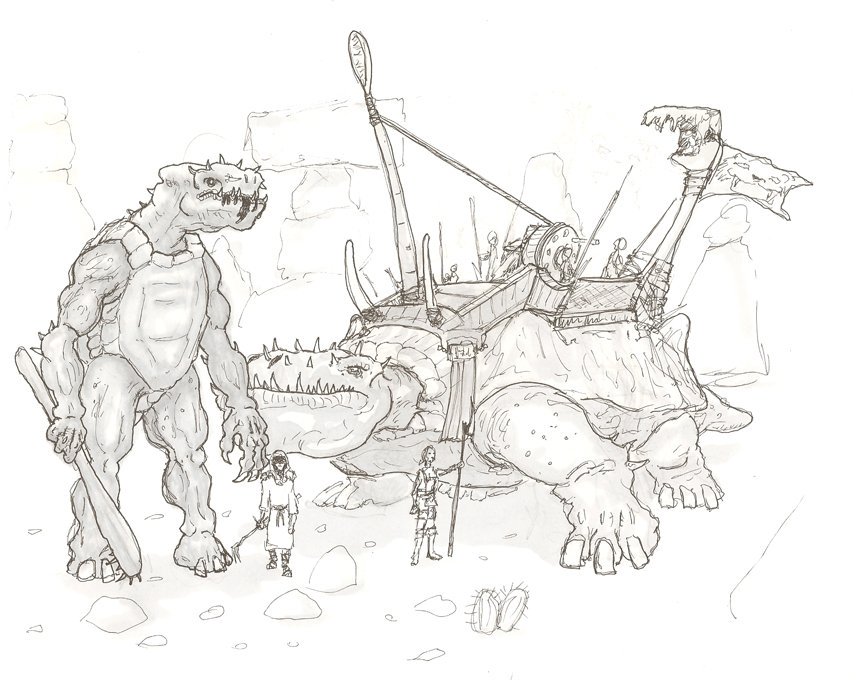 Credit: Mike Fleming
Credit: Mike Fleming
High Drik
A drik is a powerful and massive herd lizard. Its sheer bulk gives it an awesome might, making young driks targets for beast masters from both Urik and Raam to serve in their armies. The capture of the young driks has all but depleted the wild drik.
A drik is a powerful animal, built low to the ground and covered by a thick horn-encrusted shell. At birth the drik has no shell. But while growing, the young drik secretes a resin and bits of bone that form the beast’s carapace. The shell hardens as the creature matures to an adult and protects the drik from behind the head all the way to the tail. This shell is a dark gray, speckled white with bone chips. The scaly hide of the drik is a deep brown, though some appear light brown or even yellow. The drik’ s heavy body is supported by four thick, stub like legs, each sporting four huge claws. The drik’ s head is enormous and has two black eyes. It has and a large mouth capable of swallowing a human whole. Several jagged tusks protrude menacingly from below the creature’s mouth. The drik communicates with other driks through grunts and bellows. More intelligent creatures must use psionics or magic to communicate with a drik.
Another more foul and corrupt method for altering the drik is known only to the defilers under the directorship of King Hamanu, warrior king of Urik. The minions of Hamanu are sent to the shores of the Black Waters to find drik eggs. These eggs are brought back to a bestiary that has been especially designed for this type of experimental conversion.
The defilers use their foul magics to change the way the beasts develop within their eggs. Only 20% of the treated eggs survive the process. The process stunts their growth, allowing them to grow to a maximum height of only 18 feet. However, the benefits to the armies of Hamanu far outweigh this minor setback.
High driks are relatively quiet and nimble bipeds. Their forelegs have mutated and now boast three fingers instead of the clawed hooves of their brethren. The skin of high driks is a dark, blood-red to black and veins protrude beneath the thick hide of the creatures. Their shells retain a smaller but relatively unchanged shape except that they are more twisted and jagged than the natural form. The shell color ranges from gray to black with sickly-green flecks riddling the surface.
The tusks around the high driks’ heads are proportionately smaller than those of their unaltered relatives. Their mouths, however, are filled with multiple rows of black, razor-sharp teeth. Green, viscous fluid seeps from their slavering maws.
High driks are also relatively intelligent and can speak in a crude form of the common tongue if taught. They can also communicate with other natural driks.
It is believed that the transformation this creature undergoes causes it to become insane and psychotic. It is, however, impossible to tell as there is no equivalent being to compare the high drik to. At the very least, the high drik is sadistic and cruel, taking immense joy in causing pain to others.
Because high driks have retained their native language of grunts and growls, they are usually used as beast masters to Hamanu’s war driks. The control high driks exercise over war driks requires no psionics or magical links and little training is necessary for a war drik to learn to obey the commands of its high drik master.
If a controlling high drik is killed in combat, the war drik becomes confused and begins to rampage, attacking and ramming random structures and even allied driks.
Capable and even imposing in melee, high driks are at their most formidable while using their innate abilities as defilers and psionicists.
High DrikCREATURE 9
 Credit: Ben Wootten
Credit: Ben Wootten
Dune Freak
The dune freaks, or anakore, are a race of dimwitted humanoids with bony, wedgelike heads, small ears pressed close to the sides of their heads, and sunken, beady eyes covered by clear membranes to prevent sand from scratching these delicate tissues.
The bright light of Athas’ sun blinds the anakore during the day, but at night they can see as clearly as most beings do during the day.
The anakore have an unusual dorsal ridge running along their spine. This fin is a sensitive organ which picks up minute vibrations traveling through the sand. With it, they can locate a solitary creature walking on the sand from as far away as five miles.
Anakore usually attack their foes by burrowing underneath them, then striking from beneath the victim with their sharp claws. The anakore continue to fight from within the sand for as long as possible gaining cover while they do so.
The anakore live within any sandy heap, such as sand dunes or the alluvial fans at the mouths of the canyons. Normally, they travel and hunt in small packs of two to twelve individuals, with the largest, most aggressive acting as leader. They are rarely found outside of sandy areas, but they can walk upright across various kinds of terrain — though they are unusually vulnerable in this state and will avoid fighting at all costs.
The anakore are nomadic burrowers who are constantly moving through the sandy wastes of Athas. It is often possible to identify an area through which anakores have passed by the dead plants found there — the anakores chew the roots away, leaving the upper stalks exposed. In addition to their diet of plant roots, the anakores also eat meat — mekillot, inix, erdlu, elf, dwarf, halfling, and nearly anything except kank.
Dune FreakCREATURE 1
 Credit: Ben Wootten
Credit: Ben Wootten
Dune Reaper
The dune reaper prowls the sandy wastes in wild packs, eating anything it finds after ripping it apart with scythe like limbs. Perhaps the most disquieting features of the dune reaper are the eerie red luminescence of its eyes and the sickly-sweet smell of decay that surrounds it. The reaper emits a howling wail that can frequently be heard across the barren deserts of Athas. At 6 feet tall and 3,000 pounds, the size, ferocity, and eerie appearance of the dune reaper makes it a highly valued combatant in many Athasian arenas, especially since they tend to go berserk when separated from the hive.
Dune reapers are matriarchal, hive creatures, which create male drones to create hives using their saliva to bind sand and gravel. They have a complex form of communication involving sound, motion, and scents used to communicate when prey has been located.
Dune Reaper DroneCREATURE 5
Dune Reaper WarriorCREATURE 7
Dune Reaper Matron
Dune Reaper Matrons are the same level as warriors. To make a dune reaper matron, remove Pounce, and Rend, and give it the following spells and Frenzy Pheromone action.
Occult Innate Spells DC 25, attack +17; agonizing despair, paralyze, mind reading (at will); daze, message, telekinetic projectile
Frenzy Pheromone ![]() The dune reaper matron unleashes a pheromone that causes all other dune reapers within a 100-foot emanation to become quickened 1 until the start of the dune reaper matron’s next turn, and they can use the extra action only for Burrow, Stride, or Strike actions. The dune reaper matron can’t unleash the pheromone again for 1d4 rounds.
The dune reaper matron unleashes a pheromone that causes all other dune reapers within a 100-foot emanation to become quickened 1 until the start of the dune reaper matron’s next turn, and they can use the extra action only for Burrow, Stride, or Strike actions. The dune reaper matron can’t unleash the pheromone again for 1d4 rounds.

Dune Runner
Dune runners are elves who died running to complete a quest or deliver an important message. They are undead, forever trapped and forced to repeat their hopeless mission night after night.
From a distance, a dune runner appears to be a muscular elf running across the terrain. Upon closer inspection, however, the very thin, gray skin can be seen pulled tautly against its boney frame.
The dune runner remembers all the languages that the elf knew when it was alive. It is said that they sometimes talk to their victims as they run across the Athasian desert.
These haunted creatures have transcended physical limitations and run each night for the sheer pleasure of it. Their evil fixation is so consuming that they compel the living to join them in their crazed, headlong run into oblivion. Few individuals have ever run the entire night with a dune runner in order to find out what happens to them at dawn; the ones who live often refuse to speak of that night for the rest of their lives.
The dune runner is a bane to any caravan travelling across country. It has been reported that some small caravans have been found deserted along a known dune runner's path. The traders are often found miles away, dead from exhaustion and dehydration. Larger, more experienced trading caravans will even delay their travel a half-day rather than cross or camp along a dune runner's trail near dark.
Dune RunnerCREATURE 3
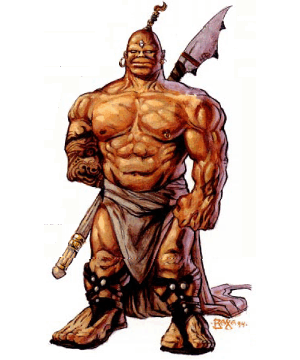
Dwarf
Dwarves are short, stocky demihumans capable of amazing feats of strength. They are known for obsessive attitudes about the tasks they perform and as such, are considered extremely reliable workers.
Dwarves stand an average of 4½ to 5 feet tall. They tend to have disproportionate statures because of over-muscled bodies and sometimes weigh as much as 200 pounds despite their height. Their massive hands permit them to hold weapons that seem too large for their size. Equally large feet help keep their bulging frames standing. Deep-set eyes sometimes give the impression that the dwarves are constantly observing, silently watching and judging the actions of those around them.
Other than a distinctive build and usually hairless heads, dwarves do not stray too far from a human appearance. However, endless hours laboring under the scorching, Athasian sun has brought them deep copper tans and calloused bodies. There is a joke spread by the humans that dwarves use no whetstone to sharpen their weapons; instead, they are said to rely upon their own skin to keep their blades sharp.
The dwarven language is deep and throaty, with hard, guttural consonants that usually end the brief sentences. Since their tongue often makes non-dwarves hoarse after a few hours of speech, dwarves are willing to learn the common language spoken by merchants throughout the land. Because the language is so difficult, dwarves view with respect those who attempt their language for extended periods, in return for the honor they feel is being demonstrated to them.
Athasian DwarfCREATURE -1
1d8+2 bludgeoning
Dwarven Senior GuardCREATURE 4
Dwarven Sun ClericCREATURE 1
1d8+1 bludgeoning

Dwarven Banshee
A dwarven banshee is a dwarf that died before completing a major focus. The dwarf’s spirit haunts its life’s work, terrorizing its former friends and all those that still work on the focus.
The dwarven banshee is a gruesome sight to behold. All its skin peels away, revealing the muscle underneath. This muscle may turn brown in the sunlight or become gray and moldy if the banshee remains under ground. The banshee’s eyes burn like flames. The banshee retains its memories and speaks the same languages it did in life.
Dwarven BansheeCREATURE 6
2d6+8 void plus terrifying touch
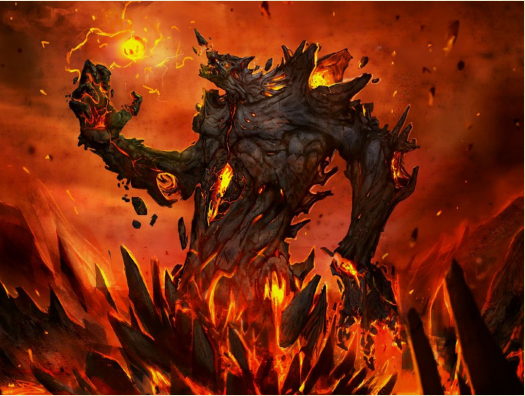
Clerical Elemental
Some of Athas' most powerful clerics develop a primordial spark. These individuals begin to bond with their element and their body becomes enveloped in elemental energy. Fire clerics become enveloped in flames, water clerics start dripping water and so on. These clerics also learn to shape shift into an elemental form multiple times a day.
Clerical elementals possess a fascination with elemental magic and lore greater than that of other clerics. They see their primordial spark not as a tool, but as a gift and a natural part of who and what they are. Everything they do, everything they see, and everything they learn is examined and analyzed as it relates to their elemental goal first, and to all other concerns second.
This doesn't mean that they have no other goals or other passions. They might adventure alongside friends, help the local population, or fight on a battlefield for a cause that they believe in, just like any other cleric might do. Even in the midst of all this, however, they learn and study constantly, seeking to understand what their element desires and how they can better serve it.

Clerical Elemental of Air CREATURE 12

Clerical Elemental of Earth CREATURE 14
3d8+8 bludgeoning

Clerical Elemental of Fire CREATURE 16
3d6+6 slashing plus 1d6 fire

Clerical Elemental of Magma CREATURE 14
3d12+6 bludgeoning plus 2d6 fire
3d12 fire
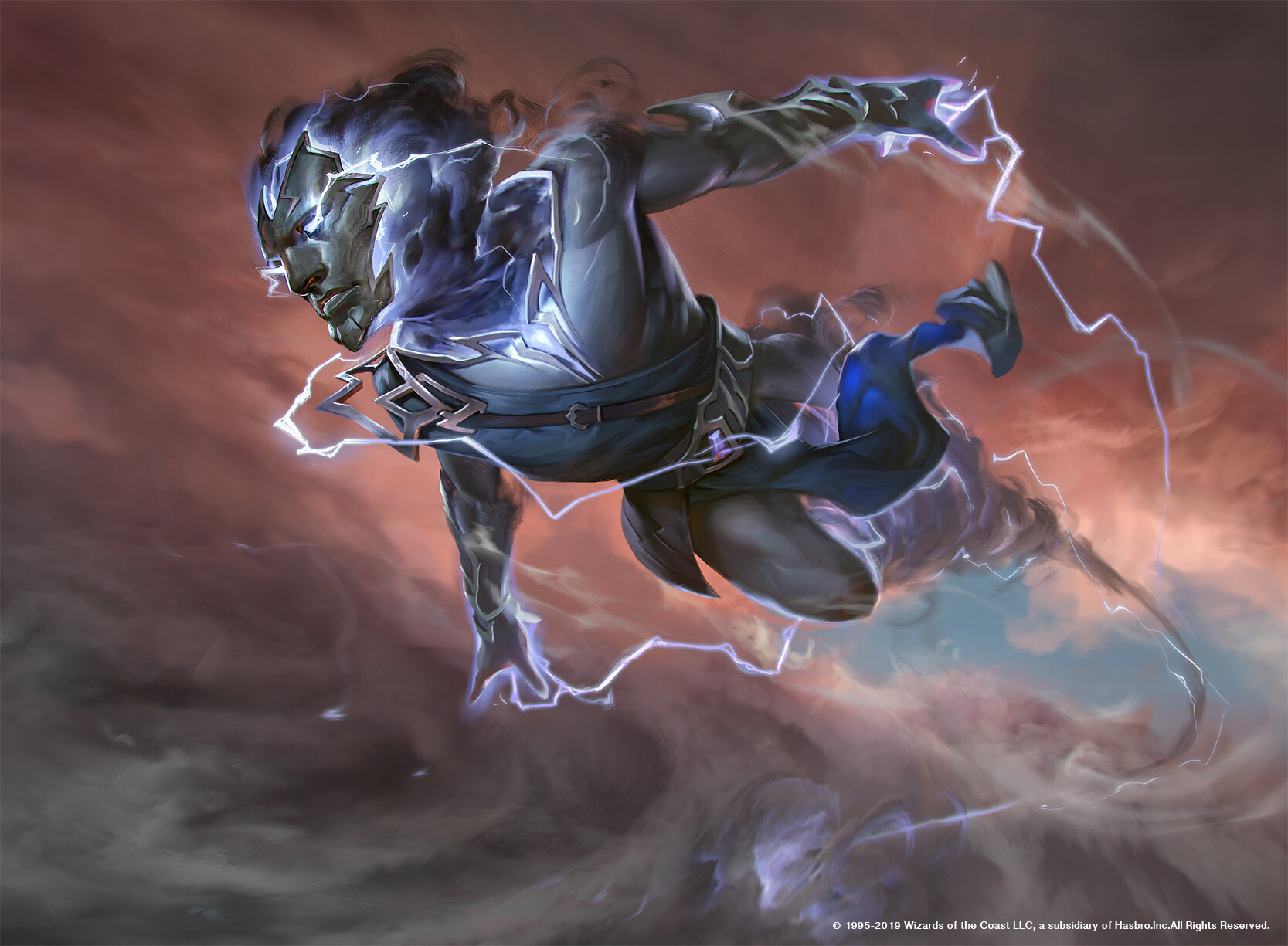
Clerical Elemental of Rain CREATURE 12
3d6+6 piercing
2d12 electricity

Clerical Elemental of Silt CREATURE 16
3d10+8 slashing plus 2d4 slashing
3d12 slashing

Clerical Elemental of Sun CREATURE 16
3d12 fire

Clerical Elemental of Water CREATURE 16
3d8+6 piercing
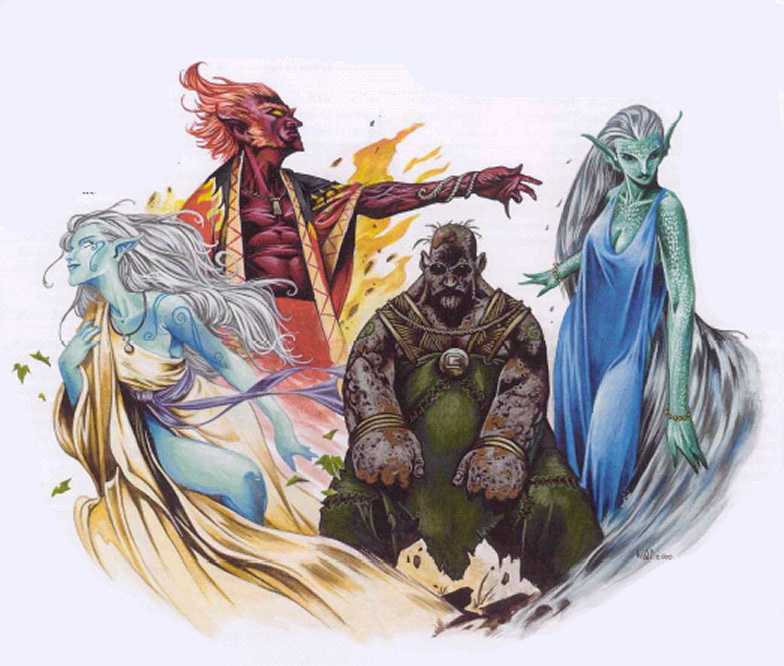
Athasian Elemental Genies
Genies are large muscular and colorful skinned creatures that resemble humanoids only in vague shape. Their appearances vary greatly between subraces, with each of them reflecting their particular form of primordial energy in their personality and physical appearance. However, they all adorn themselves in fine flowing silk clothing and their skin tones, hair, and eye coloring always lends towards their primordial elemental.
From times before mortal history, genies were some of the first creations of the cosmos to possess free will. Formed of elemental matter, they traversed the Universe and the four elemental planes of air, earth, fire, and water. Over time, the genies who remained on each elemental plane found their matter replaced with those elements.
Genie Shuyookhs
Older, wiser, and more powerful genies possess greater power and are revered with the title of shuyookh (typically adjusted to “sheikha” if the genie is female or “sheikh” for a male). Genie societies are tribalistic and usually led by one of these shuyookhs in a position of nobility. Generally, at least 5 levels higher than a typical example of their kind, a shuyookh gains additional spells.
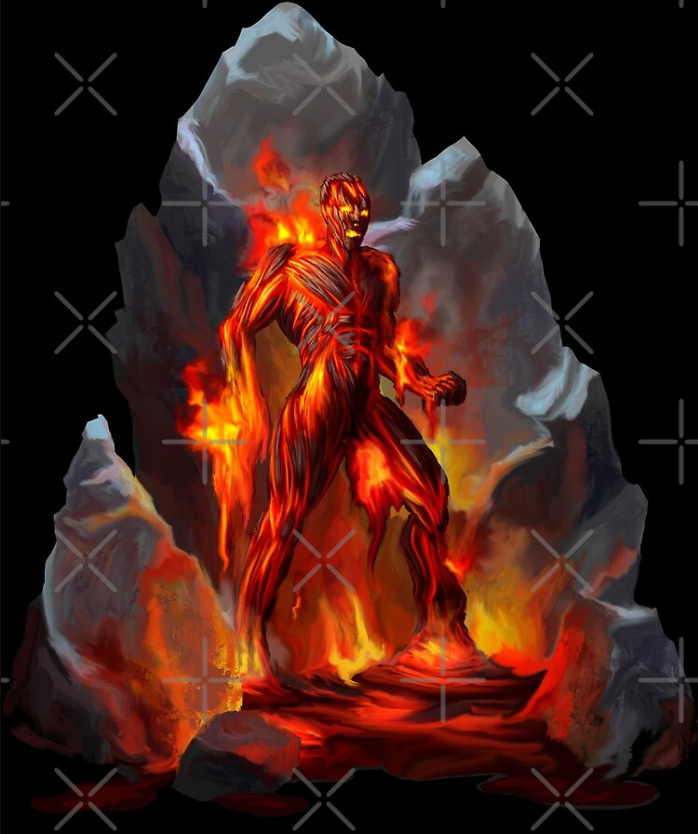
Athasian Alsahari
Alsahari are genies from the Para-elemental Plane of Magma, also known as the Fountains of Creation, which lies between the Elemental Earth and Fire. Their skin is usually black or grey with cracking and shifting bits of glowing magma beneath. They have hair made of flowing lava or jagged obsidian and they adorn themselves with obsidian or other expensive jewelry. When an alsahari swims, its lower body transforms into a column of dripping magma.
Alsahari CREATURE 7
1d12+7 bludgeoning plus 2d6 fire
1d4+7 bludgeoning plus 2d6 fire
Alsahari Shuyookh
The leaders and luminaries of alsahari come from the wise but cruel shuyookhs. These spiteful manipulators lord their might over other genies and twist mortal greed into grief. Alsahari shuyookhs guide the Dominion of Magma with their vicious whims and unwavering belief in magmas supremacy.
Alsahari ShuyookhCREATURE 12
1d12+10 slashing plus 4d6 fire
1d4+10 bludgeoning plus 4d6 fire
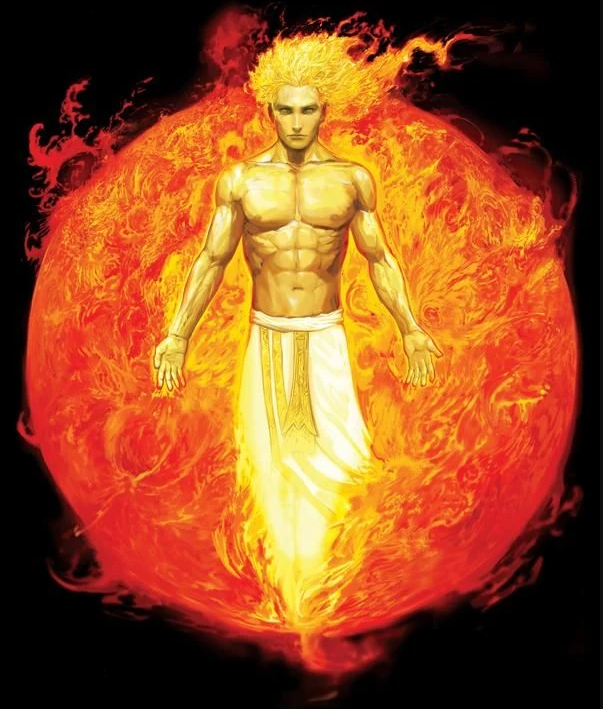
Athasian Dukhani
Dukhani are genies from the Para-elemental Plane of Sun, also known as the Great Conflagration, which lies between the Elemental Planes of Air and Fire. Their skin is pale almost white, and their hair takes the form of billowing sunlight. They tend to where little to no bright clothes, and sparkling diamonds. When a dukhani flies, its lower body transforms into columns of bright fire.
Dukhani CREATURE 9
2d8+11 slashing plus 2d6 fire and residual light
1d4+11 bludgeoning plus 2d6 fire and residual light
5d6 fire

Dukhani Shuyookh
The leaders and luminaries of dukhanis come from the wise but cruel shuyookhs. These spiteful manipulators lord their might over other genies and twist mortal greed into grief. Dukhani shuyookhs guide the Dominion of Sun with their vicious whims and unwavering belief in suns supremacy.
Dukhani ShuyookhCREATURE 14
2d8+15 slashing plus 4d6 fire and residual light
1d4+15 bludgeoning plus 4d6 fire and residual light
7d6 fire
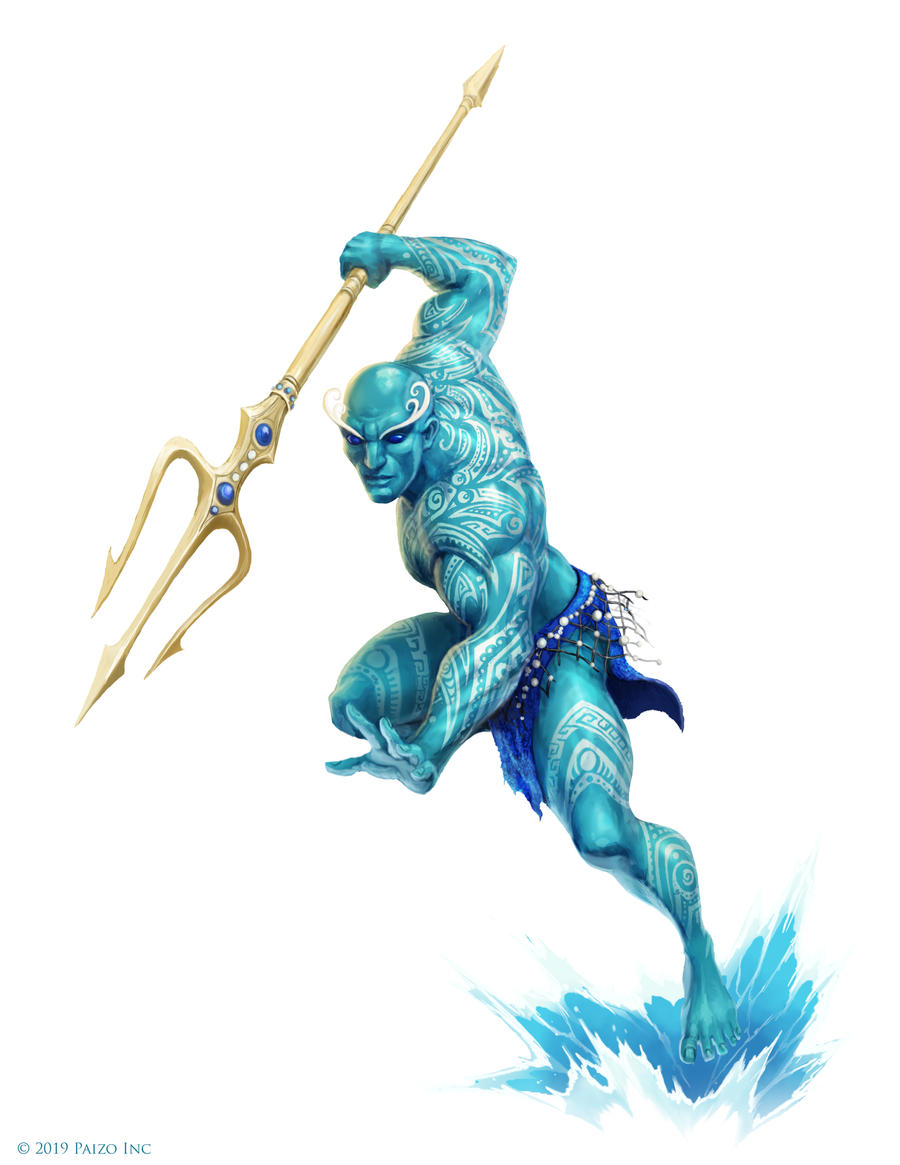
Athasian Faydhaan
The average faydhaan stood a towering sixteen to eighteen feet tall, looking down upon all other genies. Marids were beautiful genies whose skin matched all of the hues of the vast ocean. While usually blue, in fact, marids changed their skin color to reflect their current mood, with darkest shades of blue indicating anger. Most marids had blue-black or dark gray hair, though white-haired marids did exist. Generally speaking, the white-haired marids were the most turbulent of their kind.
While on the Elemental Plane of Water, or in seas or oceans, marids usually wore scant clothing or went bare. On land they preferred colorful flowing robes or large pantaloons. Others would wear clothing made from intricately woven seaweed inlaid with coral or pearls. Both males and females enjoyed showing off their impressive physiques, so flimsy vests were usually the most clothing they wore to cover their torsos. Regardless of the style of clothing worn, it was certain to never impede swimming.
Faydhaan CREATURE 9
2d8+10 piercing
1d4+10 bludgeoning
2d8+10 piercing

Faydhaan Shuyookh
Faydhaan shuyookhs are powerful faydhaans venerated as leaders, diplomats, and negotiators. As representatives of faydhaan-kind, they observe strict rules of etiquette and hospitality and hold the literary and performing arts in high esteem. A faydhaan shuyookh takes delight in greeting guests, and being greeted in return, to see how many different greetings they can demonstrate. Guests who creatively engage in this customary greeting game will impress a faydhaan shuyookh and receive magnificent hospitality.
Faydhaan ShuyookhCREATURE 14
3d8+13 bludgeoning
2d4+13 piercing

Athasian Ifrit
Hulking genies of the Elemental Plane of Fire, the ifrit are masters of flame, immune to fire and able to create it on a whim. Fine silk caftans and damask robes drape their magma-red or coal-black skin, and they bedeck themselves in brass and gold torcs, chains, and rings, all glittering with jewels. When an ifrit flies, its lower body transforms into a column of smoke and embers.
The ifrit are deceptive, cunning, and cruel to the point of ruthlessness. They despise being forced into servitude and are relentless in pursuit of vengeance against creatures that have wronged them. Ifrit don't see themselves in this light, naturally, and regard their race as fair and orderly, even as they admit to an enlightened sense of self-interest.
Ifrit CREATURE 9
1d4+11 bludgeoning plus 2d6 fire

Ifrit Shuyookh
The leaders and luminaries of ifrits come from the wise but cruel shuyookhs. These spiteful manipulators lord their might over other genies and twist mortal greed into grief. Ifrit shuyookhs guide the Dominion of Flame with their vicious whims and unwavering belief in ifrit supremacy.
Ifrit ShuyookhCREATURE 14
1d4+16 bludgeoning plus 4d6 fire
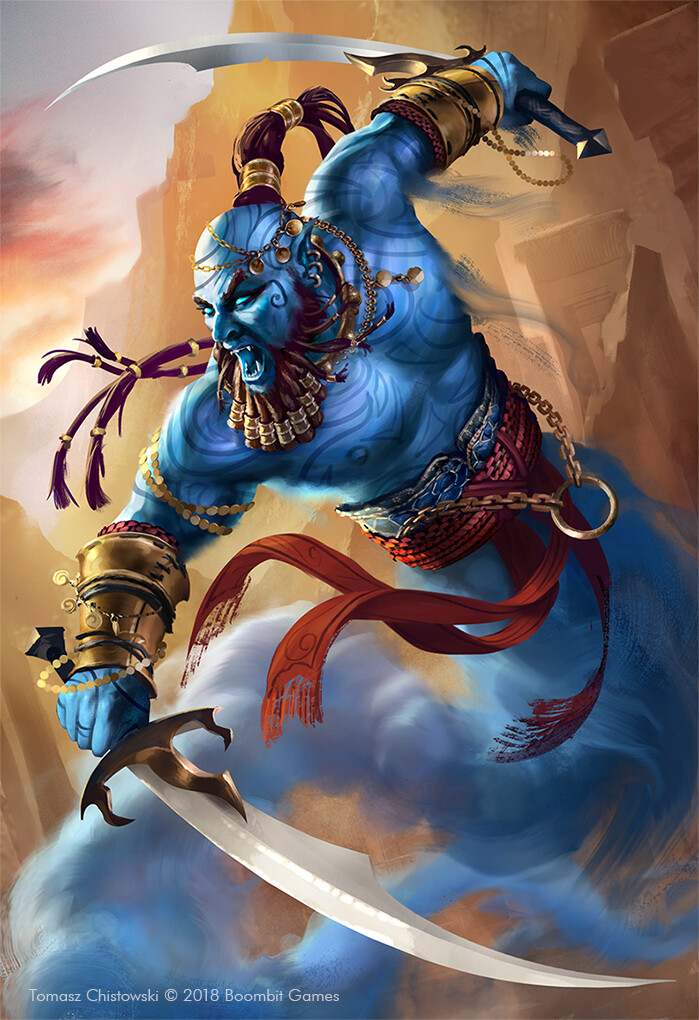 Credit: Tomasz Chistowski
Credit: Tomasz Chistowski
Athasian Jaathoom
Jaathoom resemble extremely tall (averaging ten and a half feet in height) human men and women, well-muscled and physically fit. Their features are aristocratic and considered attractive by human standards. Their skin tone ranges from pale blue to a more common olive-brown or dark tan characteristic of Zakharans. Their eyes are usually brown, but a rare few have blue eyes. Jaathoom garments are typically shimmering silk, designed for comfort and to flaunt their muscular physiques.
Jaathoom CREATURE 5
1d6+10 slashing

Jaathoom Shuyookh
Exalted jaathoom shuyookhs are ostentatious purveyors of dreams and nightmares. They can remain invisible like any jaathoom but prefer to make themselves visible to better communicate and express their individuality through bright fabrics, expensive jewels, and flashy displays of excess.
Jaathoom ShuyookhCREATURE 10

Athasian Jabali
Jabali are greedy, malicious genies from the Elemental Plane of Earth. They adorn themselves with jewelry crafted from precious gems and rare metals, and when they fly, their lower bodies become columns of swirling sand.
The jabali dwell in complexes of twisting tunnels and glittering ore-veined caverns on the Elemental Plane of Earth. These mazes are continually expanding as the jabali delve into and reshape the rock around them.
Jabali CREATURE 7
1d10+12 slashing
1d4+12 bludgeoning plus Push 10 feet and stone clutch

Jabali Shuyookh
A jabali genie of great power and high social rank is called a shuyookh. Strong in body and mind, jabali shuyookhs value physical skill, fine artistry, and displays of strength. Incredibly proud, they’re easily offended and quick to anger but lash out only after weighing the consequences. Shuyookhs view their desires as greater than those around them, leading them to provide aid as quickly and efficiently as possible, fulfilling the terms of bargains expediently and to the letter.
Jabali shuyookhs are industrious and have many interests, including athletic competitions, engineering, jewelry-making, masonry, metalworking, and sculpting. They enjoy games of chance and bargaining, whether in a gambling hall, arena, or marketplace. Some mix their interests by managing organizations or guilds involving such concerns. Many shuyookhs reap the wealth of the Plane of Earth for sale elsewhere and speculate on the value of such commodities.
Jabali ShuyookhCREATURE 12
2d10+14 slashing
2d6+13 bludgeoning plus Push 15 feet and stone clutch
2d8+13 bludgeoning
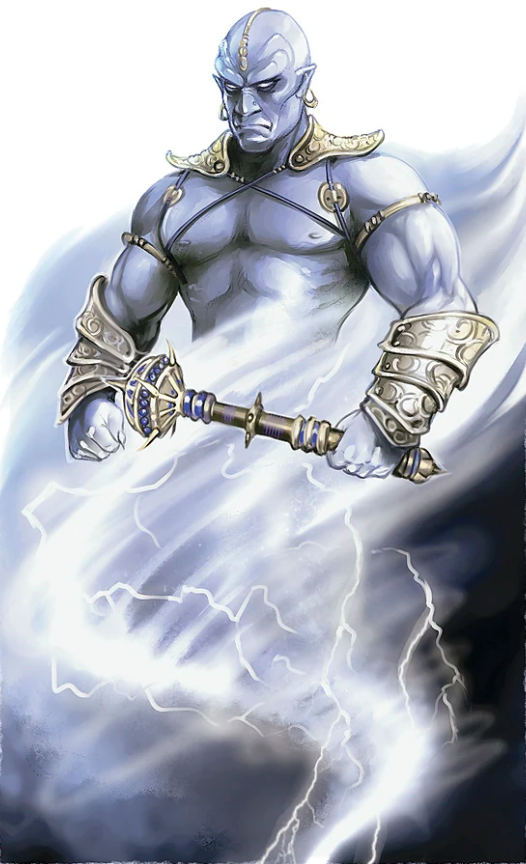
Athasian Quorrashi
Qorrashi are genies from the Para-elemental Plane of Rain, also known as the Great Deluge, which lies between the Elemental Planes of Air and Water. They have skin ranging from pale whites to dark blues. From their heads grow hair or horns made of crystalline ice. They dress in light clothing and bone jewelry to show their comfort with the rain. When a qorrashi flies, its lower body transforms into a column of lightning and rain.
Quorrashi CREATURE 5
2d6+6 piercing plus 1d6 electricity
1d4+6 bludgeoning plus 1d6 electricity
2d6+6 piercing plus 1d6 electricity
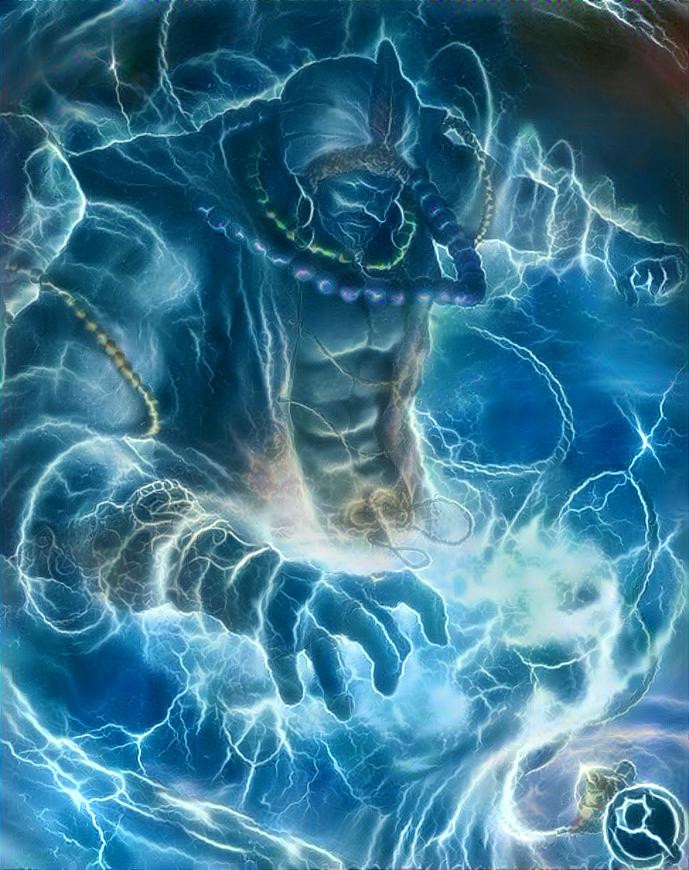
Quorrashi Shuyookh
Quorrashi shuyookhs are powerful quorrashi venerated as leaders, diplomats, and negotiators. As representatives of quorrashi-kind, they observe strict rules of etiquette and hospitality and hold the literary and performing arts in high esteem. A quorrashi shuyookh takes delight in greeting guests, and being greeted in return, to see how many different greetings they can demonstrate. Guests who creatively engage in this customary greeting game will impress a quorrashi shuyookh and receive magnificent hospitality.
Quorrashi ShuyookhCREATURE 10
2d6+10 piercing plus 2d6 electricity
2d4+10 bludgeoning plus 2d6 electricity
3d6 electricity and 3d6 sonic plus thunderstrike

Athasian Wahali
Wahali are genies from the Para-elemental Plane of Silt, also known as the Great Silt Sea, which lies between the Elemental Planes of Earth and Water. Their skin ranges from gray to muddy brown, to putrid yellow and looks as if it is constantly dusty. Their attire is usually made of scrap with decorative, rope netting. When a wahali flies, its lower body transforms into a column of blowing silt.
Wahali CREATURE 9
1d10+12 slashing
1d4+12 bludgeoning

Wahali Shuyookh
A Wahali genie of great power and high social rank is called a shuyookh. Strong in body and mind, wahali shuyookhs value physical skill, fine artistry, and displays of strength. Incredibly proud, they’re easily offended and quick to anger but lash out only after weighing the consequences. Shuyookhs view their desires as greater than those around them, leading them to provide aid as quickly and efficiently as possible, fulfilling the terms of bargains expediently and to the letter.
Wahali shuyookhs are industrious and have many interests, including athletic competitions, engineering, jewelry-making, masonry, metalworking, and sculpting. They enjoy games of chance and bargaining, whether in a gambling hall, arena, or marketplace. Some mix their interests by managing organizations or guilds involving such concerns. Many shuyookhs reap the wealth of the Plane of Silt for sale elsewhere and speculate on the value of such commodities.
Wahali ShuyookhCREATURE 14
2d10+14 slashing
2d6+13 bludgeoning

Elf, Athasian
On Athas, elves are a nomadic race of herders, raiders, peddlers, and thieves.
The dunes and steppes of Athas are home to thousands of tribes of nomadic elves. While each tribe is quite different culturally, the elves within them remain a race of long-limbed sprinters given to theft, raiding, and warfare.
An Athasian elf stands between 6 1/2 and 7 1/2 feet tall, with long swept back ears, straight and narrow facial features and no facial hair. They are slender, lean, and generally in terrific physical condition. Their features are deeply etched into their weather-toughened faces, and their skin made rugged by the windblown sands and baking sun of the wilderness. Elves typically dress to survive in the desert environment. Even when at an oasis or in the cities, elves tend to prefer their native garb, designed to wrap the wearer against the brutality of the elements.
Elves are all brethren within their own tribe but regard all outsiders as potential enemies. There is no racial unity among the elves—an elf from outside the tribe is just as much a foe as a human, halfling, or thri-kreen. Acceptance of an outsider by an individual elf can be achieved, but trust will only develop over time. Acceptance of an outsider by an entire tribe is also possible, but rare. It is usually only awarded after some great sacrifice has been made on behalf of the tribe —many outsiders have been accepted posthumously into elven desert tribes.
Individually, tribal elves are swift, sure, and self-reliant in the extreme. An elf is conditioned to run quickly over sandy and rocky terrain, sometimes for days at a time —an elf warrior can cross better than 50 miles per day. An elven war party on the move is a deadly force of endurance and maneuverability. Elves use no beasts of burden for personal transportation, though they do sometimes engage kanks and similar creatures for baggage or raw materials transport. It is dishonorable among elves to ride on an animal unless wounded and near death —even pregnant women and old elves are expected to keep up with the tribe or be left behind.
While most elven tribes make their living through herding, some have turned to commerce and others to raiding. Elven traders are rightly considered the most capable on Athas. Not only can they barter and deal with a variety of races, but they can also move and protect their goods across the vast wilderness.
Elven culture, while savage, is also rich and diverse.
Elves, for the most part, are regarded slightly better than most races on Athas, though that is not saying much. Elves typically are found in nomadic tribes or within city states. Most are as fast with their talking as with their feet. Tribal elves see it as disgraceful to ride animals and instead walk/run everywhere.
Stories of Elves describe swindlers in elven bazaars and wandering bands of raiders that strip caravans of goods. Entire Elf tribes have disappeared from city-states after a single member ran afoul of the Templars.
Elf WarriorCREATURE 1
1d8+3 slashing
Elf Defiler
The defiler is a wizard who activates tremendous magical energy without regard to its effect on the environment. With the casting of each spell, a defiler destroys a portion of the world's ecosystem, rendering it dead and sterile.
Elf DefilerCREATURE 2
1d4+2 piercing
1d4+2 bludgeoning
1d4+2 piercing
Elven Raid Leader
It takes a strong personality, ruthless cunning, and a silver tongue to keep a raid of elves in line. The raid leader has these qualities in spades. To keep the raiders in line, the raid leader must mete out rewards and punishment on a regular basis. More than treasure, a raid leader craves infamy.
Elven Raid LeaderCREATURE 5
2d8+6 slashing
2d8+4 piercing
Fael
Fael are undead creatures of perpetual hunger, capable of consuming any organic matter. They typically travel in disguise, concealing themselves as mortals and entering taverns, restaurants or private homes and demanding food. Once the food has run out, they insist on butchering pets, eat tablecloths and furniture, or commit other bizarre displays of gluttony. A fael uses magic to prevent creatures from interfering until they are literally eaten out of house and home, and creatures that resist are themselves eaten as well.
Faels eat while they fight, tearing away bloody chunks of flesh with their bites. They can project the hunger they feel onto others, causing excruciating hunger pangs in their enemies. A fael has a few magical tricks, which they typically use to force creatures to face them in melee instead of keeping their distance. A fael has little ranged capacity. If badly pressed, they can retreat into the Ethereal Plane to heal and recover and find a less resistant meal.
A fael is created when a creature dies in the throes of a bout of gluttony, and they commonly arise from the nobility and wealthy classes of society. They can be created from any type of humanoid, although halfling faels are surprisingly common. Although many faels are fat, some are instead preposterously thin, having the appearance of a victim of starvation—these may arise from those who had eating disorders in life, or whose sin of gluttony was more metaphorical.
FaelCREATURE 10
2d12+10 piercing plus Grab
2d10+10 bludgeoning
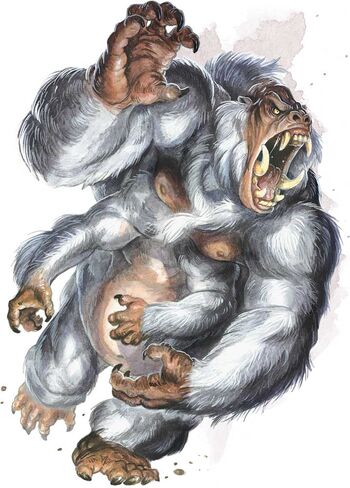 Credit: Brynn Metheney
Credit: Brynn Metheney
Feylaar
A lumbering, four-armed ape with a pronounced bony plate over its forehead, this creature stands a foot taller than a full elf and ripples with muscles beneath its furry hide. Long quills run the length of its spine, with an extra pair flaring backwards from the creature’s cheekbones and you see broad yellow fangs in the beast’s wide mouth. Its fur is brown, with amber highlights, the flesh of its face and bare chest is a dull grey and the quills are a glossy black.
Feylaars are a race of psionic apes inhabiting the deep forests of Athas. Intelligent and omnivorous, they live simple lives in harmony with the surrounding woodlands and have little to do with the outside world. In the past attempts have been made to domesticate them as slaves, but their native intelligence, combined with impressive psionic powers, doomed such efforts to failure.
Feylaars speak their own language and that of the forest halflings. The average adult feylaar is eight feet tall and weighs 500 pounds. Feylaars dwell in small family groups deep within the remaining Athasian rainforests.
They mate for life, and the females will bear new young every two to three years, following a nine-month gestation period. The young are reared by their parents until they reach maturity eight years later. Feylaars live as long as 45 years.
They have a loose culture, chiefly composed of oral legends and traditions, passed down from generation to generation and from clan to clan at their seasonal meetings in the deep glades.
Their numbers suggest that the feylaars have been around for quite some time. Rumors from east of the Ringing Mountains hold that the first feylaars were created by a sorcerer-king to fight in his armies. The feylaars proved too proud and too hard to contain, however, and they were banished to beyond the mountains.
The feylaars themselves claim that they have always dwelled in the forests of the Ringing Mountains and state that they raised themselves from their bestial pasts of their own volition, through their burgeoning psionic abilities. They gave themselves four arms through psychometabolic manipulation and enhanced their brains to improve their telepathic powers. Feylaar legends do not, however, speak of the techniques used by the feylaar progenitors to affect these improvements, and this tale, like most concerning the species‘ origins, must be regarded with skepticism at best.
Feylaar CREATURE 8
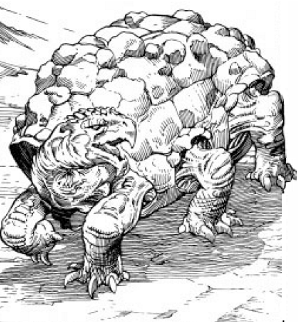
Flailer
Flailers are solitary creatures that live in the rocky terrain near the tablelands of Athas. To frequent travelers of these areas, flailers serve as a constant reminder of the harsh dangers of life on Athas.
Flailers are similar is shape to giant tortoises, but sport six legs instead of four. These limbs are often concealed beneath their large, hardened torsos. The shell of a flailer is similar in color and texture to that of most rocky terrains, allowing them to appear as stones or rocks until they strike. Typical flailers grow up to four feet in length.
Flailer CREATURE 4

Credit: mysticaldonkey1
Floater
Floaters are small, aerial, jelly fish that drift above the Sea of Silt. They are often found at the edges of the silt sea, near the mudflats that form its perimeter. Floaters resemble jelly fish in all ways save that they exist out of water. Their bodies are bulbous and translucent and have a diameter of about 2 feet. They also sport many poisoned tentacles, up to 3 feet in length.
Floaters survive largely on the ferns and roots that grow in the wetter areas of the mudflats and are a favorite food of razorwings.
FloaterCREATURE 1
1d6+2 bludgeoning plus floater venom
 Credit: Tom Fowler
Credit: Tom Fowler
Fordorran
The fordorran is a foul, disgusting creature that inhabits the Tablelands surrounding the Silt Sea. It is extremely unpredictable, wanders aimlessly, and may attack for no reason. It is believed to be a distant cousin of the so-ut. It resembles an enormous armadillo with a formation of three horns on its head. Its armored plates are divided into sections that allow the beast to curl into a ball for protection. The fordorran can blend in with its surroundings by changing its coloration. This would make the beast nearly undetectable if it weren’t for the foul stench, it constantly emits. The armored plates are hairless, but there is a light coat of fur on the underside of its body, on its legs, and between its armored plates. A fordorran is 4 feet tall, 8 feet long, and weighs 1,800 pounds.
Fordorrans are known to inhabit the Tablelands, making their lairs in caves and crevasses. They have never been known to congregate in groups. Perhaps even they can’t stand the stench of their own kind. Therefore, it remains unknown how the creatures reproduce. They are just as likely to ignore other creatures as they are to attack them or even befriend them temporarily. They will eat gems or colored glass, even though they can’t digest either material.
Fordorran flesh is edible but tastes as bad as it smells. It is rumored that certain elf tribes know how to prepare fordorran meat to make it palatable. The gland that is responsible for the creature’s horrible aroma is highly sought by preservers and defilers to create potions.
FordorranCREATURE 4
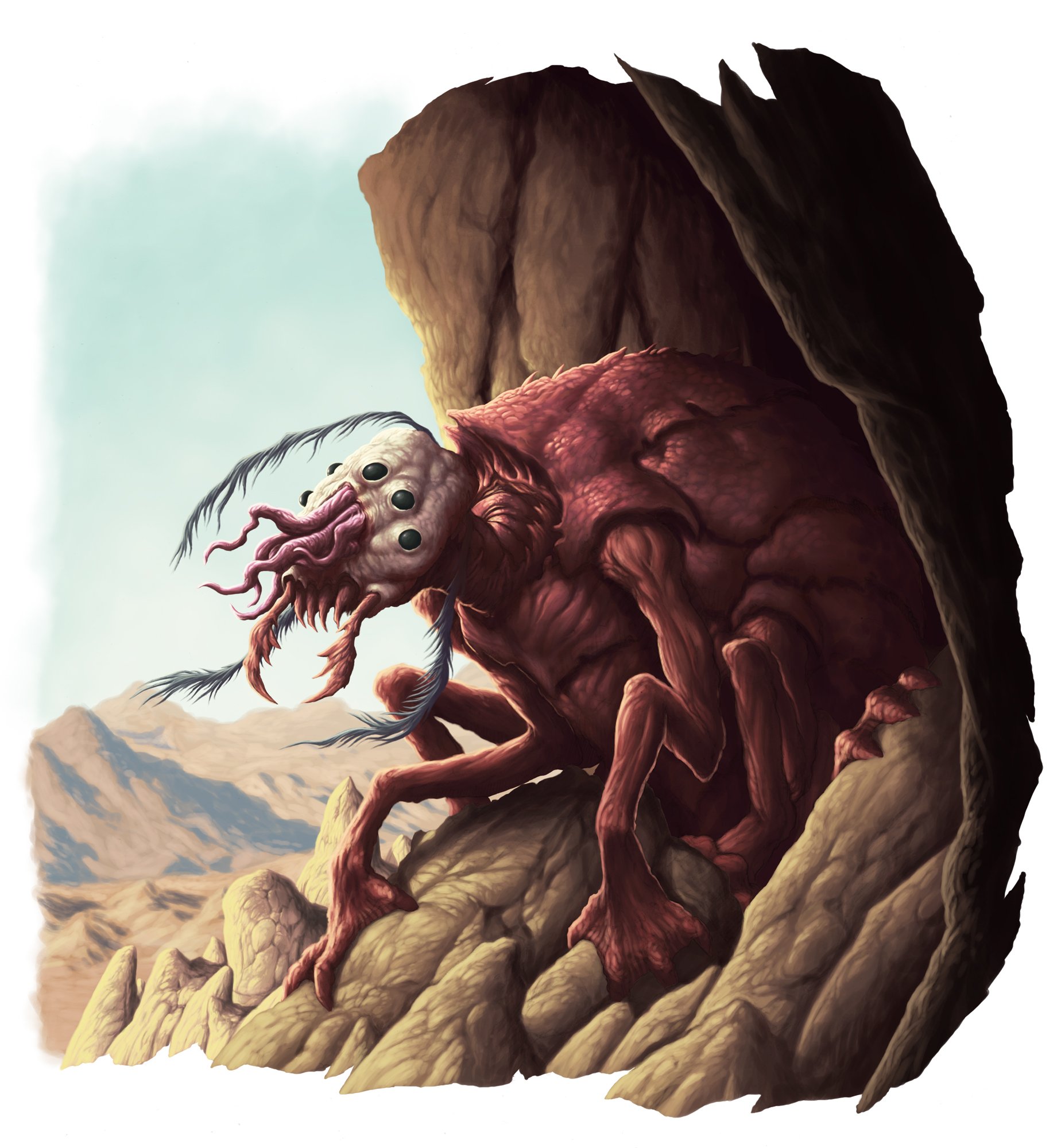
Credit: Dave Allsop
Gaj
The gaj is a psionic horror. Physically, it appears as a large reptile resembling a beetle in appearance. Its body is covered by a scaly, rust-orange shell about six feet in diameter. From beneath this shell protrude six four-jointed legs which end in webbed feet with long, sharp claws.
Its head is a spongy white globe about two feet in diameter. Spaced at even intervals around the head are six compound eyes. A pair of barbed mandibles flank six fingerlike appendages that hang over its mouth, and three feathery stalks rise from the top of the head. A gaj is 10 feet long and weighs around 500 pounds.
The gaj are solitary hunters that prey on other intelligent life forms. They prefer to live in rocky areas where their shells serve as camouflage, or in sandy areas where they can hide themselves from predators in a shallow burrow. Most often, they are found alone, but occasionally mated pairs are encountered.
Like all carnivores, the gaj eat flesh to provide their bodies with physical energy. Unlike most other animals, however, the gaj derive their mental energy from the thoughts of other beings—through the effects of their probe powers. No matter where they live, the gaj are constantly using their feathery antennas to search the horizon with their psionic life detection powers for signs of their favorite prey—other intelligent races.
GajCREATURE 8
A victim's stupefied condition value decreases by 1 every week.
A victim that becomes stupefied 5 in this way is rendered comatose, becoming permanently unconscious.
Giant, Athasian
The giants of Athas are huge, lumbering creatures who commonly inhabit the islands of the Sea of Silt. They are divided into the human and psionic capable beast heads. All the giants of Athas share one characteristic, and that is savagery. Though humanoid giants can be congenial and friendly when properly approached, they have short tempers and are very easily agitated.
Many giants on Athas live on islands in the shallower areas of the Sea of Silt where they wade the silt on known safe paths to trade, or when bribed into carrying smaller beings as passengers. Giants are fickle, though, so travelers must take care not to offend them. All giants tend to group in small clans of 5-10 members.

Credit: John Stanko
Beasthead Giant
Beasthead giants are a rarer form of Athasian giant who also make their homes on the islands of the Sea of Silt. Though somewhat smaller than humanoid giants, beasthead giants are more dangerous and consider themselves the one true form of giant.
Beasthead giants are smaller and lighter skinned than their humanoid cousins, averaging 15 to 20 feet tall and weighing from three to six tons. Beasthead giants, as their name implies, have a human-looking body and the head of a beast. There are many distinct types divided into clans: some bearing the head of a bear, or a kes'trekel, or the head of a dagorran.
Beasthead Giant CREATURE 12
3d8+13 piercing
4d8+13 piercing
3d6+13 bludgeoning
2d6+13 bludgeoning

DESERT GIANTS
Desert giants are cruel and selfish creatures. Their skin is most often dark red, but some specimens have jet-black skin. The hair of desert giants is usually a light brown color and is very coarse and sturdy. These giants often sell their hair to rope makers and are treacherous partners, looking for opportunity such as tossing a passenger into the deep silt after collecting payment. Desert giants live on desert terrain on the islands in the Sea of Silt, herding erdlus and kanks while preferring on occasion the taste of a humanoid.
PLAINS GIANTS
Plains giants have slender faces and pointed ears, with light hair. They live on vegetated islands and are a much more common sight on the mainland of Athas, as their balanced disposition makes them more compatible with members of the other Athasian races. Though it is considered dishonorable, a few plains giants hire themselves out as mercenaries. Some find work as builders or as wrecking crews.
Desert/plains Giant CREATURE 12
3d10+15 bludgeoning
3d6+15 bludgeoning
2d10+15 bludgeoning
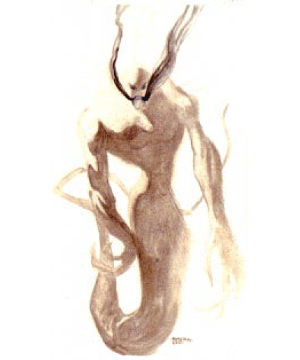
Shadow Giant
Shadow giants, or shadow people as they prefer to call themselves, are the descendants of the halflings who served Rajaat the Warbringer during the Cleansing Wars. They appear either as 10 foot tall, shadowy, two-dimensional, vaguely humanoid-shaped silhouettes with ropy limbs, serpentine torsos, and blue embers in place of eyes, or as solid, three-dimensional shadows as tall as half-giants. Bright light adds size and depth to a shadow giant. The brighter the light source, the larger the shadow giant appears. In full sunlight a shadow giant can grow to 25 feet.
When a shadow giant speaks, black fumes rise from a blue gash that opens where its mouth would normally be. When a shadow giant grips a target, blackness spreads slowly from the contact point to engulf the target. The growing black stain of a shadow giant’s touch is accompanied by a cold, numbing pain that draws heat from the body.
Shadow giants reside both in the Pristine Tower and in the nether dimension known as the Black. Shadow giants are the descendants of the loyal servants of Rajaat who the Champions sacrificed to complete the betrayal of their master. These halflings merged with the Black and can only interact with the real world in the form of shadows.
The shadow people can emerge only partially from the Black until Rajaat’ s prison is destroyed. No one knows how much time the shadow people spend in the Black or on Athas. It is not known what they eat, but the shadow people desire obsidian as eggs to incubate their young and have contracts with nobles, including one from Urik to provide 100 unblemished balls of obsidian each year.
Shadow GiantCREATURE 6
2d6+8 void plus pall of shadow

Greater Shadow Giants
Greater shadow giants are more powerful relatives of the standard shadow giant. Fully mature versions of the species, they are seldom seen away from the Pristine Tower.
There, they watch over the incubation of their young in obsidian eggs and guard against intruders who might seek to defile the mysteries of that sacred place. Greater shadow giants normally stand around 20 feet in height, but bright light lends them size and depth, and in full sunlight a shadow giant can grow to be as tall as 30 feet.
Greater Shadow GiantCREATURE 13
3d8+14 void plus pall of shadow
• Void (arcane, void) The shadow giant breathes a blast of darkness in a 40-foot cone that deals 14d6 void damage (DC 33 basic Reflex save). Undead creatures take 17d6 force damage instead of the void damage.
• Shadows (arcane, shadow) The shadow giant breathes a blast of shadows in a 40-foot cone. Each creature within the cone must attempt a DC 33 Fortitude save.
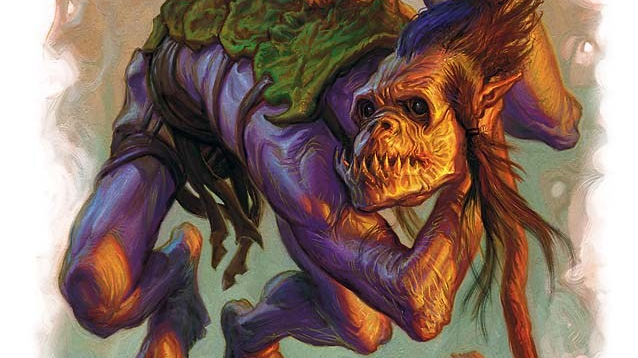
Gith
The gith are a race of grotesque humanoids that appear to be a peculiar mixture of elf and reptile. They are extremely gaunt and lanky, with long gangling arms and spindly legs. Their hands have three fingers with no opposable thumbs, yet they can use tools and wield weapons. Their fingers and toes end in sharp claws. If one could get a gith to stand up straight, he would measure close to 7 feet tall. However, most gith appear to be no more than 5 feet tall, for they always stand hunched over at the shoulders, in a permanent slouch.
The gith live in tribal organizations. The individual with the most powerful psionics generally acts as the leader. All other social positions are distributed at his pleasure. They count in their ranks shamans (clerics) and defilers.
Mountain gith live in underground lairs, claiming a particular canyon or valley as their territory. Gith inhabiting tablelands tend to organize their society more like a nomadic hunting clan, going wherever the game takes them. They do not hesitate to attack humanoids, preferring sentient flesh over other meat. They will even attack thri-kreen, if they are hungry enough, but the insectoids taste bad, and usually can outrun gith raiders.
The gith are usually armed with large, wicked-looking spears that have giant, razor-sharp heads of polished obsidian. Although these spears look like thrusting weapons, they are used primarily to slash or chop. The gith often armor themselves, and especially their vulnerable backs, with inix-shell armor of their own manufacture.
GithCREATURE -1
Gith DefilerCREATURE 2
Gith Tribe LeaderCREATURE 4
 Credit: Dave Allsop
Credit: Dave Allsop
Golem (Athasian)
Golems are automatons of great strength created through the combination of powerful magics and specific materials. Athasian golems are different in nature and type than those found on other worlds, reflecting the unique culture and mythos of this desert world. There are eight distinct types of Athasian golems: ash, chitin, magma, obsidian, rock, salt, sand, and wood.
Background
The true origin of golems on the world of Athas has been long-since lost in the annals of history. Regardless of their origin, the process by which one creates such a being is still undertaken by sorcerer kings, powerful templars, and high-level wizards who jealously guard the secrets of the process, just as the dragon protects its hoard.
Theory
The creation of a golem requires not only powerful magics, but specific elements, as well. The need for whatever specified elemental material stems from a link to the quasielemental and paraelemental planes of existence. The elemental form of the golem on Athas acts as a conduit for the awesome energy possessed by the spirits on those planes. Each spirit, attuned to a specific element, imbues life within the concoction of material and arcane magic. Only through exacting craftsmanship can the creator establish this link between spirit and golem, forging a union that stays with the creation until it is broken by equally tremendous forces.
Even most sages do not fully grasp the process of trapping an elemental spirit within the body of a golem, though many have tried.
Perhaps more terrifying is that the sorcerer kings and templars who create golems at whim, and with considerable effort, do not completely understand the risks they are taking. An elemental spirit, bound to Athas via the corporeal link of the golem, is not necessarily appreciative of its captivity. In fact, such spirits not only despise the one who forges the golem, but all life found upon the material plane of existence.
The actual creation of the golem’s physical body is extremely complicated. The ability is far from common, and the creation of golems often requires multiple makers, some for the body and others for the process of enchantment.
Common Characteristics
All golems possess several traits that distinguish them from other types of golems, but all share multiple characteristics that define them as golems. Because of their magical nature, golems can be damaged only by magical weapons.
Golems have a variety of immunities, including being Charmed, Frightened, or Poisoned. Similarly, they cannot be affected by the psionic powers of most disciplines as they are immune to psychic damage. Golems exhibit no psionic tendencies themselves.
Golem Creation:
Those creating Athasian golems need to be knowledgeable in the arcane magics which allow the link between elemental spirit and golem body to be formed. These secret magics are known only to the sorcerer-kings and their most trusted templars.
 Credit: Boris Dyatlov
Credit: Boris Dyatlov
Ash Golem
Ash golems are grey in color, stand eight feet tall, and weigh only 150 pounds. As they move, ash golems leave a fine dusting of ash behind them, which makes tracking these creatures easy.
Ash GolemCREATURE 11
2d6+13 bludgeoning plus 2d6 fire

Chitin Golem
Chitin golems are humanoid in shape, but up to 10 feet tall. They generally weigh from 200-250 pounds. They have no facial features to speak of, though they can make growling sounds when provoked. The limbs of a chitin golem are somewhat long, hanging easily below its knees. A chitin golem bears a slight odor of decay or death, noticeable only at close range. When a chitin golem walks, it appears to be very unstable.
Chitin GolemCREATURE 9
2d10+7 slashing plus chitin golem venom
 Credit: Seraph777
Credit: Seraph777
Magma Golem
Magma golems are forged by powerful wizards from the raw materials found in the Ring of fire. They are comprised entirely of molten rock, weigh around 1600 pounds, and stand about 8 feet tall. They are roughly man-shaped but seem to ooze and flow as they move. The surface of the magma golem is black and covered with a latticework of cracks through which glows the inner radiance of the lava. Its eyes glow with the intensity of the Athasian sun.
Magma golems are incapable of any speech or communication other than with the wizards that created them. The only sound made by the creatures is the noise of their heavy footsteps.
Magma GolemCREATURE 13

Obsidian Golem
Obsidian golems are massive statues, measuring 12 feet tall, and weighing up to 900 pounds. Their shape is humanoid. Like the rock golem, obsidian golems are not capable of speech. Obsidian golems are slow moving but move in a strong determined manner. The hands of an obsidian golem are formed into huge fists, but they are incapable of opening.
Obsidian GolemCREATURE 16
4d10+15 piercing
4d8+15 piercing
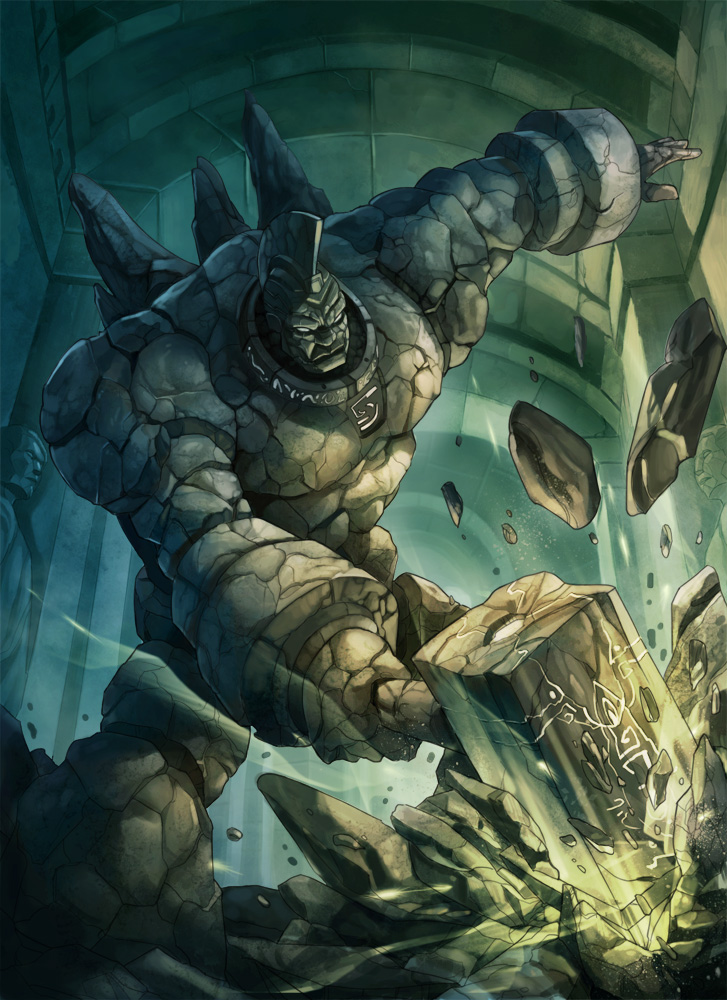 Credit: kikicianjur
Credit: kikicianjur
Rock Golem
Rock golems are nine feet tall and usually resemble huge men in full armor. Weighing up to 600 pounds, rock golems are slow and are incapable of movement faster than walking. They have features carved into their faces, but those features are immobile, and useless. The golem cannot speak.
Rock GolemCREATURE 11
2d10+13 bludgeoning
2d6+13 bludgeoning plus Binding Stone
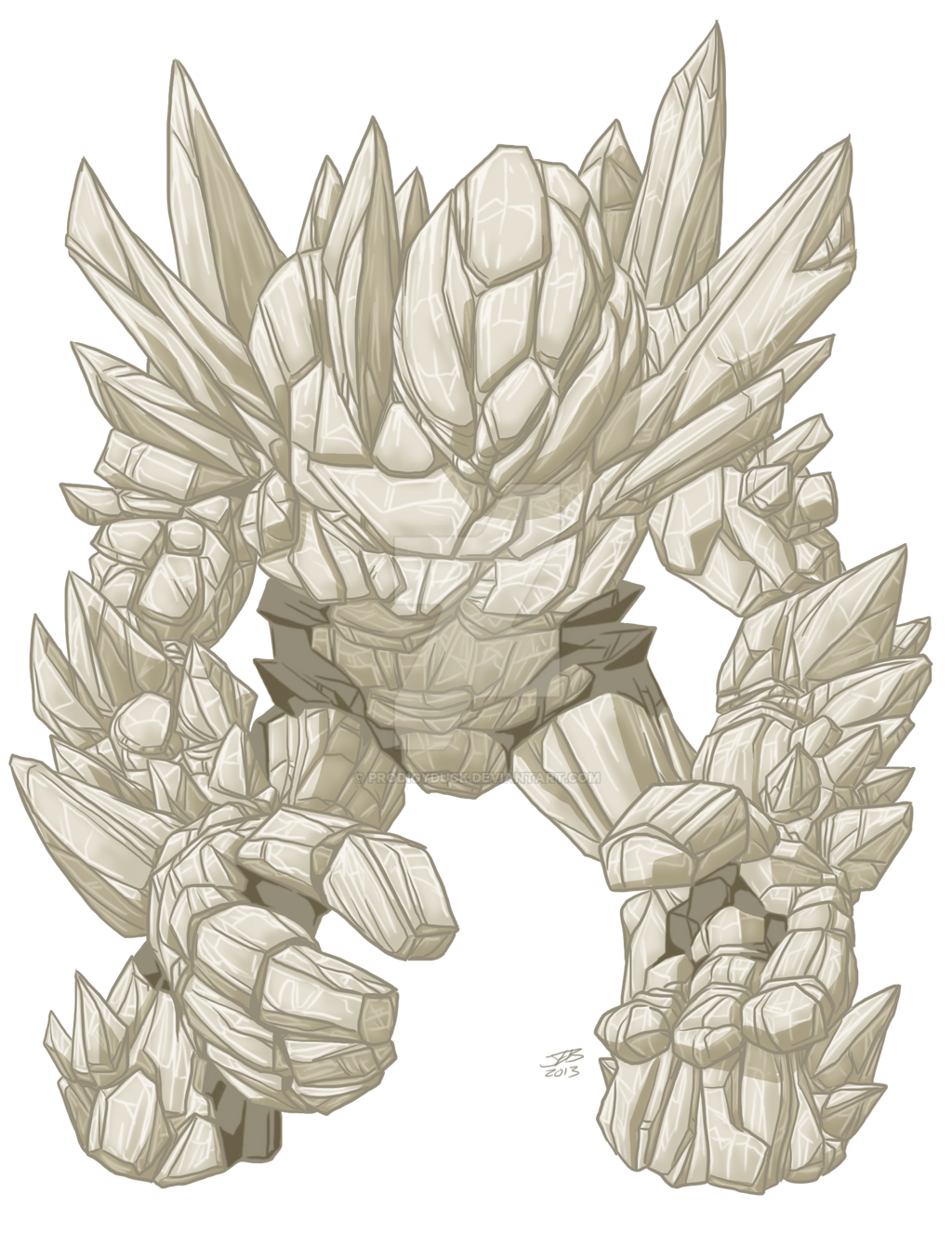 Credit: ProdigyDuck
Credit: ProdigyDuck
Salt Golem
The salt golem is created by powerful defilers and sorcerer kings and is favored by those near the salt flats. The golem is 8 feet tall and weighs roughly 600 pounds. It resembles small rock golems and has an opaque color and texture. A most horrifying feature of this golem is its movement. It moves slowly and deliberately, seemingly unaware or uncaring that most other creatures can move faster. This creature has an incredibly low intelligence, but its slow-paced belles a confidence that it knows its quarry will eventually tire while it is inexhaustible. It possesses almost-recognizable facial features. The salt golem's eyes are white and opaque. It has a mouth, but the salt golem cannot speak and is silent unless in motion.
Salt GolemCREATURE 11
2d10+12 slashing plus mineralization

Sand Golem
Sand golems are humanoid in shape and stand roughly eight feet tall. They have indentations where their eye sockets should be, though they have no actual eyes. Likewise, they have a mouth, but they are incapable of speech, managing only to roar and growl at opponents. When a sand golem moves, it leaves a fine trail of sand behind it, making the tracking of this creature easy.
Sand GolemCREATURE 10
2d10+12 bludgeoning
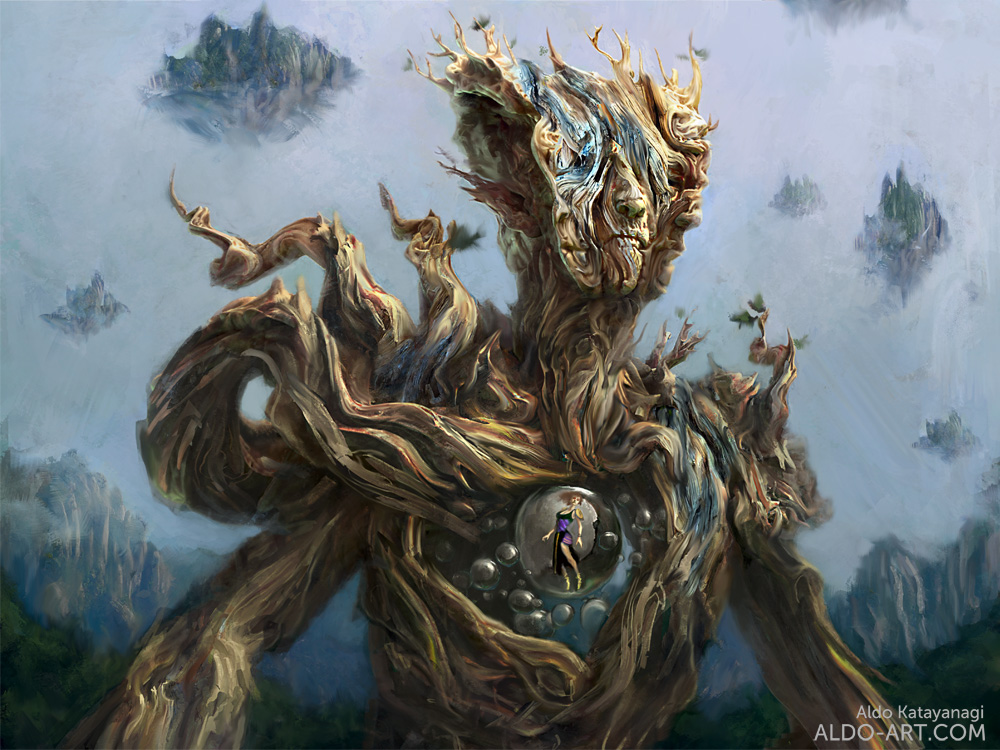
Credit: AldoK
Wood Golem
Wood golems are 10 feet tall and weigh up to 500 pounds. It is often difficult to spot a wood golem when in the forest, as its appearance closely matches natural foliage.
Wood GolemCREATURE 6
2d4+8 piercing

Half-elf, Athasian
Half-elves are born from two worlds, but welcome in neither.
Elves and humans travel many of the same roads on Athas —elven tribes have at times encountered human mercenaries; just as elven warriors have found gainful employment in the armies of the city states. The merchant class, too, is overrun with traders of both races, so it is not at all unusual for children of mixed parentage to be born into the world—the half-elves.
A half-elf is generally tall, between 6 and 6 1/2 feet tall, but meatier than his elven counterparts.
His facial features are clearly more deeply defined than those of a human but based solely on his countenance a half-elf can usually pass for either an elf or a human.
A half-elf's life is typically hardened by the intolerance of others. Neither fully human nor fully elven, half-elves rarely find acceptance with either race.
They struggle to find their place in a hostile land. Humans and Elves rarely share trust or affection. However, the children of unions between Elves and Humans are rarely happy. Half-elves typically face intolerance and prejudices throughout their lives. Elves are especially intolerant, at times driving mothers of half-elven infants from their camps into the desert, with the object of their shame. Humans are more apt to accept half-elves as allies or partners, but seldom accept them into their homes, clans, or families. Rarely do half-elves congregate in great enough numbers to form communities of their own, so they remain outsiders, forever wandering from situation to situation without a people, land, or village to call home.
Intolerance, however, has given the half-elf his greatest attribute—self-reliance. As a loner, usually without permanent residence, a half-elf survives the rigors of life in the wilderness completely on his own. The skills involved in survival, such as locating food, water, and shelter, are only half of the challenge they face—half-elves must also learn to deal with the absence of companionship, the complete lack of conversation and basic friendship.
Because of that, half-elves are loners. They must contend with hostility from both sides, Half-elves are a people without a homeland, forced to endure on society's fringes. Some half-elves live as loners in the desert, surviving as herders, hunters, or employees of more tolerant merchant houses. Other half-elves adjust by developing confident, assertive personalities, transforming themselves into people who win friends and engender trust. Ironically, they are treated better by unrelated races than by their own kin.
As one might assume of a race of loners, Half-elves hold self-reliance as their highest virtue, never expecting or asking for help no matter what their situation. Self-taught and naturally adept at learning half-elves dabble in a variety of areas, mastering the skills they need to survive on their own. Some half-elves are bitter and sullen, but most seek to make the best of their circumstances. More than anything, Half-elves take pride in defeating expectations.
Coincidentally, faced with intolerance from the races of their parentage, many turn to completely alien races for acceptance. Dwarves, halflings, and ever Thri-kreen, have no basic dislike of half-elves -nor do they grant them any favor. At the very least a half-elf dealing with these races can expect no automatic prejudices. Also, some half-elves turn for companionship to the animal world, training beasts of the air and sands as servants and friends.
Druid
Athasian druids are the protectors of Athas’ dying landscape. Patient and often unforgiving, they try to preserve and reclaim the barren lands that surround the Tyr region. Well-armed with spells and abilities from the Spirits of the Land, they work to bolster Athas’ failing ecology.
Often, druids prefer to remain hidden, observing the behavior of creatures and people before passing judgment. Travelers to an oasis are often unaware they are being observed; wanton destruction of the oasis will find themselves under the full fury of the druid and his many abilities.
Half-Elf DruidCREATURE 2
1d4+3 bludgeoning
Hunter
The wastes of Athas are home to fierce and cunning creatures, from the bloodthirsty tembo to the malicious gaj. Because of that, Athasians have long learned how to adapt and survive even in the most inhospitable and savage environments.
One of the most cunning and powerful creatures of the wastes is the hunter, a skilled stalker. He knows his lands as if they were his home (as indeed they are); he knows his prey in deadly detail.
Half-Elf HunterCREATURE 4
1d8+6 piercing

Half-Giant
Half-giants are a race that has been used as slaves for as long as they have been known. Bred to be gladiators and soldiers.
It is important to note, however, that half-giants are a race born of a magical union in the distant past; half-giants can only reproduce with one another.
A half-giant is an enormous individual, standing over 8 feet tall, and weighing about 350 pounds. Their features are human but exaggerated.
Half-giants are a race of enormous demihumans who have adapted to a variety of lifestyles in the many harsh terrains of Athas. The origins of the race are unclear. While it is known that the race is spawned from the union of human and giant and the nature of that union was certainly magical, its original purpose is unknown.
Simply put, a half-giant gains terrific size from his giant heritage, but also inherits that race's dull wits. His human background, however, provides him with an interest in communication and cooperation, not to mention more reserved traits such as curiosity, a willingness to learn, and a general tendency toward kindness. At any rate, half-giants are capable of far more kindness than their often tyrannical, bloodthirsty giant kin.
On the contrary, having insufficient history and overall intelligence to have their own culture, half-giants tend to readily adopt the cultures of other creatures they admire or associate with. Half-giants are very imitative creatures, eager to fit into new situations as they present themselves.
Half-giants sometimes collect into communities of their own, though they most often adopt the culture and customs of those creatures that are nearby. When near an elven tribe, for instance, half-giants will form their own hunting and raiding parties, adopting the ways of the elven marauders. They won't mix with the elves, neither will they fight with them. In most instances, imitative half-giant communities will compete directly with the race whom they are likening themselves to. It is their enormous size and combat prowess that keeps their competitors at a safe distance.
Half-giants can switch their attitudes very quickly, taking on new values to fit new situations. A half-giant whose peaceful farming life is disrupted by marauders may soon adopt the morals of the very renegades who sacked his village.
Captain
Captains are particularly influential guards, being effectively one step higher in their chain of command. One may have authority over anywhere from two to twenty lower-ranking guards. When keeping watch over a large area with a sizeable unit, the captain tends towards a central position from which commands can be issued most effectively.
Half-Giant CaptainCREATURE 6
1d8+8 piercing
Guard
Guards include Members of a City Watch, sentries in a City-State or fortified town, and the bodyguards of merchants and nobles.
Half-Giant GuardCREATURE 4
1d8+5 piercing
 Credit: Ji Zhang
Credit: Ji Zhang
Halfling
On Athas, Halflings aren't amiable river folk; they're xenophobic headhunters and cannibals who hunt and kill trespassers in their mountain forests. Beyond the Ringing Mountains are jungles that flourish in rains that never reach the Tablelands or the Sea of Silt. There life is abundant, the foliage thick and untamed. The undisputed rulers of these jungles are the halflings.
A wiry halfling is a short humanoid, standing no more than 3 1/2 feet in height. They are muscled and proportioned like humans, but they have the faces of wise and beautiful children. Halflings live to be as much as 120 years old, but once they reach adulthood, their features never succumb to their years— it's very difficult for an outsider to determine a given halfling's age. A halfling weighs 50 to 60 pounds and is virtually always in peak physical condition.
Halflings possess a great deal of racial unity. Though divided politically into separate villages and communities, halflings have profound respect for their race. Political differences between them are settled wherever possible peaceably, through ritual and custom, most often under the direction of their clerical leaders, the Shaman Witch Doctors. On a personal level, halflings relate very well to one another, well enough to have built a considerable culture rich in art, song, and other expressive communication. However, they tend to rely heavily on their culture for communication, a culture that both parties in a conversation are assumed to understand.
It is difficult for a halfling to compensate in conversation for a listener who isn't intimately familiar with halfling culture, and as such they easily become frustrated with outsiders. Depending upon how "official" a meeting is, outsiders often must take great pains to learn local customs merely to communicate with the halflings in question. Of course, halflings who have travelled widely outside their traditional jungle home have a much greater tolerance of those with a "lack'' of halfling culture; so much so that they can communicate easily and without frustration.
The wiry halflings live in shamanistic tribes in the Forest Ridge. Most Halflings are very xenophobic and vicious cannibals. Rarely will Halflings leave their tribes of their own accord. Those in city-states are usually slaves.
Halfling culture is fabulously diverse, but difficult for other races to comprehend. A complete history of their culture, if such a thing existed, would speak volume upon volume of complex social change, inspirational clerical leaders, and in-depth personal studies of the halfling and his duty to his jungle home. Conspicuous in their absence would be references to great wars of conquest or tremendous monetary wealth —the yardsticks by which other races measure cultural success. Halfling culture cares for the individual's inward being his identity and spiritual unity with his race and environment. Their culture does not provide for more traditional values, and vices such as greed and avarice are particularly discouraged.
Oddly, the richness of the land may be disturbed and examined, even used for a halfling's own gain. However, those riches belong to the land and, in the mind of the halfling, should never be moved away. For instance, nature intended a spring to bring water only to a certain area. To move the water through irrigation to some other area is not what nature had in mind. Similarly, an archaeological find in the jungle that yields a great pile of gold and metals is an event that shouldn't be tampered with—the gold might be used to raise a spectacular series of clerical buildings on the spot, but it should not be carted off to some other location.
Rain Cleric
Rain Clerics wish only to return their patron's cool caresses to Athas. To do this, the forests that protect and hold the world's water must return.
Halfling Rain ClericCREATURE 2
Skirmisher
Those who emulate the typical Skirmisher are fast and deadly. They use the battlefield to their advantage as they dart around using cover and terrain. With their great speed and agility, no foe is too far, and no fight is too dangerous.
Halfling SkirmisherCREATURE 1
1d4 piercing plus bloodgrass poison
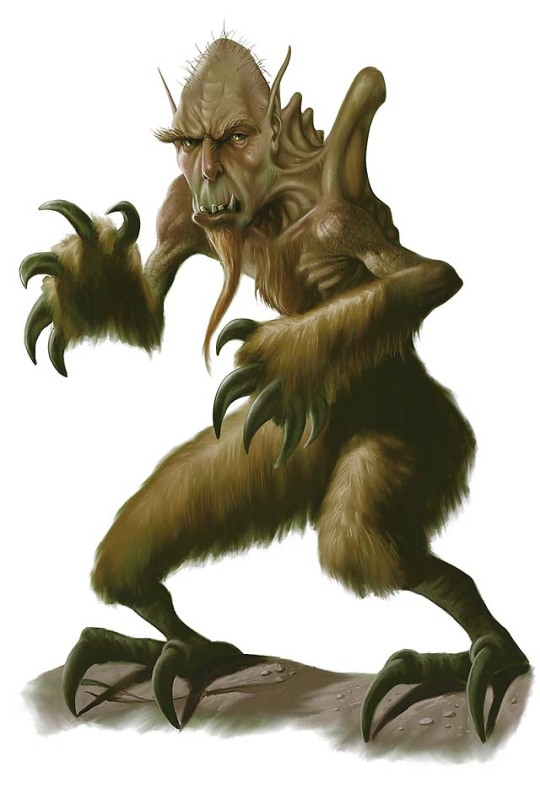
Hej-kin
Hej-kin are a race of degenerate humanoids that spend their entire lives underground, dwelling in the Athasian underdark near suitable supplies of water. They are omnivores and subsist largely on a diet of small subterranean creatures and plants.
Hej-kin are malevolent creatures that enjoy inflicting pain and fear on those who trespass on their caverns, blaming them for the damage that has been inflicted on the earth by the defilers.
Hej-kin language is a combination of sign and verbal communication, and their voices are low-pitched, resembling human mumbling. Few surface dwellers are able to learn the language. The color of their skin varies from red to light green, but their skin is always thick and very tough. Hej-kin live on average for 40 or 45 years.
Hej-kin do not create artificial tunnels or caves, as they consider the earth to be sacred. They will only occupy naturally occurring subterranean formations, but they mark these as their property with curious runes on the cave walls.
Hej-kin clans are often led by earth clerics and preservers. Clerics rise highest in hej-kin society and are the only hej-kin who travel to the surface, usually investigating a disturbance that threatens the earth. Hej-kin are never defilers.
Hej-kin are natural enemies to most other surface dwelling and subterranean races, due to the abuse and destruction of the earth perpetrated by these others. Hej-kin clans will migrate to a new area every decade in order to avoid over-using the land on which they dwell.
Hej-kinCREATURE 0
1d4+1 slashing plus drain life
Hej-kin Priest
All hej-kin priests worship the earth, as do all hej-kin. Hej-kin priests are the only members of their society who ever travel to the surface, usually to investigate some disturbance that threatens their home or the earth.
Hej-kin PriestCREATURE 1
1d4+1 slashing plus drain life
Hej-kin Wizard
Due to their worship of the earth, all Hej-kin wizards are preservers.
Hej-kin WizardCREATURE 1
1d4+1 slashing plus drain life

Id Fiend
The id fiend is a psionic predator whose greatest weapon is its ability to draw images of its victims’ fears from their minds.
The id fiend is very much like a gila monster or large lizard in appearance. It has a large, thick, stocky body supported by four muscular legs. All of the id fiends’ legs end in four clawed digits, three pointing forward and one backward. The torso of the id fiend usually ranges from 3 to 4 feet in length, ending in a long, tapering tail which is often up to four feet long. The head and neck of the id fiend measure two feet long, with its jaws making up about one foot of that length. The id fiends’ skin has a tough leather-like texture, varying in color from light brown and tan, found on specimens encountered in the desert, to a dark olive green, found on specimens encountered in the forests and jungles.
Id FiendCREATURE 4

Jozhal
Standing about four feet tall, the jozhal is a small, two-legged reptile with thumbs and the ability to shift its scales to match its background. The jozhal live in small family groups of four to five creatures. They are extremely intelligent and cunning, but regard humans or demihumans as foolish, dangerous creatures and will rarely tolerate them.
Jozhals are attracted to magic of all sorts, and whenever they see humans or demihumans passing they track the party down and attempt to cast a detect magic spell on the group. If the spell reveals any magical items, they will try to sneak into camp and steal them.
Jozhals forage for food (roots and tubers), and eat almost any sort of small reptile, snake, or insect. Their magic is elemental and not destructive to the environment around them.
The jozhal clan’s intellect is best reflect in its relationship to the world around it. They are careful never to destroy the life-giving world in which they live, always making use of every bit of scrap and refuse that they find. They carry this to extremes, even practicing cannibalism and using the bones of their dead to construct weapons and tools.
JozhalCREATURE 1
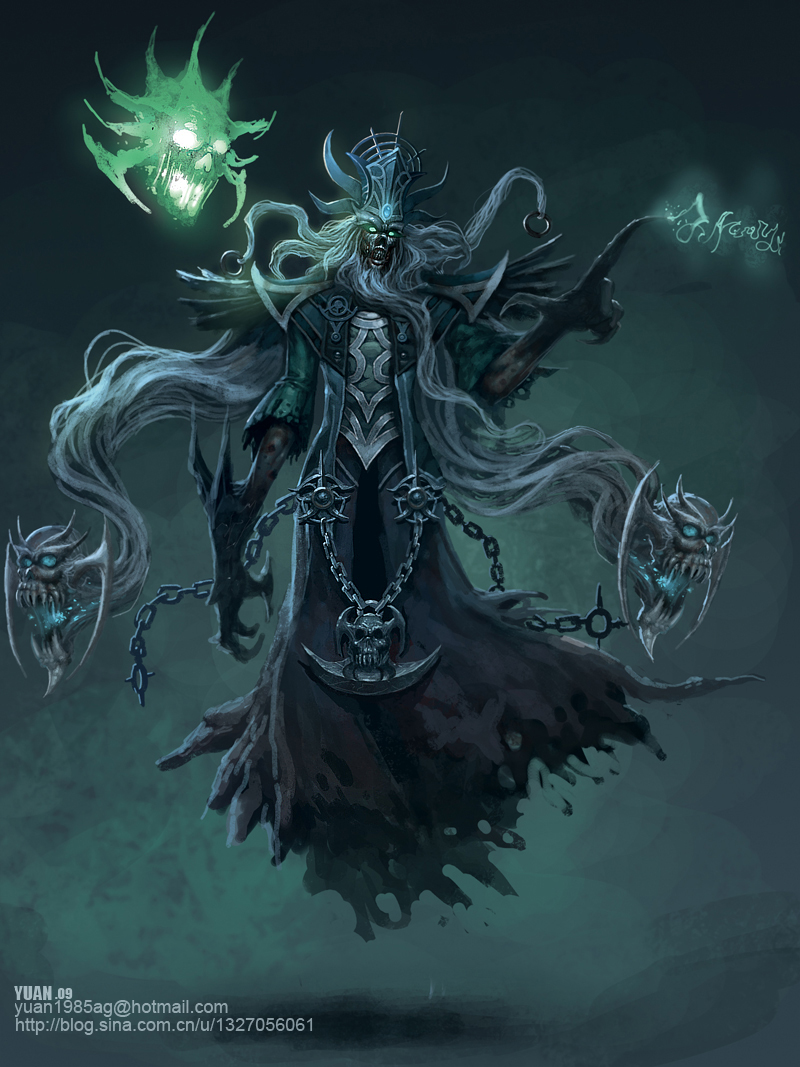
Credit: ChaoyuanXu
Kaisharga
Kaishargas are extremely powerful undead. They voluntarily embraced this existence through a complicated ritual in order to prolong their life and increase their power. They come from all classes: fighters, wizards, monks, psionicists, and even evil clerics.
Gaunt, skeletal beings, kaishargas gain incredible powers through undeath. Their eyes burn with green fire of hatred for the living, and their connection to the Gray gives their skin a grayish tint. Kaishargas dress as they did in life. A kaisharga’ s transformation gives it great strength and agility, as well as deep cunning and wisdom. The defiler becoming or creating a kaisharga must be able to cast 8th-level arcane spells.
Kaisharga are seldom encountered. They live in shadowy places, directing other undead and living beings to work their schemes for them.
The kaisharga is a dreadful creature that has turned its back on the rightful order of things, trading life for power. It has no place in the living world. If encountered outside the Valley of Dust and fire, the kaishargas tend to be a solitary mage. Within Ur Draxa, the Dragon confers undeath on any of its servants who prove exceptionally capable, loyal, and efficient.
Kaisharga DefilerCREATURE 16
3d4+6 bludgeoning
5d8 void plus paralyzing touch
Kaisharga MonkCREATURE 14
4d8 void plus paralyzing touch and Improved Grab
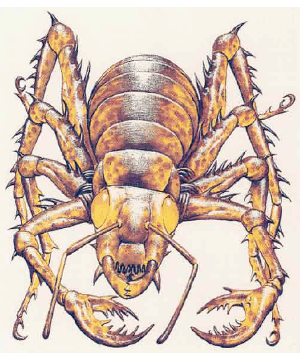
Kalin
This creature is a monstrous hybrid of spider and ant. Armored with chitin of mottled yellow and brown, it has glowing eyes, wickedly curved mandibles and slashing forelimbs that it waves aggressively towards you.
Kalin are a breed of insect that dwell in the Athasian underdark. They have the bulbous abdomens of ants, but the thorax, limbs and head of a great spider. Although able to spin spider silk, these many-limbed horrors do not weave webs but instead hunt their prey. Sometimes domesticated as mounts by the dray, they are cunning predators with a vicious array of natural attacks.
Dregoth has four squadrons of elite kalin riders, each composed of 25 templars of at least 5th-level. Each squadron is led by an 8th-level officer, armed with the best equipment their lord can procure and accompanied by their own war defiler from the College of Blackspire. Arrogant and powerful, the kalin riders are generally loathed and feared by the other citizens of New Giustenal.
Kalin chitin is used in the construction of armor by the second generation dray, but they rarely hunt the creatures for this purpose, instead preferring to scavenge chitin from wild kalin corpses. Wild kalin do not form nests, except to lay eggs. Once hatched, young are not attended and the entire nest will separate. Kalin reach maturity in six months and live for five years and often find themselves in fierce competition with wall walkers, another subterranean species, during that time. An adult kalin is 12 feet long and weighs 700 pounds.
KalinCREATURE 3
1d8+6 slashing plus Grab
1d6+6 slashing

Krag
Krags are undead created when a cleric aligned to an element or para-element dies in the medium diametrically opposed to his own. The anguish and trauma of dying to the very force he devoted his life to opposing is sometimes enough to transform a cleric into a wicked and bitter undead. The elemental lords of the new power quickly enslave such an undead cleric to their service.
Krags look much like the individuals they were created from, except that they also take on the appearance of the element that killed them. A silt-krag, for instance, would have dry leathery skin and choking dust would constantly fall from its mouth, nose, and ears. A magma-krag, on the other hand, would be a mass of dripping, molten earth.
Opposing Elements Table
| Element | Opposition | Element | Opposition |
|---|---|---|---|
| Earth | Magma | Silt | Water |
| Air | Sun | Sun | Water, Air, Rain |
| fire | Water | Rain | Silt, Sun |
| Water | Fire, Sun, Silt, Magma | Magma | Water, Earth |
Sun KragCREATURE 10
2d10+8 piercing plus elemental infusion
2d8+8 slashing
Kragling
A kragling is an undead creature created by a krag’ s elemental infusion. The humanoid or animal rises as a skeleton under the krag’ s control. Kraglings share the same elemental bond as the krag that spawned them, and their appearance reflects this link. For example, creatures killed by a silt krag rise as skeletons with dried, grayish bones, while a water krag’ s victims appear as moldy, fungus-ridden skeletons.
Kraglings have a telepathic link to the krag that created them and follow that krag’ s mental commands at any distance.
Fire KraglingCREATURE 1
Silt KraglingCREATURE 1
 Credit: William O'Connor
Credit: William O'Connor
Megapede
Megapedes are colossal centipedes which roam the sandy deserts of Athas. Megapedes are similar to normal centipedes in all ways except in size. They have an exceptionally long (100 to 150 feet), segmented body which sports a pair of legs nearly every two feet. These legs are five feet in length and have flexible claws at their ends. The body of a megapede is covered with a fur-covered, bulbous skin which serves as a pseudo-exoskeleton.
The megapedes of Athas are, with the exceptions of the Dragon and Nightmare Beasts, the most dangerous feature of traveling across the deserts of this harsh world. Because of their sheer size, megapedes cannot normally hide their presence.
Most, however, live beneath the sands of the desert, only surfacing to feed on unfortunate passers-by. Herds of erdlus and even kanks are among the favorite foods of megapedes, though they often survive on vegetation alone for weeks on end.
When a megapede is ready to lay eggs, it will find an isolated area, if possible, in the rocky barrens of the Tablelands, and begin to make a cocoon in which to place its eggs. Up to three eggs can be placed within one cocoon, which often reaches near 60 feet in length. A cocoon will remain for four to five weeks before bearing young megapedes. At birth, a megapede is 20 to 30 feet long, growing to its full size within three months after birth.
While not especially protective of its cocoon, a megapede which has laid eggs will fight off any creature which threatens them, mostly out of instinct.
MegapedeCREATURE 16
3d12+16 piercing plus megapede venom
3d10+16 piercing
2d8+16 bludgeoning

Meorty
A meorty is an undead guardian of a long-lost domain who continues to watch and enforce its ancient laws. A transgressor is calmly informed of its transgression, often in an ancient language, and asked to accept his punishment with honor. One who refuses is immediately attacked and killed by the meorty.
A meorty appears as a gaunt figure wrapped in rotting clothes. Though the clothing appears finely made, as benefited the meorty’ s station, it is moldy and ragged. A meorty also wears jewelry of fine craftsmanship and often wields metal weapons. Even with their skeletal appearance, meorties moves with grace and have a deep, reverberating voice. A meorty knows only the ancient languages it knew in life. Its eyes glow with bright green lights.
Content to rest in peace, a meorty does not attack those who avoid transgressing its laws. It follows its ancient code to the letter, however, and enforces it mercilessly. Meorties were created in ancient, complex rituals whose knowledge has been lost to the ages. All meorties were created over 2000 years ago.
MeortyCREATURE 6
2d8+7 slashing plus 1d6 mental
2d4+7 bludgeoning plus 1d6 mental
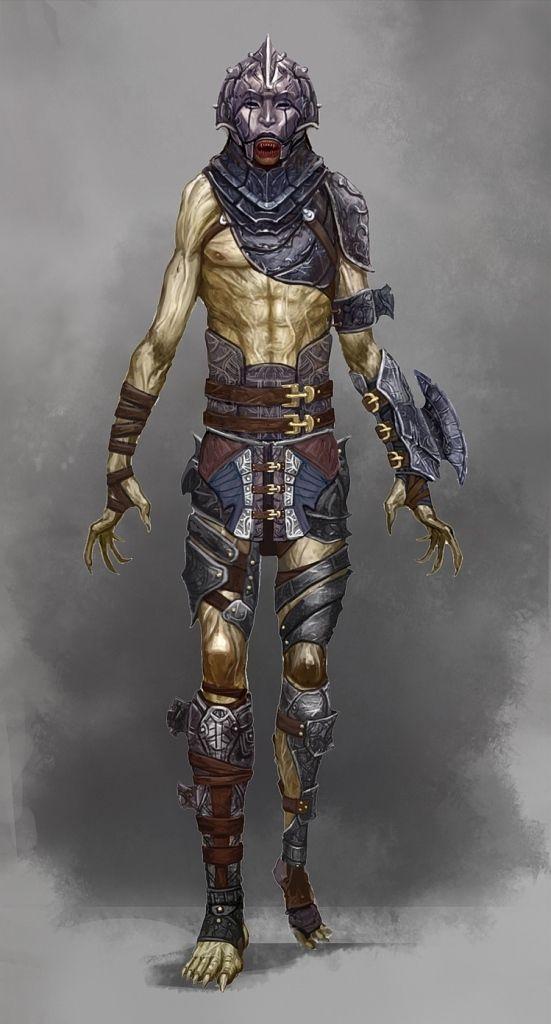
Morg
Morgs are a powerful form of undead created when a high-level lawful evil templar or, more rarely, a cleric is mummified, and life energy is expended to grant it unlife. It can survive for centuries. Morgs have gray flesh that clings tightly to its bones. They give off an odor that is said to be reminiscent of spices, because of the herbs used in the embalming process that created them. Morgs are keenly intelligent and are able to communicate just as they did in life. Further, they have an inherent ability to telepathically command all normal undead created by them. They have the ability to control other undead, provided that they are not under the domination of another of higher hit dice, but this is possible only when verbal orders can be given.
MorgCREATURE 9
1d10+11 bludgeoning plus 1d6 void, morg rot, and Grab
2d6+11 bludgeoning plus 1d6 void, morg rot, and Grab
2d8+11 slashing; plus morg rot

Mountain Stalker
These giantlike creatures stand some 10 to 15 feet tall and have strange, beast-like heads with a pair of glaring eyes protruding from the middle. However, the most notable feature of these giants are their arms; each forearm ends in a pair of semi-prehensile tentacles, which they use to rend their prey apart.
Mountain stalkers are a strange race of skilled climbers that mostly inhabit rocky and mountainous areas. Although they usually keep to themselves and shy away from civilized areas, they are not above attacking a much less weak force if encountered. Mountain stalkers have little or no regard for other creatures, except for other mountain stalkers. The life of a mountain stalker is extremely dangerous, and most have short life spans.
Mountain Stalker CREATURE 5
2d6+6 bludgeoning
2d6+6 bludgeoning

Mud Fiend
The mud fiend is a lurking predator formed entirely from mud, slime and muck. Most scholars assume that the mud fiend is a sentient force that inhabits and animates mud, as the creatures seem indistinguishable from the wallows that are their home. Others believe it to be a colony of microscopic animals cooperating to create a common defense out of the mud.
Mud fiends require decaying flesh to sustain their foul existence and treat the bodies of their victims as fertilizer for their homes. A mud fiend forms a body that is roughly man-sized, but this form is temporary and can reform if destroyed. There appears to be no known way to permanently destroy a mud fiend, other than by drying out or removing the mud that is its domain.
Mud FiendCREATURE 5

Mul
Born from the unlikely parentage of dwarves and humans, muls combine the height and adaptable nature of humans with the musculature and resilience of dwarves. Muls enjoy traits that are uniquely their own, such as their robust metabolism and almost inexhaustible capacity for work. The hybrid has disadvantages in a few areas as well: sterility, and the social repercussions of being created for a life of slavery.
Humans and dwarves are not typically attracted to each other. The only reason that muls are so common in the Tablelands is because of their value as laborers and gladiators: slave-sellers force-breed humans and dwarves for profit. While mul-breeding practices are exorbitantly lucrative, they are often lethal to both the mother and the baby. Conception is difficult and impractical, often taking months to achieve. Even once conceived, the mul takes a full twelve months to carry to term; fatalities during this period are high. As likely as not, anxious overseers cut muls from the dying bodies of their mothers.
Second only to the half-giant, the mul is the strongest of the common humanoid races of the tablelands. Muls grow as high as seven feet, weighing upwards of 250 pounds, but carry almost no fat at all on their broad muscular frames. Universal mul characteristics include angular, almost protrusive eye ridges, and ears that point sharply backwards against the temples. Most muls have dark copper-colored skin and hairless bodies.
Mul Barbarian
Brutality is a way of life in Athas, as much in some of the cities as in the dwindling tribes of Athas’ harsh wastes. The barbarian is a fearsome warrior, compensating for lack of training and discipline with bouts of powerful rage.
While in this berserk fury, barbarians become stronger and tougher, better able to defeat their foes and withstand attacks.
Mul BarbarianCREATURE 6
Mul Gladiator
A Gladiator is as much an Entertainer as any minstrel or circus performer, trained to make the arts of combat into a spectacle the crowd can enjoy.
Mul GladiatorCREATURE 5
2d8+6 piercing plus hampering slash
1d4+6 bludgeoning
Mul Slave
Born as they are to lives of slave labor, with the taskmaster's whip taking the place of parents and family, muls are given to a gruff personality and violent reactions. Understandably, many never seek friends or companionship but live out their lives in servitude, driven by hatred and spite. Most, however, learn who to trust in the slave pits and who not to, gaining favor and reputation among the other slaves.
Mul SlaveCREATURE 0

Nikaal
The nikaal are desert dwelling nomads and traders with occult powers. They are especially interested in items of psychic significance, for which they will pay handsomely. Nikaal believe that material goods have lives of their own, and honor and respect the things they own and trade. This respect is most clearly seen in their signature polearm, the tkaesali. This polearm is made of a hoop studded with sharpened obsidian or teeth and decorated with runic symbols. Only those who have earned the right through deeds to their community may carry a tkaesali, and these items have storied histories that are passed down through oral and magical tradition. If a tkaesali is stolen, the entire tribe will stop at nothing to track it down and get it back.
Although they may seem slow and deliberate in both thought and motion, nikaal are by no means stupid or weak. Their psychic powers are most useful in interpersonal relations, so rarely are brought into play in battle. Their skins are tougher than leather, they can withstand fire and typically carry one handed weapons and shields into battle. They almost never wear armor, as covering their whole bodies interferes with their heat balance and forces them to consume more food and water to survive. Nikaal can spit acid, but rarely use this in combat with other nikaal, seeing doing so as a sign of utter disrespect.
Nikaal live in peripatetic communities united under an elected council. These elected elders are often gifted in magic and use their powers to determine where and when the nikaal travel.
Arcane magic is of less interest to them than either occult or divine—most of their powerful spellcasters are clerics favoring the elements of earth and air, or druids with mastery over the desert, fire or water. There is no division between the sexes, and telling different genders is difficult, if not impossible, for those that are not nikaal.
A nikaal has a lifespan equivalent to that of a dwarf. They are typically covered in fine purple scales, but both cooler blues and warmer reds are possible. Their claws (and bones) are green in color, and faintly luminous in moonlight.
Nikaal WarriorCREATURE 2
1d10+4 slashing
 Credit: Wayne Reynolds
Credit: Wayne Reynolds
Nightmare Beast
With a disposition as bad as its reputation, it’s no wonder that a nightmare beast spreads terror wherever it goes.
A nightmare beast stands at least 20 feet tall on its four legs. Each of its digits is tipped with a 3-foot-long claw. Its jaws are filled with 1-foot-long teeth and flanked by curved tusks the size of cavalry lances. A nightmare beast’s thick, rough hide is typically dark gray with dark blue, purple, or brown splotches in between patches of bony material. Its red eyes, each the size of a man’s head, glow in the dark.
A Nightmare Beast’s Lair
The nightmare beast prefers to lair in a remote cave. It spends most of its time in search of food, and it tends to hunt in one area until the food supply is exhausted. At that point, it usually hibernates for up to one year, then awakens again in a ravenous state.
The monster has no interest in treasure, nor does it often bring any prey back to its lair, unless the kill is too large that it cannot be consumed all at once. A nightmare beast often inadvertently eats treasures along with their owners, so occasionally items of value turn up in the creature’s lair at a later time.
Nightmare BeastCREATURE 19
4d10+20 piercing and drain life
4d8+20 slashing plus nightmare fuel
4d12+20 piercing

Credit: Andrew Olson
Obsidian Retriever
An enormous spider composed entirely of obsidian, this creature scuttles towards you, lambent energies playing within its faceted eyes.
Obsidian retrievers are constructs fashioned by procedures long forgotten. Relics of an earlier age, they are the prized possessions of sorcerer-monarchs and the great merchant houses, but are also sometimes encountered in the ancient ruins that dot Athas‘ landscape.
Their similarity in appearance to the demonic race known as retrievers may be a coincidence, or obsidian retrievers may indeed, be the results of long-lost magical experiments to recreate servile versions of the abyssal species. Whatever the truth, psionics clearly had a hand in their design, as rumor has it that only psionic disciplines of the highest power can allow a user control over an obsidian retriever. Needless to say, these same rumors hint that the palaces of the sorcerer-monarchs are guarded by specially programmed obsidian retrievers that answer only to the monarch in person.
Obsidian RetrieverCREATURE 13
3d6+14 slashing plus 1d6 bleed
Fire Ray 12d6 fire damage (DC 30 basic reflex save).
Ice Ray 12d6 cold damage (DC 30 basic reflex save).
Electric Ray 12d6 electricity damage (DC 30 basic reflex save).
Petrification Ray As per a 6th-level petrify spell (DC 30 fortitude save).

Pakubrazi
This freakish beast seems to be composed of varying. parts of insect and human, with compound eyes, wings and small claws for hands. It stands on two clawed legs, towering over all but the tallest half-giants.
Pakubrazi are insect-like creatures that can change the shape of their bodies to resemble humanoids. These bipedal creatures have small claws that serve as hands, and a pair of wings that allow them to fly. They are capable of changing all or parts of their body to resemble humanoids, though they cannot imitate individual features.
Pakubrazi are parasites that live by feeding off the blood of living creatures. They usually work alone but may sometimes cooperate in small groups. Dwelling amongst other humanoids, they maintain a charade of normality and are masterful actors. Pakubrazi are thought to be remnants of the Green Age. On rare occasions, pakubrazi blood has been used to intentionally taint an enemy by slipping it into his food. It makes a horrific form of revenge.
A pakubrazi stands 10 feet tall and weighs 600 lbs.
PakubraziCREATURE 6
2d8+9 piercing plus pakubrazi taint
2d6+9 slashing plus Grab

Paraelementals
Beyond the elemental planes, are the homes of the paraelementals. The realms of Silt, Sun, Magma, and Rain. These paraelementals are not as desperate as their elemental cousins because they have not suffered from the defilers’ devastation of Athas.
The paraelements of silt, sun, magma, and rain are hybrids of two other elements. Silt comes from earth and water, sun from fire and air, magma from fire and earth, and rain from air and water. The ethereal creatures that emerge from these unions are not simply hybrid versions of their parental elements; rather, the paraelementals are independent of them, having taken on the attributes of both. They have entirely different views about the nature of things, and what pleases or displeases them lies in their own natures, for their own reasons.
Magma Paraelementals

Lava OtterCREATURE 1
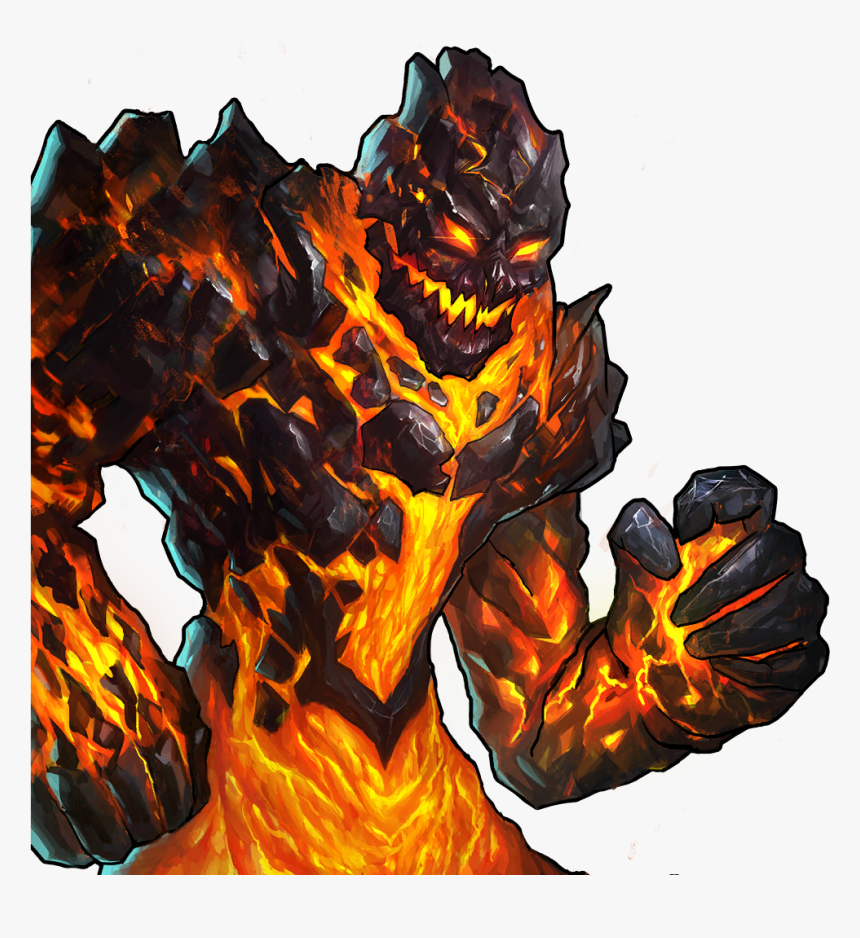
Living MagmaCREATURE 13
2d8+11 fire plus 2d8 persistent fire

FirewyrmCREATURE 9
2d8+11 fire plus 2d8 persistent fire
2d8+6 fire

Magma ScorpionCREATURE 8
2d6+9 bludgeoning plus 1d6 persistent fire and Grab
1d10+9 piercing plus 1d6 persistent fire and magma
scorpion venom
1d6+9 fire plus 1d6 persistent fire
Rain Paraelementals
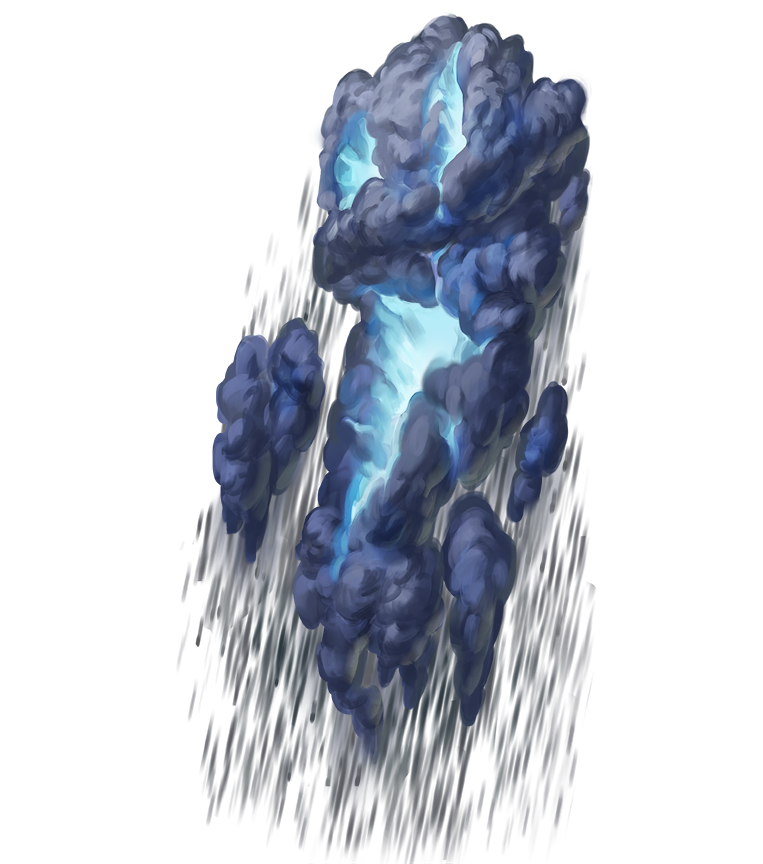
Despairing PallCREATURE 1
pushed 5 feet
1d6 electricity
 Credit: Zerahoc
Credit: Zerahoc
Elemental HurricaneCREATURE 11
2d10+12 bludgeoning plus Push 10 feet
2d12+6 electricity
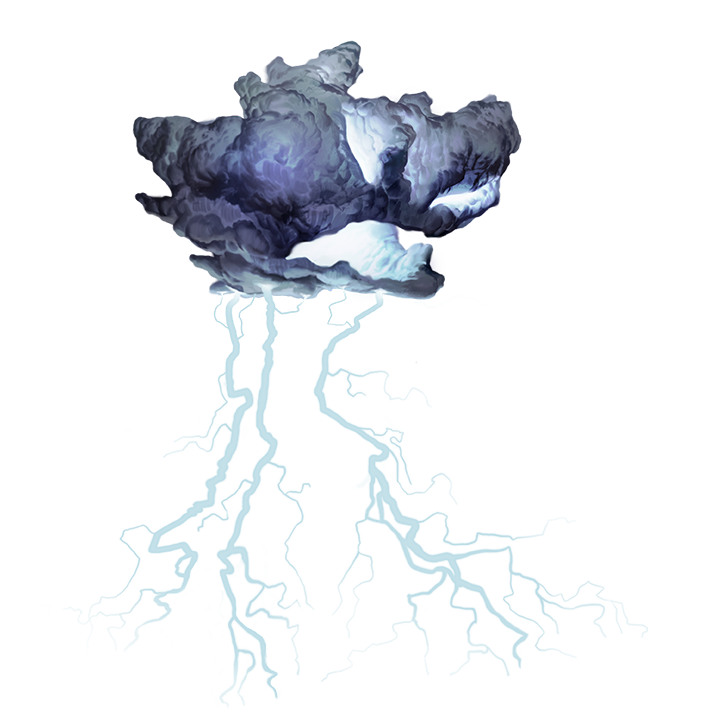
Living ThunderclapCREATURE 4
2d6+6 bludgeoning plus Push 5 feet
2d12 electricity

Mist StalkerCREATURE 4
2d8+4 bludgeoning plus Grab
Silt Paraelementals

BelkerCREATURE 6
2d10+5 slashing
2d8+5 bludgeoning
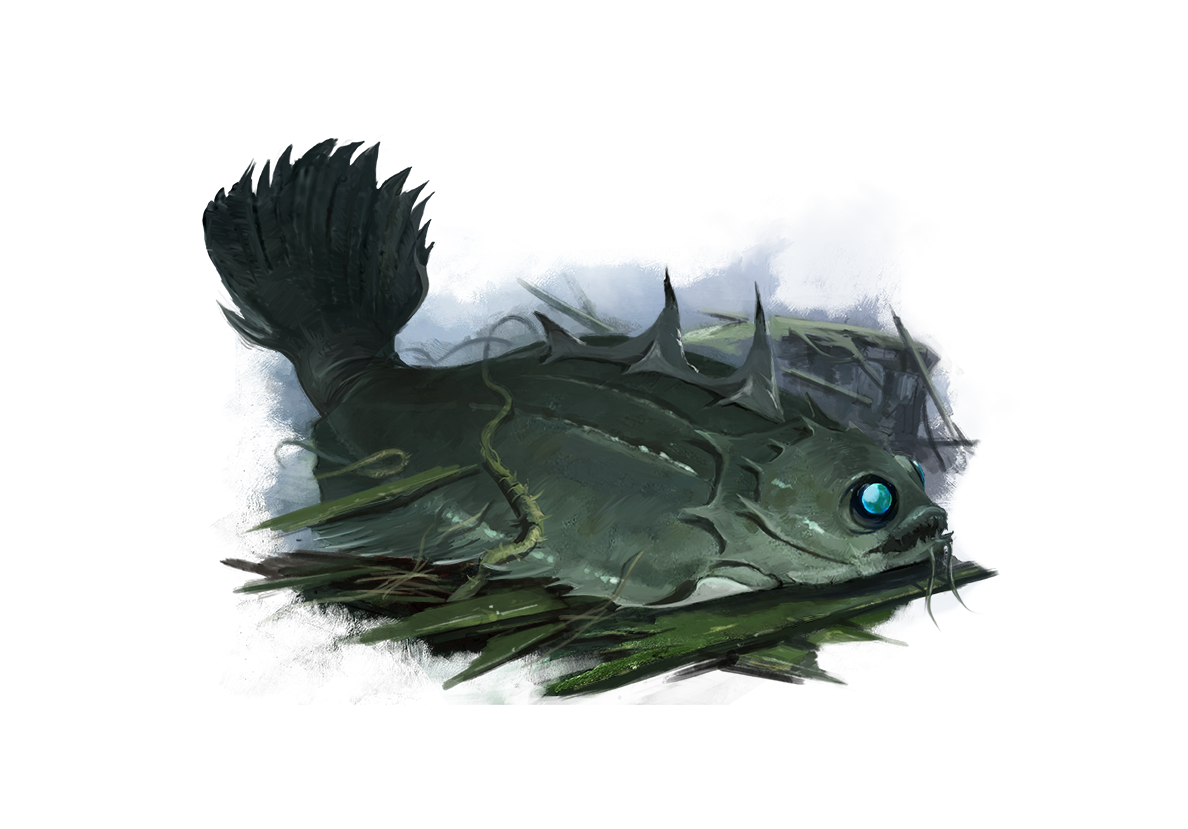
OlobigondeCREATURE 2
1d8+3 piercing plus decomposing toxin
 Credit: AaronMiller
Credit: AaronMiller
Sand WolfCREATURE 5

SiltwretchCREATURE 14
3d12+16 slashing plus Push or Pull 10 feet and blinding sickness
Sun Paraelementals
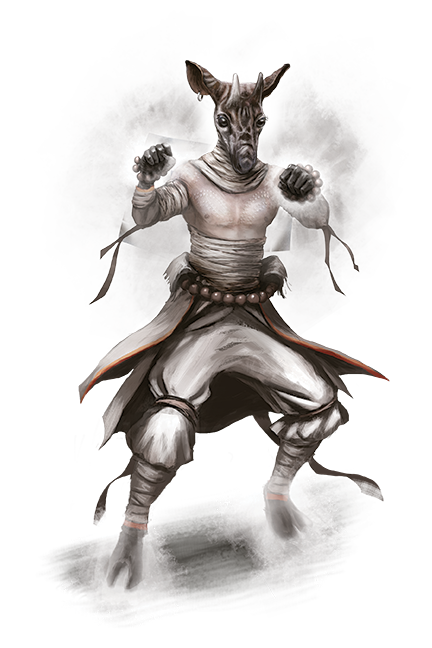
EunemvroCREATURE 5
2d6+6 bludgeoning or vitality
2d8+6 bludgeoning or vitality plus Knockdown
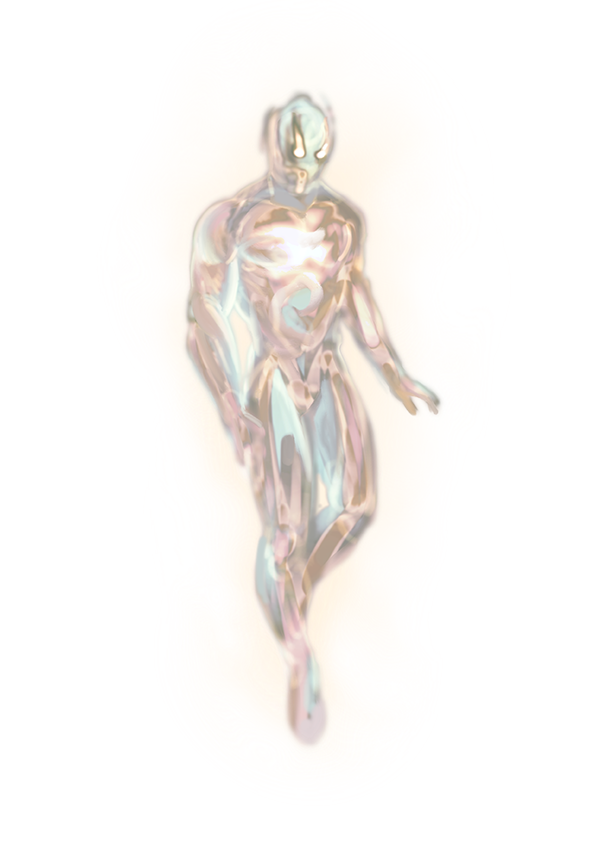
GliminalCREATURE 9
3d8+7 vitality
4d8 vitality

JyotiCREATURE 9
2d12+6 piercing plus 1d6 fire
2d8+6 slashing plus 1d6 fire
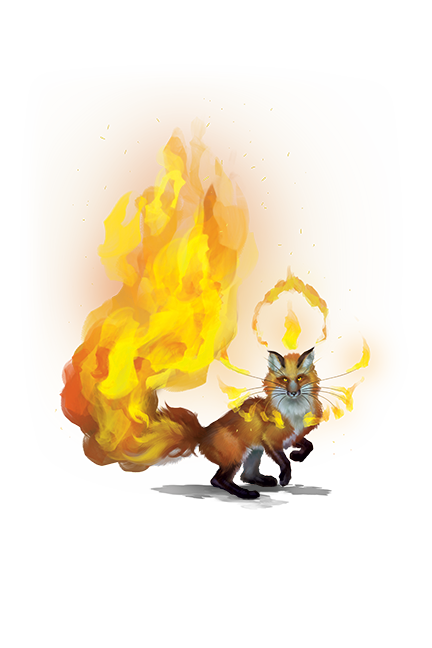
Sun FoxCREATURE 2
1d4+3 piercing plus 1d4 persistent fire
 Credit: Timi Honkanen
Credit: Timi Honkanen
Pit Snatcher
Pit snatchers are creatures that dwell in the tar pits of Athas. Some sages believe that the tar pits that give birth to the snatchers are not natural but were formed by defiling magic so intense that the very earth erupted in noxious boils of smoking black goo.
There may be some truth to this, for those areas inhabited by the snatchers are much hotter, smokier, and fouler than a few found elsewhere beneath the crimson sun. The pit snatchers may have once been earth elementals dwelling in the soil when the defiling magic drew out the very essence of the land. Now they are no more than tortured creatures desiring nothing more than to pull in unsuspecting victims to share their eternal misery.
A snatcher looks much like an earth elemental, except its flesh is made of smoking, dripping tar. There are three holes in its head that seem to form rough eyes and a wailing mouth through which noxious fumes are continually emitted. A snatcher’s arms can reach well over six feet from the rim of a pit, and its hands leave black stains on flesh that never fade.
Though pit snatchers show cunning and intelligence, they do not seem capable of (or at least interested in) communicating with their prey. No pit snatcher has ever been encountered that used anything close to a recognizable language.
Pit SnatcherCREATURE 6
2d8+8 bludgeoning plus Improved Grab
Plant, Carnivorous
The plants on Athas can be extremely dangerous. While many creatures may wish to eat the plants, these plants can be just as dangerous as the beasts that roam the world.
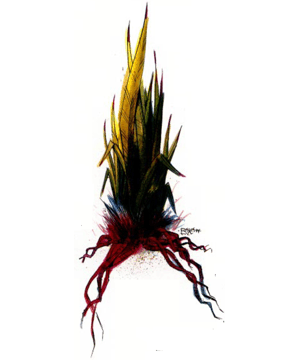
Bloodgrass
Bloodgrass is a blood-drinking plant that manages to appear quite mundane, fooling its prey until the last possible moment. It possesses a set of wiry tendrils that twine around its prey, paralyzing the target and allowing the bloodgrass to drain the fluid it needs in order to feed itself.
Although it is considered a dangerous weed by most intelligent species, bloodgrass is used (by those who can afford the 500 ceramics per plant) as a watchdog, as it is alert, aggressive and feeds itself.
There are many species of bloodgrass that thrive throughout the verdant plains and jungles of Athas. The most common strain of bloodgrass stands about 5 high, but larger variants can grow to twice this size.
BloodgrassHAZARD 5

Bloodvine
The bloodvine is a danger to anyone who travels in the Crescent Forest. It is a parasite, dangerous primarily to those weak with hunger or thirst or to sleeping victims. These parasitic plants consume the blood of those they capture, and travelers report finding skeletons of fairly sizable creatures lashed tight to agafari tree trunks by these potent vines.
Bloodvines live on the bark of the agafari tree and are found only in the Crescent Forest. Growth begins at ground level and winds its way up the tree. Agafari trees that have been surrounded by bloodvine can be found in the central portions of the forest. Such vines represent a tremendous threat to travelers, as there are literally hundreds of feet of bloodvine in such infestations.
Bloodvines live on the fluids they extract from insects and small mammals. They can live for as long as three months on nothing but rain, extracting nourishment from the agafari bark. After a month of such deprivation, however, the bloodvine loses the ability to move, and after three months the bloodvine dies. Each bloodvine is inextricably attached to the tree, which is its host. Bloodvines cannot be transplanted from one tree to another, nor will a bloodvine grow anywhere but on an agafari tree. How bloodvines reproduce is a mystery, but it is impossible to eradicate them completely; kill every bloodvine on an agafari tree and within a month new bloodvines will again sprout.
BloodvineCREATURE 2
1d8+4 piercing plus weeping wounds and Grab

Blossomkiller
The blossomkiller is a creeping plant whose flowers fire quills bearing a paralytic poison. Once its victim is immobilized, the plant‘s tendrils crush its prey to death, allowing the exposed roots to leech nourishment from the decomposing body.
Growing in a sprawling mass, the blossomkiller thrives where there is a steady passage of animal life, as the plant is unable to move itself (beyond the creeping motions of its vines). An intricate system of interlocking vines branches out from the plant‘s roots and weaves itself throughout the plant‘s bed. This network operates much like a spiderweb, for it is touch-sensitive and alerts the plant to the presence of movement.
As soon as prey (or a potential threat) is detected, some or all of the plant‘s flowers will fire poisonous quills at the target. Those without help who fall unconscious due to the poison‘s effects seldom survive the blossomkiller‘ s crushing Strength.
A blossomkiller plant can grow to 12 feet across, although specimens more than three times that size have been reported in the deeper jungles.
BlossomkillerCREATURE 4
2d8+5 bludgeoning plus Grab
2d6+5 piercing plus blossomkiller toxin
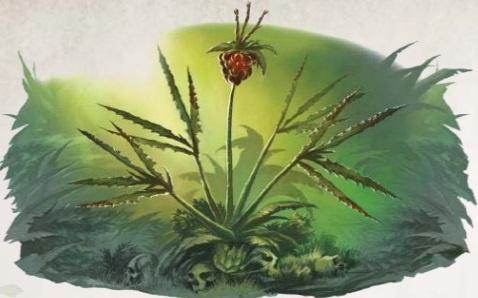
Dew Frond
The ironically named dew frond is a blood-drinking plant that waylays passers-by with its barbed fronds and proceeds to drain them dry on the spot. As it feeds, the dew frond grows at an alarming rate, often doubling its size before the eyes of its hapless victims.
Growing in the Athasian jungle, the dew frond is an innocuous-looking killer that easily blends in with other, harmless flora. A young plant is some four or five feet across, with fronds of three to five feet in length. As the plant grows, it can soon reach heights of fifteen feet or more, with a radius of up to twenty feet.
Dew FrondHAZARD 3
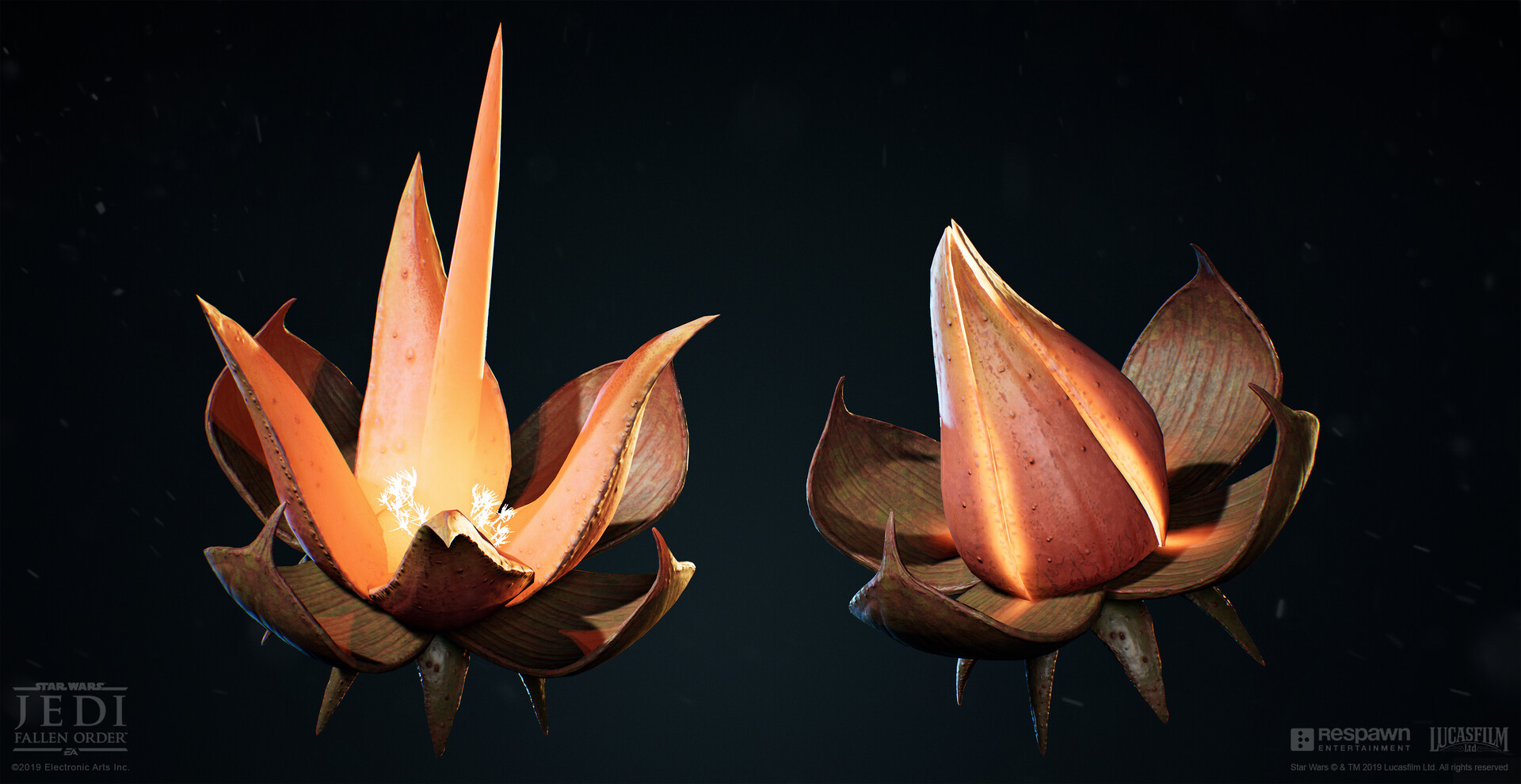
Poisonweed
Poisonweed is found within the forest areas of Athas. Along the roots of this weed grow large, beautiful flowers, bearing bright, orange-colored petals and light, green-tinted leaves. The flowers of a poisonweed plant are from four to six inches in diameter and are extremely hard to miss. A single poisonweed plant will bear up to 30 flowers, which are spread over a 20-foot radius.
These flowers tend to extend out towards foot trails and paths which are commonly used by animals and man-sized travelers in the forest. At the center of a flower is a poison sac, filled with poisonous dust. As a victim touches or brushes against one of these flowers, a large cloud of poison is released into the air affecting all within 15 feet of the plant. Every being inside the affected area that succumbs to the poison falls asleep. Once asleep, the victim is covered with the dust, which, as the victim breathes it, continues to keep him unconscious. Once the victim is asleep, the poisonweed roots quickly grow around and, on its body, until it is completely entangled by them. The poisonweed roots then secrete a corrosive enzyme that slowly eats away at the victim’s flesh, eventually killing it.
Poisonweed plants are difficult to kill, since each time they are hit, they disperse another cloud of poison dust. Each flower on a given plant can generate two clouds of dust before its poison sac is emptied. This means an average plant can create up to 60 poison clouds before being depleted. For each new cloud created each creature in the area must resist the poison or fall asleep.
When a poisonweed plant is killed, it will automatically disperse as many poison clouds as possible before it dies. The only known method of safely killing a poisonweed plant is through the use of defiler magic. When the life source of the plant is drained, it is unable to disperse its dust clouds, and, like all plant life within range of defiler magic, is instantly killed.
PoisonweedHAZARD 2
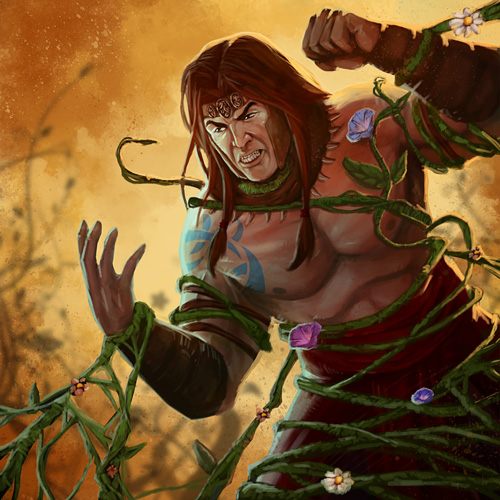
Credit: pinkhavok
Strangling Vines
The strangling vine is a solitary parasite that exists by looping itself around its target and throttling it to death. It dwells in the upper canopy, extending itself across known pathways and animal tracks. When it detects a suitable prey, it loops itself down and attempts to strangle or crush the target.
As the body decomposes, its nutrients feed the host trees around which the strangling vine has woven itself.
The vine itself draws vital sustenance from these hosts, benefiting indirectly from each death it causes. The strangling vine seems to possess a rudimentary intelligence and will actively seek vulnerable areas on its prey‘s body. The vines appear to be able to identify major blood vessels and airways and focus upon these.
The average strangling vine stretches up to 25 feet through the jungle, often twining between three or four trees, and has approximately ten thorny leaves per five-foot section.
Strangling VineCREATURE 3
1d8+6 bludgeoning plus Grab

Psi-Shadow
A psi-shadow is a 3-foot pool of inky black shadow that extends itself from the Black to the Prime Material plane. Bright light sources will destroy psi-shadows, but if there is a small enough light source to produce shadows, they can exist.
A psi-shadow only collects treasure when it needs to produce more shadows. The creature‘s treasure is usually found spread around the lair in small mounds, which it hopes lures greedy victims.
Once a psi-shadow is destroyed it vanishes, and all of its undead servant shadows become free-willed.
Psi-ShadowCREATURE 6
2d8+8 void
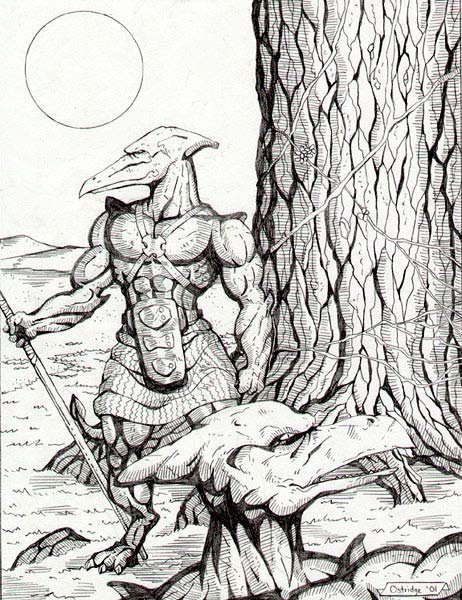 Credit: Randy Ostridge
Credit: Randy Ostridge
Pterran
Pterrans are a race of lizard men who inhabit the Hinterlands near the Ringing Mountains. While most never make it past the mountains, some small clans have made their homes on the desert side, living in the forests and jungles near the Forest Ridge, near the rocky barrens which border the deserts of Athas.
Pterrans look more like humanoid pteranodons than they do lizards, indicating that they may be related in some way to the pterrax, a race of flying creatures found on the rocky barrens of Athas. Standing roughly six feet tall, pterrans have light brown scales for skin. Along with their two arms and legs, pterrans also have a short, tail-like appendage and two rounded stubs on their backs, which further hint at their relationship to pterodactyls. The head of a pterran features large, almost bulbous eyes and a long snout, which is also the creature’s mouth.
The mouth of a pterran has many teeth, which are used for ripping its food apart. The arms of pterrans end with clawed hands, usable in both hunting and fighting. There are no obvious characteristics which distinguish males from females under normal circumstances.
The language of pterrans is a collection of vocal sounds that are combined with clicks and taps made with their claws. The vocal sounds of the pterrans are largely hisses and pops, with occasional snarls or growls. It is almost impossible for humans and demi-humans to speak the pterran language because human voices are unable to create the necessary sounds. It is accordingly difficult for humans or demihumans to interpret this language.
Druid
A small number of pterrans follow the Path of the Druid. These become the priests of the tribe, responsible for furthering the faith of the tribe and for providing healing services for warriors wounded in battle. The guarded area of a pterran druid will most often be the forest area surrounding that druid’s village.
Pterran DruidCREATURE 2
1d6+3 piercing
1d4+3 slashing
Psychic
Very few members of a pterran tribe follow the Path of the Psionicist. Because of the unusual nature of psionic powers, many psionicists within the tribe are regarded with suspicion and doubt by most of the tribe. Nonetheless, psionicists are an important part of the tribe, most often used in negotiating with the other races of Athas that meet the pterrans.
Pterran PsychicCREATURE 4
Warriors
Most pterrans choose the Path of the Warrior. Pterrans that choose the warrior path become the fighters and protectors of the tribe. The warriors are also responsible for preparing the new village sight when the tribe moves from one place to the another. Pterran warriors are taught many methods of combat, including use of their natural weapons, tribal weapons, and the weapons used by their enemies. Warriors are also the weapon makers of the tribe, crafting both slodaks and thanaks, and are responsible for the creation of the unique poison that is used on these weapons.
Pterran WarriorCREATURE 2

Pterrax
Pterrax are large flying lizards commonly used as mounts by pterrans. They occupy the plains and rocky barrens of Athas. They are generally six feet long, with a reptilian appearance, sporting 20 foot wide wings and weighing several hundred pounds. The head of a pterrax is similar in shape to that of pterran, suggesting that the two species are somehow related.
Pterrax make nests in the cracks and crevices in the rocky terrain that is characteristic of the plains of this desert world. Most are solitary, but occasionally they gather in groups of up to six members. Their nests are made from dead branches and sticks found in the nearby forests and oasis that lie scattered across the deserts. The capture and training of a pterrax mount is a part of one of the significant Life Path rituals among the pterrans.
The eggs of pterrax are a valuable source of food, and each one, along with water, can sustain a man for a period of two days without difficulty. The teeth of pterrax are used by pterrans in the creation the thanak, a weapon used by many of that species’ warriors. Also, pterrax skin is sometimes used in making ceremonial drums employed by pterrans in many rituals and yearly celebrations.
Pterrax CREATURE 2
 Credit: Eva Widermann
Credit: Eva Widermann
Pyreen
Pyreens (or Peace-Bringers) are mysterious beings that roam the world of Athas. They are powerful psionicists and powerful druids. They travel about Athas attempting to set things right, although it looks like a hopeless battle. Few know of their existence, and fewer still have ever met one. They are sworn enemies of defilers, and their actions indicate they are bent on the destruction of the sorcerer-kings.
Pyreens are humanoid, although they are not identifiable as any of the current humanoid or demi-human races – rather, they have characteristics of all of them. They have the broad bodies of dwarves, the pointed ears of the elves, the eyes of a human or giant, and the childlike face of the halflings. Pyreens are almost never seen in their natural form, for with their druidic abilities they can take the form of any animal.
Peace-bringers also have forms in each race and generally travel about looking like any of a thousand faceless wanderers on the roads.
It is rare to encounter a pyreen in its true form. When entering combat, pyreen make the most of the situation. Each is unique in its spell and power selection, and each is a unique individual with a style their own.
Pyreen who prefer subtlety will take the form of small creatures or use improved invisibility to hide themselves while attacking opponents from afar with spells and powers. They may summon creatures to fight for them and use the land to act on their behalf.
Some pyreen prefer to attack an intruder directly and will make full use of their wild shape ability by taking the form of the largest, deadliest creature in their domain. All prefer to leave their true identity hidden, and have plans and schemes that unfold to find and support those who can help heal Athas and kill the sorcerer-kings and their minions. Only those truly worthy will ever discover a pyreen’ s identity and nature.
When encountered, others will rarely know that they are dealing with a pyreen. They enter interactions in disguise, or in a wild shaped form. When they do interact, they typically do not use their full abilities, to test the characters to see their power and worth. Only those worthy of their help are given it, and foes of the land are destroyed without mercy.
Pyreen are masters of huge, guarded lands, covering more than a simply a small grove. They watch over entire features of the land, like the Ringing Mountains or the Estuary of the Forked Tongue. Pyreen do not feud or battle over territory, so it is not unusual to see two or more with the same guarded lands.
A few pyreen have guarded lands that include the city-states, though they are careful to avoid detection by the Sorcerer Kings or their agents. These pyreen are often more aggressive, sometimes aiding or even joining the Veiled Alliance of a city to aid their numbers in the battle against the former Champions.
PyreenCREATURE 15
3d10+9 bludgeoning plus 1d6 mental
2d8+9 mental plus 2d6 fire and 2d6 vitality
Raaig
A raaig is a guardian of an ancient temple or shrine devoted to a long-lost religion. It allows those with similar beliefs to enter their temple, usually a grotto, stone building, or underground complex. The raaig warns any trespasser that enters its guarded area, often in an ancient language or through signs the raaig considers clear. If the warning goes unheeded, the raaig attacks swiftly.
Raaigs appear as ghostly versions of their living selves. They are usually dressed as priests or warriors in the clothing or their old religion.
Raaigs were created millennia ago to protect temples or religious grounds. Though no ritual is known, some raaigs can create other raaigs, but only if the creature is willing to become one.
RaaigCREATURE 5
2d8+5 void plus drain life
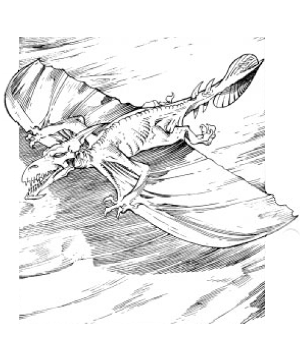
Razorwing
The razorwing hides under the silt and bursts out of the sand to slash at creatures flying above it. It is a vicious carnivore, and packs of razorwings have brought down creatures much larger than themselves. The razorwing is a small-bodied slate gray creature that looks a bit like a small pterrax. It has bone white edges on its wings which are very sharp. It has an 8-foot wingspan and weighs around 100 pounds. A razorwing can communicate with others of its kind. It does not have a language but uses its power of controlled sound to communicate when prey is nearby.
A razorwing likes to ambush by hiding under a light layer of silt, then explode into action, using psionic energy to power its flight. The razorwings live and hunt in packs. They also never attack alone. There is a pack leader, usually the biggest female. Razorwing young are born alive, high in the air. They immediately learn to glide, or they do not survive.
Razorwings are found in the Sea of Silt almost exclusively. There are reports of packs being sighted in the inland silt basins. The razorwing prefers to eat floaters more than anything else. By means of its life detection power, a razorwing can even differentiate between a floater and other kinds of prey.
Razorwing CREATURE 2
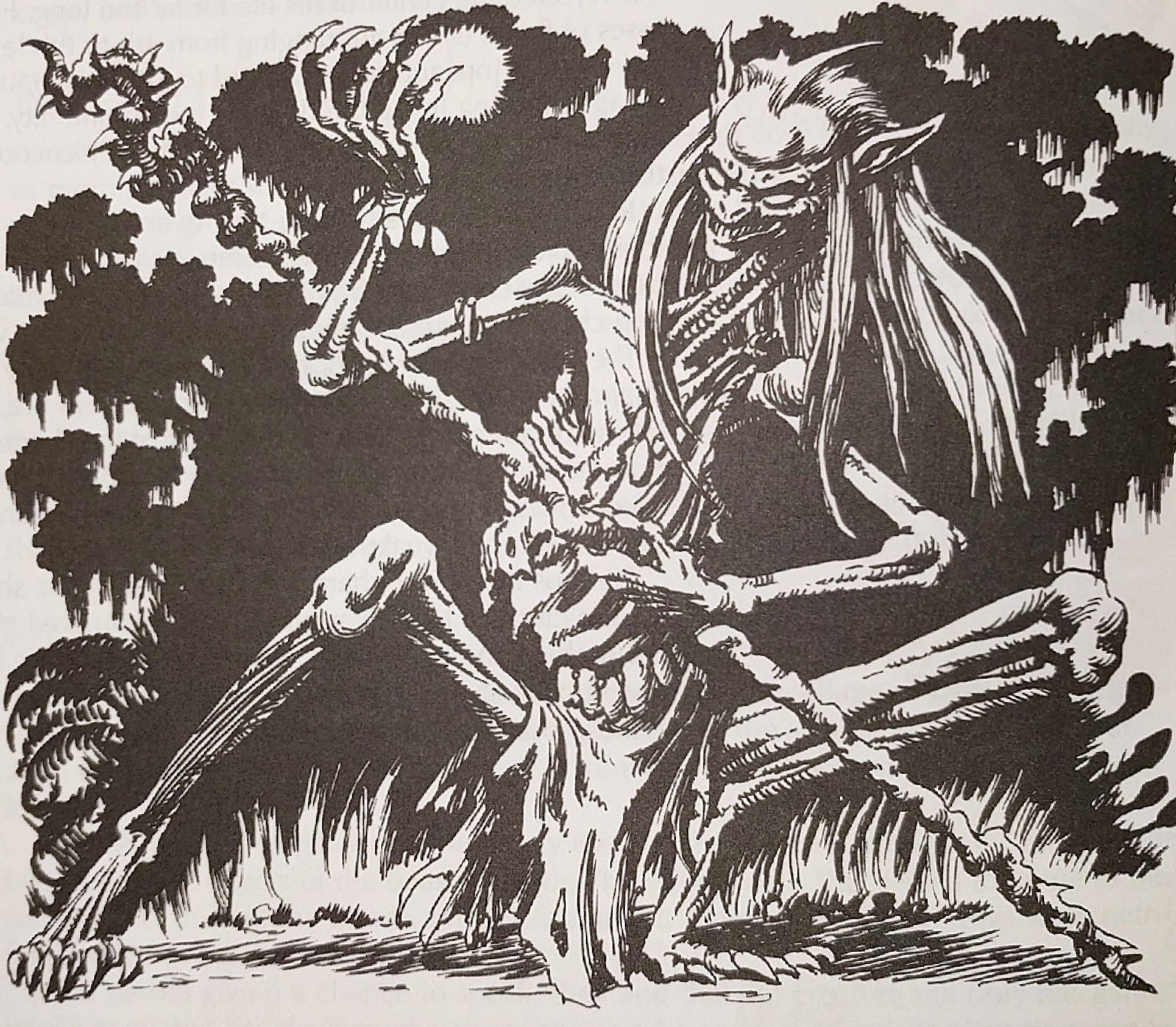
Reggelid
Reggelids are strange creatures that live at the base of the Jagged Cliffs. They are tall and extremely thin, looking like a mass of bones over which there is only thin skin. Their facial features resemble those of elves, with pointed ears, but they have an exaggerated mouth and a thick brow. They have six digits, however, on each hand and each foot.
Reggelids have only one love, and that is magic. They spend their days in run-down tents made of wood and animal skins, learning whatever sorcery they can. They care little for material things; their existence is not one of luxury or comfort.
The hierarchy of reggelid society is determined by magical prowess – reggelid leaders are always the most powerful defilers in the tribe. So ingrained is this stratified worldview that reggelids automatically recognize members of their race more magically adept than themselves and defer to them accordingly. Reggelids bear an especial hatred for the rhul-thaun, the halflings of the Jagged Cliffs, and are reputed to have developed magics that target and destroy the rhul-thaun‘ s life shaped creations.
Halfling scholars, by comparison, theorize that reggelids are creations of Rajaat, or somehow suffer from the First Sorcerer‘s curse. Although clumsily expressed, these theories nevertheless shed some light on the mystery of the reggelids‘ origins, and it is altogether possible that they are a by-blow of Rajaat’ s experiments, a living legacy of his own lust for magical power.
Reggelid CREATURE 4
![]()
Roc, Athasian
Athasian rocs are huge birds of prey that dwell in warm, mountainous regions. They are known to carry large creatures off for food.
These birds of prey resemble large eagles. They are 50 feet long and have a wingspan of 100 feet wide.
Athasian rocs swoop down silently and try to snatch their prey with their claws; then they take off, flying away with the snatched prey and attacking it with their beak until it stops moving. Athasian rocs will drop prey once they have lost a quarter of their hit points or more. Athasian rocs caught on the ground are not as agile and can only attack with their beak.
Athasian RocCREATURE 12
3d12+12 piercing
3d8+12 slashing plus Improved Grab
2d8+12 bludgeoning plus Improved Push 10 feet
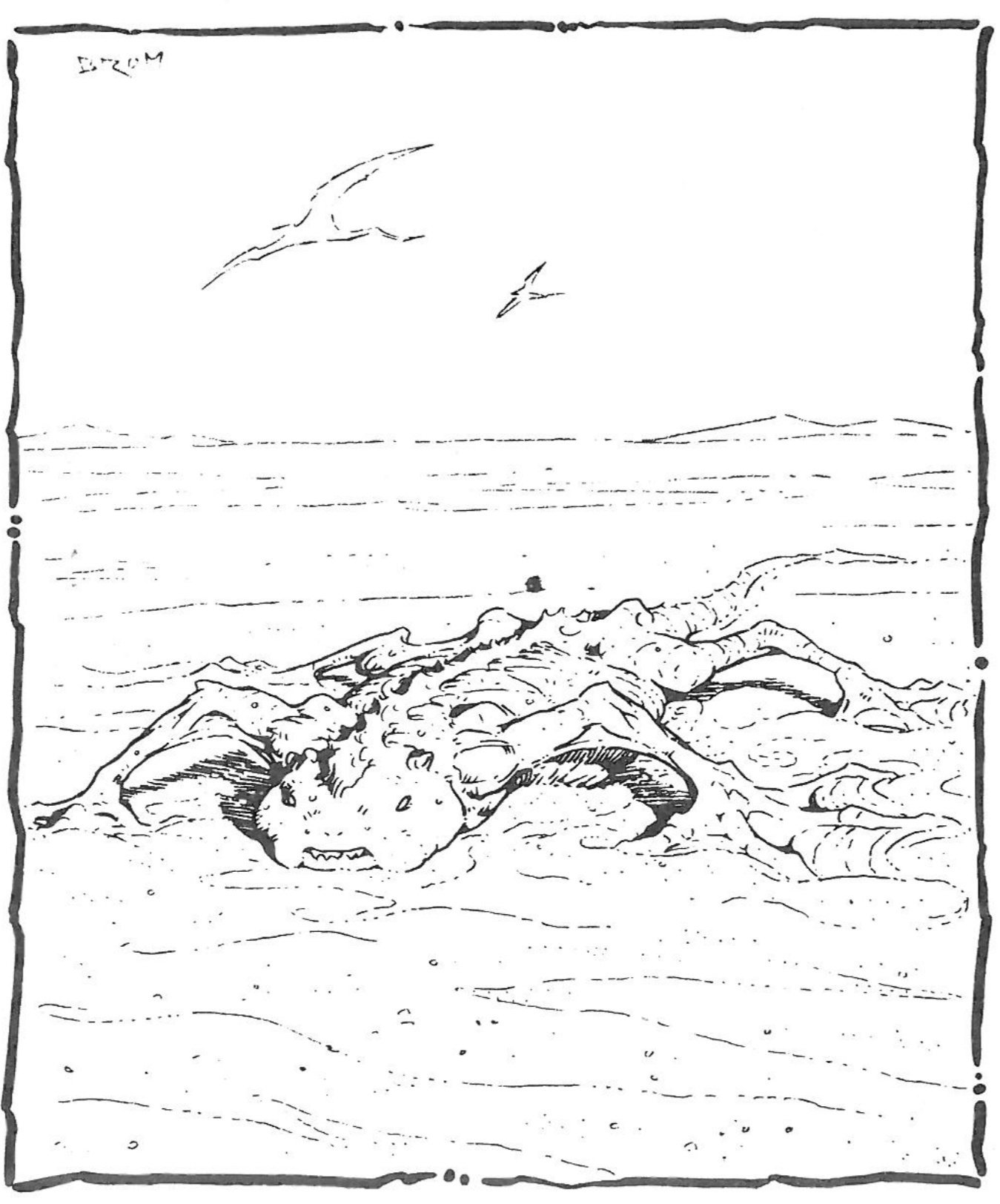
Ruktoi
The ruktoi is solitary sentinel of the silt sea, able to paddle along its surface or lurk just beneath patiently awaiting prey. Some ruktoi have been captured and either domesticated or controlled to ferry passengers or small cargos across the endless silt basin.
The ruktoi’ s limbs each end in three long, splayed digits, webbed for use as paddles. The tail ends in a broad flap of skin that aids in navigating across the surface of the Sea of Silt. When stationary, the ruktoi’ s light gray skin makes it almost impossible to see in the silt. Often the ruktoi hovers just below the surface with only its snout and eyes exposed.
Ruktoi have no spoken language. They communicate with each other through body motions and scent.
RuktoiCREATURE 6
2d10+8 piercing plus Grab
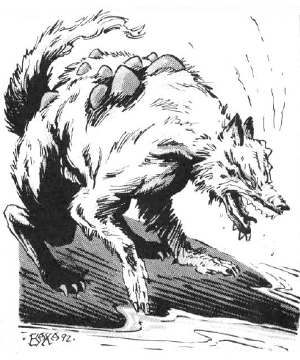
Ruve
Ruves are a breed of dog with formidable intelligence and psionic powers. The color of their fur ranges from a sandy brown to a glossy black, and ruves are often mistaken for wild dogs. When looking into the eyes of a ruve, though, one can tell there is more to it than meets the eye.
Typical ruves are polite and disciplined, often acting like regular dogs in order to ascertain the intentions of individuals they are around, since ruves usually only reveal themselves to those of good alignment. Good clerics and psions seek out the company of ruves as loyal companions, as do the Villichi, being the majority of Athasians with the patience to deal with the ruve’ s intellectual posturing.
Ruves have been known to travel to other planes of existence. Their ability to adapt to such places is remarkable, and they adjust their temperament to suit the world in which they find themselves. Ruves generally prefer warm, dry caves for their lairs, however. Here they bear their young, usually a litter of 2-8 pups that reach maturity a year after their birth.
Ruves are extremely intelligent and have a well-developed culture, creating works of art and often howling together, creating hauntingly beautiful compositions. Because of this, ruve are snobbish and look down on other species of special dogs, considering them peasants. While less intelligent humanoids who connect with a ruve’ s mind often regret it, getting bombarded with constant insults, common dogs are not even worth the ruve’ s time to insult.
High-level wizards are often the targets of sudden and uninvited packs of ruves, since they are always interested in seeking out new knowledge. Ruves also like to send little-known facts to adventurers through mental communication, regardless of the situation at hand.
RuveCREATURE 2
1d6+3 piercing
Ruvoka
Ruvoka are creatures from the elemental planes. They travel the planes easily, even the Astral Plane. They often work with druids, and it is said druids can become ruvoka. Ruvoka can speak the elemental languages native to their plane, but with other intelligent beings often use a limited form of telepathy.
Brajeti
Brajeti resemble large, well-tanned hairless humans who dress in bronze armor and carry bronze swords and shields. They dwell among sands and silt. These ruvoka are entirely loyal to the silt paraelemental lords. They are often powerful troops or serve as guardians for important locations on Athas.
Brajeti CREATURE 19
3d8+8 slashing
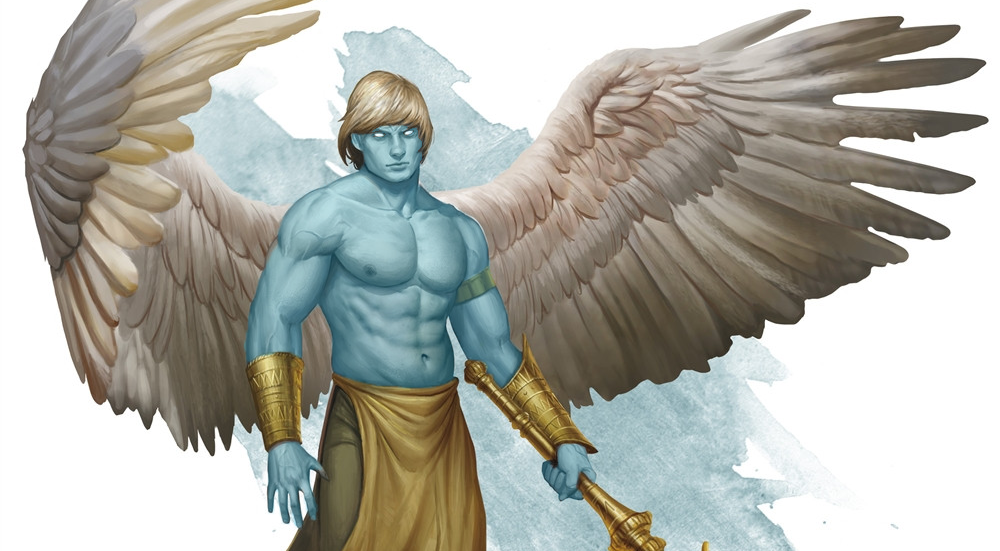
Ethilum
Ethilum are ruvoka with pale blue skin, pointed ears, sharp features, long flowing hair, and large white feathered wings. The Ethilum fight with javelins and whips and always wear white clothing. Ethilum serve the Elemental Lords as powerful troops and support members of the armies of Djinn and Jann. They sometimes serve the Elemental Lords as guardians of important locations on Athas as well.
Ethilum CREATURE 15
3d4+6 slashing plus 1d6 electricity
2d6+6 piercing
Kaltori
Kaltori are human-like ruvoka that are bearded, red-skinned, stocky, human-looking beings wearing searing hot plate armor and bearing fiery red tridents. Kaltori serve the Elemental Lords as powerful troops and may support members of the armies of Jann and Azer. They sometimes serve the Elemental Lords as guardians of important locations on Athas as well.
KaltoriCREATURE 19
3d8+6 piercing plus 2d6 fire
3d8+6 piercing plus 2d6 fire

Zathosi
Zathosi are humanlike ruvoka with wrinkled gray-skin and resemble old humans. Zathosi wear stone-colored robes and the males often grow long beards. The Zathosi fight with stone mauls. Zathosi serve the Elemental Lords as powerful troops and may support members of the armies of Dao. They sometimes serve the Elemental Lords as guardians of important locations on Athas as well.
Zathosi CREATURE 17
3d12+8 bludgeoning
 Credit: OptimusOmega
Credit: OptimusOmega
Sand Bride
The sand bride is a void creature trapped on Athas. It has no other purpose or function other than to viciously use its powers of illusion to lure victims to a cold death. The sand bride usually creates the illusion of an oasis, with itself as a beautiful humanoid of the race of its target. It feeds on the life force of any humanoid with a degree of intelligence. The sand bride is made entirely of sand. It has a humanoid shape and two glowing red eyes.
A sand bride has a burning hatred for intelligent creatures, but it is tempered with a high degree of cunning. A sand bride is intelligent enough to recognize humanoids with water trouble. Such a party is almost certain to be targeted. One of the sand bride’s favorite ploys is to wait until someone is lagging behind the party. This being then comes upon an oasis where he expected to find none. This might seem suspicious, but to a man dying of thirst, a pool of water overcomes many misgivings.
Sand brides are not particularly good at making polite conversation when luring creatures to their death. Most of their information is out of date or plain wrong. However, a sand bride’s first suggestion is almost always “have a drink, then we can talk”. It tries to attack while the unsuspecting victim is filling its mouth with sand.
Sand BrideCREATURE 6
2d8+5 void plus drain life
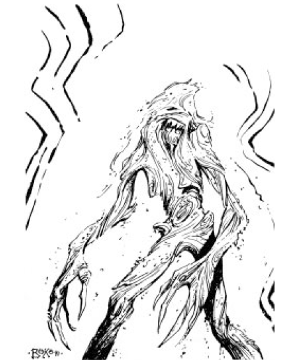
Sand Mother
A sand mother, or mother of the bride, is an old and powerful version of the sand bride. Its normal appearance is identical to that of the sand bride.
The mother of the bride uses the same illusionary powers as the sand bride. Instead of appearing as a beautiful humanoid, it chooses to appear as an older, motherly type of creature. The matronly figure welcomes thirsty adventurers, offering to care for them until they are recovered. A sand mother has learned about its weakness in conversation and has developed the ability to mask it. It does this by showing plenty of concern for the “dear young ones” of the party.
The sand mother is highly intelligent, it does not attack until conditions are favorable. Before attacking, it tries to discover if anyone is carrying any magical weapons. The sand mother always tries to attack the most dangerous member of the party first, with surprise if possible.
A sand mother’s oasis is always chosen with care. If it can find a pit or sinkhole, it uses that as the center of its miragen. Dangerous opponents can then be pushed in while they are "drinking."
The sand mother’s lust for life force exceeds even that of the sand bride. It much prefers intelligent life force, but beasts will be drained of all life, if nothing better is available.
Sand MotherCREATURE 9
2d10+7 void plus drain life
Sand Vortex
The sand vortex (also known as a silt vortex) is a disc-shaped creature that conceals itself below the surface of large bodies of silt. When it detects prey above, it unleashes an enormous psionic whirlwind and uses this to drag its victims towards its mouth.
The sand vortex is active only during the day, seeming to absorb energy from basking in the warmth of the sun filtering down through the silt above. Thought to live for some 60 years, the sand vortex reproduces asexually, splitting itself into two smaller creatures. Rumors persist of far larger specimens, dwelling in the deep silt.
The average sand vortex is 20 feet across and 5 feet thick, weighing as much as 100 tons.
Sand VortexCREATURE 14
Scamp
Scamps are minor creatures from the elemental and paraelemental planes. All scamps appear as small, winged creatures with humanoid features. While they are often described as impish, their elemental origins are apparent at first glance.

Credit: ProdigyDuck
Air ScampCREATURE 1

Earth ScampCREATURE 1

Fire ScampCREATURE 1
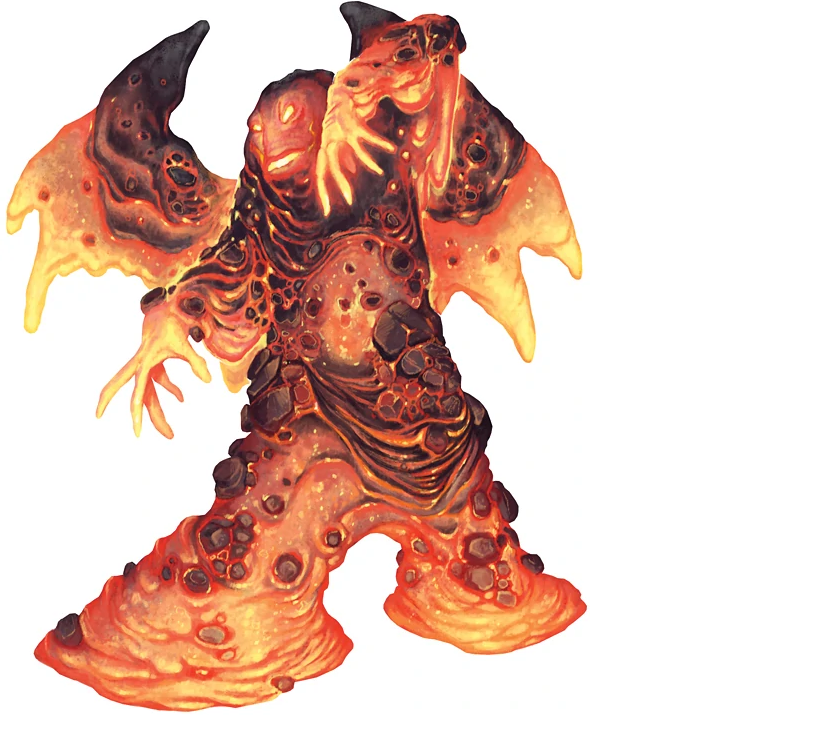
Magma ScampCREATURE 1

Rain ScampCREATURE 1
1d4 slashing and 1d4 electricity
![]()
Silt ScampCREATURE 1

Sun ScampCREATURE 1

Water ScampCREATURE 1
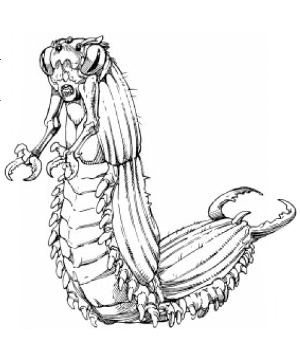
Scrab
Scrabs are small, insectoid men that live in nests in the desert. A scrab can draw air through sand while submerged due to the long gills located all along the grooves in their shells. Scrabs are ruled over by monstrously bloated members of the species known as nest mothers.
Scrabs need little water to survive and seem to derive all the sustenance that they need from the blood and other bodily fluids of their victims.
Scrabs can speak their own language. A small percentage can also speak elven. Adult scrabs live to be 25 years old, but nest mothers can live twice that long.
Scrabs use their psionic powers and their pincers in combat. When many scrab fight, they break up, half going into melee, the other half using ranged psychic powers. Scrab leaders are often accomplished psychics or wizards and will lead their followers in battle, using their abilities to enhance the group's attacks.
Scrabs inhabit tunnels deep under the desert, which they fashion using spittle that solidifies the sand. If possible, the entrance to the nest will be concealed behind a rocky outcrop. Scrabs hate elves and prefer their flesh above that of any other creature. This hatred extends beyond a desire for food and, in fact, anything with pointed ears is likely to be identified as an elf. A captive elf may be kept alive for weeks, even months, just to be tortured. Legends of both races hold that there were once great wars between the two species, with each side blaming the other for the conflicts and for the many unspeakable atrocities perpetrated on innocent victims of each race.
The eldest male in the nest is allowed to mate with the nest mother, with clutches of up one hundred eggs resulting. The eggs hatch in three months, and the young are possessed by a cannibalistic frenzy when they are born. Fewer than half the hatchlings survive this period. Three quarters of all hatchlings are male. Only males who develop additional psionic abilities or spellcasting powers grow into leaders, and only females with clerical abilities can become nest mothers. A female who begins to develop into a nest mother will take several males and depart to create a new nest of her own.
Scrabs are predators primarily but will trade with merchants brave enough to risk contact with the creatures. They are also preyed upon by the larger creatures that inhabit the wastes. Part of the scrabs' hatred of elves stems from the fact that elves use every part of a scrab they have defeated. A scrab shell can be used to make breastplates, and the sharp parts of the pincers make decent polearms.
ScrabCREATURE 1
 Credit: kunkka
Credit: kunkka
Nest Mother
A nest mother is a bloated version of a normal scrab, only able to move at a shuffling pace. Nest mothers are more intelligent than other scrabs and often have levels in the cleric class. Most nest mothers are also powerful psions.
Scrab Nest MotherCREATURE 7
2d8+9 slashing plus Grab
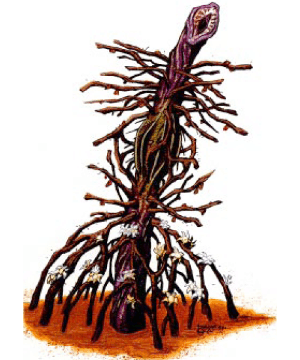
Seed, Brain
The brain seed is an exceedingly rare intelligent plant that uses its airborne seeds to establish psionic control of its prey. With a respectable spread of psychic abilities, the brain seed can dispose of its victims in several ways, but ultimately subsists on the life energies of living creatures.
Brain seed plants are strange, solitary creatures that will even drive dominated prey to destroy other brain seed plants. Their intelligence is keen, and a brain seed plant will often specifically identify and destroy defilers should it suspect that such spellcasters are nearby.
An average brain seed plant stands up to 10 feet tall. It has a thick central stalk with a skirt of roots and a fat seed pod at the midpoint of the stalk with coiling tendrils spreading outward along its length. At the tip of the stalk sits a mouth; however, this is not a feeding organ but rather an outlet for the plant‘s seeds.
Brain SeedCREATURE 3
1d10+3 piercing
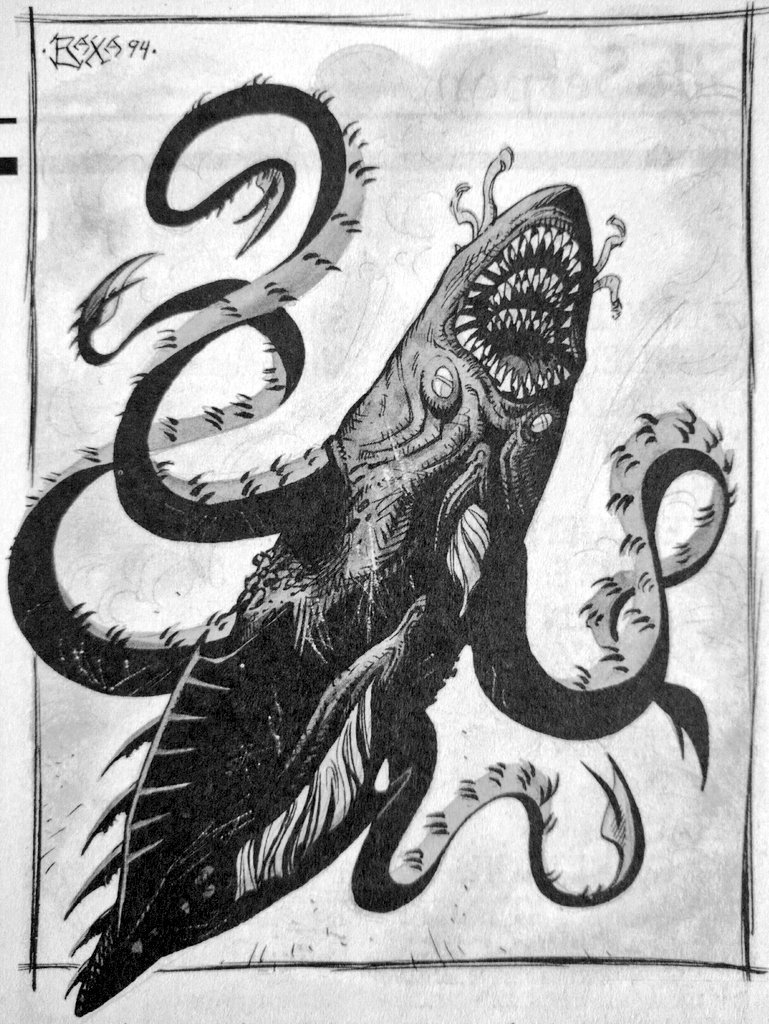
Sharg
The sharg is an alien predator from another world that was brought to Athas by Dregoth and released into the waters of the subterranean Blackjaw River. It has the forequarters of a great shark and the fluked rump of a giant squid, and its four tentacles are lined with hooked barbs.
The sharg lives and hunts in the subterranean network of channels and caverns that house the Blackjaw and its tributaries, hunting the other creatures that dwell there as well as those dray careless or unfortunate enough to cross its path.
Undeniable similarities with the squark of the Last Sea have led some to speculate that the squark must also therefore, have originated elsewhere. Dregoth is surmised to have found (accidentally or otherwise) the original home world of the squark and netted for himself the creature known as the sharg from there.
The sharg is 25 feet long, with tentacles 20 feet in length. It weighs 115 tons.
ShargCREATURE 11
3d10+12 piercing
3d6+12 slashing plus Grab
 Credit: Dave Allsop
Credit: Dave Allsop
Silk Wyrm
You spy an enormous, armored serpent flying through the olive sky above you. It coils and uncoils as it flies, as if it was moving on sand.
A silk wyrm is a large, flying, snake-like beast that can reach over 50 ft. in length and has a hard chitinous shell that covers its body.
Silk wyrms spin their paralyzed victims into a silk cocoon. This silk casing is highly prized in most city-states because of its fire resistance and is used in the manufacture of most silk clothing.
Silk wyrms usually hunt for their prey while flying and attack at night to surprise the victim. The silk wyrm then bites its prey and wraps it up in a durable silk cocoon.
Silk WyrmCREATURE 5
2d6+6 piercing plus Grab and Silk Wyrm Venom
Silt Horror
Silt horror is the name given to a group of predators that dwell mostly in the Sea of Silt. These tentacle-armed monsters come in diverse sizes and colors, but all of them have an unending hunger. Many Athasian sages believe the horrors to be descendants of an ancient water dwelling creature. Their favorite food is the silt runner.
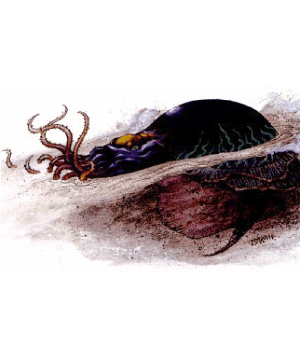
Black Silt Horror
The black silt horror is the smallest and most common of the silt horrors. Resembling a black, dusty octopus or squid with a writhing mass of eight barbed tentacles, the black horror is obviously related to the other horrors. It is much smaller than other silt horrors and roams in groups called clutches. The black silt horror aggressively hunts anything it can catch. Large clutches have attacked white horrors and wading giants.
Black Silt HorrorCREATURE 3
1d8+6 bludgeoning plus Grab
1d10+6 piercing plus black silt horror venom

Brown Silt Horror
The brown horror is a much-feared form of silt horror, since it can psionically force its victims to come to it. Its body is not really brown, being more a dirty shade of white color. It only appears brown when seen against the pearly silt.
The brown horror is always hungry, and even attacks other silt horrors.
The brown horror is a loner, found only in the silt. It may live about 45 years and must eat at least once a month. Brown horrors are the offspring of cross breeding between white and gray horrors.
Brown Silt HorrorCREATURE 6
2d6+8 bludgeoning plus Improved Grab
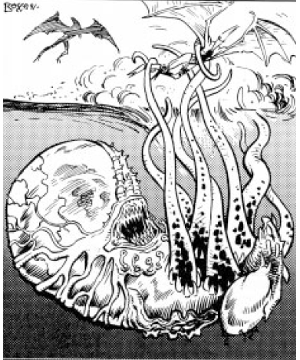
Gray Silt Horror
The gray horror is a sickly gray in color and has a multitude of sharp-edged tentacles. Gray horrors consider anything that they can sense as prey.
Gray silt horrors are solitary, hungry, aggressive creatures. They only use their air sacs for emergencies, preferring to swim through the silt. They range far through the silt in search of prey.
Gray Silt HorrorCREATURE 9
2d8+11 bludgeoning plus Improved Grab
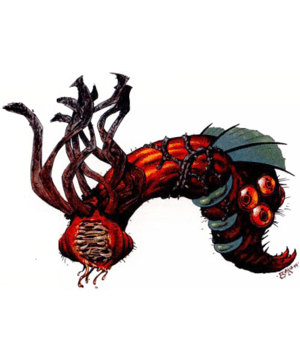
Magma Silt Horror
The magma horror inhabits volcanic areas. Unlike the other horrors, the magma horror is intelligent and has formidable psionic abilities. Since it no eyes, it uses its psionic powers to sense the presence of prey. Once prey is found, the horror contacts its victim psionically, trying to persuade it to approach.
As with all horrors, the magma silt horror is always looking for an opportunity to feed itself. This horror must feed at least once every six weeks, or it begins to weaken.
Magma Silt HorrorCREATURE 7
1d8+8 bludgeoning plus 1d6 fire and Grab
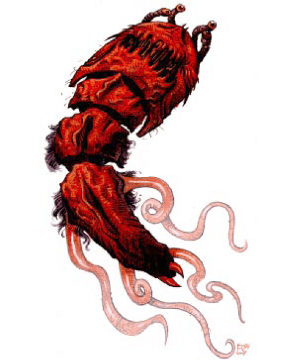
Red Silt Horror
The red silt horror is the most mobile of the horrors, able to propel itself across the surface of Athas using four tentacles as functional legs.
If one or more tentacles are severed, they regrow at the rate of one per month.
Red silt horrors prefer to live in the Sea of Silt. However, if food becomes scarce, they will move to another silt basin, a mudflat, or even the desert, traveling at night to limit the chances that they are seen and attacked. Once a suitable lair is found, the red silt horror uses its air jet to dig into the ground where it awaits its next victim.
Red Silt HorrorCREATURE 5
2d6+6 bludgeoning plus Grab
2d8+6 piercing plus red silt horror venom
 Credit: Peter Bergting
Credit: Peter Bergting
White Silt Horror
The white horror is the most common and usually the largest of the silt horrors. Its tentacles can grow up to 50 feet long. Its mouth is located near the air sac used to propel it and is not used in combat, because it waits until its food has suffocated before it begins to feed. The white horror eats anything except other horrors. It can subsist for years on one meal, lying dormant underneath the silt. Its life expectancy is about 40 years, usually mating only once in its lifetime.
White Silt HorrorCREATURE 11
2d12+10 bludgeoning plus Grab
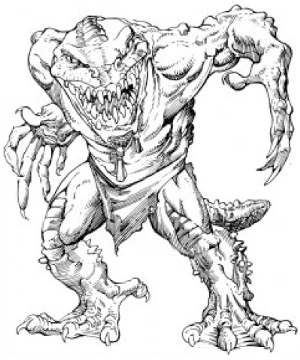
Silt Runner
These small lizard-like men are common on Athas. They usually live the life of raiders, although occasionally a lair will be found. Silt runners move very quickly and have broad, flat feet. They can even run across silt for short stretches. They hate elves with a passion and consider them a delicacy; an entire raiding party of silt runners may turn aside from a caravan to attack a lone elf.
Silt runners wear little or no clothing. What they do wear is usually more of a trophy than any covering for the sake of modesty or protection. Silt runners speak a tribal language, and some can speak the common tongue.
Silt runners never attack unless they outnumber the foe by at least three to one. Silt runners are tribal in nature, living in lairs of up to 200 individuals. These tribes are usually based on islands near the shores of the Sea of Silt or in a remote desert oasis. Silt runners often inhabit the same types of islands that giants do. Giants are usually left alone by silt runners (who know when they are overmatched). The giants tend to view these creatures as pests or vermin, overrunning their homes. Unfortunately, they are just too fast to swat properly.
Silt RunnerCREATURE 0
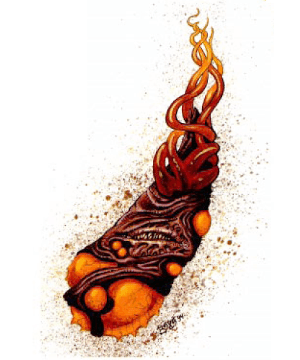
Silt Spawn
Silt spawn are the young of the silt horrors that roam the Sea of Silt. Unlike their adult counterparts, coloration is more difficult to detect at this early age. It seems that the young are born with random colors and only take on the appearance of silt horrors as they reach maturity. Silt spawn only remotely resemble the adult creatures they will become, and few who see them would even guess at a connection between the smaller silt spawn and the huge, multi-tentacled silt horrors they grow into.
Silt spawn have tentacles and teeth, like the adult horrors, but they appear flatter, less bulbous. They keep this flat shape until reaching a size of about 10 feet long, then they start to take on the characteristics that differentiate them as adult silt horrors.
Silt SpawnCREATURE 0
1d6+2 piercing
 Credit: Slawomir Maniak
Credit: Slawomir Maniak
Silt Weird
The silt warps and shifts and forms a writhing pseudopod in the shape of a huge serpent, which launches itself towards you.
Believed to have been birthed in the paraelemental plane of silt, the silt weird is a formidable foe, forming the silt it inhabits and taking the shape of a huge serpent or a vaguely humanoid figure. It uses a humanoid shape, sometimes confused with a true earth elemental, to lure travelers to their deaths.
Silt weirds are extremely dangerous, existing as they do between the Material Plane and the Paraelemental Plane of Silt.
A silt weird obtains its nourishment from the life force of its victims. Silt weirds find the harsh conditions of Athas much to their liking and thrive because of this. It is rumored that the border between the paraelemental Plane of Silt, and the Material Plane on Athas is continually shifting, which enables the silt weirds and other denizens such as dune stalkers and sandmen to enter Athas easily.
Silt WeirdCREATURE 10
2d10+11 piercing plus drain life
2d6+11 bludgeoning
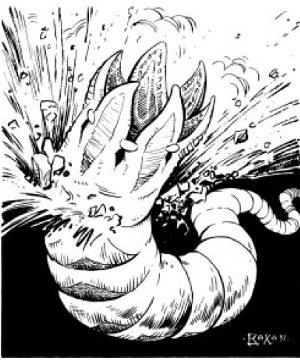
Sink Worm
A sink worm is huge white worm that travels beneath silt and sand, leaving a scarcely noticeable trail. Despite this clear warning sign, few prey escape once a sink worm begins hunting them.
Sink worms are solitary, meeting with others of their species to mate only once every three years. The hatchlings are left to fend for themselves, and most turn cannibal immediately, with the strongest few surviving to burrow away. Sink worms will try to eat nearly anything and need at least one man-sized victim per day.
The sink worm sucks sand and silt through its body, filtering minute particles of air past gills which allow the creature to breath under the silt or sand. It is this removal of air which causes the characteristic sunken depression in the surface of the sand or silt through which the sink worm passes.
Sinkworm "gills" are a curiosity among sages, so a sinkworm egg would be worth whatever the owner asked for it. However, the difficulty in locating the eggs makes this nearly impossible. Sink worms can stretch up to 32 feet long or more. A sink worm is pale white in color, resembling a huge maggot.
Sink WormCREATURE 13
3d10+15 piercing plus Improved Grab
1d10+13 bludgeoning
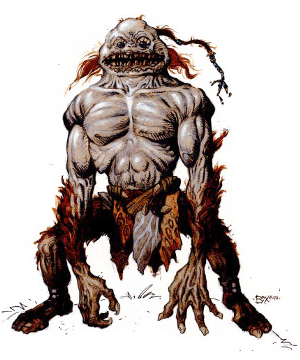
Slig
Sligs are wide-jawed humanoids that roam the desert wilderness. They are especially lean, because they cannot store fat in their bodies and are remarkably hairy. Sligs live in war bands, as the raiding and hunting lifestyle dominates their culture. They are crude craftsmen and often use items stolen from more advanced species.
Sporting a hunched posture, they have powerful arms that help with moving. Sligs dress in hides and animal skins, with different clothing denoting rank within the warband and ritual scarification marking excellence in combat and skill at the hunt.
Sligs have their own language, and some non-slig know it, but sligs usually do not take the time or the effort to learn another language. Sligs possess a natural telepathy that allows them to communicate essential information to one another regarding battle or the hunt. This telepathy is not sufficiently developed to communicate other concepts, however.
Sligs must eat more than other humanoid races; if they go without food for three days they die of starvation. Sligs also recycle body fluids better than other humanoids and therefore, only need 1/2 the water requirement of what a human would.
Male sligs are tall and muscular, standing seven feet tall and weighing more than 300 pounds. Female sligs are similar in appearance, but much smaller, standing about 5 feet tall. Their hair is always braided, and their skin color is light, usually white or tan.
Sligs are cunning and intelligent and have learned what most other races of the Tablelands desire: treasure, metal and food and water.
As a result, the wily sligs will often lay ambushes with just such items as bait. The lure can be as simple as a half-buried barrel or crate or as elaborate as the mock wreckage of an ambushed caravan, complete with slain animals and smoldering wagons. Those who are ambushed will be slain or sometimes even kidnapped by the sligs and held for ransom in the hope that others will fall prey to this new form of lure and come seeking their companions.
Unlike other races of the desert, sligs are sedentary and will make a permanent home from which they launch raids and hunts into the surrounding territory. Slig families are highly mutable, with the female producing young three times each year, fathered by whichever hunters are currently the most respected in the warband. The young mature rapidly and are full members of the warband within a year. To accomplish this growth, young sligs eat ravenously of the meals that are brought back to them, giving rise to the phrase ―sligging down one‘s meal.
SligCREATURE 1

Slime
Slimes are gelatinous creatures that rarely have a fixed shape. They are mostly subterranean, dwelling in caves and dungeons and feeding on refuse, carrion, or creatures unlucky enough to get in their way. Dagolar and Tyrian slimes are among the most recognizable slimes.
Taking cues from the natural world suggests some clever tactics. Jellyfish, for example, demonstrate a cohesive, almost hivemind-like symbiosis; they can sense their surroundings and gather in groups. Use this to make attacks from multiple directions or unexpected angles.
Dagolar Slime
Dagolar slimes are Tyrian slimes that have been psionically altered by the evil defiler/psion, Dagolar. Like most oozes, Dagolar slimes can move along walls and ceilings. Doing this allows them to drop on unsuspecting prey and envelop the head to get at the victim's brain, which is all that consists of the Dagolar slime's diet.
Dagolar slimes also reproduce in a similar way - upon enveloping the head of a victim; they do not consume the brain, but rather transplant it into a divided portion of the Dagolar slime's body. Only creatures with an especially active brain pattern (i.e., a psion) are unlucky enough to be such targets of a Dagolar slime's hideous brain transplant.
Dagolar SlimeCREATURE 3

Tyrian Slime
Tyrian slimes are like most other creatures of their kind. Their bodies consist of bluish-green amoeba-like cells that enable them to creep through cracks and crevices, and into the dark, damp subterranean locations. Tyrian slime, like most other oozes, is a solitary, asexual creature that reproduces by dividing its body and is usually encountered by wanderers with its own divided offspring.
Tyrian slimes can move along walls and ceilings, dissolving all sorts of carrion and refuse, thus often keeping the vicinity relatively clean. They attack nearly anything that they sense approaching, and one of their favorite tactics is to drop on unsuspecting prey.
Tyrian SlimeCREATURE 1
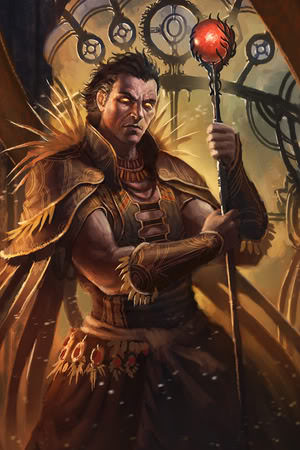
Sorcerer Monarch
The Sorcerer-monarchs are the immensely powerful tyrants of many of the city-states in the Tablelands.
Once, every city in Athas was led by a king or queen. They were the top of the social order. Often, they lived near the city in a fortified palace bustling with minor officials. When a potentate found it necessary to leave his or her palace, he or she did so only with a great deal of preparations and pomp, well-protected by magic and a full bodyguard retinue.
Almost without exception, every king or queen was a powerful Defiler who had risen to his or her position through the unprincipled use of magical and psionic abilities. Each have reigned for hundreds of years.
A Sorcerer Monarchs Lair
A sorcerer monarch lives within its palace in a city that sees it as a divine being. Everything about the sorcerer monarch’s lair and its surrounding city reflects its ego and keen mind, from the architecture to the servants. Often, the sorcerer monarch is surrounded by its most trusted agents, templars, who are granted magical powers from their patrons.
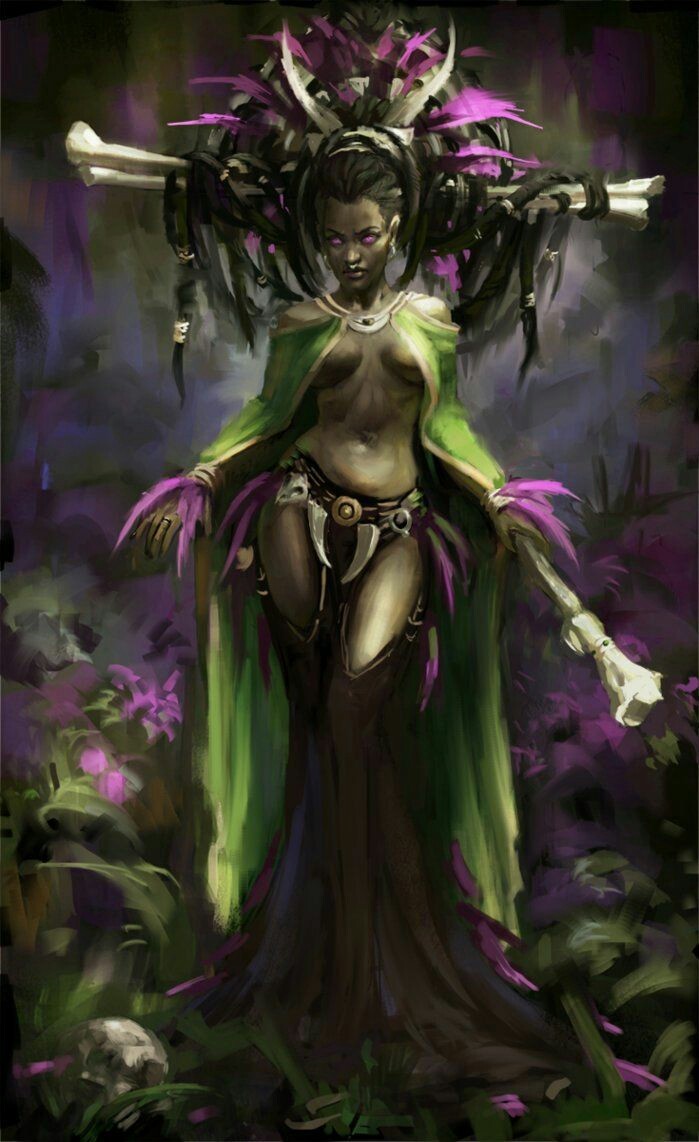
Sorcerer MonarchCREATURE 22
8d4+10 bludgeoning
4d6+10 slashing
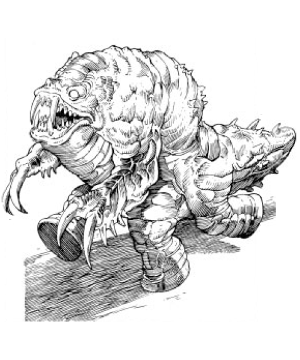
So-Ut
The so-ut, or rampagers, are fierce creatures that live only for the sake of destruction. They know no fear and hate the things of men, like weapons and buildings.
A rampager is a huge, six-legged creature with gray scales covering its whole body. These scales are unusually thick and almost impossible to cut through. The four rear legs are large round pads, while the two front legs have claws as long as daggers. The face is out of a nightmare, with long, dirty fangs and glowing red eyes. Its nose is like a vestigial horn, and they have small, rounded ears. Its hearing is poor, but its sense of smell is acute.
No one has ever been able to communicate with a so-ut. They are driven mad by the smell of manufactured items, particularly metal. The sight of a building also seems to enrage them. A so-ut always attacks the largest man-made object present. It attempts to destroy metal in preference to anything else.
Rampagers generally sleep during the heat of the day, and a bold adventurer can even walk across one without waking it. They live off their victims. After the so-ut has destroyed all man-made articles in sight, it usually settles down to feed off the bodies left in its wake.
A rampager’ s scales make excellent armor. A complete undamaged so-ut hide is worth as much as 100 silver pieces but must be cured by a leatherworker and then fashioned by an armorer.
So-Ut (rampager)CREATURE 12
3d10+13 piercing plus destructive strike
3d8+13 slashing plus rust
3d6+10 bludgeoning
Spider, Athasian
Credit: John Dollar
Crystal Spider
Resembling giant wolf spiders, crystal spiders have bodies composed of multifaceted crystal that creates dazzling patterns of refracted light. They spin glass webs that are very sharp and can focus a damaging beam of light at a potential victim.
The crystal spider is a beautiful creature. During the day the sunlight refracts through it, reflecting a myriad of colors which change as it moves. At night it reflects any ambient light, retaining its colors but not as radiant as during the day. When the spider has fed, it takes on a reddish tinge but this fades over a few days.
A crystal spider is incapable of making sounds but can communicate with others of its kind by means of controlled light.
Crystal spiders get most of their nutrients from sunlight but do require liquids to survive, preferring humanoid blood. They are hunted for their webs, which make excellent weapons, and for the gems which they instinctively weave into these webs (although the spiders are themselves unaware of their value).
A typical crystal spider is eight feet long and can live up to 150 years. Before death, a crystal spider will lay a single huge cluster of eggs (as many as 200) in a specially crafted web.
Crystal SpiderCREATURE 5
1d10+6 piercing plus crystal spider venom and Grab
2d6+6 bludgeoning
crystal web

Dark Spider
Dark spiders are an intelligent species of subterranean arachnid that lives in highly organized tribal units. Divided among warriors, psions, defilers and queens, they have no natural enemies but often create enemies through their predatory behavior when nesting young.
Dark spiders stand six feet in height and weigh 120 pounds, although their queens reach twice that size when mature. The more intelligent among them can master humanoid tongues, and some have been known to trade silk to merchant houses in return for warm-blooded slaves.
Dark Spider DefilerCREATURE 5
2d6+6 piercing plus dark spider venom
2d4+6 slashing
web trap

Dark Spider PsionCREATURE 5
2d6+6 piercing plus dark spider venom
2d4+6 slashing
web trap
Dark Spider QueenCREATURE 9
2d8+10 piercing plus dark spider venom
2d6+10 slashing
web trap
Dark Spider WarriorCREATURE 4
2d8+5 piercing plus dark spider venom
2d6+5 slashing
web trap
 Credit: Dopaprime
Credit: Dopaprime
Mountain Spider
Mountain spiders are intelligent creatures with a rudimentary tribal society believed to honeycomb many parts of the Athasian underdark. Cunning predators, they use their superior intellects to lay all manner of traps for the unwary. They are carnivorous and seem to consider roc meat a delicacy. Such meals are exceedingly rare for the mountain spiders.
Mountain spider venom is sought after by assassins, as it can be used as an ingredient in the creation of potions to remove paralysis – with the involvement of one skilled in such things, of course.
One mountain spider in ten is psionic. Many believe that the species is on the brink of developing psionic powers en masse, but for the time being these abilities are limited to a handful of exceptional individuals. These psychic arachnids soon rise to positions of power within the loose mountain spider society.
An adult mountain spider stands five feet tall on long, sturdy limbs and weighs as much as 200 pounds.
Mountain SpiderCREATURE 3
2d6+5 piercing plus mountain spider venom
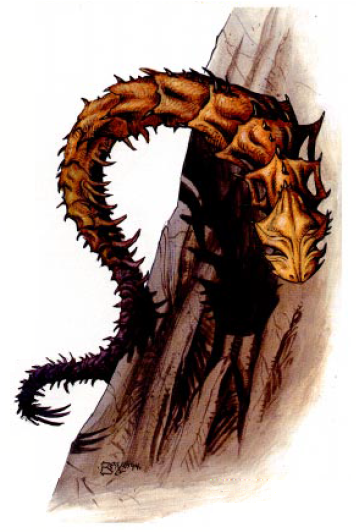
Spinewyrm
A relative of the silk wyrm, the spinewyrm is a psionic predator that hunts the unwary of the Tablelands. It uses its mastery of the Way to ambush its prey, crushing them to death or devouring them whole on the spot.
Spinewyrms are solitary, lairing in some secluded mountain peak, emerging to hunt and feed, and usually returning with a meal to devour at leisure. An adult spinewyrm is over 30 feet long.
Like the silk wyrm, the spinewyrm has a chitinous shell. The hard shell makes it difficult to damage these creatures. Bony plates run from head to tail. In addition to this shell, rows of cruel spikes adorn the plates. These spines impale a victim caught by the vice-like grip of the spinewyrm’s constriction. Though these serpents have no wings, they can fly because of a special organ unique to the wyrms of Athas.
SpinewyrmCREATURE 9
2d10+13 piercing plus Grab
2d10+13 slashing plus Grab
2d8+13 piercing
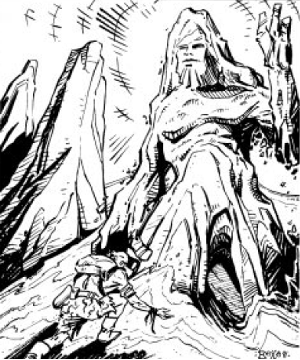
Spirit of the Land
A Spirit of the Land is a powerful being that inhabits the various geological features (mountains, hills, rock formations, hot springs, riverbeds, winds, skies, etc.) of Athas. They are virtually invulnerable, but they also have little direct contact with the world. They prefer to work through the druid who watches over the natural phenomena that they inhabit. Few except druids have ever seen or had any contact with a spirit.
Spirits of the land are almost never seen. On the extremely rare occasions when they do manifest, they appear as elemental beasts with the properties of their inhabited lands.
Spirits of the land communicate only with druids and clerics, although, if they wish, they can speak the language of any creature that inhabits their land feature.
Spirit of the LandCREATURE 20
4d8+20 spirit and elemental infusion
Squark
The squark is a millennia old monstrosity from Athas‘ past. None know whence it originally came or how old it truly is but is apparently wandered into the waters of what would become Athas‘ Last Sea some time before the Mindlords sealed that place off from the rest of the world. The creature‘s age, therefore, must be reckoned, at the very least, to be nearing ten thousand years.
Its body is that of a monstrous shark, with a great cluster of ten tentacles where the shark‘s rear fins and tail would be. Its jaws are filled with jagged teeth, and two of its tentacles, which are larger than the rest, are lined with wicked barbs.
The squark has no natural enemies (except, perhaps, the Mindlords), but it thankfully needs very little food to survive. Extremely intelligent, it prefers instead to roam the deeps of the Last Sea, pondering eon-old mysteries or slumbering in its subterranean lair, buried in the bedrock beneath the ocean floor.
The squark‘s body is just over 20 feet long, but its tentacles stretch out a further 60 feet. It weighs 200 tons. The creature is a bloody crimson from tentacle tip to snout, save for its pinkish suckers and black eyes.
The squark’s Lair
The squark lives in dark depths of the last sea. Its cavernous lair is flooded and buried in Marnita's bedrock.
SquarkCREATURE 21
4d8+24 bludgeoning plus Grab
4d6+24 bludgeoning plus Grab
4d10+24 piercing plus Grab
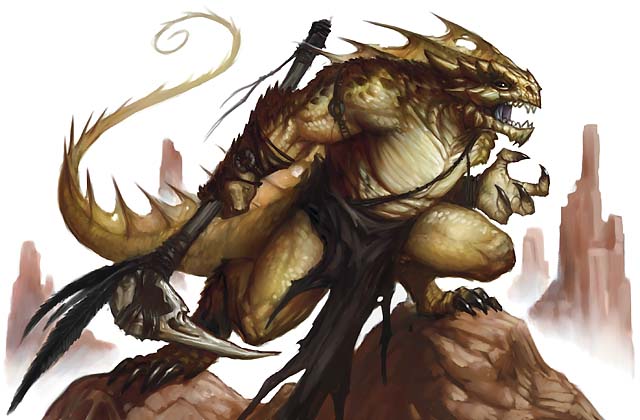
Ssurran
Ssurrans are nomadic, humanoid reptiles. Some are raiders while others are simple hunters. As lizard men of the desert, they have adapted to the heat of the Athasian day and are active even during the blazing mid-day heat.
Ssurrans roam Athas, seeking shelter and food. There have been cases when multiple tribes have joined together against a common threat. These multitribal groups are led by a council of elders formed from the shaman/leaders of each tribe. Ssurrans are strict carnivores. They prefer the flesh of halflings, but prey upon any living thing they find. Ssurrans are nomadic creatures, and they generally stay in one area for only a few weeks before moving on.
Ssurrans have few natural enemies, but many acquired ones. They prey on human, demihumans and humanoid settlements whenever possible. If they capture many these creatures, ssurrans hold a great feast and sacrifice the rest to their obscure gods Ssurran eggs are inedible, as is their flesh, but their skin is sometimes worked as scale armor.
SsurranCREATURE 1
Ssurran LeaderCREATURE 5
2d6+5 piercing
Ssurran ShamanCREATURE 2
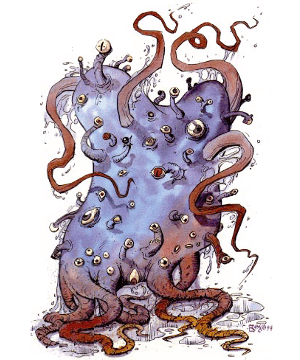
Stalking Horror
The stalking horror, also known as the moonbeast, is one of the most feared creatures on Athas. Few have seen one and survived to describe it. Those who escape are usually so addlebrained that their words make little sense. The only reported sightings are on clear Athasian nights when the moons are in a specific alignment. The stalking horror is believed to be the result of some ancient summoning.
The moonbeast has a large octopoid body with at least 10 tentacles. Within the circle of tentacles lies its tooth-filled maw. Some witnesses report at least three rows of needle-sharp fangs inside. Its bulbous body is covered with 36 eye stalks, each a foot long. They give the beast 360-degree vision. It can retract the stalks to protect its eyes as it oozes through tight spaces.
The tentacles are lined with hooks that it uses to grip and rend. They provide the primary means of locomotion for the beast. It reaches ahead with several tentacles and pulls its bulbous body behind it.
Its skin is a mottled gray and is covered with a slimy secretion. Both the slime and its amorphous body allow the beast to pull itself through openings as small as a human-sized doorway. Its tentacles, which can be up to 20 feet long, have the strength to tear apart buildings.
Stalking Horror (moonbeast)CREATURE 17
3d12+18 piercing plus consume memories
3d10+18 bludgeoning plus Grab and thoughtlance
 Credit: Kekai kotaki
Credit: Kekai kotaki
Styr
Styrs are summoned creatures from the elemental plane of earth, resembling a four-faced statue with four arms and legs that make them almost impossible to surprise. Conjurers sometimes summon a styr to watch over treasure chambers, as they are tireless and relentless, and need no food or sleep, making them exceptionally good guardians.
StyrCREATURE 10
2d10+13 bludgeoning
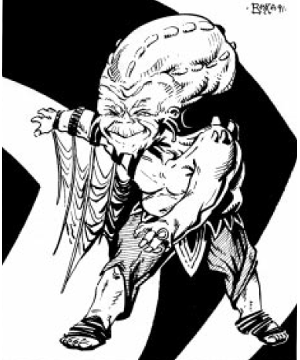
T'Chowb
The t'chowb is a deadly creature that delights in draining the intelligence from its victims. It ordinarily dresses in loose brown robes or leggings. T'chowbs are solitary creatures, deriving their only satisfaction from the sensations that come when they drain the intelligence of their prey. A sated t'chowb is a genius and uses its newfound intelligence in whatever manner best suits it.
T‘chowbs do not possess their own language but instead use the languages of those upon whom they prey. T'chowbs can be found anywhere intelligent beings gather.
T'ChowbCREATURE 5
2d4+6 bludgeoning
A victim's stupefied condition value decreases by 1 every week.
A victim that becomes stupefied 5 in this way is rendered comatose, becoming permanently unconscious.
As long as the t'chowb lives, a comatose victim can't regain consciousness, and its stupefied condition doesn't decrease.
 Credit: BenWooten
Credit: BenWooten
Tarek
Tareks are big, musclebound, hairless bipeds standing over 6 feet tall that inhabit the hilly and mountainous areas of Athas. They have square, big-boned heads with sloping foreheads and massive brow ridges. Their flat noses have flared nostrils, and their domed muzzles are full of sharp teeth. Their powerful arms are so long that their knuckles drag along the ground. Tareks have a distinct musky odor and move with jerky, awkward strides except when in combat, when they change to a graceful dance-like form. They are among the most popular combatants in the arena and are often paired with a mate.
Tareks speak their own language filled with harsh and guttural words. They are violent and aggressive and place immense value and honor in physical prowess. Tareks gather in tribes that often sustain themselves by raiding, and they are treacherous trading partners. They are constantly at war with the gith.
They disdain armor and manufacture their own weapons: the handfork (a slicing and parrying tool) and the heartpick (a bone hammer with a serrated pick on the front and a heavy flat head on the back).
Tareks hate wizardly magic in all its forms and will out of their way to destroy any caster. This hatred translates into a strong dislike for elves who often deal in the business of spell components, and they often attack elves automatically assuming dark magic follows. Earth clerics are respected as the tarek consider themselves born of the earth and hills. “Solid is the tarek, strong like the earth, and numerous as the soil,” sing the earth clerics of the tarek tribes.
TarekCREATURE 1
1d8+4 piercing
Tarek Earth Shaman
Tarek shamans are always elemental earth clerics. Tarek shamans serve as advisers to tribal chiefs and leaders, direct the spiritual life of their tribes, teach tribal legends and traditions, and act as medicine men for their communities. They also direct the rituals and ceremonies that make up much of the tribal lifestyle.
Tarek ShamanCREATURE 1
Tarek War Leader
Tarek's are led in battle by a War Chief.
Tarek War LeaderCREATURE 2
1d8+4 piercing
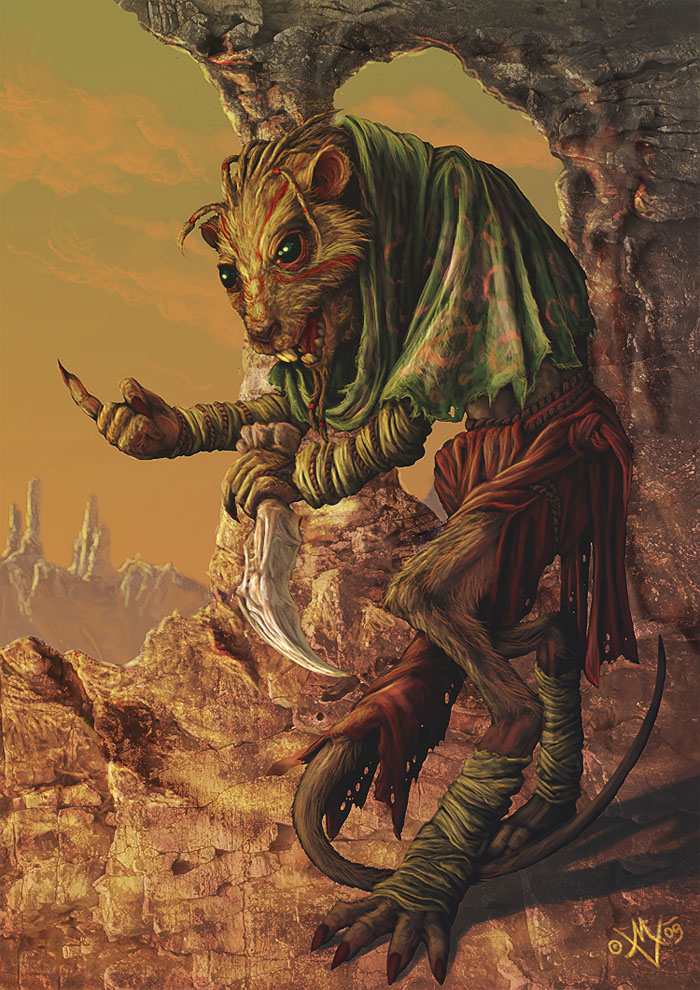 Credit: Gandhi
Credit: Gandhi
Tari
The tari are commonly referred to as rat men by the other denizens of the Tyr region. They are small, furry humanoid scavengers, capable of thriving on food and water too polluted for humans to ingest. Hunted freely as pests, the tari are the barbaric descendants of a once thriving culture who inhabited lands to the south of the Tyr region. The tari are unimpressive creatures, roughly 5 feet tall and weighing 100 pounds. They move about as bipeds, but sometimes walk on their knuckles. Tari wear no clothing, though warriors sometimes have leather jerkins or even chitin greaves.
Tari have a high-pitched, squeaky language all their own. They can send and receive some signals that are beyond the human ear’s ability to hear. Natural cowards, they rarely attack without numbers.
The tari race once boasted a thriving culture far to the south of the Tvr region. Ythri, the legendary capital city, is now a ruin lost among the crags. Their education and knowledge were much greater than today, and their technology allowed them to build stone and concrete structures. What happened to their civilization is a mystery. The tari of the Tyr region have no written history. What remains is a collection of exaggerated myths and legends describing wondrous works.
TariCREATURE 1
1d4+2 piercing
1d4+2 piercing
1d8 piercing
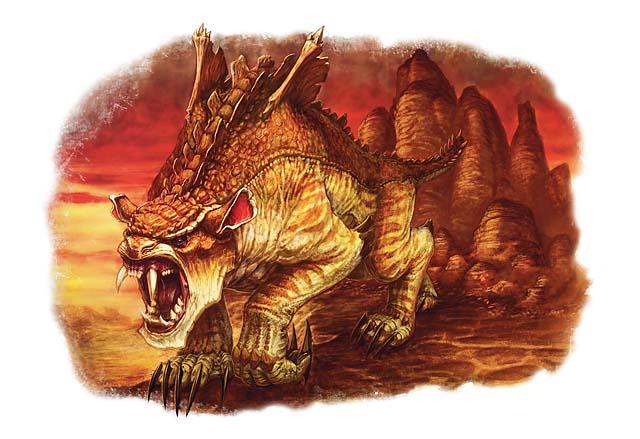
Tembo
This creature resembles a large, hairless canine. Its four-foot-long body is covered in loose folds of light brown, scaly hide. All four legs end in razor-sharp claws, and large canines protrude from its upper jaw.
The tembo is a savage predator that will eat anything, but it prefers the children of sentient races. Tembos base themselves in a lair or den and hunt in packs throughout the surrounding wilderness. They have also been known to inhabit the ruins that lie beneath many of the large cities of the Tablelands.
In addition to their physical speed and Strength, tembos also boast psionic powers and the ability to drain the life energy of their victims. Few are those souls that can brave and endure a den of tembos.
TemboCREATURE 4
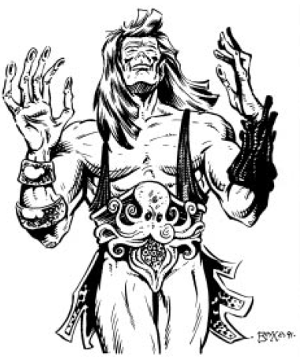
Thrax
Victims of an ancient curse, thrax are wretched creatures that can only survive by draining water from the bodies of others, leaving them desiccated corpses. A thrax’ s appearance is quite different than what it was before "the change." Its hair darkens and its skin takes on a ruddy tinge. Its facial features develop a gaunt, angular cast and its eyes become a deep blue. The most striking change is in its hands. Each of the thrax’ s fingers grow a circular "sucker" through which it drains water from its victims.
Thrax prefer to attack creatures traveling alone. They sneak up as close as possible before attacking. If their target is part of a group, they will try and isolate the creature with stealth and their psionic powers before attacking.
ThraxCREATURE 5
2d6+8 bludgeoning plus Grab
A victim's drained condition decreases by 1 per week. A blood transfusion, which requires a successful DC 20 Medicine check and sufficient blood or a blood donor, reduces the drained value by 1 after 10 minutes.
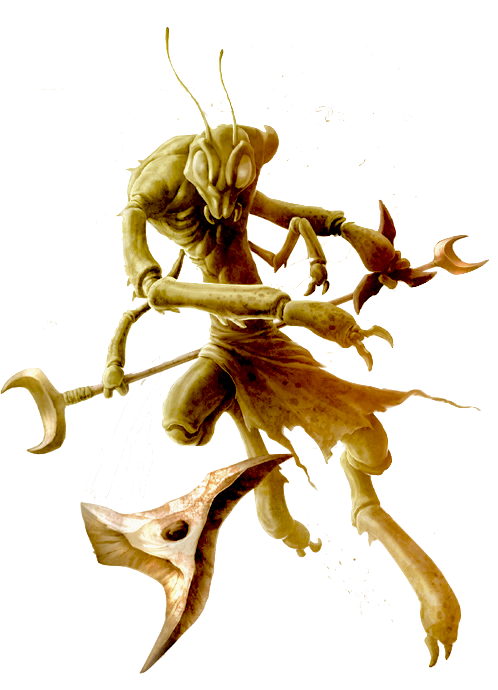
Thri-Kreen
Thri-kreen are large insectoids —the least “human” of all the intelligent races of Athas. Standing 7 feet tall at the shoulder and growing about 11 feet long from end to end, they have six limbs, sandy-yellow exoskeletons, and large, multifaceted eyes. The two hindmost limbs are designed for walking and leaping, while the four forward limbs end in extremely dexterous hands.
In the Tyr Region, thri-kreen aren’t common in the city-states. They gather in packs devoted to the hunt that roam the wastes and have little understanding of human society. If encountered in a city, a thri-kreen is either a slave or attached to a group of adventurers (whom the thri-kreen has adopted as his pack). As slaves, thri-kreen are used on the farms or as laborers, though some make it to the gladiatorial pens to offer a different kind of entertainment to the crowds.
Many things make the thri-kreen strange and alien to those of the other races, not the least of which is their appearance. Add to that the fact that thri-kreen don’t sleep, that they don’t collect wealth or possessions, and that they sometimes eat other intelligent creatures, and the differences between humans and thri-kreen seem vast and imposing. When thri-kreen join up with a group consisting of members of other races, they seek to establish dominance as they do in their own packs.
Once the matter is settled, they abide by the outcome, though party members who aren’t prepared for such behavior often experience moments of genuine terror as the hulking insect-men make menacing threats to dominate the group, or “clutch.” Is it any wonder that most people fear the thri-kreen, or that they are viewed as treacherous and unreliable?
However, those who have won the trust and friendship of a thri-kreen wind up with a friend for life. The pack mentality is so ingrained in thri-kreen culture that they apply it to every situation they find themselves in. As they would in an all-thri-kreen pack, they leap to protect their clutchmates (regardless of race) whenever danger strikes, no matter the risk to themselves. The thri-kreen of the Tyr Region employ a few exotic weapons, most notably the gythka and the chatkcha. A gythka is a polearm with blades on both ends. A chatkcha is a crystalline throwing wedge. When not hunting or gathering food and water, thri-kreen spend their time making or repairing their weapons.
Thri-KreenCREATURE 1
1d6+2 piercing plus thri-kreen venom
1d4+2 slashing
1d8+2 slashing
1d4+2 slashing
Thri-kreen Clutch Leader
The word of a clutch leader is obeyed without question or fail. Yet, the leader does not issue orders without thought, and any clutchmate can become clutchleader if powerful enough.
Thri-Kreen Clutch LeaderCREATURE 3
1d6+4 piercing plus thri-kreen venom
1d4+4 slashing
1d8+4 slashing
1d4+4 slashing
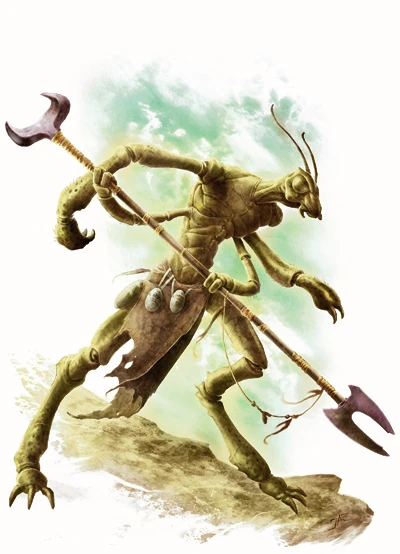
Thri-kreen Psychic Warrior
Psychic warriors strengthen their minds and bodies in equal accord, charging into the fray to deliver psionically charged blows.
Thri-Kreen Psychic WarriorCREATURE 3
1d6+4 piercing plus thri-kreen venom
1d4+4 slashing
1d8+4 slashing
1d4+4 slashing
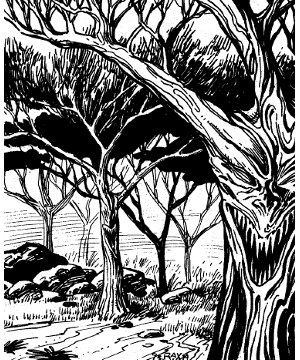
Treant, Athasian
Athasian treants are magical creatures, a mystic blending of the characteristics of a tree of life and a spirit of the land. They are virtually immortal, and act as incarnate guardians of the wilderness for which they were created. Often, they are dedicated to caring for groves of trees of life. Athasian treants are almost indistinguishable from trees. Their skin is bark, their arms are tree branches, and their facial features look like the knots on the trunk of the tree.
Athasian TreantCREATURE 8
2d10+7 bludgeoning
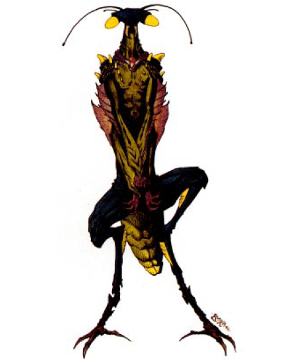
Trin
The trin are the largest of the kreen species, and the most monstrous in terms of appearance and psychology. They have the claws of a mantis, and they use them as mantises do, gripping prey in a deadly embrace. Their venom extends from numbing the muscles to causing total paralysis, and many who are caught in a trin’s clutches do not survive to escape. They are nomadic carnivores that travel in packs and coordinate their hunting to take down impressive prey. Trin are cannibalistic, devouring members of other packs if they are wounded or vulnerable. Many trin prefer the meat of thri-kreen and tohr-kreen above other foods if they can get it. As such, they are considered a menace by kreen societies, having a cultural role like that of gith for humans.
Trin have a rudimentary telepathy, capable of conveying moods and images better than complex concepts. They speak Kreen, but with poor grammar and coarse inflection in the eyes of the tohr-kreen. Occasionally a lone trin may be adopted by a thri-kreen clan, but they are often mistrusted and viewed more as a pet than a peer.
TrinCREATURE 4
2d8+5 piercing plus trin venom
2d6+5 piercing plus Grab
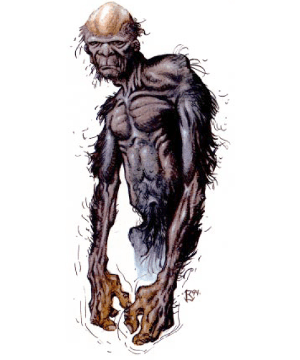
Tul'k
Tul‘ks are primitive, psionic humanoids that roam the mountains and hills of Athas, eking out a living where they can. Timid and withdrawn, tul‘ks rarely come into conflict with other races but make cunning foes when this does occur. Tul‘k society is tribal, and their language is basic, consisting largely of grunts, growls and hand gestures. Hand signals are generally used in battle.
The tale of the tul‘ks is a sad one, for although they appear as and live the lives of primitive humanoids, they were not always thus. Once, the tul‘ks were elves of the Dune Stalker tribe, famed throughout the eastern Tablelands. The strange powers of the mysterious Pristine Tower altered the tribe in the distant past, however, transforming them into tul‘ks. Now the degenerate remains of the Dune Stalkers make their homes where they can yet be still tormented by the vestigial memories of the people that they once were. The largest and strongest males dominate Tul‘k society – offspring of males other than the dominant one is exiled from the clan when they reach maturity (unless they can challenge the dominant male and steal his place). In general, tul‘ks are reclusive, even timid, and will only attack other humanoids in order to gain food. Amongst a tul‘k‘s favorite foods are z‘tal, erdlu and Athasian rocs.
Tul'kCREATURE 2
1d8+4 bludgeoning
1d10+4 bludgeoning plus Knockdown
1d6+4 bludgeoning
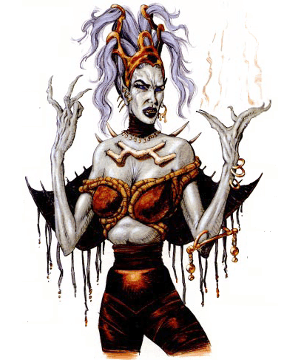
T'liz
T’liz are undead defilers whose spirits have outlived their bodies. They are extremely powerful undead who seek magical knowledge and power above all else and exist as such to continue their study of magic. They seldom associate with the living except when mortals provide suitable pawns. Because they appear much as they did in life, t’liz can move freely among the living. Their only unusual features are their skin, which is extremely pale, and their weight, which often diminishes until they become no greater than average in build. T’liz must anoint themselves with numerous oils and substances that prevent their bodies from deteriorating. They must also feast upon the life energy of the living to sustain their own energies.
T’liz may be detected in several ways. They cast no reflection or shadow and they move in complete silence. Often, t’liz have large numbers of undead serving them as minions. These minions protect their lairs, bring them living victims for their experiments, and provide them with the equipment they need for their studies.
T’liz hate other t’liz as much, if not more, than they hate the living. Viewing their own kind as rivals, they are known to engage in century-long disputes. Either out of boredom or to annoy other t’liz, they often pit their undead minions against the undead minions of other t’liz.
T’liz are known for their scheming nature. While they occasionally have dealings with the living, they do so only to further some nefarious plan of their own. They are said to dabble in politics and trade, but only if they can make their unseen presence felt as hardship upon the living.
A T’liz’ s Lair
A t'liz often haunts the abode it favored in life, such as a lonely tower, a haunted ruin, or an academy of black magic.
Alternatively, some t'liz construct secret tombs filled with powerful guardians and traps.
Everything about a t’liz’ s lair reflects its keen mind and wicked cunning, including the magic and mundane traps that secure it. Undead, constructs, and bound demons lurk in shadowy recesses, emerging to destroy those who dare to disturb the t’liz’ s work.
T'lizCREATURE 16
3d4+6 bludgeoning
5d8 void plus drain life
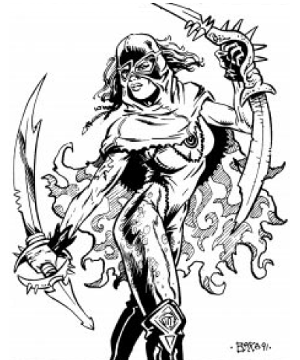
Villichi
Villichi are a subrace of humans possessing inborn psionic talents. They are a mutation born to normal human parents which possess fully matured psionic ability at birth. No one can predict when or where a villichi child will be born.
All villichi are female and stand nearly as tall as elves, with long limbs and faces. While they appear thin (mostly due to their height), they have normal proportions for human women. Villichi are very fair skinned, and usually wear a hooded cloak to protect their vulnerable skin. It is not uncommon for them to bear psionic tattoos.
Because of the difficulty raising an inexperienced child with potent psionic abilities, they are often shunned by normal humans, although it is considered a bad omen to turn out a villichi child. When they come of age they usually move to a convent of their kind, located somewhere in the Ringing Mountains. Villichi are strong psions, and consequently, are a powerful group. Encounters with villichi are usually with an envoy, one sent to deal with a trading company or village.
VillichiCREATURE 3
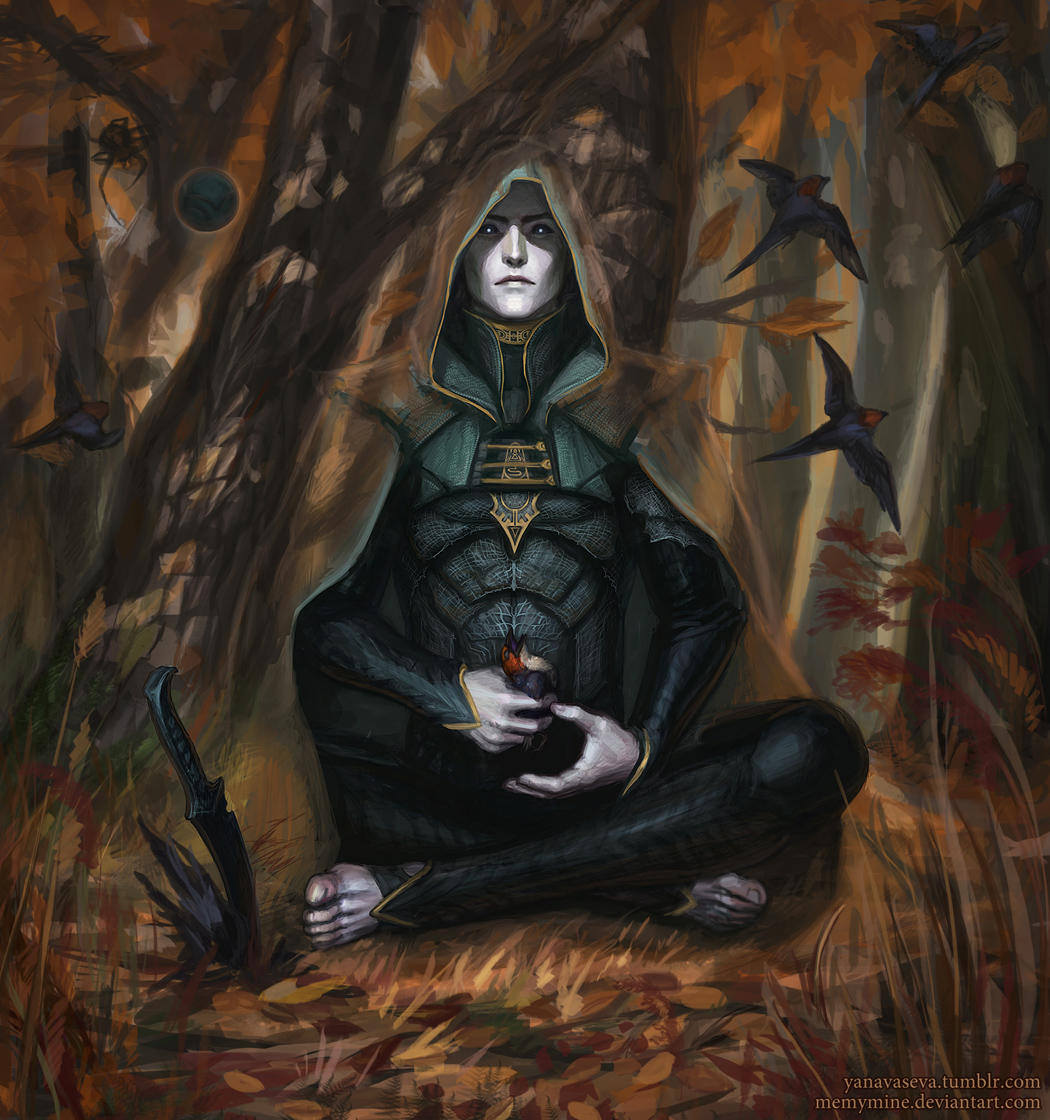
Villichi Envoy
The villichi roam widely throughout the world, for anywhere that humans live, a villichi child may be born. Envoys are sent to deal with a merchant house or village. They are also sent to retrieve a villichi child once it has come of age.
Villichi EnvoyCREATURE 7

Wall Walker
Wall walkers are an intelligent strain of psionic arachnids that roam the Athasian underdark, preying on those that they encounter with stealth and cunning. Instead of chitin, they have armored scales, eight clawed limbs, vicious fangs and a sharp stinger at the tip of their abdomen.
Wall walkers communicate by rubbing their limbs together, creating an eerie chorus of hums and whines that echo throughout the subterranean tunnels around the creatures‘ hives. They are often hunted for their hide, which can be made into armor and weaponry and is a favored commodity amongst the dray of Kragmorta.
Wall walkers are usually on the move as part of a life of continual hunting, but for reasons yet unknown they occasionally gather together in hives. Possibly related to their breeding cycle, the hives are fiercely defended and can grow to become a genuine menace to other races over time. Kalin are frequent foes of the wall walkers, as both species occupy the same niche in the underdark.
An adult wall walker is five feet across and weighs 120 pounds.
Wall WalkerCREATURE 3
1d12+5 piercing
1d10+5 slashing
1d6+5 piercing plus wall walker venom

Wraith, Athasian
An Athasian wraith is a noncorporeal undead capable of moving freely between the Gray and the land of the living. It can possess unliving objects of all sorts, ranging from weapons to furniture to corpses, as well as unintelligent creatures such as scorpions, insects, or slimes. Outside its host object, an Athasian wraith is barely visible, appearing only as a gray shade or a mass of churning darkness. Its form resembles its living body, but it can also assume a mist-like appearance. No matter what form a wraith takes, it can always be spotted by its glowing eyes, which range from a bright purple to blood red.
Wraiths who take human corpses as hosts fill out the dead flesh with their own misty form. When a section of the host is cut away, the same part of the wraith becomes visible. For instance, if an Athasian wraith possessed a corpse and the host’s right arm were chopped off, the wraith’s right.
Athasian WraithCREATURE 6
2d8+5 void plus drain life
This possession ends when the object is destroyed or the wraith leaves it. At this point, the wraith reappears in the object's square and can't Inhabit an Object again for 1d4 rounds.
Zik-trin
Zik-trin are a race bred by the zik-chil for loyalty and combat prowess. They are not a natural species, but rather are created from tohr-kreen or thri-kreen by the zik-chil in a deeply secretive and complicated ritual. Once the process is complete, the kreen is permanently changed into a zik-trin, and all memories of its former life are gone forever. Zik-trin faithfully serve the Priests of Change, the zik-chil, and obey only their orders. They are not automatons and can think and even speech (though they rarely choose to speak). It is simply that they are wholly loyal to their creators and live solely to serve them.
Zik-trin measure several feet taller and longer than the average thri-kreen and weigh proportionately more.
Zik-trin speak Thri-kreen, on the rare occasions they choose to do so.
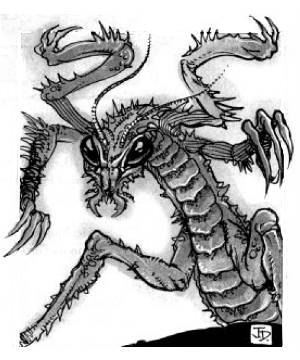
Zik-trin'ak
Zik-trin‘ak are the elite guards, scouts, and soldiers of the Tohr-Kreen Empire. Zik-trin’ak are merciless and fearless in combat. They follow the orders of their masters and will never retreat unless ordered to. Generally, they prefer to ambush opponents, attacking them from afar before closing into melee.
Zik-trin'akCREATURE 5
2d8+7 piercing plus zik-trin venom
2d4+7 piercing
2d6+7 slashing
1d6+7 slashing

Zik-trin'ta
Zik-trin‘ta are covert scouts and secret operatives in service to the Tohr-Kreen Empire. They have been given a high degree of intellectual sophistication by their creators and display philosophical and pacifistic tendencies. This behavior is programmed by the zik-chil, who have sent the zik-trin‘ta into the Tablelands to act as observers and spies. Often regarded with awe by other kreen, zik-trin‘ta are seen as wise and noble philosophers by thri-kreen. This allows the zik-trin‘ta to gather much information and exert influence in the interests of the Empire, all in preparation for the plans of their pale priests. Zik-trin‘ta often amass lore and artifacts before returning to their homes in the Empire.
Zik-trin'taCREATURE 3
1d8+6 piercing plus zik-trin'ta venom
1d8+6 slashing
1d6+6 slashing
Zombie
Undead zombies move with a jerky, uneven gait. They are clad in the moldering apparel they wore when put to rest and carry the stench of decay.
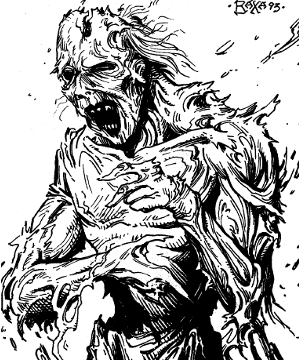 Credit: WillOBrien
Credit: WillOBrien
Salt Zombie
A shrunken, shriveled husk, this zombie has eyes set deep in its skull and dry, cracked lips. Its massive claws seem able to rend the flesh from a giant.
The salt zombie is the result of a humanoid creature dying of thirst on the Great Ivory Plain or other salt flats. They possess great hatred for the living and roam the salt flats in search of water to quench their eternal thirst.
Salt zombies appear as shriveled husks, almost like mummies, though their hands have grown to enormous claws in undeath. These semi-intelligent zombies have sunken eyes, cracked lips, and piercing fangs.
Salt ZombieCREATURE 1

Thinking Zombie
A thinking zombie is a creature who has died, and its spirit cannot rest until it has completed the task. The body remains animate, and the zombie is semi-free willed, bound only by its dedication to completing its assigned duties.
Thinking zombies are easy to identify because their bodies are usually in exceptionally good condition since they reanimated shortly after death. Their eyes burn with a spark of hate for all living things and a consuming desire to complete their task and achieve final rest. Most thinking zombies are giants or half-giants as those creatures are often subject to the geas spell that creates them. They usually wear the same clothes they had in life and carry the same weapons. Any wounds they had on their body in death would betray their undead nature, as the flesh of thinking zombies does not heal even if they regain lost hit points. Those who travel freely in the day often begin to stink like rotting corpses, so most prefer to move about at night.
Thinking ZombieCREATURE 3
1d6+4 bludgeoning plus Grab
Creatures by Type

-
Aberrations
- 78Cistern Fiend
- 139Gaj
- 167Kalin
- 182Pakubrazi
- 226Sharg
- 227Silk Wyrm
- 228Silt Horror, Black
- 229Silt Horror, Brown
- 230Silt Horror, Gray
- 231Silt Horror, Magma
- 232Silt Horror, Red
- 233Silt Horror, White
- 235Silt Spawn
- 243So-Ut
- 245Spider Defiler, Dark
- 246Spider Psion, Dark
- 247Spider Queen, Dark
- 247Spider Warrior, Dark
- 251Squark
- 254Stalking Horror
- 260Tembo
-
Animals
-
- 16Conashellae
- 16Critic
- 17Crodlu
- 17Crodlu, Heavy
- 18Drik
- 19Dune Crab
- 19Dust Glider
- 19Dustgull
- 20Erdland
- 20Erdlu
- 21Giant Beetle, Bombardier
- 21Giant Beetle, Boring
- 21Giant Beetle, Rhinoceros
- 22Gorak
- 23Hatori, Lesser
- 23Hatori, Greater
- 24Hyena, Spotted
- 24Hyenadon
- 25Hurrum
- 25Inix
- 26Jankx
- 26Jhakar
- 167Kalin
- 27Kank, Soldier
- 27Kank, Worker
- 29Kes'trekel
- 29Kes'trekel Blood Flock
- 30Kip
- 31Kivit
- 32Kluzd
- 33Korinth
- 34Lirr
- 35Lizard, Jastrak
- 35Lizard, Minotaur
- 36Mastyrial, Desert
- 37Mekillot
- 38Mole Boar
- 38Raakle
- 39Ramphor
- 39Rasclinn
-
- 40Rhynox
- 40Rocktopus
- 41Rubbish Slug
- 41Sandcrawler
- 42Sand Howler
- 43Sand Shark
- 44Scorpion, Barbed
- 44Scorpion, Gold
- 45Silt Eel
- 46Silt Spider Swarm
- 46Sitak
- 47Slimahacc
- 48Sloth, Athasian
- 48Strine
- 49Sygra
- 13Takis
- 51Warthog
- 51Warthog, Giant
- 52Watroach (War Beetle)
- 53Weezer, Brood Queen
- 53Weezer, Soldier
- 53Weezer, Worker
- 54Wrab
- 56Z'tal
-
Beasts
-
Beasts
-
Celestial
-
Constructs
-
Dragons
-
-
Elementals
-
-
Giants
-
Humanoids
-
Humanoids
- 94Dray
- 95Dray Soldier
- 95Dray Templar
- 98Drik, High
- 100Dune Freak (Anakore)
- 103Dwarf, Athasian
- 104Dwarven Senior Guard
- 104Dwarven Sun Cleric
- 132Elf Warrior
- 133Elf Defiler
- 133Elven Raid Leader
- 140Giant, Beasthead
- 141Giant, Desert/Plains
- 144Gith
- 145Gith Defiler
- 145Gith Tribe Leader
- 156Half-Elf Druid
- 156Half-Elf Hunter
- 158Half-Giant Captain
- 158Half-Giant Guard
- 160Halfling Rain Cleric
- 161Halfling Skirmisher
- 161Hej-Kin
- 162Hej-Kin Priest
- 162Hej-Kin Wizard
- 164Jozhal
- 174Mountain Stalker
- 176Mul Barbarian
- 177Mul Gladiator
- 178Mul Slave
- 178Nikaal Warrior
- 201Pterran Druid
- 202Pterran Psion
- 202Pterran Warrior
- 207Pyreen
- 208Reggelid
- 212Ruvoka
- 223Scrab
- 224Scrab Nest Mother
- 234Silt Runner
- 238Slig
-
-
Kreen
-
Mutant
-
Oozes
-
Plants
-
-
Swarm
-
Shadow
-
Undead
Creatures by Level

-
Level -1
-
Level 0
-
Level 1
-
- 72Cactus, Hunting
- 74Cactus, Sand
- 81Dagorran
- 186Despairing Pall
- 82Dhaot
- 94Dray
- 100Dune Freak
- 19Dust Glider
- 104Dwarven Sun Cleric
- 132Elf Warrior
- 20Erdlu
- 160Halfling Skirmisher
- 161Hej-Kin Priest
- 162Hej-Kin Wizard
- 24Hyena, Spotted
- 164Jozhal
- 27Kank, Worker
- 32Kluzd
- 169Kragling, Fire
- 169Kragling, Silt
- 184Lava Otter
- 38Mole Boar
- 40Rocktopus
- 41Rubbish Slug
- 219Scamp, Air
- 219Scamp, Earth
- 220Scamp, Fire
- 220Scamp, Magma
- 221Scamp, Rain
- 221Scamp, Silt
- 222Scamp, Sun
- 222Scamp, Water
- 223Scrab
- 44Scorpion, Gold
- 45Silt Eel
- 46Silt Spider Swarm
- 238Slig
- 252Ssurran
- 257Tarek
- 258Tarek Shaman
- 259Tari
- 262Thri-Kreen
- 240Tyrian Slime
-
-
Level 2
- 57Aarakocra
- 7Antloid, Soldier
- 9Aprig Boar
- 195Bloodvine
- 66Bog Wader
- 75Cactus, Spider
- 15Carru, Bull
- 17Crodlu
- 95Dray Soldier
- 95Dray Templar
- 19Dune Crab
- 133Elf Defiler
- 20Erdland
- 21Giant Beetle, Boring
- 145Gith Defiler
- 156Half-Elf Druid
- 160Halfling Rain Cleric
- 23Hatori, Lesser
- 27Kank, Soldier
- 178Nikaal Warrior
- 188Olobigonde
- 198Poisonweed
- 201Pterran Druid
- 202Pterran Warrior
- 203Pterrax
- 207Razorwing
- 211Ruve
- 253Ssurran Shaman
- 192Sun Fox
- 49Tagster
- 258Tarek War Leader
- 266Tul'K
- 51Warthog
- 53Weezer, Soldier
-
Level 3
- 58Aarakocra Shaman
- 8Antloid, Dynamis
- 10Baazrag Boneclaw
- 65Belgoi
- 225Brain Seed
- 68Burnflower
- 69Bvanen
- 76Cha'Thrang
- 77Cilops
- 239Dagolar Slime
- 197Dew Frond
- 102Dune Runner
- 71Elven Rope
- 25Hyenadon
- 167Kalin
- 29Kes'Trekel Blood Flock
- 34Lirr
- 248Mountain Spider
- 38Raakle
- 42Sand Howler
- 228Silt Horror, Black
- 199Strangling Vine
- 48Strine
- 13Takis
- 263Thri-Kreen Psychic Warrior
- 268Villichi
- 270Wall Walker
- 53Weezer, Brood Queen
- 273Zik-Trin'Ta
- 275Zombie, Thinking
-
Level 4
-
-
Level 5
- 194Bloodgrass
- 245Dark Spider Defiler
- 246Dark Spider Psion
- 101Dune Reaper Drone
- 133Elven Raid Leader
- 124Jaathoom
- 30Kirre
- 35Lizard, Minotaur
- 174Mountain Stalker
- 175Mud Fiend
- 177Mul Gladiator
- 128Quorrashi
- 206Raaig
- 189Sand Wolf
- 44Scorpion, Barbed
- 237Silk Wyrm
- 232Silt Horror, Red
- 48Sloth, Athasian
- 244Spider, Crystal
- 252Ssurran Leader
- 256T'Chowb
- 261Thrax
- 272Zik-Trin'Ak
-
Level 6
-
-
Level 7
-
Level 8
-
Level 9
-
Level 10
-
Level 10
-
Level 11
-
Level 12
-
Level 13
-
Level 14
-
Level 15
-
Level 16
-
Level 17
-
Level 18
-
Level 19
-
Level 20
-
Level 21
-
Level 22
-
Level 24
-
Level 25
Creatures By Environment

Aquatic Creatures
| Level | Creatures |
|---|---|
| 1 | Electric Eel, Water Scamp |
| 3 | Brine Shark, Piranha Swarm |
| 5 | Living Waterfall |
| 7 | Quatoid |
| 8 | Coldmire Pond |
| 13 | Cistern Fiend |
| 15 | Water Drake |
| 17 | Rain Drake |
Forest Creatures
| Level | Creatures |
|---|---|
| -1 | Aprig, Athasian Dwarf, Kip |
| 0 | Giant Bombardier Beetle, Mul Slave |
| 1/2 | Elf Warrior, Pterran Warrior |
| 1 | Agony Beetle, Dhaot, Halfling Skirmisher, Mole Boar |
| 2 | Aprig Boar, Giant Boring Beetle, Half-Elf Druid, Halfling Rain Cleric, Poisonweed, Pterran Druid, Pterran Warrior, Pterrax, Tagster, Warthog |
| 3 | Brain Seed, Dew Frond, Lirr, Strangling Vine, Strine, Villichi |
| 4 | Blossomkiller, Fordorran, Giant Rhinoceros Beetle, Giant Warthog, Half-Elf Hunter, Half-Giant Guard, Id Fiend, Mist Stalker, Pterran Psychic, Tembo, Tigone |
| 5 | Athasian Sloth, Bloodgrass, Crystal Spider, Kirre, Mul Gladiator, Raaig, T'Chowb |
| 6 | B'Rohg, Dwarven Banshee, Half-Giant Captain, Klar, Inix, Meorty, Mul Barbarian, Wood Golem |
| 7 | Villichi Envoy |
| 8 | Athasian Treant, Feylaar, Gaj |
| 9 | B'Rohg Renegade, Morg, Spinewyrm |
| 15 | Fire Drake |
| 17 | Earth Drake, Rain Drake, Stalking Horror |
| 18 | Cloud Ray |
| 19 | Nightmare Beast |
| 20 | Spirit of the Land |
Mountain Creatures
| Level | Creatures |
|---|---|
| -1 | Athasian Dwarf, Gith, Rock Cactus, Shaqat Beetle, Sitak |
| 0 | Air Wisp, Blood Sucking Rock Cactus, Earth Wisp, Fire Wisp, Hej-Kin, Mul Slave, Screamer Beetle, Wrab |
| 1 | Agony Beetle, Air Scamp, Despairing Pall, Dhaot, Dwarven Sun Cleric, Earth Scamp, Elf Warrior, Fire Scamp, Halfling Skirmisher, Hej-Kin Priest, Hej-Kin Wizard, Tarek, Tarek Shaman |
| 2 | Aarakocra, Elf Defiler, Gith Defiler, Half-Elf Druid, Halfling Rain Cleric, Living Boulder, Nikaal Warrior, Ruve, Tagster, Tarek War Leader, Tul'K |
| 3 | Aarakocra Shaman, Belgoi, Brain Seed, Cha'Thrang, Dune Runner, Mountain Spider, Raakle, Strine, Villichi |
| 4 | Aarakocra Sky Warden, Aviarag, Dwarven Senior Guard, Flailer, Gith Tribe Leader, Half-Elf Hunter, Half-Giant Guard, Id Fiend, Living Thunderclap, Reggelid, Tembo |
| 5 | Crystal Spider, Elven Raid Leader, Kirre, Living Landslide, Living Wildfire, Minotaur Lizard, Mountain Stalker, Mul Gladiator, Raaig, Silk Wyrm, T'Chowb |
| 6 | B'Rohg, Dwarven Banshee, Half-Giant Captain, Klar, Meorty, Mul Barbarian, Striding Fire |
| 7 | Invisible Stalker, Villichi Envoy, Xorn |
| 8 | Feylaar |
| 9 | B'Rohg Renegade, Spinewyrm |
| 12 | Athasian Roc |
| 15 | Fire Drake, Water Drake |
| 17 | Earth Drake, Rain Drake |
| 18 | Cloud Ray, Sun Drake |
| 19 | Air Drake, Nightmare Beast |
| 20 | Spirit of the Land |
Rocky Badland Creatures
| Level | Creatures |
|---|---|
| -1 | Athasian Dwarf, Rock Cactus, Gith |
| 0 | Air Wisp, Bloodsucking Rock Cactus, Earth Wisp, Fire Wisp, Mul Slave |
| 1 | Air Scamp, Agony Beetle, Dhaot, Dwarven Sun Cleric, Earth Scamp, Elf Warrior, Fire Scamp, Hunting Cactus, Jozhal, Tarek, Tarek Shaman, Tari, Thri-Kreen |
Rocky Badland Creatures
| Level | Creatures |
|---|---|
| 2 | Elf Defiler, Gith Defiler, Half-Elf Druid, Living Boulder, Nikaal Warrior, Spider Cactus, Tarek War Leader |
| 3 | Burnflower, Cha'Thrang, Dune Runner, Thri-Kreen Clutch Leader, Thri-Kreen Psychic Warrior, Villichi, Zik-Trin'Ta |
| 4 | Aviarag, Dwarven Senior Guard, Flailer, Fordorran, Gith Tribe Leader, Half-Elf Hunter, Half-Giant Guard, Id Fiend, Tembo, Trin |
| 5 | Crystal Spider, Elven Raid Leader, Living Landslide, Living Wildfire, Mountain Stalker, Mul Gladiator, Raaig, Silk Wyrm, T'Chowb, Zik-Trin'Ak |
| 6 | B'Rohg, Dwarven Banshee, Half-Giant Captain, Mul Barbarian, Pit Snatcher, Shadow Giant, Striding Fire |
| 7 | Invisible Stalker, Villichi Envoy, Xorn |
| 8 | Gaj |
| 9 | B'Rohg Renegade, High Drik |
| 12 | Braxat, Desert / Plains Giant |
| 13 | Greater Shadow Giant |
| 15 | Water Drake |
| 17 | Earth Drake |
| 18 | Cloud Ray, Sun Drake |
| 19 | Air Drake |
| 20 | Spirit of the Land |
Salt Flat Creatures
| Level | Creatures |
|---|---|
| -1 | Athasian Dwarf, Rock Cactus |
| 0 | Air Wisp, Bloodsucking Rock Cactus, Earth Wisp, Fire Wisp |
| 1 | Air Scamp, Dhaot, Dwarven Sun Cleric, Earth Scamp, Elf Warrior, Fire Scamp, Hunting Cactus, Salt Zombie, Thri-Kreen |
| 2 | Elf Defiler, Living Boulder, Nikaal Warrior, Sun Fox |
| 3 | Burnflower, Cilops, Dune Runner, Thri-Kreen Clutch Leader, Thri-Kreen Psychic Warrior, Villichi, Zik-Trin'Ta |
| 4 | Aviarag, Dwarven Senior Guard, Id Fiend, Trin |
| 5 | Crystal Spider, Elven Raid Leader, Living Landslide, Living Wildfire, Raaig, T'Chowb, Zik-Trin'Ak |
| 6 | B'Rohg, Dwarven Banshee |
| 7 | Invisible Stalker, Villichi Envoy, Xorn |
| 9 | B'Rohg Renegade, Dune Trapper, Gliminal |
| 15 | Fire Drake |
| 16 | Megapede |
| 17 | Earth Drake |
| 18 | Cloud Ray, Sun Drake |
| 19 | Air Drake, Nightmare Beast |
| 20 | Spirit of the Land |
Sandy Waste Creatures
| Level | Creatures |
|---|---|
| -1 | Athasian Dwarf, Rock Cactus |
| 0 | Air Wisp, Bloodsucking Rock Cactus, Earth Wisp, Fire Wisp, Mul Slave, Silt Runner |
| 1 | Air Scamp, Dagorran, Dhaot, Dune Freak, Earth Scamp, Elf Warrior, Fire Scamp, Hunting Cactus, Jozhal, Sand Cactus, Scrab, Slig, Sun Scamp, Tarek, Tarek Shaman, Tari, Thri-Kreen |
| 2 | Aarakocra, Elf Defiler, Half-Elf Druid, Living Boulder, Nikaal Warrior, Spider Cactus, Sun Fox, Tarek War Leader |
| 3 | Aarakocra Shaman, Belgoi, Burnflower, Cha'Thrang, Elven Rope, Thri-Kreen Clutch Leader, Thri-Kreen Psychic Warrior, Zik-Trin'Ta |
| 4 | Aarakocra Sky Warden, Half-Elf Hunter, Half-Giant Guard, Id Fiend, Tembo, Trin |
| 5 | Crystal Spider, Dune Reaper Drone, Elven Raid Leader, Living Landslide, Living Wildfire, Mul Gladiator, Raaig, Red Silt Horror, Sand Wolf, T'Chowb, Thrax, Zik-Trin'Ak |
| 6 | B'Rohg, Dwarven Banshee, Half-Giant Captain, Mul Barbarian, Sand Bride, Shadow Giant |
| 7 | Dune Reaper Matron / Warrior, Scrab Nest Mother, Xorn |
| 8 | Gaj |
| 9 | B'Rohg Renegade, Dune Trapper, Gliminal, Sand Mother |
| 10 | Sun Krag |
| 12 | Desert / Plains Giant, So-Ut |
| 13 | Greater Shadow Giant, Sink Worm |
| 15 | Fire Drake |
| 16 | Megapede |
| 17 | Earth Drake |
| 18 | Cloud Ray, Sun Drake |
| 19 | Air Drake, Nightmare Beast |
| 20 | Spirt of the Land |
Scrub Plain Creatures
| Level | Creatures |
|---|---|
| -1 | Athasian Dwarf, Gith, Rock Cactus |
| 0 | Air Wisp, Bloodsucking Rock Cactus, Earth Wisp, Fire Wisp, Mul Slave |
| 1 | Agony Beetle, Air Scamp, Dhaot, Dwarven Sun Cleric, Earth Scamp, Elf Warrior, Fire Scamp, Hunting Cactus, Jozhal, Tarek, Tarek Shaman, Tari, Thri-Kreen |
| 2 | Bog Wader, Elf Defiler, Gith Defiler, Half-Elf Druid, Living Boulder, Nikaal Warrior, Pterran Druid, Pterran Warrior, Spider Cactus, Tarek War Leader |
| 3 | Burnflower, Dune Runner, Thri-Kreen Clutch Leader, Thri-Kreen Psychic Warrior, Villichi, Zik-Trin'Ta |
| 4 | Aviarag, Dwarven Senior Guard, Fordorran, Gith Tribe Leader, Half-Giant Guard, Id Fiend, Pterran Psychic, Tembo, Trin |
Scrub Plain Creatures
| Level | Creatures |
|---|---|
| 5 | Crystal Spider, Elven Raid Leader, Living Landslide, Living Wildfire, Mul Gladiator, Raaig, Thrax, Zik-Trin'Ak |
| 6 | B'rohg, Dwarven Banshee, Half-Giant Captain, Mul Barbarian, Shadow Giant |
| 7 | Villichi Envoy, Xorn |
| 9 | B’Rohg Renegade, Spinewyrm |
| 12 | Desert / Plains Giant, So-Ut |
| 13 | Greater Shadow Giant |
| 15 | Fire Drake |
| 17 | Earth Drake |
| 18 | Cloud Ray, Sun Drake |
| 19 | Air Drake, Nightmare Beast |
| 20 | Spirit of the Land |
Sea of Silt Creatures
| Level | Creatures |
|---|---|
| -1 | Athasian Dwarf, Rock Cactus |
| 0 | Silt Runner, Silt Spawn |
| 1 | Dhaot, Dray, Elf Warrior, Silt Kragling, Silt Scamp |
| 2 | Dray Soldier, Dray Templar, Elf Defiler, Olobigonde, Razorwing |
| 3 | Black Silt Horror, Brain Seed, Burnflower, Villichi |
| 4 | Floater, Id Fiend |
| 5 | Elven Raid Leader, Mud Fiend, Raaig, Thrax |
| 6 | Beker, Brown Silt Horror, Dwarven Banshee, Ruktoi |
| 7 | Villichi Envoy |
| 8 | Gaj |
| 9 | Gray Silt Horror |
| 10 | Silt Weird |
| 11 | White Silt Horror |
| 12 | Beasthead Giant, Desert / Plains Giant |
| 14 | Sand Vortex, Siltwretch |
| 17 | Silt Drake |
| 18 | Cloud Ray, Sun Drake |
| 19 | Air Drake |
Stony Barrens Creatures
| Level | Creatures |
|---|---|
| -1 | Athasian Dwarf, Gith, Rock Cactus |
| 0 | Blood Sucking Rock Cactus, Mul Slave |
| 1 | Agony Beetle, Dhaot, Dwarven Sun Cleric, Elf Warrior, Hunting Cactus, Jozhal, Scrab, Ssurran, Tarek, Tarek Shaman, Tari, Thri-Kreen |
Stony Barrens Creatures
| Level | Creatures |
|---|---|
| 2 | Elf Defiler, Gith Defiler, Half-Elf Druid, Nikaal Warrior, Ssurran Shaman, Tarek War Leader |
| 3 | Cha'Thrang, Cilops, Dune Runner, Thri-Kreen Clutch Leader, Thri-Kreen Psychic Warrior, Villichi, Zik-Trin'Ta |
| 4 | Dwarven Senior Guard, Flailer, Fordorran, Gith Tribe Leader, Half-Elf Hunter, Half-Giant Guard, Id Fiend, Tembo, Trin |
| 5 | Crystal Spider, Elven Raid Leader, Living Landslide, Living Whirlwind, Living Wildfire, Mul Gladiator, Raaig, Silk Wyrm, Ssurran Leader, T'Chowb, Thrax, Zik-Trin'Ak |
| 6 | B'Rohg, Dwarven Banshee, Half-Giant Captain, Mul Barbarian, Shadow Giant |
| 7 | Scrab Nest Mother, Villichi Envoy |
| 8 | Gaj |
| 9 | B'Rohg Renegade |
| 12 | Desert / Plains Giant, So-Ut |
| 13 | Greater Shadow Giant |
| 17 | Earth Drake |
| 18 | Cloud Ray, Sun Drake |
| 19 | Air Drake |
| 20 | Spirit of the Land |
Swamp Creatures
| Level | Creatures |
|---|---|
| 0 | Water Wisp |
| 1 | Halfling Skirmisher, Rain Scamp, Water Scamp |
| 2 | Halfling Rain Cleric |
| 3 | Bvanen |
| 4 | Id Fiend, Mist Stalker, Reggelid |
| 5 | Living Waterfall |
| 15 | Water Drake |
| 17 | Rain Drake |
Verdant Belt
| Level | Creatures |
|---|---|
| -1 | Athasian Dwarf, Rock Cactus |
| 0 | Air Wisp, Bloodsucking Rock Cactus, Earth Wisp, Fire Wisp, Mul Slave |
| 1 | Air Scamp, Agony Beetle, Dhaot, Dwarven Sun Cleric, Earth Scamp, Elf Warrior, Fire Scamp, Hunting Cactus, Jozhal, Tarek, Tarek Shaman, Thri-Kreen |
| 2 | Bloodvine, Bog Wader, Elf Defiler, Half-Elf Druid, Living Boulder, Nikaal Warrior, Poisonweed, Tarek War Leader |
| 3 | Dew Frond, Dune Runner, Strangling Vine, Thri-Kreen Clutch Leader, Thri-Kreen Psychic Warrior, Villichi, Zik-Trin'Ta |
| 4 | Blossomkiller, Dwarven Senior Guard, Fordorran, Half-Elf Hunter, Half-Giant Guard, Id Fiend, Tembo, Trin |
Verdant Belt
| Level | Creatures |
|---|---|
| 5 | Bloodgrass, Crystal Spider, Elven Raid Leader, Living Landslide, Living Wildfire, Mul Gladiator, Raaig, Silk Wyrm, T'Chowb, Zik-Trin'Ak |
| 6 | B'Rohg, Dwarven Banshee, Half-Giant Captain, Mul Barbarian, Shadow Giant |
| 7 | Villichi Envoy, Xorn |
| 9 | Renegade B'Rohg, Spinewyrm |
| 12 | Desert / Plains Giant |
| 13 | Greater Shadow Giant |
| 17 | Rain Drake |
| 18 | Cloud Ray, Sun Drake |
| 19 | Air Drake |
| 20 | Spirit of the Land |
Volcanic Creatures
| Level | Creatures |
|---|---|
| 0 | Fire Wisp, Magma Wisp |
| 1 | Fire Kragling , Fire Scamp, Magma Scamp, Lava Otter |
| 5 | Living Wildfire |
| 7 | Magma Silt Horror |
| 8 | Magma Scorpion |
| 9 | Firewyrm |
| 13 | Living Magma, Magma Golem |
| 15 | Fire Drake |
| 17 | Magma Drake |
Underground
| Level | Creatures |
|---|---|
| -1 | Athasian Dwarf |
| 0 | Earth Wisp, Fire Wisp, Hej-kin |
| 1 | Dhaot, Dray, Earth Scamp, Fire Scamp, Hej-Kin Priest, Hej-Kin Wizard, Tyrian Slime |
| 2 | Dray Soldier, Dray Templar |
| 3 | Dagolar Slime, Kalin, Wall Walker |
| 4 | Dark Spider Warrior, Dwarven Senior Guard |
| 5 | Dark Spider Defiler, Dark Spider Psion, Living Landslide, Living Wildfire, Raaig |
| 6 | Dwarven Banshee, Meorty |
| 9 | Dark Spider Queen |
| 11 | Rock Golem |
| 16 | Obsidian Golem |
Urban Creatures
| Level | Creatures |
|---|---|
| -1 | Athasian Dwarf |
| 0 | Mul Slave |
| 1 | Dwarven Sun Cleric, Elf Warrior, Tari |
| 2 | Elf Defiler, Nikaal Warrior, Ruve |
| 4 | Dwarven Senior Guard, Half-Elf Hunter, Half-Giant Guard |
| 5 | Elven Raid Leader, Mul Gladiator |
| 6 | Half-Giant Captain, Mul Barbarian, Pakubrazi |
| 10 | Fael |
OPEN GAME LICENSE Version 1.0a
The following text is the property of Wizards of the Coast, Inc. and is Copyright 2000 Wizards of the Coast, Inc ("Wizards"). All Rights Reserved.
-
Definitions: (a)"Contributors" means the copyright and/or trademark owners who have contributed Open Game Content; (b)"Derivative Material" means copyrighted material including derivative works and translations (including into other computer languages), potation, modification, correction, addition, extension, upgrade, improvement, compilation, abridgment or other form in which an existing work may be recast, transformed or adapted; (c) "Distribute" means to reproduce, license, rent, lease, sell, broadcast, publicly display, transmit or otherwise distribute; (d)"Open Game Content" means the game mechanic and includes the methods, procedures, processes and routines to the extent such content does not embody the Product Identity and is an enhancement over the prior art and any additional content clearly identified as Open Game Content by the Contributor, and means any work covered by this License, including translations and derivative works under copyright law, but specifically excludes Product Identity. (e) "Product Identity" means product and product line names, logos and identifying marks including trade dress; artifacts; creatures characters; stories, storylines, plots, thematic elements, dialogue, incidents, language, artwork, symbols, designs, depictions, likenesses, formats, poses, concepts, themes and graphic, photographic and other visual or audio representations; names and descriptions of characters, spells, enchantments, personalities, teams, personas, likenesses and special abilities; places, locations, environments, creatures, equipment, magical or supernatural abilities or effects, logos, symbols, or graphic designs; and any other trademark or registered trademark clearly identified as Product identity by the owner of the Product Identity, and which specifically excludes the Open Game Content; (f) "Trademark" means the logos, names, mark, sign, motto, designs that are used by a Contributor to identify itself or its products or the associated products contributed to the Open Game License by the Contributor (g) "Use", "Used" or "Using" means to use, Distribute, copy, edit, format, modify, translate and otherwise create Derivative Material of Open Game Content. (h) "You" or "Your" means the licensee in terms of this agreement.
-
The License: This License applies to any Open Game Content that contains a notice indicating that the Open Game Content may only be Used under and in terms of this License. You must affix such a notice to any Open Game Content that you Use. No terms may be added to or subtracted from this License except as described by the License itself. No other terms or conditions may be applied to any Open Game Content distributed using this License.
-
Offer and Acceptance: By Using the Open Game Content You indicate Your acceptance of the terms of this License.
-
Grant and Consideration: In consideration for agreeing to use this License, the Contributors grant You a perpetual, worldwide, royalty-free, non-exclusive license with the exact terms of this License to Use, the Open Game Content.
-
Representation of Authority to Contribute: If You are contributing original material as Open Game Content, You represent that Your Contributions are Your original creation and/or You have sufficient rights to grant the rights conveyed by this License.
-
Notice of License Copyright: You must update the COPYRIGHT NOTICE portion of this License to include the exact text of the COPYRIGHT NOTICE of any Open Game Content You are copying, modifying, or distributing, and You must add the title, the copyright date, and the copyright holder's name to the COPYRIGHT NOTICE of any original Open Game Content you Distribute.
-
Use of Product Identity: You agree not to Use any Product Identity, including as an indication as to compatibility, except as expressly licensed in another, independent Agreement with the owner of each element of that Product Identity. You agree not to indicate compatibility or co-adaptability with any Trademark or Registered Trademark in conjunction with a work containing Open Game Content except as expressly licensed in another, independent Agreement with the owner of such Trademark or Registered Trademark. The use of any Product Identity in Open Game Content does not constitute a challenge to the ownership of that Product Identity. The owner of any Product Identity used in Open Game Content shall retain all rights, title, and interest in and to that Product Identity.
-
Identification: If you distribute Open Game Content You must clearly indicate which portions of the work that you are distributing are Open Game Content.
-
Updating the License: Wizards or its designated Agents may publish updated versions of this License. You may use any authorized version of this License to copy, modify and distribute any Open Game Content originally distributed under any version of this License.
-
Copy of this License: You MUST include a copy of this License with every copy of the Open Game Content You Distribute.
-
Use of Contributor Credits: You may not market or advertise the Open Game Content using the name of any Contributor unless You have written permission from the Contributor to do so.
-
Inability to Comply: If it is impossible for You to comply with any of the terms of this License with respect to some or all of the Open Game Content due to statute, judicial order, or governmental regulation then You may not Use any Open Game Material so affected.
-
Termination: This License will terminate automatically if You fail to comply with all terms herein and fail to cure such breach within 30 days of becoming aware of the breach. All sublicenses shall survive the termination of this License.
-
Reformation: If any provision of this License is held to be unenforceable, such provision shall be reformed only to the extent necessary to make it enforceable.
-
COPYRIGHT NOTICE Open Game License v 1.0 Copyright 2000, Wizards of the Coast, Inc.
Dark Sun
Pathfinder 2E
This document has been inspired by the creators of Dark Sun, Timothy B. Brown and Troy Denning.
Created by Shawn Bowman
Cover Art: kerembeyit
Dark Sun Bestiary Pathfinder 2e GM Binder Search
